4 Simple Tips for Photographing Meteor Showers
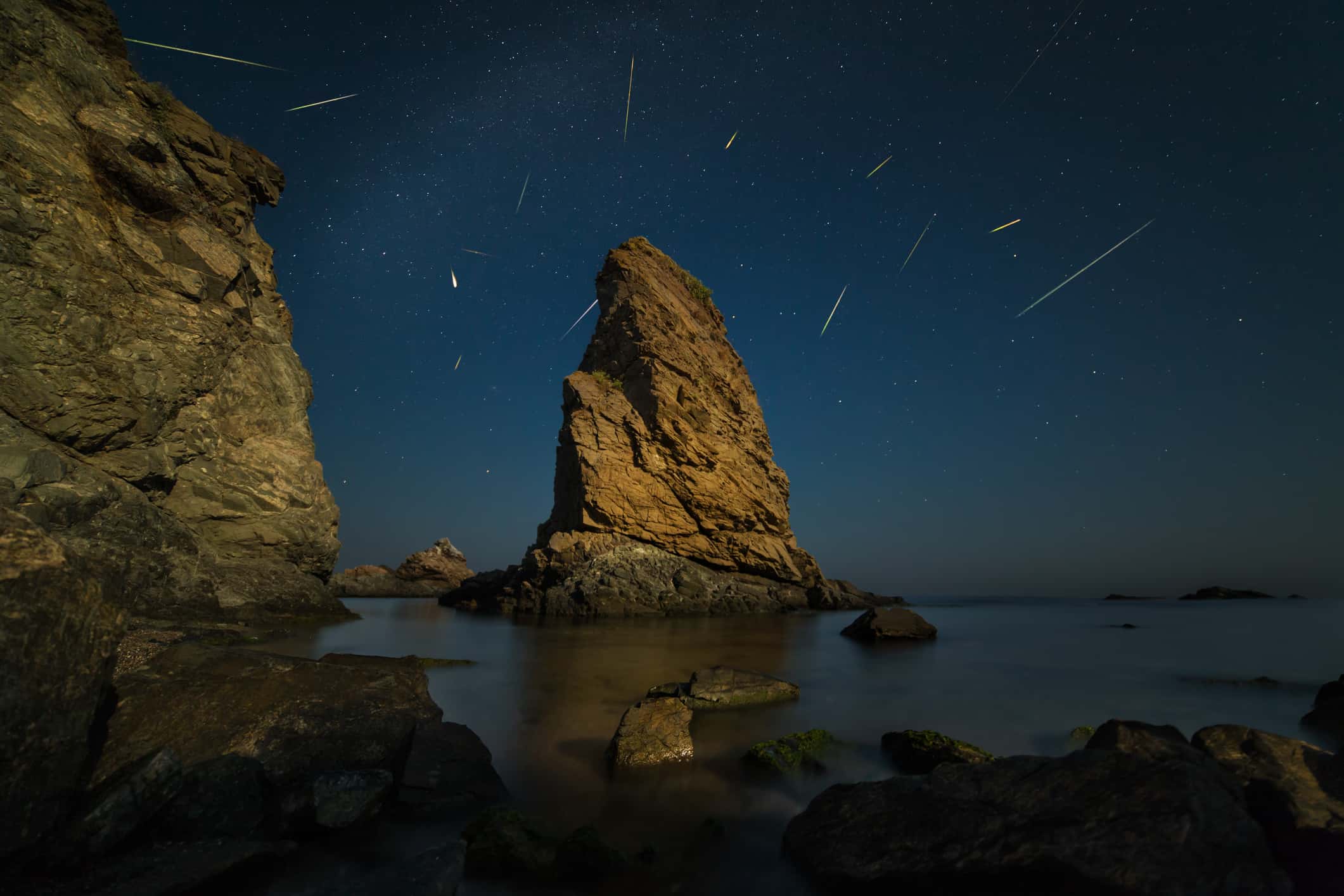
One of the most dazzling shows in the night sky is a meteor shower.
And though there are times throughout the year when they are easy to see - including the upcoming Geminid Meteor Shower on the night of December 13 into the morning of December 14, 2017 - it can be difficult to capture them in a still photo.
That's because you have no idea when a meteor will light up in the sky, which means you have to get set up with the right gear to take as many photos as possible during the meteor shower.
There's some pressure, for sure, but with these simple tips, you can set yourself up for success.
Editor's Tip: Whether you're new to astrophotography or a seasoned veteran, you can find all the required gear you need to take photos of the night sky at MrStarGuy. That includes telescopes, astrophotography mounts and accessories, and tripods, to name a view. Learn more about their astrophotography gear at MrStarGuy.com.
Pre-Focus Your Lens
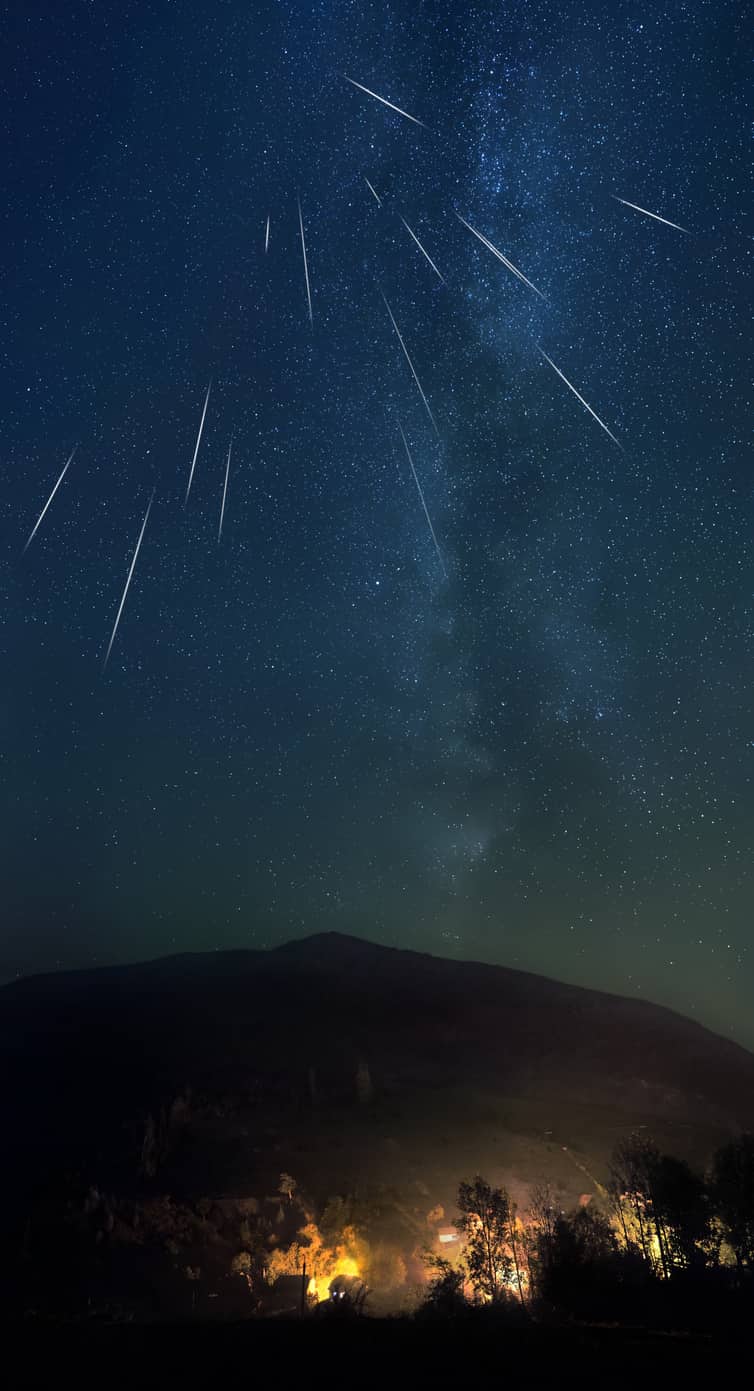
You will want your lens focused to infinity in order to get the sharpest image of the meteor shower. It's hard to manually focus a lens in the dead of night, though.
So, the day before you head out to your shoot location, head outside and set the focus on your lens by focusing on a far away object.
Once you have the object in sharp focus, tape the focus ring into place using gaffer's tape (which won't leave any sticky residue on your lens). Doing so ensures that the lens ring won't move and that you will have tack-sharp images.
If you forget to pre-focus your lens the day before, don't despair. If the moon is out, use it to focus the lens. A bright star will also do the trick.
Whatever method you use, be sure to use Live View to zoom in on the object to ensure your focus is spot on before taping the focus ring in place.
Learn More:
Use a Fast Wide-Angle Lens
The faster the lens you have, the better. Ideally, the lens will have a maximum aperture of at least f/2.8. Something along the lines of f/1.8 or f/1.4 would be even better.
Large apertures allow more light into the lens, meaning you can capture more light streaks from meteors as they streak across the sky.
That's why a wide-angle lens is an ideal choice for meteor showers as well. With a wider field of view, you'll be able to capture more of the sky, and more meteors, too.
In the video above by PhotoPills, you can see a wide-angle view of the 2015 Geminid Meteor shower.
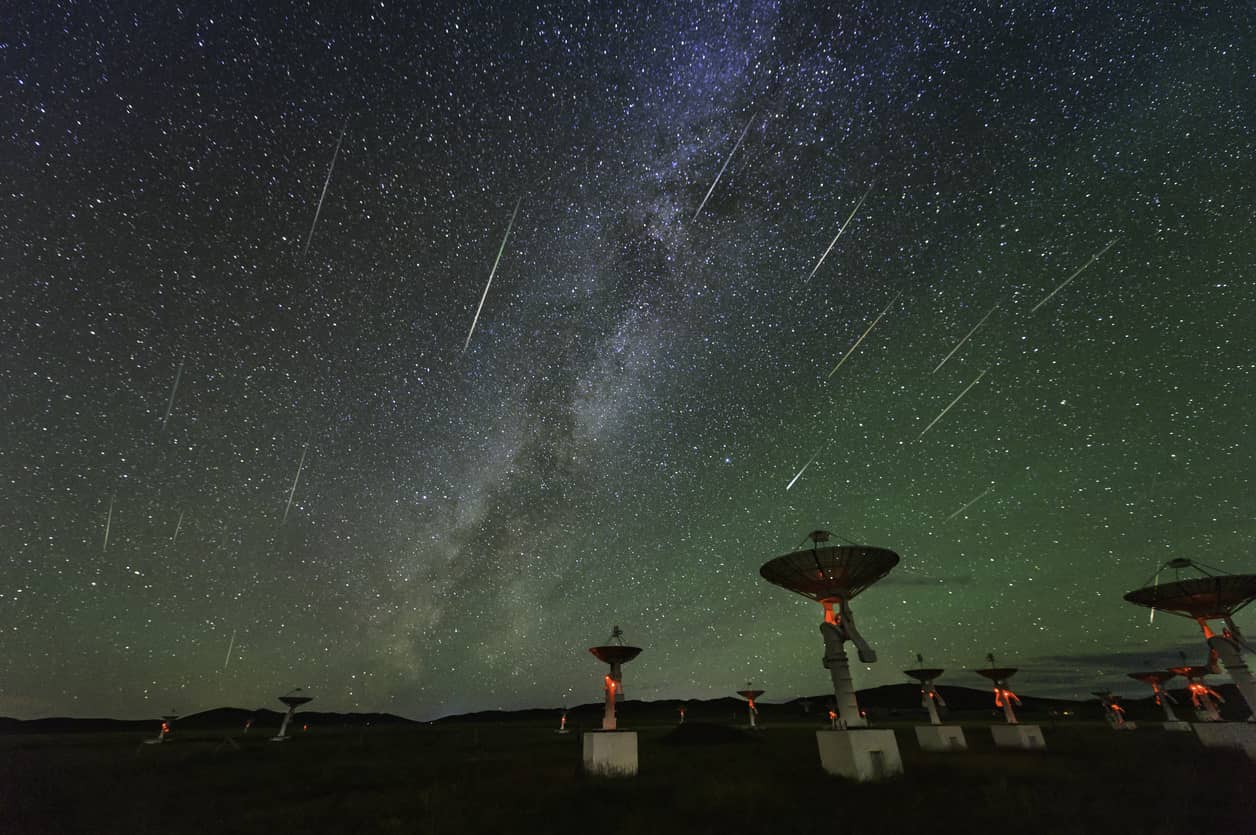
Shooting with a wide-angle lens helps you incorporate other elements, like the landscape in the foreground, to give the shot even more visual interest and serve as an anchor to the sea of stars above it.
However, remember that the more sky you incorporate into the shot, the more likely you are to capture images of the meteors. Find a good balance between showing as much sky but while also incorporating foreground interest.
Editor's Tip: If you want to expand your ability to take photos of the night sky, consider purchasing a star tracking mount, like the Vixen Polarie Star Tracker. These mounts attach to your camera, giving you the ability to track stars as they move across the sky. The result is an elimination of star trails, so your photos have sharp, pinpoint stars. Get outfitted with a Polarie star tracking mount today.
Suggested Exposure Settings
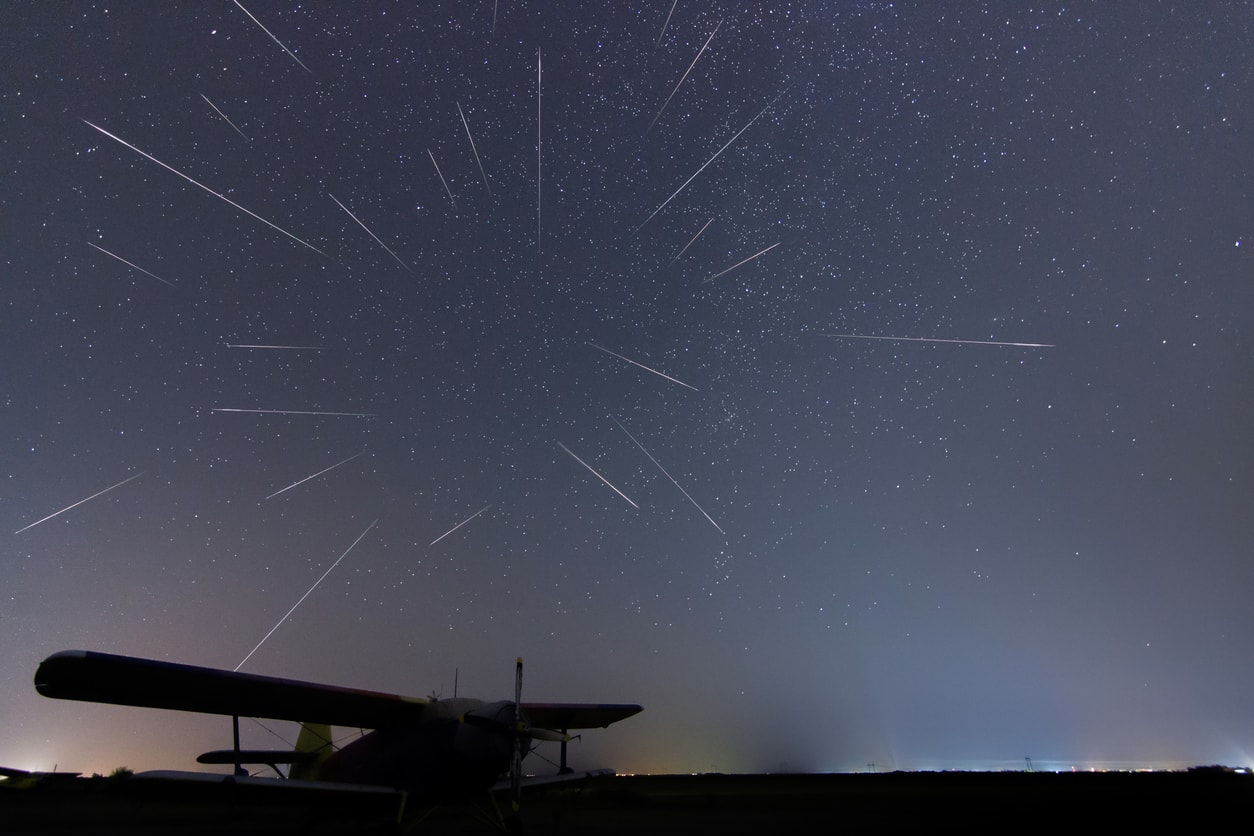
Though the settings you use to photograph meteors will depend on the particular setting in which you shoot, you can at least start with the following:
- Aperture: As wide as possible, preferably f/1.4-f/2.8
- Shutter speed: 15-25 seconds
- ISO: 2000
Naturally, if you start with these settings and the image is either too dark or too bright, you'll need to make some adjustments to the settings to correct that problem.
Additionally, beware of noise from using a high ISO. Some cameras can handle higher ISOs better than others, so if you can get your hands on a faster lens, do so, and then use a slower ISO to control for noise.
Do a few test shots of the night sky to get the exposure settings nailed down, and once you have a good exposure, put the camera in continuous drive mode and use a remote shutter release to snap each photo.
Learn More:
- Explore More Astrophotography Tips
- Quick Tips for Photographing the Full Moon or Supermoon
- These Hubble Space Telescope Photos Will Absolutely Boggle Your Mind
Get Geared Up
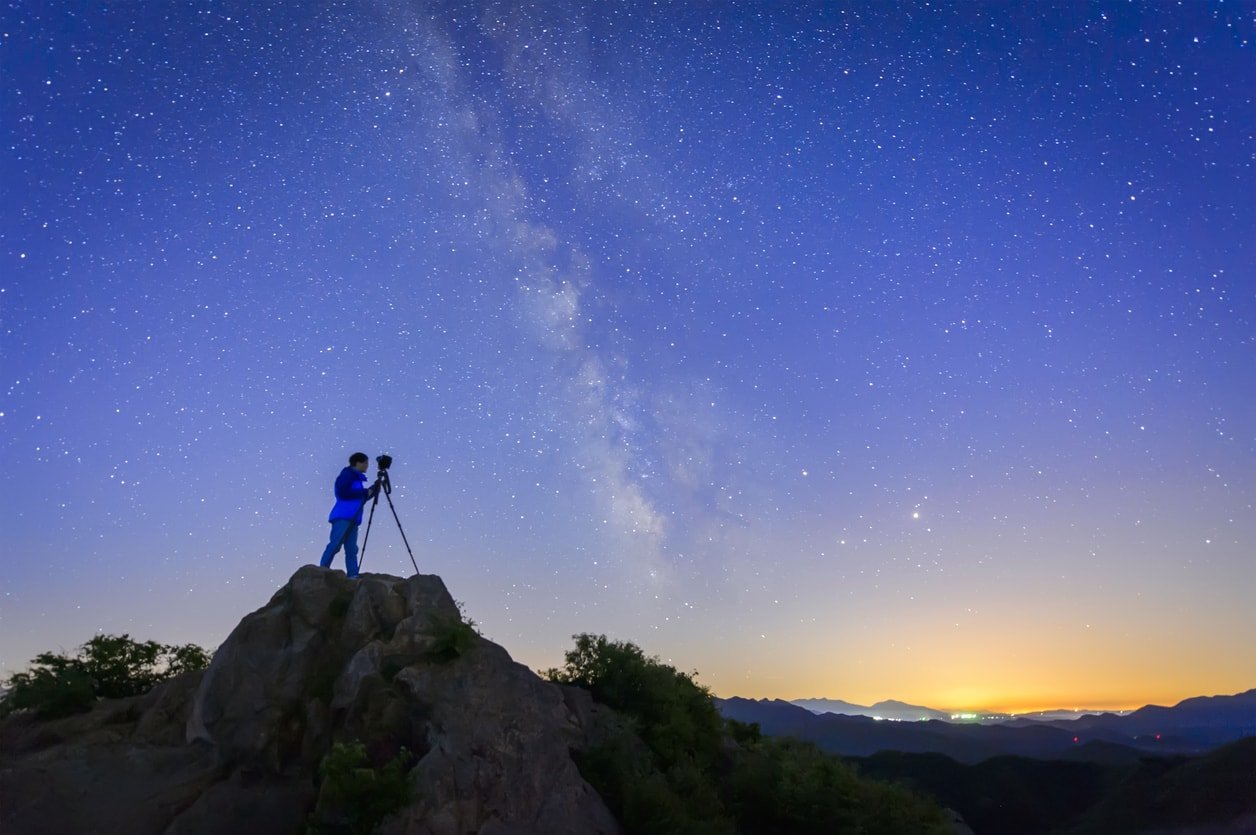
In addition to your camera, a fast wide-angle lens, and a camera remote, you'll need a few other things to maximize your ability to get high-quality photos of meteors.
First and foremost, you need a tripod to give your camera a stable base for shooting. Since your shutter speed will be anywhere from 15-25 seconds long, a solid tripod is imperative for getting tack-sharp photos.
Secondly, you need additional camera batteries at the very least (a battery grip with two batteries at a minimum) or better still, an external battery pack for your camera.
All that juice is necessary because you'll be shooting photo after photo for a long period of time - maybe even all night.
The last thing you want is to get into a groove of taking photos of a meteor shower only to run out of battery power.
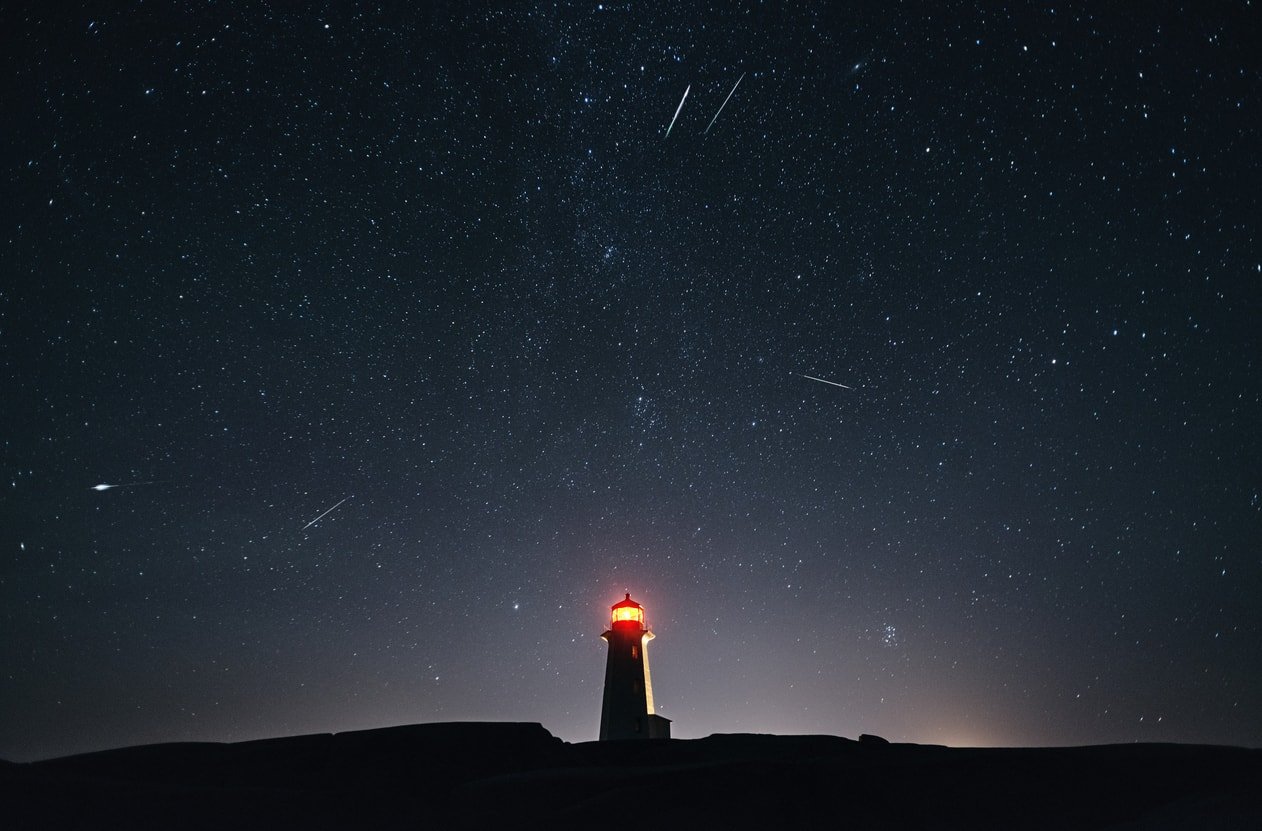
Lastly, you'll want extra storage capacity to store all the photos you take.
The larger the capacity and the faster the read/write speed of the card, the better.
Again, you don't want to miss out on taking epic shots because you have to swap out cards or because the card you're using spends too much time writing the images.
Editor's Tip: Get geared up for astrophotography with MrStarGuy. Find everything from headlamps and flashlights, external battery sources, tripods, and everything in between! MrStarGuy has a reputation for offering excellent products at incredible prices. Their customer service is top-notch as well. That's why we recommend MrStarGuy to our readers!
We Recommend
A Quick Guide to Choosing Locations for Astrophotography

Astrophotography is a lot like real estate in that it's all about location, location, location.
To pull off the very best photos of the night sky, you need to put yourself in a spot that affords you an unobstructed view and offers dark skies, among other things.
With this quick-start guide, I offer up a few tips for helping you figure out where you need to be to get breathtaking nighttime photos.
Find a Spot With a View
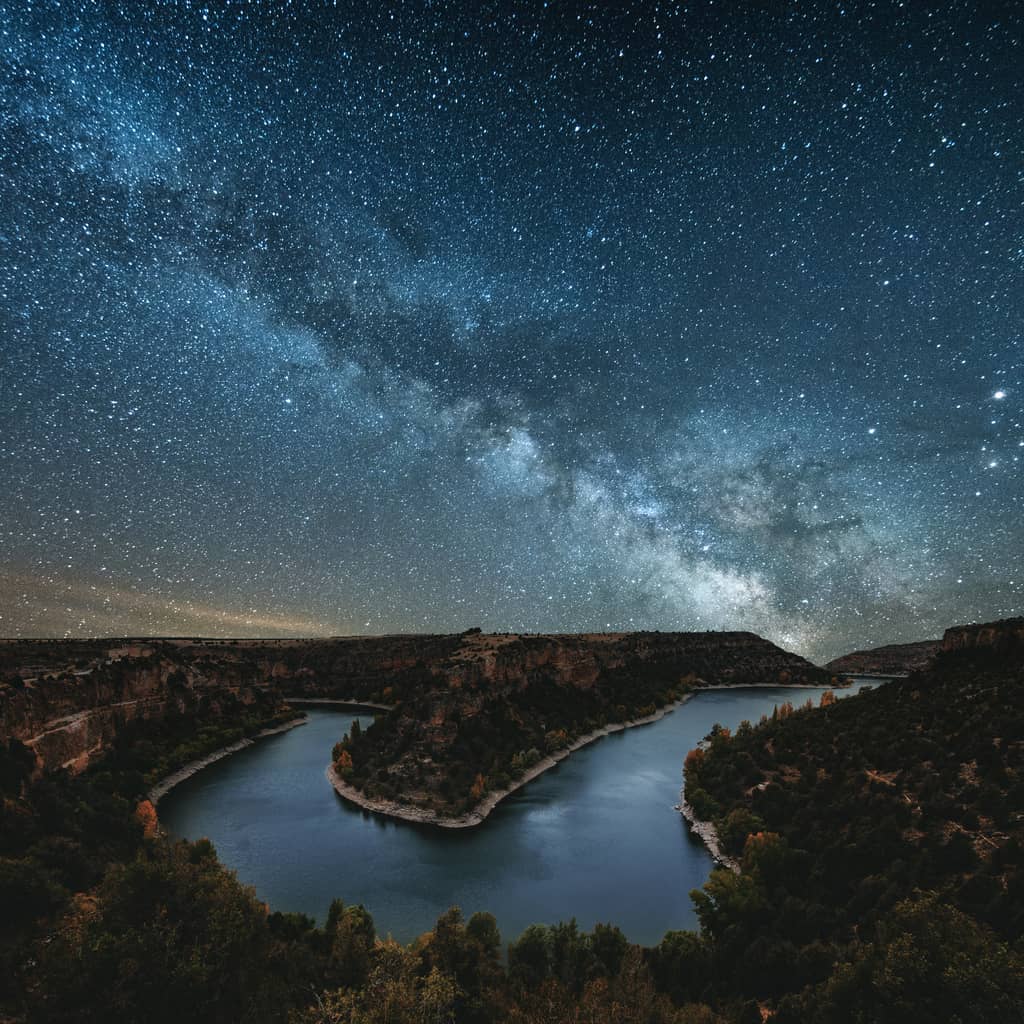
Obviously you need to set up your gear in a location that gives you an unobstructed view of the sky.
Whether you're photographing the Milky Way, a supermoon, a meteor shower, or some other celestial event, you won't even be able to get started if there's buildings and trees in the way.
Having said that, from a compositional standpoint, your images will be stronger if you include elements in the foreground, midground, or background of the photo.
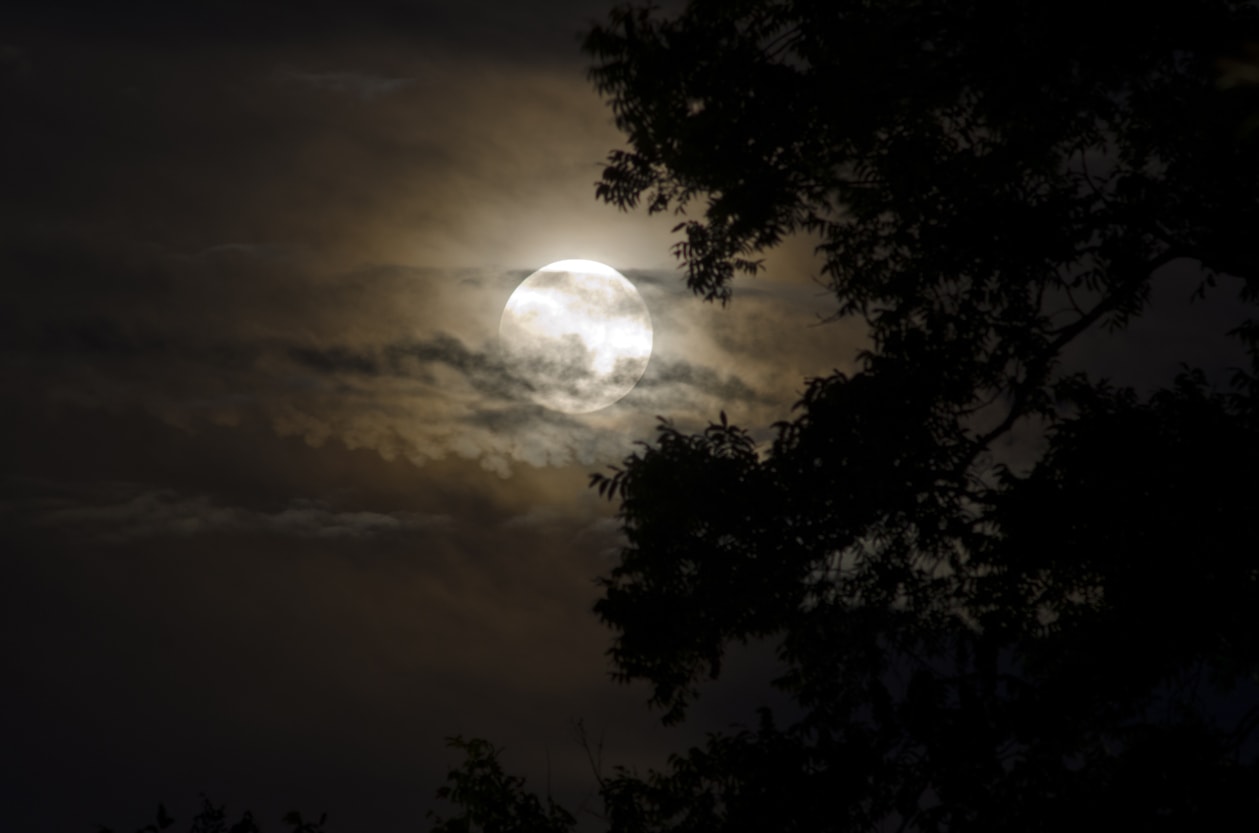
For example, when photographing the moon, framing the shot to include trees, as was done in the image above, makes the photo more interesting.
If there aren't any trees nearby, you can include a foreground element, like a person, to give the shot some interest, or you can wait for clouds to pass in front of the moon for a photo that's more appealing.
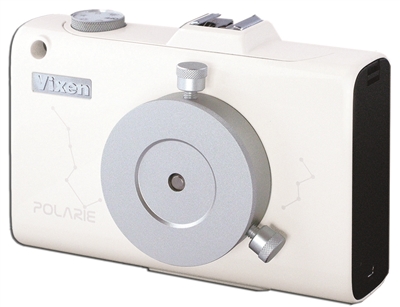
Editor's Tip: Eliminate star trails and get gorgeous photos of pinpoint stars by using a star tracking mount. The Vixen Polarie is an easy-to-use star tracker that's equipped with a compass and a polar scope for alignment. Once the mount is oriented to face north, it will track the movement of the stars to eliminate star trails. The device supports cameras up to 7 lbs., and will even work with your smartphone! Learn more about the Vixen Polarie Star Tracker Mount.
Avoid Light Pollution
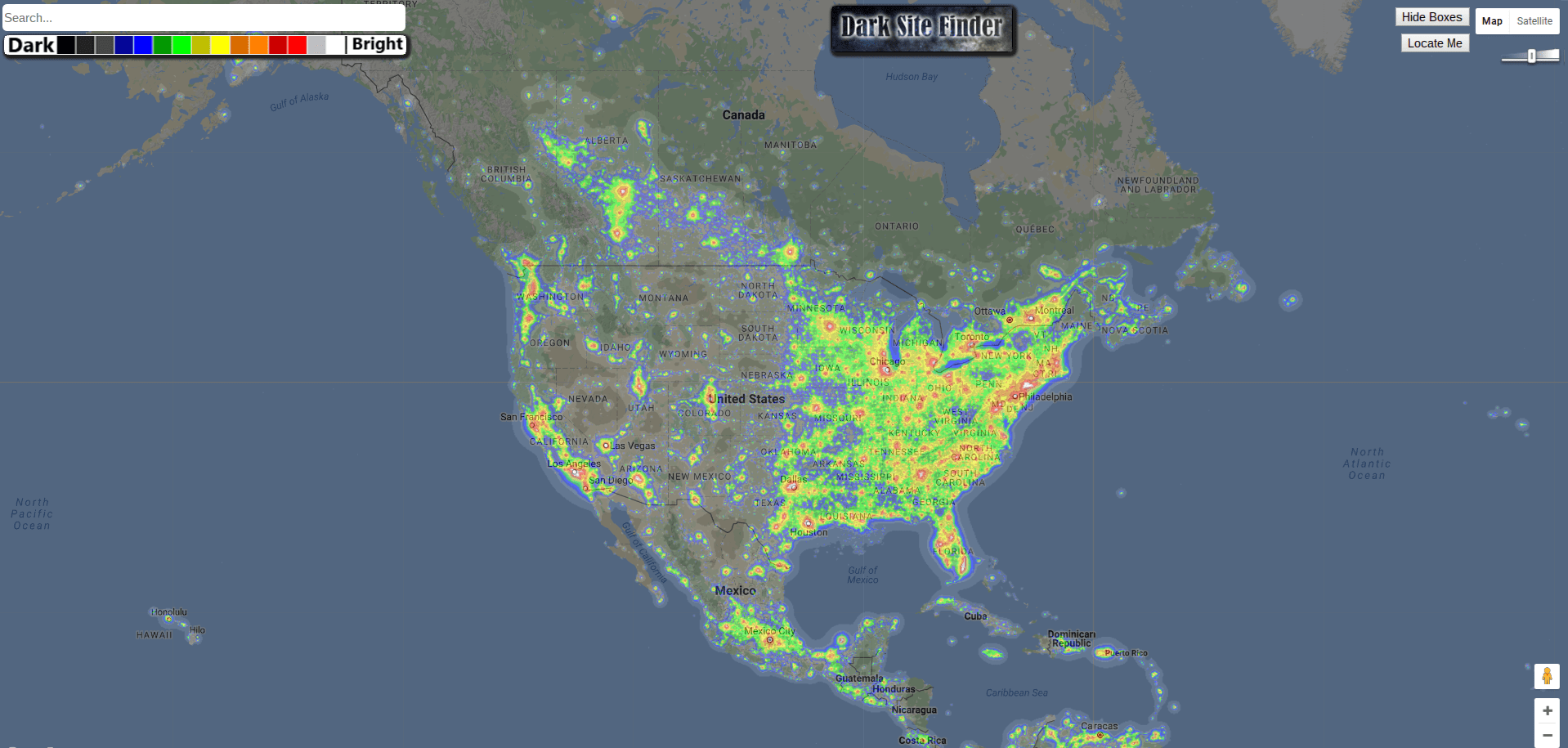
Another critical factor in finding the ideal location for astrophotography is light pollution.
The darker the skies around you, the easier it will be for you to highlight the beauty of the night sky.
Years ago, finding dark sites meant that you had to get in the car and drive around until you found a suitable spot.
Today, though, there are numerous apps that tell you where to find the darkest skies, like Dark Site Finder, shown above.
Just enter the location where you'd like to shoot, and Dark Site finder will give you a heat signature map of the area. The less red, yellow, green, and blue you see on the map, the darker the site will be.
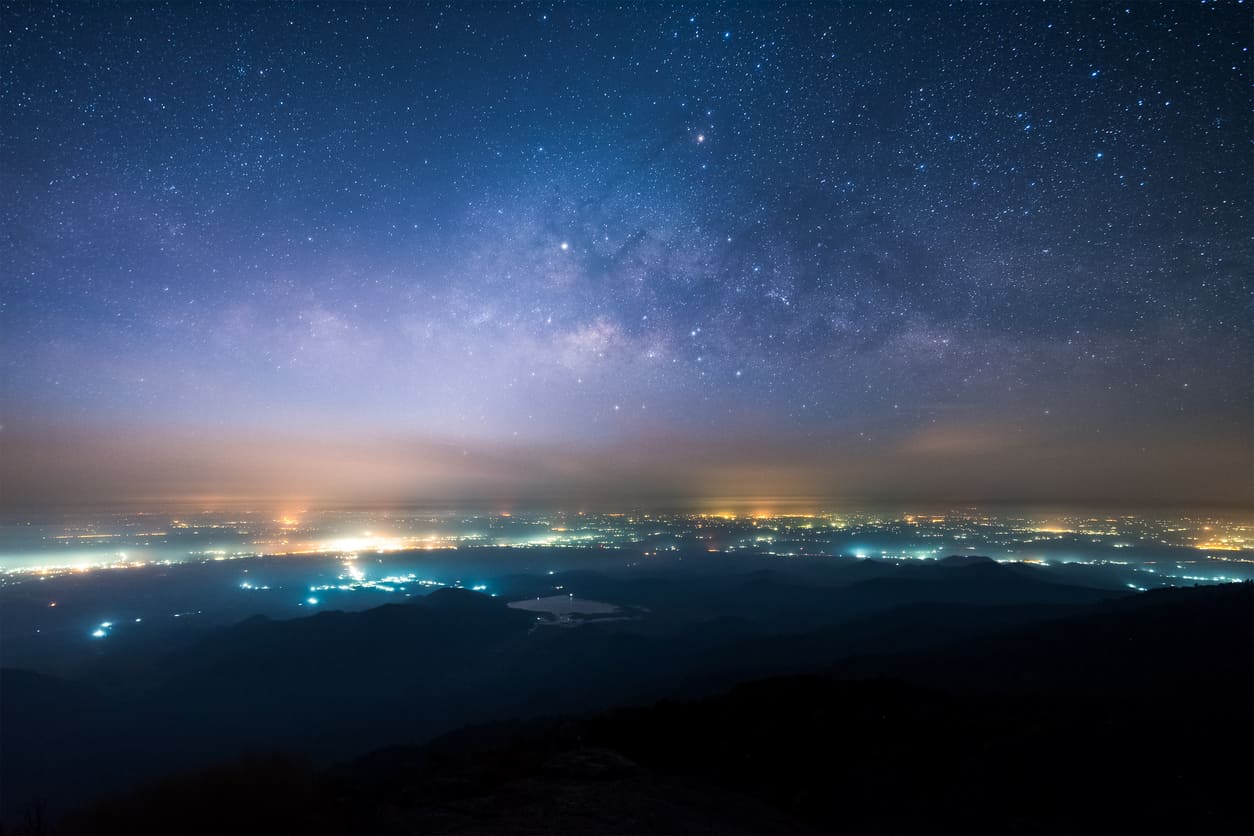
Though dark skies are ideal, they aren't completely required.
That is, you can capture a beautiful image of the night sky above a city, as shown above.
Illuminating the foreground of the shot with a flashlight or headlamp can render interesting results as well, as you can see below.
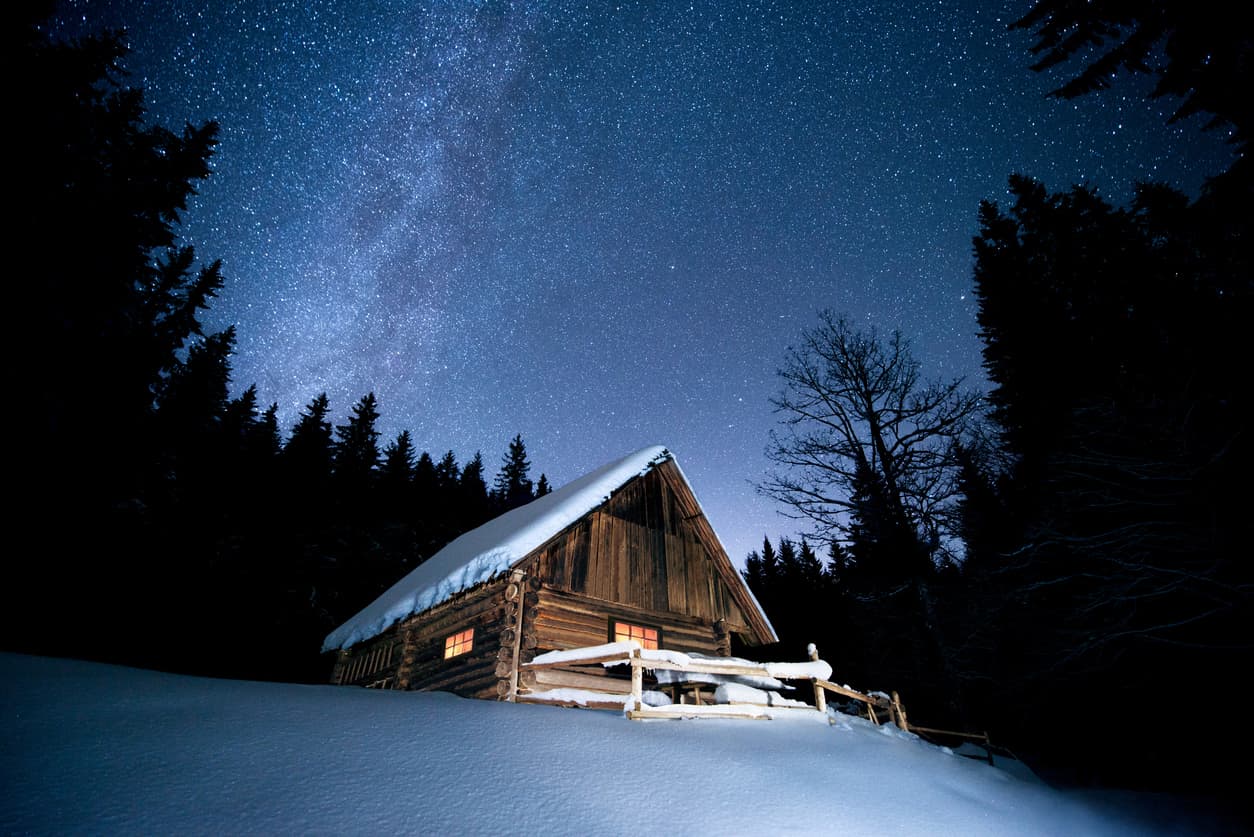
The point is that it's a good idea to begin your astrophotography pursuits in areas with as little light pollution as possible.
But as you get experience photographing the night sky and want to create more unique and varied photos, try branching out to shoot locations where light pollution can be used as an artistic element.
Learn More:
- How to Photograph the Milky Way (in Simple English)
- These Common Astrophotography Mistakes are Holding You Back
Be Considerate (and Obey the Law)
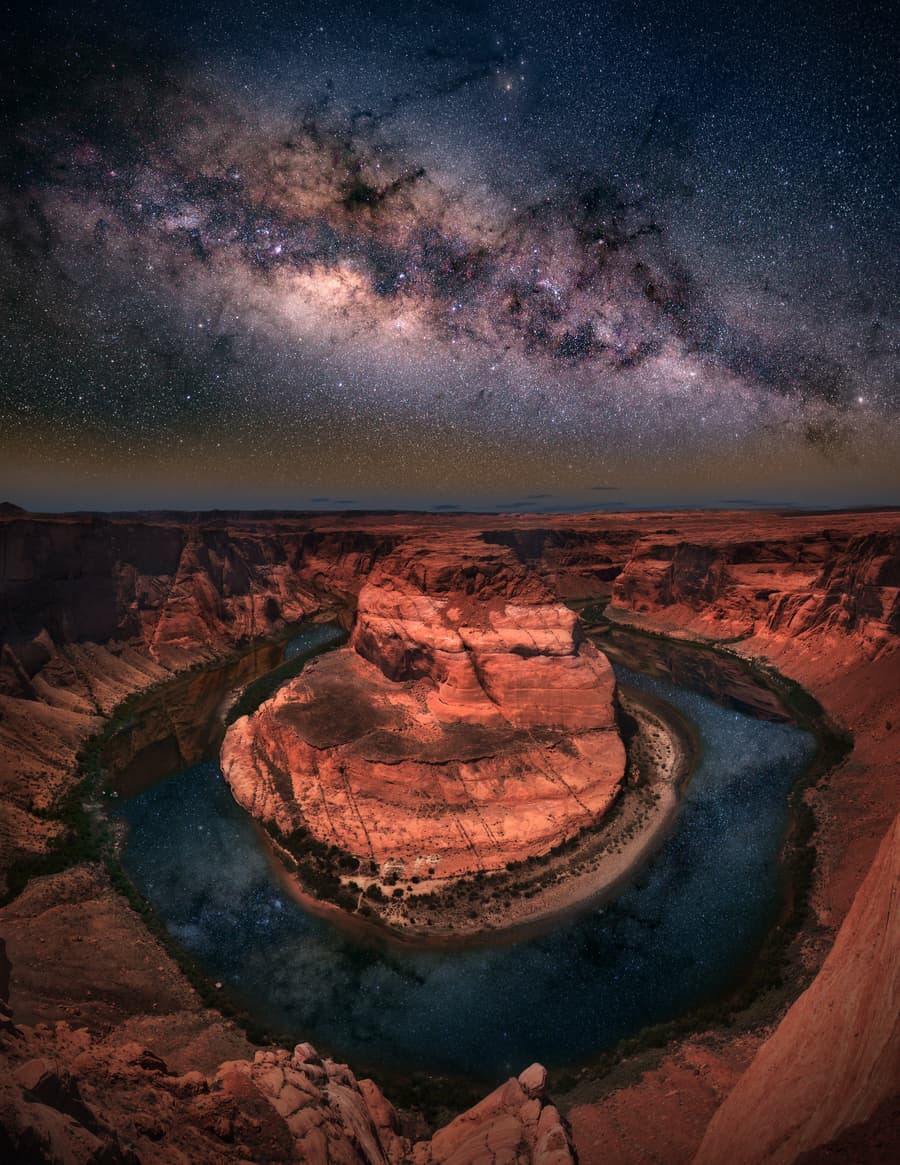
When looking for a spot to photograph the night sky, there's some practical issues to consider in addition to the view and the level of light pollution.
For starters, just because an area fits the criteria for a photo shoot doesn't mean that you're allowed to be in that area.
Be wary of wandering onto private property or setting up in an area that poses a danger to yourself or others (i.e., in the middle of a country dirt road).
If you're not sure if the spot you've chosen is private property, find another spot. It's best to be safe than sorry.
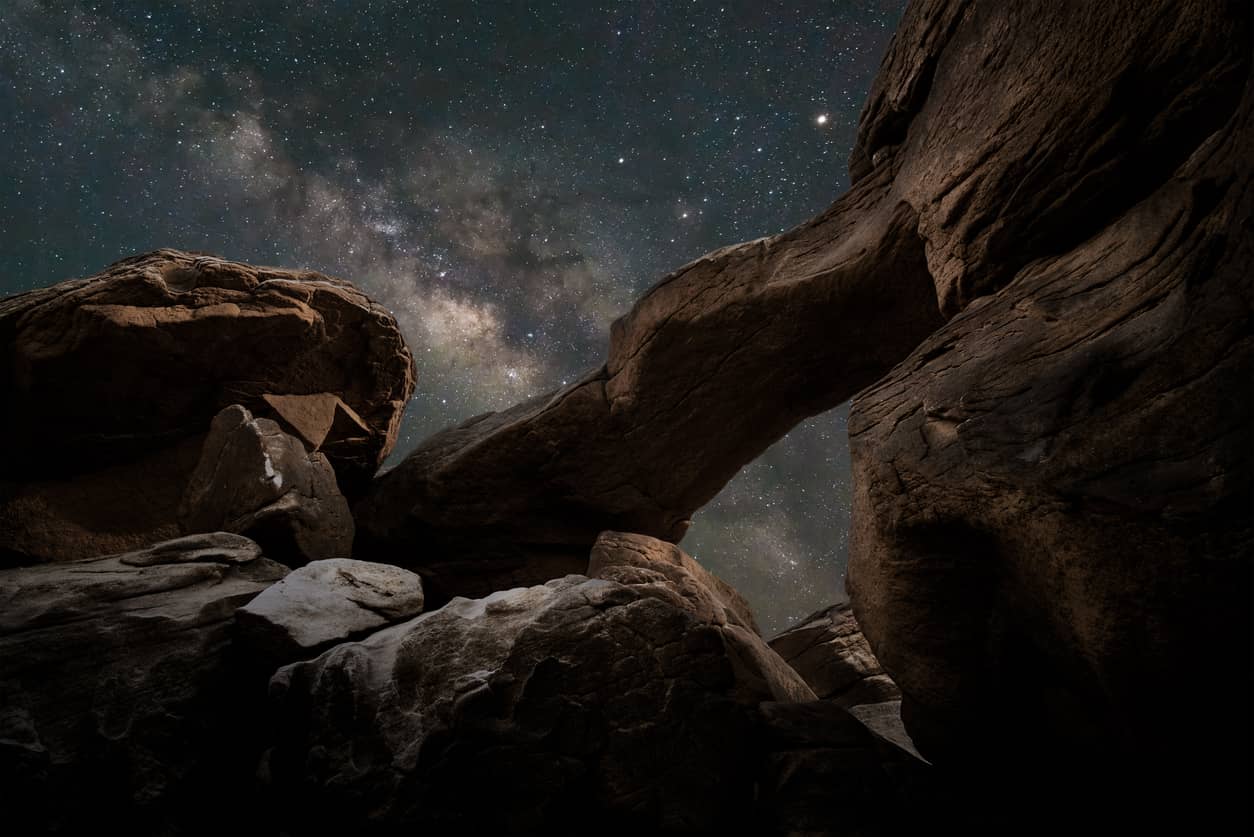
Likewise, if you select a location that's in a state park, national forest, national park, and so forth, you might be required to pay entrance fees or at the very least check in with local rangers or other authorities to let them know you're in the area.
The same goes for shooting in cities - you might need a permit to set up your gear on a sidewalk to get a shot of the stars above a busy freeway.
If you're shooting away and someone asks what you're doing, why you're there, or demands that you leave, be considerate and comply with all reasonable requests.
Though it's certainly satisfying to capture beautiful photos of the night sky, it's not worth it to risk a confrontation, a fine, or worse.
Editor's Tip: Get your astrophotography kit filled out with everything from tripods to binoculars, filters to carrying cases, and everything in between at MrStarGuy. MrStarGuy is the premier astrophotography retailer with a wide selection of products at prices that won't break the bank. Explore their inventory here.
We Recommend
Astrophotography Gear: Optional Equipment
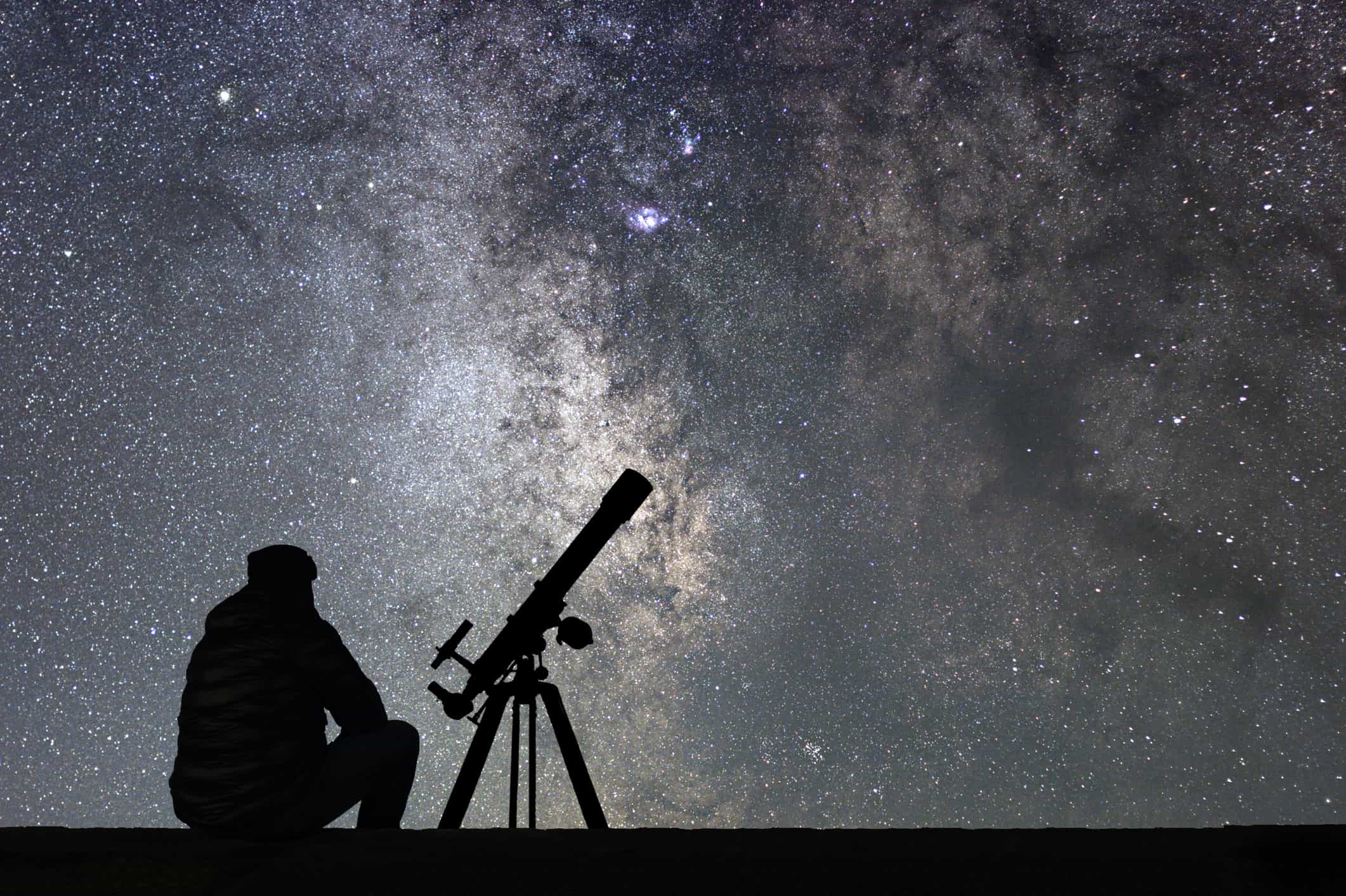
Naturally, a camera, lens, mount, and tripod are among the essentials for astrophotography. But there are a few optional items you might want to add to your kit as well.
Let's take a look at just a few items that you might want. Keep in mind that the kind of gear you'll need is somewhat dependent on the types of astrophotography you intend to pursue.
With that in mind, here's a short list of some optional items.
A Telescope
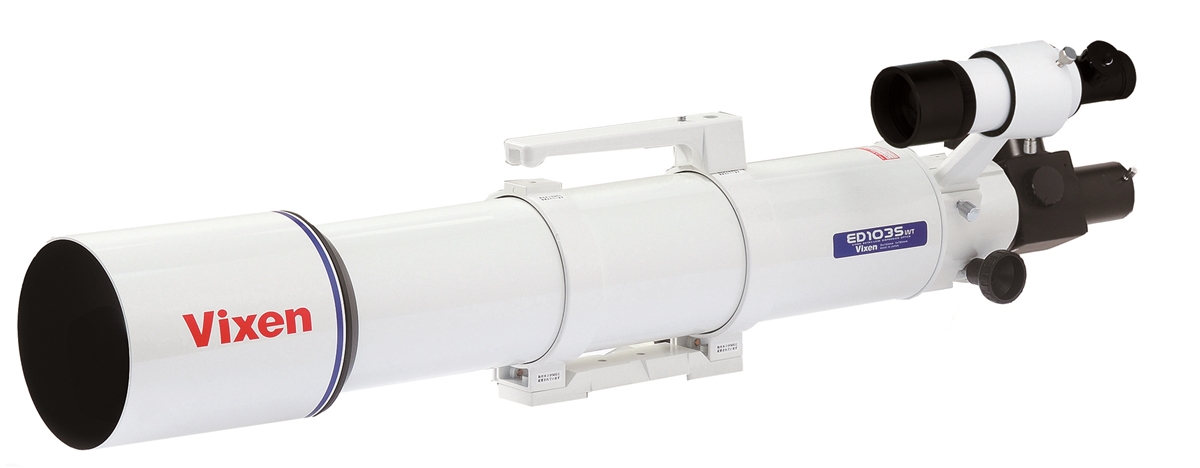
This is probably the most obvious purchase if you're planning to reach out with your camera.
Not all scopes are intended for deep space viewing, though, so you may want to consider one even if you're just planning to stick with wide field astrophotography for now.
It's also important to remember that higher magnification means not only more cost for the scope, but more sophisticated equipment required for stabilization and tracking.
There's much to know about focal length, aperture, back focus, and other mechanisms of optics. But here are a few that we recommend for DSLR photography in the three main categories of astrophotography.
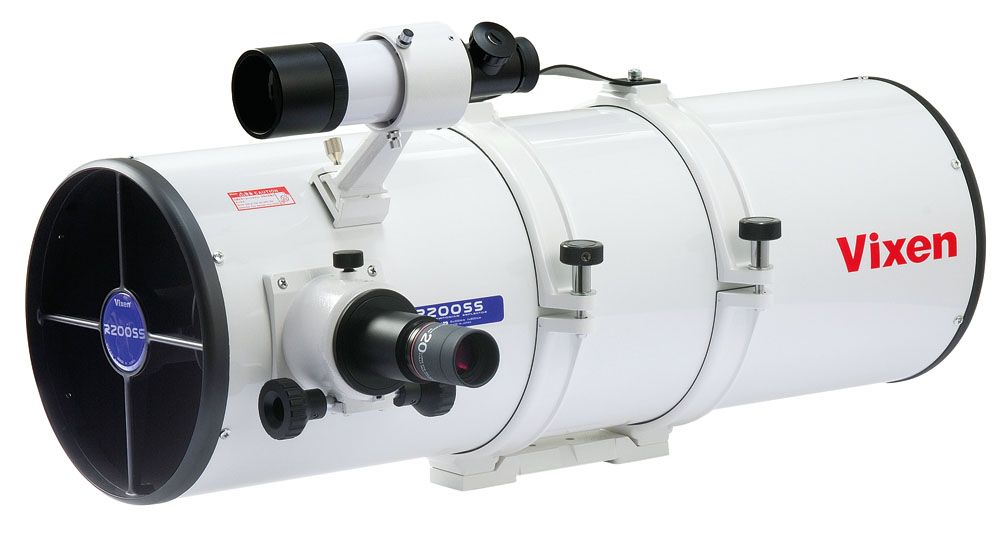
For wide field photos, the Vixen ED103S is a great choice in a refractor, especially for the novice. It's ideal for those who want to reach out a bit more with a precision instrument at a reasonable cost.
For basic deep sky imaging at a reasonable price, you might want to take a look at the Vixen R200SS Newtonian Reflector Telescope (shown above). This reflector provides a 200mm focal length with an f/4 parabolic primary mirror that gives you extremely sharp images.
With a scope of this size, you can see groups of nebula, comets, and star clusters. Add an optional coma corrector, and you'll get even sharper coma-free images.
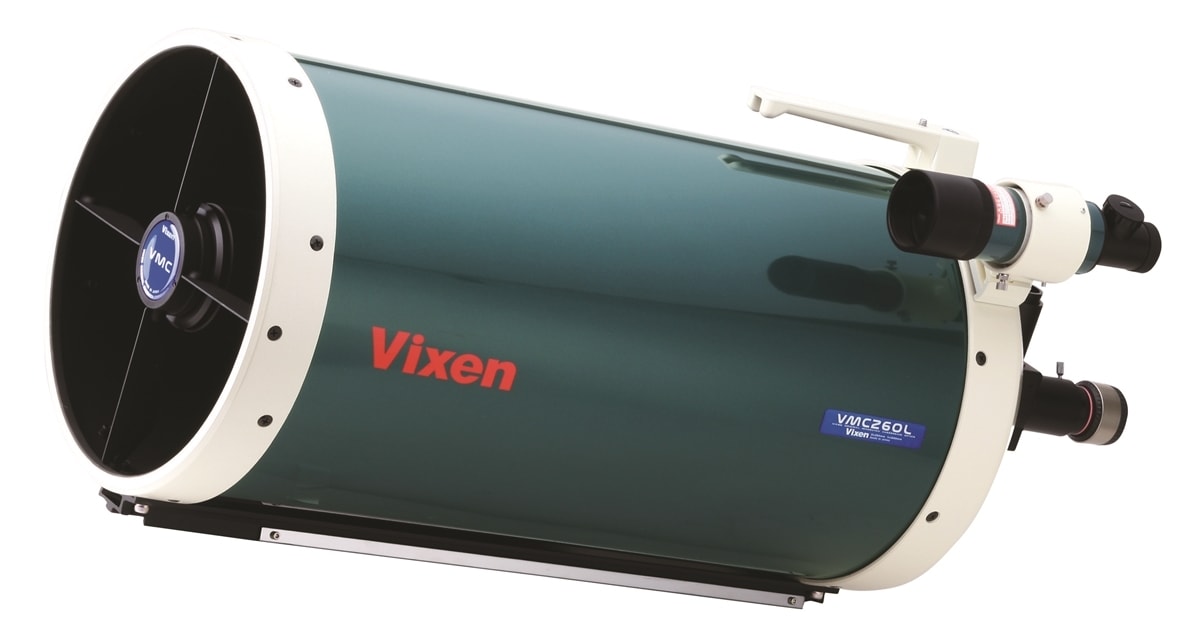
For a little more telescopic power, you can opt for something like the Vixen VMC260L Reflector Telescope that's ideal for deep sky and planetary astrophotography.
This rig is a modified Cassegrain design with a long focal length and a large 260mm aperture to collect the light needed for high-quality photos of deep space. And with a double meniscus corrector lens design, spherical aberration and field curvature are eliminated while offering superb contrast in your images.
I know the technicalities of telescopes might be confusing, so be sure to visit the links in the Learn More section below for more details.
Learn More:
- Get More Details on the Vixen ED103S
- Get More Details on the Vixen R200SS
- Get More Details on the Vixen VMC260L
A Mounting System
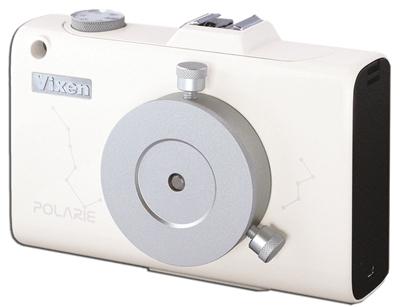
There are two factors that create challenges when shooting celestial objects from a terrestrial location:
-
High magnification ratios exaggerate even the smallest movement.
-
Because the earth rotates, keeping a distant object in the field of view during long exposures or over multiple exposures requires tracking or otherwise adjusting the angle of the scope. This is also a factor in initially locating celestial objects, compounded by the fact that those objects are also moving.
Obviously, the solution for the minimizing movement of the scope is to use a highly stable mount on a very rigid tripod. The second factor is much more complex and there are many solutions available, from star charts and the most basic manual tracking systems to sophisticated, computerized "go to" and tracking firmware.
There are basically two types of mounts available for telescopes, and the difference is important for astrophotographers.
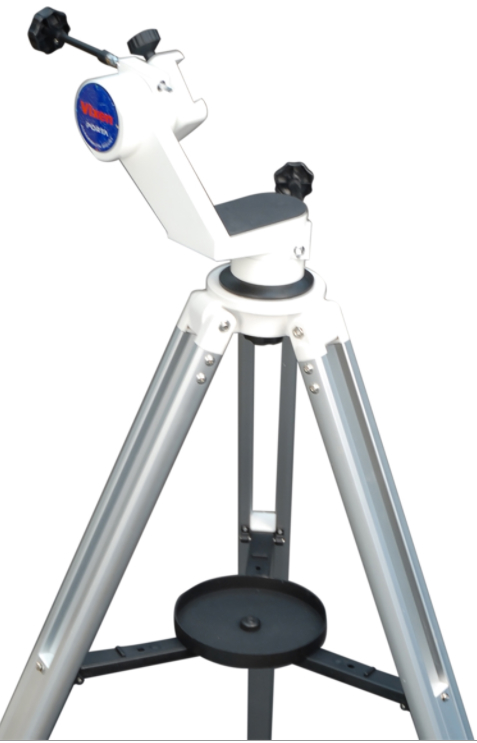
An alt-azimuth mount, like the Vixen Porta II shown above, adjusts the angle of the optics along two axes, altitude and azimuth. These two axes must be adjusted independently in order to keep an object centered over time. A mount like this requires a universal plate to attach a camera to it and is ideal for photographing bright objects like the moon or Venus.
An equatorial mount, like the Vixen Advanced Polaris Mount shown below, is also adjusted on two axes. However, one, known as the polar axis, is aligned parallel to the Earth's rotation while the other, declination, adjusts the line of sight perpendicular to the polar axis to locate objects. Once an object is located, only the polar axis needs to be rotated to keep the object centered.
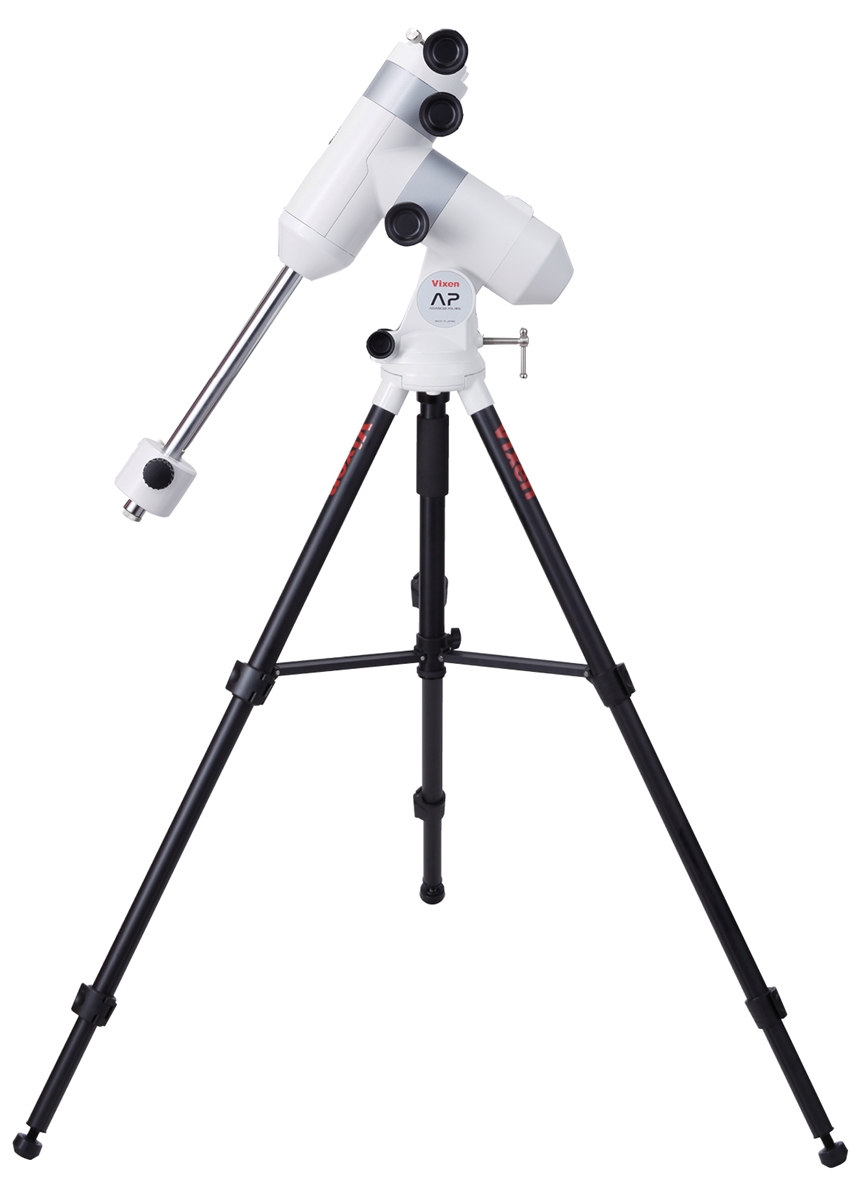
The equatorial mount is generally preferable for astrophotography, but for those of you investing in an astrophotography setup now, an alt-azimuth mount is perfectly fine. Regardless of the type of mount chosen, however, it will need to matched to the scope or scopes you'll be using. Most manufacturers, like Vixen Optics, offer mount and tripod combinations dedicated to specific lines of scopes, so be sure to consider the scope you'll use before choosing a mount.
Learn More:
Software
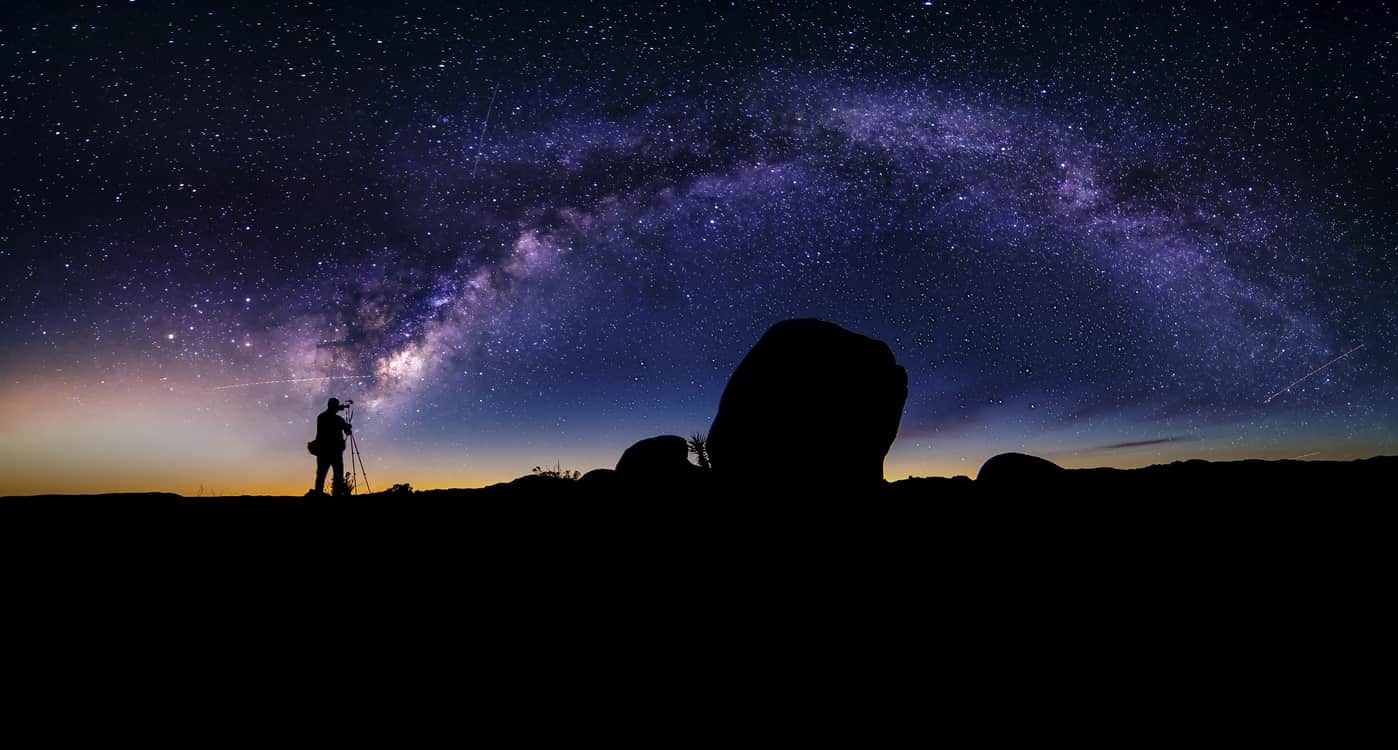
There are a great number of accessories you may need or want, and the list will vary according to the categories of astrophotography you're involved in. There are a few items, however, that will be common to all aspects of astrophotography, and one of those is software.
Image stacking is a very common practice in astrophotography, and you'll eventually want to have image editing software that's capable of it. If you're already using a recent version of Adobe Photoshop, you've got it covered. If not, consider a subscription to the Creative Cloud version.
We Recommend
Astrophotography Gear: The Camera
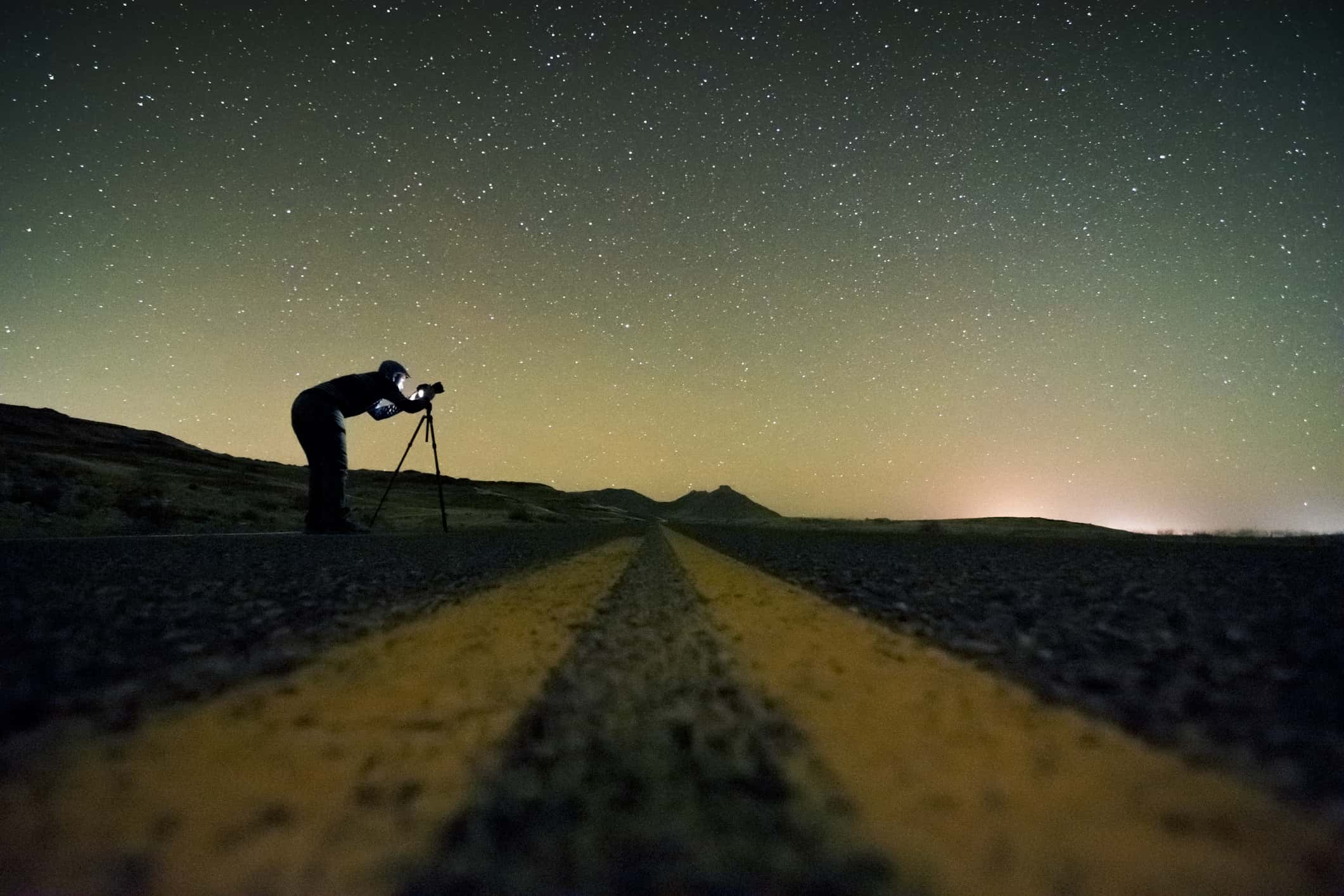
Before we launch into discussions about astrophotography techniques, some time needs to be spent on the equipment you'll want to consider having on hand.
After all, if you don't have the gear that you need to practice what you're learning, what's the point?!
That being the case, I'd like to take some time to go over a few details about cameras for astrophotography.
Digital vs. Film

Film cameras are perfectly suitable for astrophotography. After all, photographers have been taking successful astronomy shots on film for decades.
That said, digital technology has given us much more versatility and convenience. Put simply, modern DSLRs are faster, easier to use, and more capable than their predecessors.
So, while I encourage the use of film cameras in all areas of photography, these discussions will be centered on DSLR camera usage.
DSLR Camera Choices
As in any form of photography, the camera doesn't make the astrophotographer. There are, however, some important considerations and limitations that are specific to this type of photography. The first one we'll discuss is a limitation in all standard DSLRs on the market.
"Where's the Red?"

Your DSLR "sees" differently than you do. Unlike our eyes, digital imaging sensors are sensitive to all colors of light in the spectrum.
In daylight conditions, the sensitivity to infrared light frequencies causes a shift in the colors we perceive in an image. To counteract this, standard DSLR cameras include a permanent IR limiting filter that corrects the color balance.
In astrophotography, this filter blocks wavelengths of light emitted by some celestial objects, such as nebulae. The reds produced by these "H-alpha" wavelengths add incredible color and detail to many areas of our universe.
While this lack of reds will go unnoticed by most viewers and a good-quality standard DSLR is suitable to use, the difference will be dramatic in many images.

If you're serious about this field, you may want to consider a DSLR that's designed specifically for astronomy shots. The most notable models from manufacturers are the Canon EOS 60Da and the Nikon D810a shown above.
Both of these come with modified IR filters that allow the H-alpha reds to pass. The 60Da was introduced in 2012, so it's possible now to find used ones fairly inexpensively, while the D810a is a newer, full-frame camera with stunning 36.3MP resolution and a much higher price tag.
It's also possible to have your standard DSLR modified by a lab that specializes in replacing the IR filters. This is a fairly pricey operation, and it will render the camera almost useless for daylight work.
Some labs also offer pre-modified versions. These models often use special filters that allow the camera to produce relatively normal daylight shots.
Learn More:
It's Noisy Out in Space!

Alright, not really, but noise is a major consideration in choosing a camera – digital noise, that is.
Astrophotography shots may require very long exposures – as much as 15 minutes – at high ISO settings. As you probably know, digital noise production increases as ISO settings increase. What you may not know is that digital sensors heat up when they're activated and the hotter they get, the more noise they produce.
That means that those deep sky shots can be completely riddled with noise and the better the noise suppression in your DSLR, the less cleanup you'll have to do in post-processing.
A camera with a good rating for low noise will make your life much easier. As a general rule, crop-sensor DSLR cameras will generate more noise than full-frame, but the difference in price may make that a tough choice. At the end of the day, just buy the best camera you can afford.
Learn More:
The Other Stuff

There are other features you're going to need, and most are built into almost any modern DSLR:
-
Full manual exposure setting
-
Bulb (B) shutter mode with a timer
-
Remote shutter operation
-
Manual Focusing
-
High ISO range
-
Live View Mode
-
Movie recording capability
You'll also want to think about features that make shooting upward easier, like a top-side LCD panel, and/or an articulated LCD viewing screen.
With a wide range of DSLRs and options available, the bells and whistles will be a matter of your preference.
Learn More:
Specialized Cameras and Mounts

You may also want to take a look at some of the more unusual cameras built for specific purposes, such as full-sky shooting.
Some cameras are even designed to fit the eyepiece of a telescope. You can also get something like the Vixen Polarie Star Tracker Mount shown above, pair it with your digital camera, and use it to track the motion of the stars and other celestial bodies without star trails forming in the shot.
This information should get you on the right road to choosing the right camera for astrophotography, but if you're already the owner of a good DSLR, don't hesitate to get out there with it!
Learn More:
- Get the Specs and Pricing on Telescopes, Camera Mounts, and Other Astrophotography Gear
- Astrophotography Basics: Mounting the Scope
We Recommend
Astrophotography Gear: The Essentials
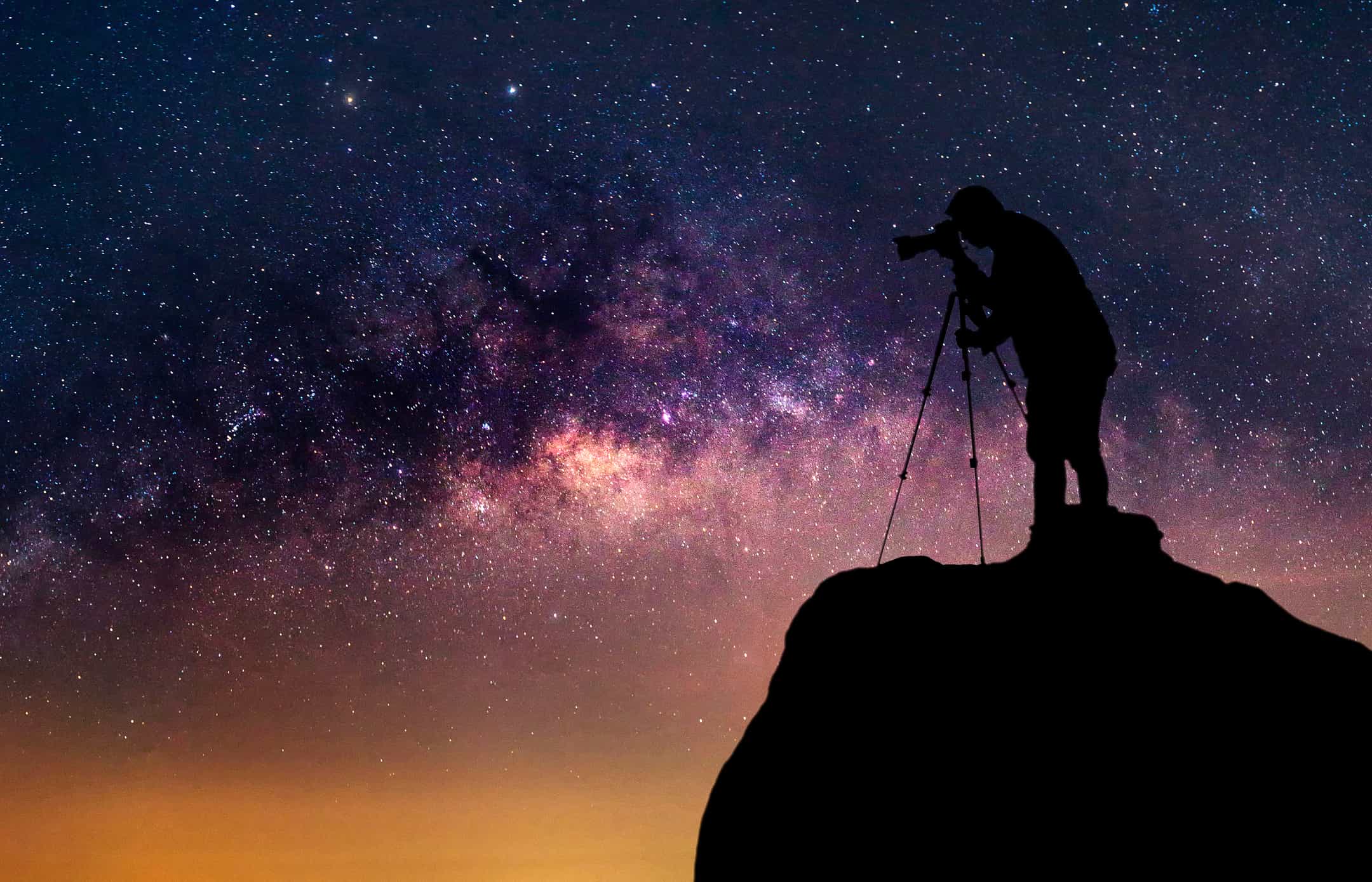
Naturally, the first piece of basic gear that you're going to need for astrophotography is a camera. We discuss that topic in depth in another article.
Aside from that, there are some essential pieces of equipment, some that are only necessary for specific types of shots, and some that just make the process easier and more fun.
In this article, we discuss the basic essentials that you'll need for a solid astrophotography kit.
The Essentials
What are the bare minimum requirements for success in astrophotography?
You'll probably get different answers to that question from different people, partly because many people focus on a specific type of astrophotography.
We're going to start this off by listing the gear required to simply set up your DSLR for great night sky shots. That's basically wide field astrophotography, but some specialized equipment can be called for even in that category. For now, let's look at a bare-bones setup.
A Manual Focus Lens
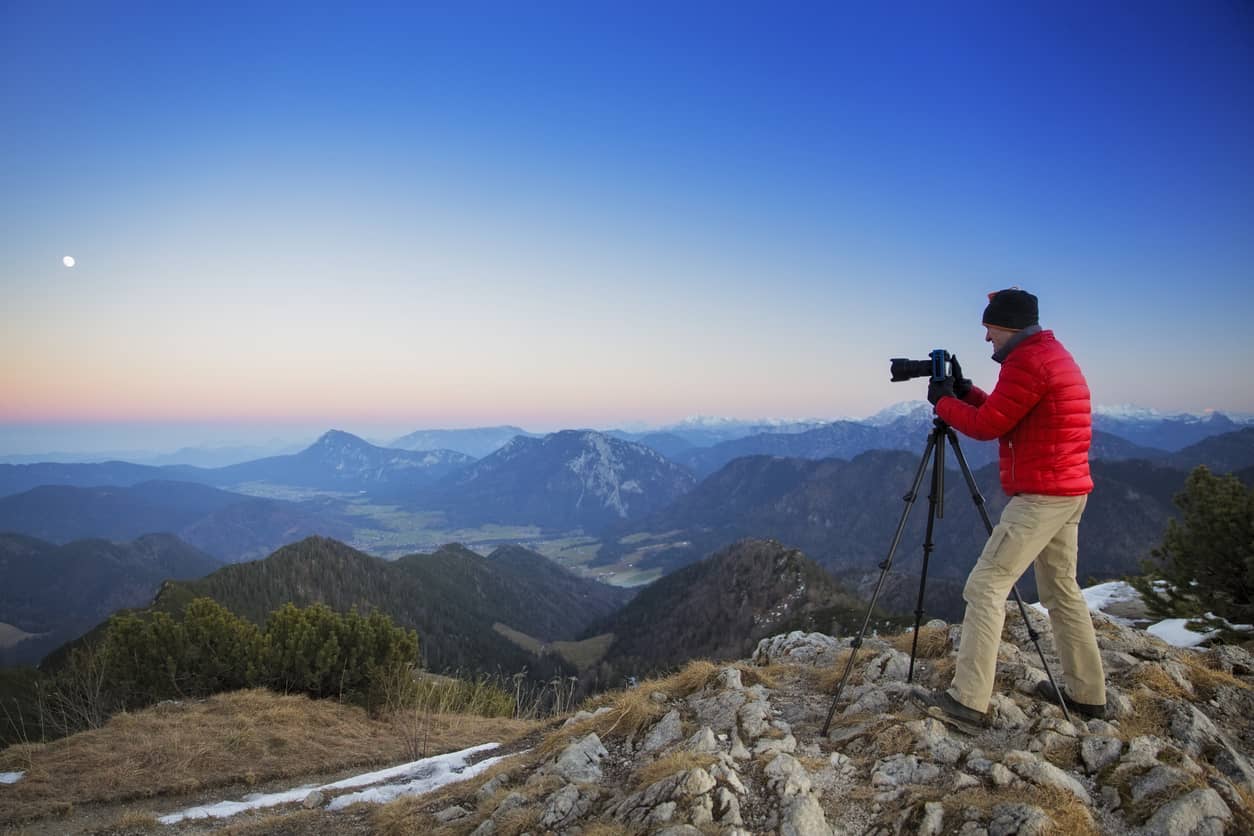
Autofocus isn't going to work with objects millions of miles away. Instead, you'll need lenses that focus manually or can be switched to manual.
Lenses with focusing scales will make the job easier. Focal lengths will depend on what you plan to shoot. Keep in mind that the longer the focal length, the more susceptible your setup will be to blurring from camera shake.
You can, of course, use a scope for a lens, too.
Learn More:
A Solid Tripod
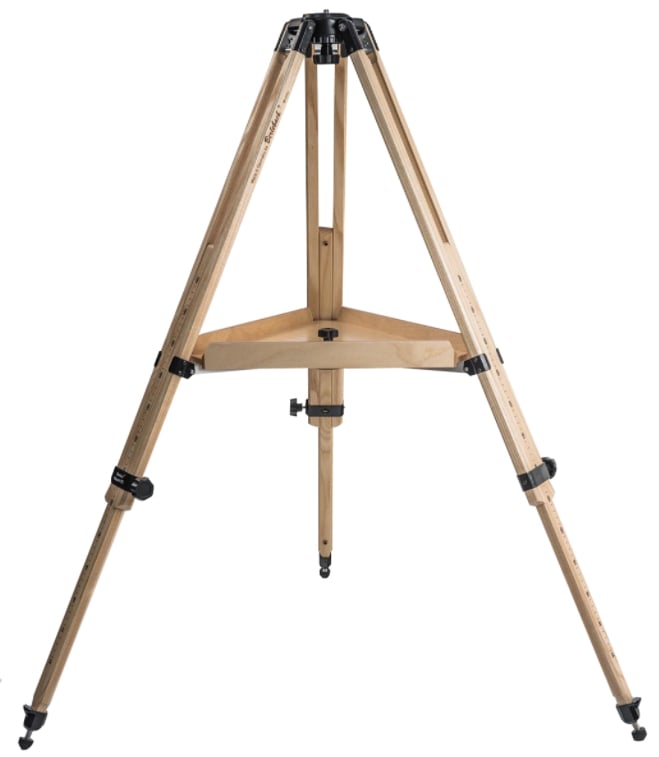
This really shouldn't require an explanation, but trying to hand-hold your camera when shooting celestial bodies is pointless.
Your exposure times are going to be in multiple seconds and often multiple minutes. You're going to need a tripod, and it needs to be sturdy.
Be prepared to add weight to it with sandbags or other means to make sure it's rooted solidly to the ground.
You can get by with a simple ball or pan and tilt head on your tripod for basic, wide field shots or star trails.
Of course, if you are out to view the stars with a telescope, a solid tripod like the one shown above is a must as well.
Learn More:
- Shop Tripods for Astrophotography and Viewing the Night Sky
- Astrophotography Gear: Optional Equipment
A Remote Shutter Release
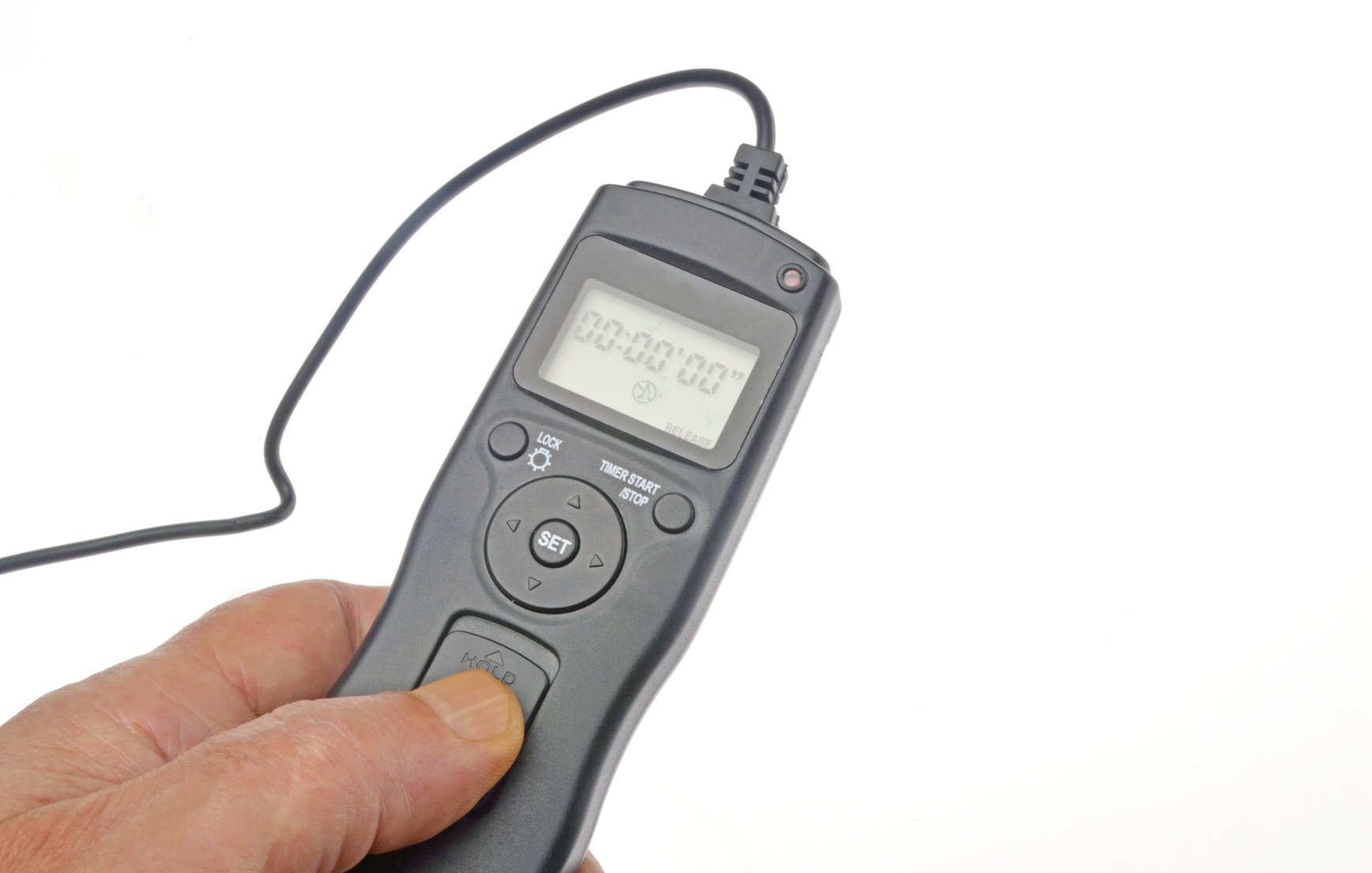
Minimizing camera shake is priority one when you're working with extreme distances and very long exposures, and your camera's shutter delay timer may not be enough since even the tiniest bit of movement will blur those distant targets.
Plunger-type cable releases are also likely to induce movement because of both their mechanical operation and their overall stiffness.
Electronic shutter releases are so inexpensive these days that there's no excuse not to have one. It doesn't matter whether it's wired or wireless, so long as it isolates your hand completely from the camera at the critical moment.
This is one item you may want to consider upgrading to a more versatile option. Intervalometers are also inexpensive now and will work just as well for individual shots. That will also provide you with the opportunity to add time lapse videos to your astrophotography portfolio.
Learn More:
A Flashlight
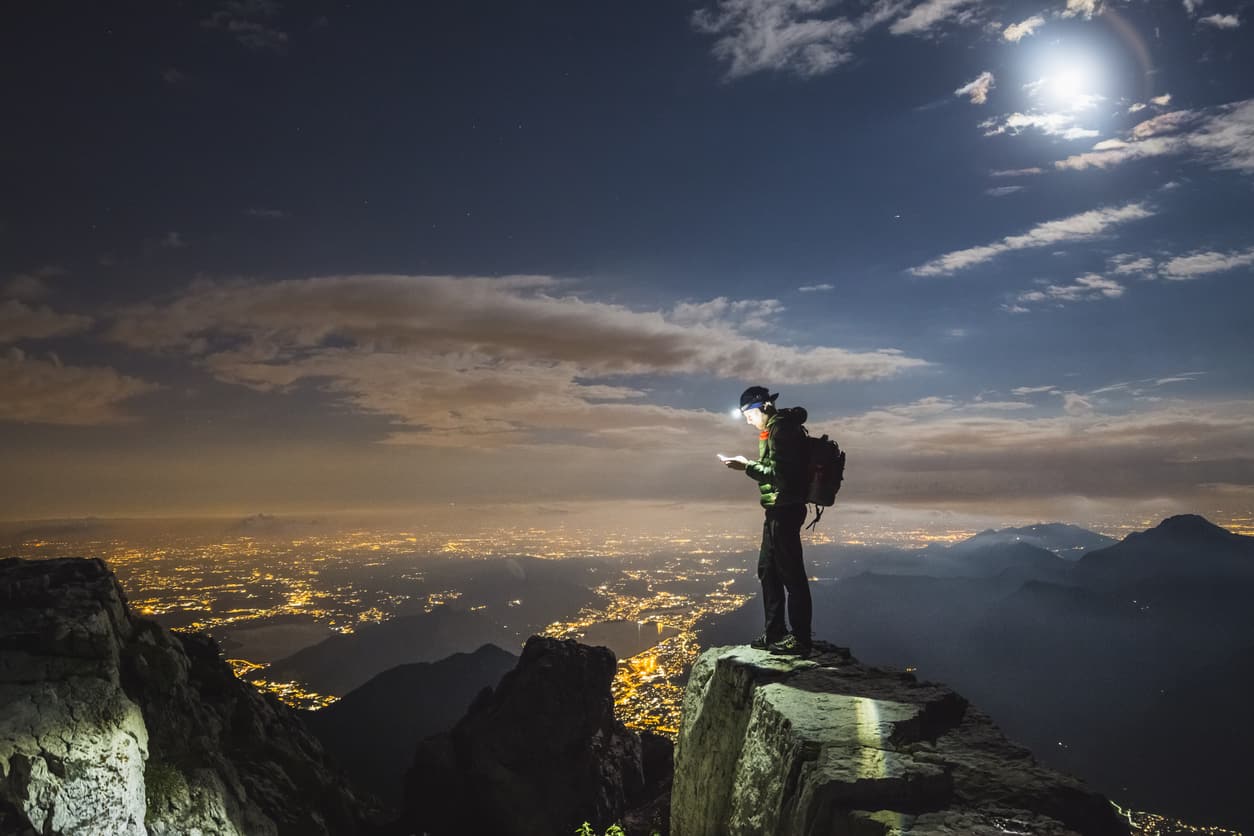
You're going to be shooting in the dark and preferably far away from light-polluted cities, so you need to carry a small flashlight (or even better, a headlamp) in your bag.
Not only is a flashlight handy for checking and adjusting camera settings, but you'll also need one for locating dropped batteries or memory cards.
You never know what kind of animals (or people) you'll encounter while taking night photos, either, so a headlamp is ideal for keeping an eye out for anything that might be sharing your space.
Final Thoughts
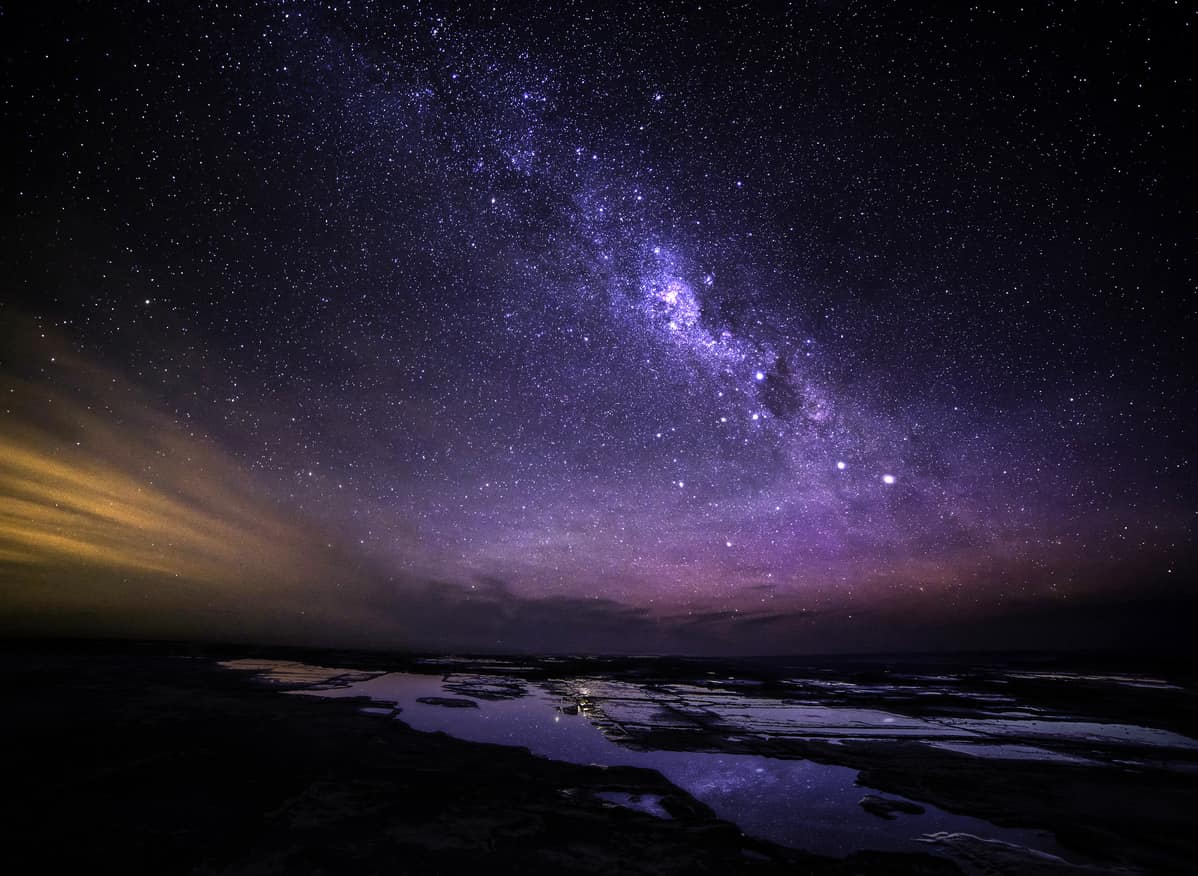
There's not much more needed for a basic astrophotography setup, beyond what you should already have with your outdoor camera gear.
This basic setup and the techniques you can learn in our other astrophotography articles will provide you with wide field images you'll be proud to share.
The real challenge isn't finding great gear to help you get the shots you want - it's finding the time to actually get outside and take the photos!
So, as you think about the gear you need to fill out your astrophotography kit, start planning your adventures and stick to those plans. After all, practice makes perfect!
We Recommend
Astrophotography Tip: How to Manually Focus Your Lens
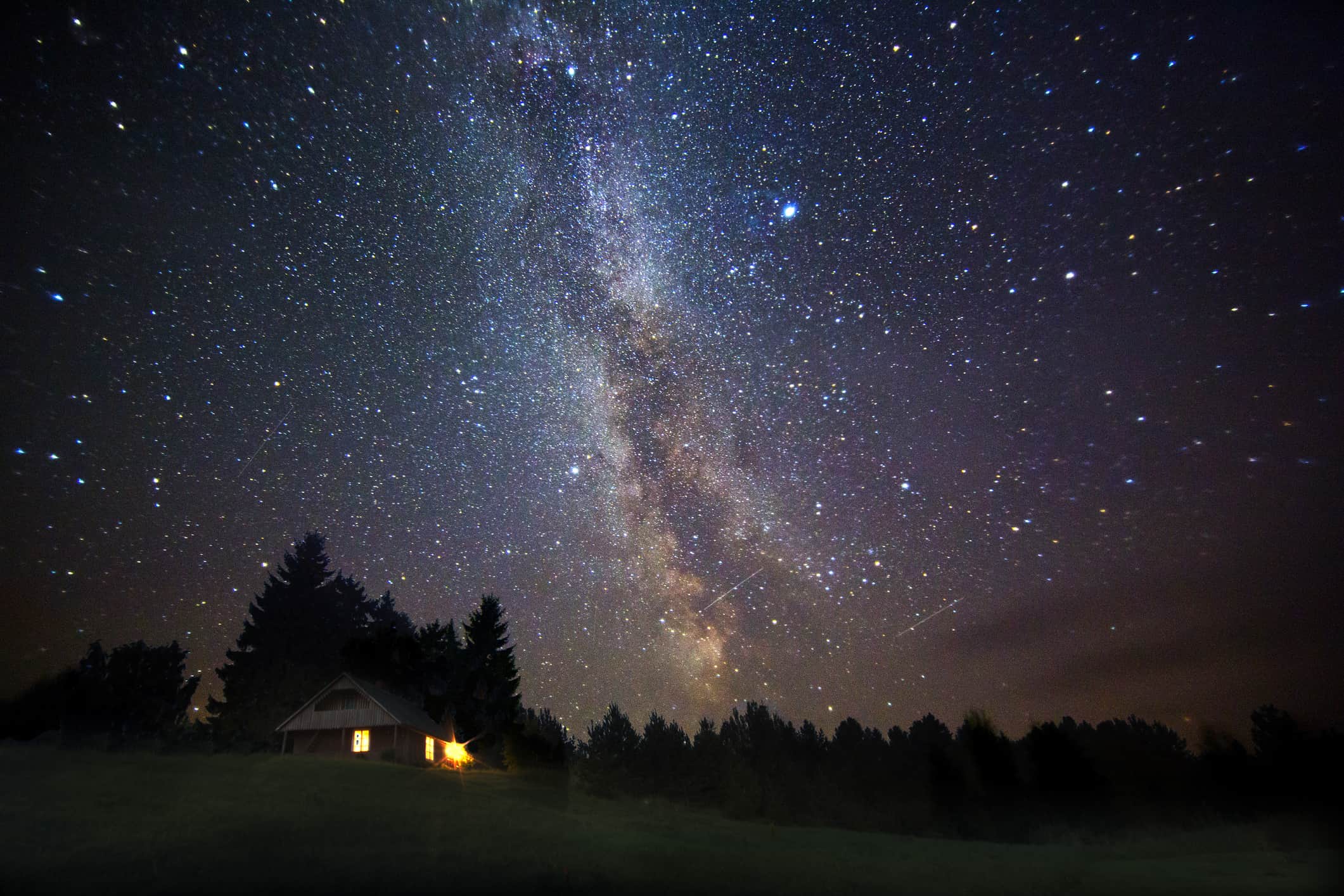
One of the challenges of capturing beautiful photos of the night sky is to get the shot perfectly in focus.
Though modern cameras have incredible autofocus systems, they rely on light to obtain their focus. That means that when you're out shooting stars at night, the camera's autofocus will constantly hunt for the contrast it needs to determine the focus of the shot.
Without being able to rely on autofocus, you'll have to take the reins and focus manually to get clear, sharp photos.
The question is, how do you do that?
Editor's Tip: Want to take improved photos of the night sky? Get outfitted with the necessary gear from MrStarGuy. MrStarGuy is a family-owned company dedicated to offering top-quality products that are affordable and backed by excellent customer service. For astrophotography mounts, tripods, telescopes, and more, visit MrStarguy.com.
Certain Gear Helps
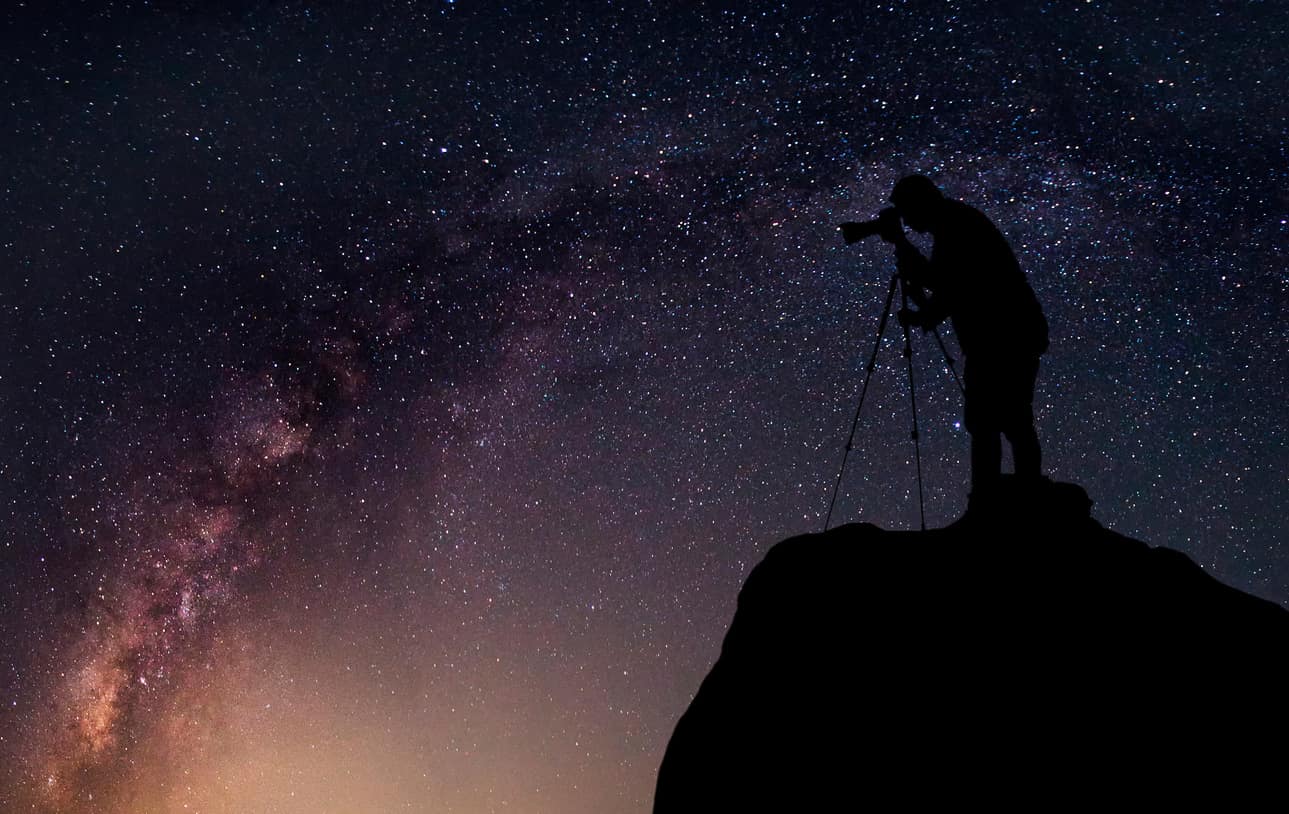
First things first, you need a lens with a large aperture.
The larger the aperture, the more light the lens can collect, and that makes focusing at night much easier.
You don't have to spring for something like an f/1.2 or f/1.4 lens (though that would be great!). If the budget is a concern, a f/1.8 a f/2 or even a f/2.8 lens should do the trick.
Additionally, you want a sturdy tripod that gives your camera a nice, stable base for shooting the photos.
After all, it won't matter how well you've focused the shot if the camera isn't stable to take the photo!
Follow This Procedure
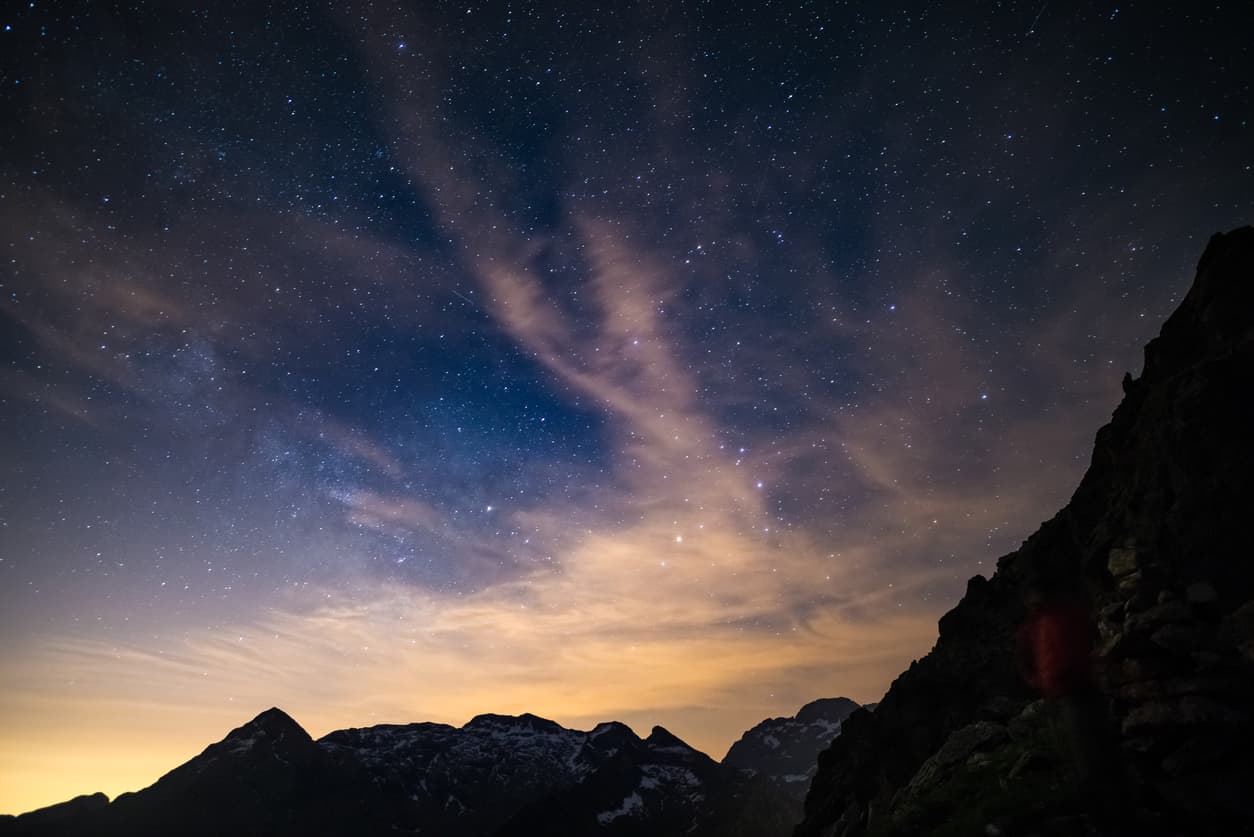
Before I outline the different ways you can focus your lens at night, it's important to note a few basic steps you'll use regardless of the focusing method.
Once you have your camera and tripod set up, you'll need to switch your camera or lens to manual focus.
Ensure you're using a large aperture - f/2.8 or lower - and set the ISO to about 3200. Again, this helps let as much light into the lens as possible and increases the sensitivity of the sensor to light as well.
Using Live View, zoom in on a bright object as closely as possible. While watching the LCD, manually adjust the focus as needed until the subject is tack-sharp.
Once you've got the image in sharp focus, lock down the focus ring with gaffer's tape. You can then adjust the camera positioning as needed to compose your shot.
Manual Focusing Method #1: Pre-Focus
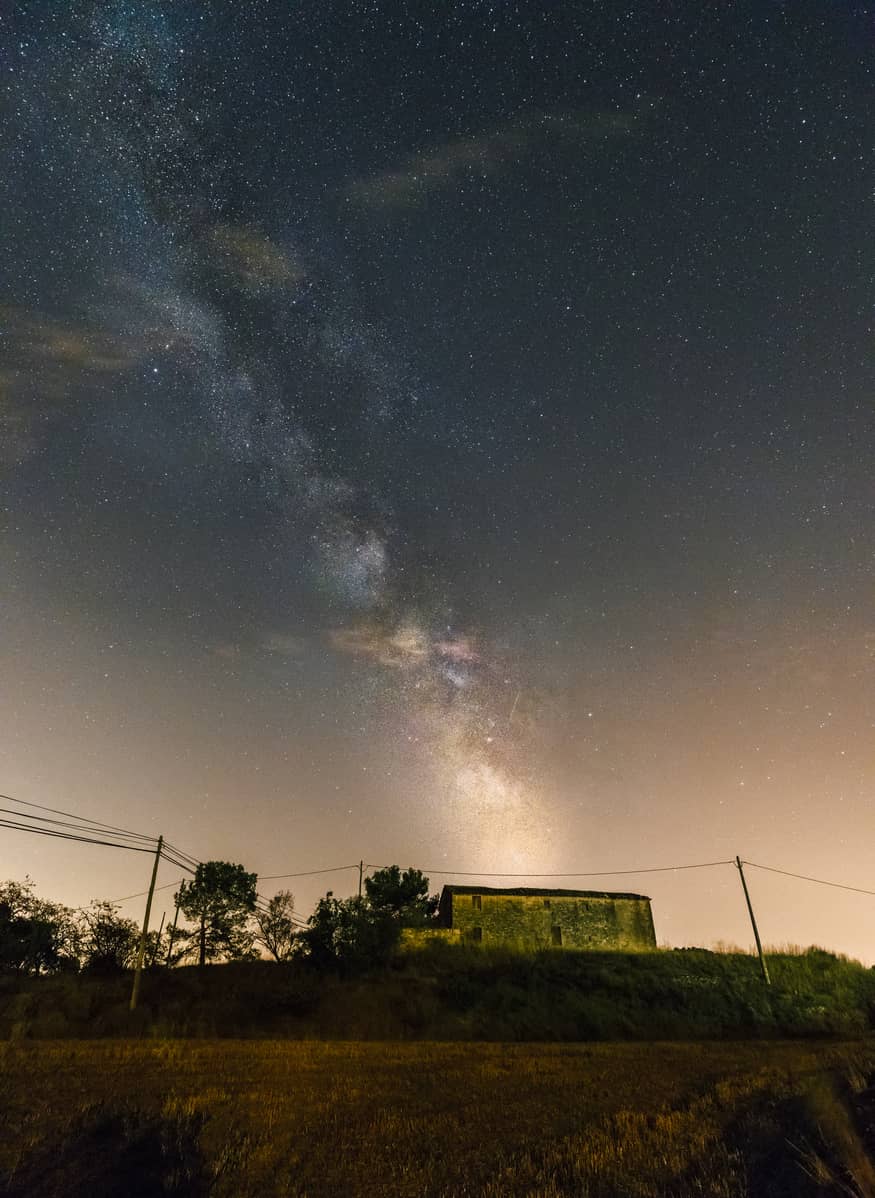
Photography is all about preparation, and this method of manual focus requires some forethought.
Rather than waiting until dark to acquire focus, you can simply pre-focus your lens ahead of time.
Using this method, you can actually focus the shot using autofocus, but you have to be sure to lock the focus in place. This can be done by switching your lens or camera from autofocus to manual focus once you have the desired focus set.
It's important to note the distance marking on your lens when you're focused at infinity. This will help you reacquire the proper focus if you accidentally move the focus ring. As noted above, a better idea is to use gaffers tape to hold the focus ring in place.
Though this is perhaps the easiest method of focusing for night photography, the drawback is that you can't easily refocus the shot later on if need be.
Editor's Tip: If you want to observe the night sky in greater detail, consider adding a telescope to your kit. MrStarGuy offers a variety of astrophotography telescopes that are ideal for viewing the night sky and getting sharp, detail-rich images. Get more details on MrStarGuy's astrophotography telescopes.
Learn More:
Manual Focusing Method #2: Get Help With Artificial Light
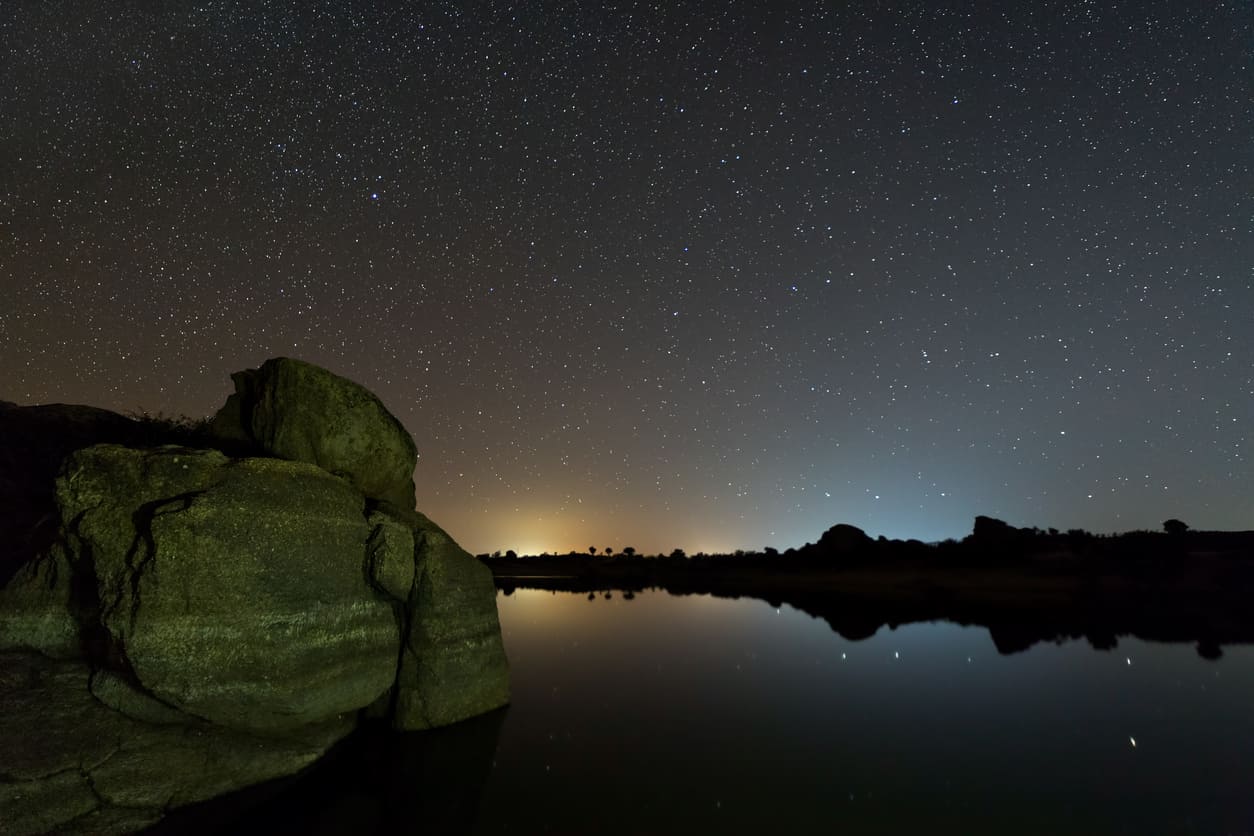
Using an artificial light source is helpful because it obviously gives your lens the light it needs to help you acquire focus.
This can occur in two different ways.
First, you can focus on a distant light source, for example, light emanating from a light pole in the background of your shot.
Assuming the light is sufficiently bright and far enough away (so that you can focus at infinity), this can be a hugely helpful method of getting the focus right in your shots of the night sky.
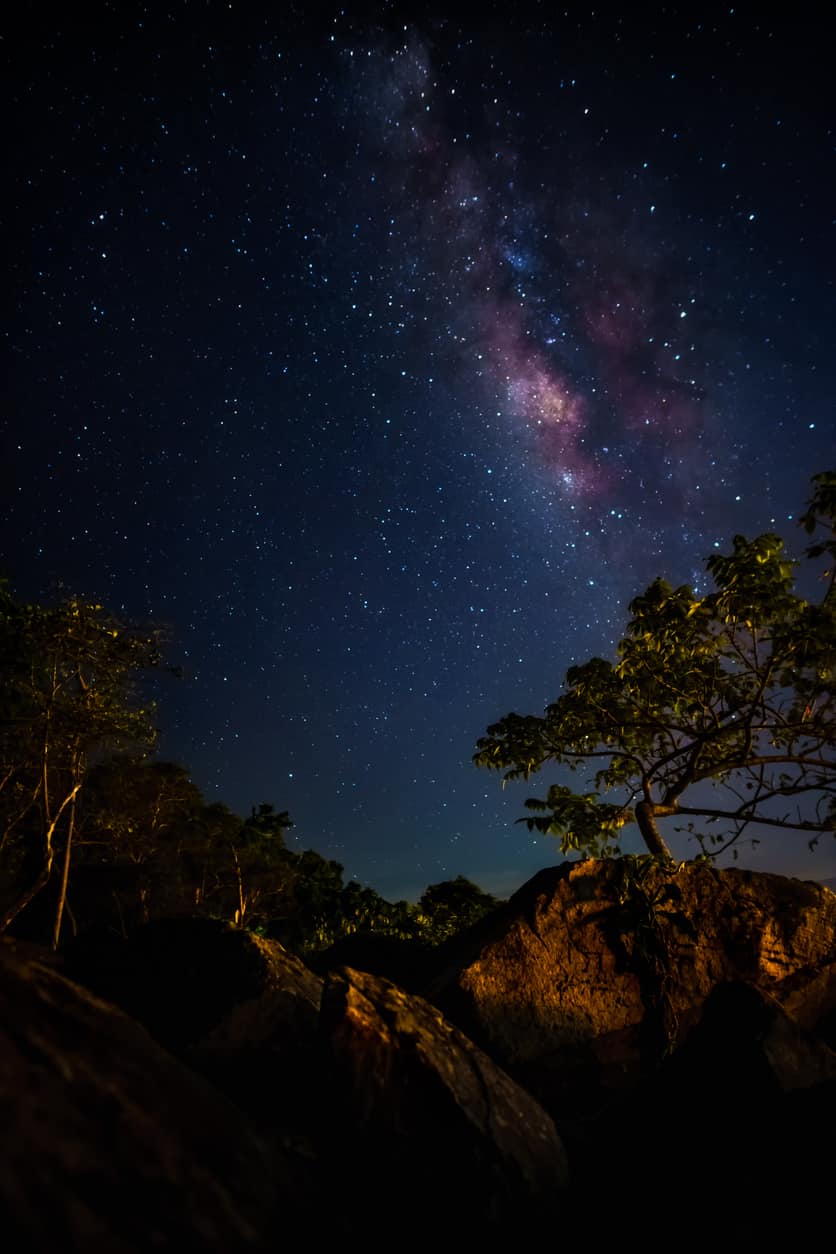
Another way you can utilize artificial light is to use it to light paint in the foreground.
This method doesn't do you much good for focusing on distant objects like stars.
However, if you focus stack your images, you can use a flashlight or a headlamp to illuminate the foreground to get a sharply focused image that you can blend with one you previously took of the sky.
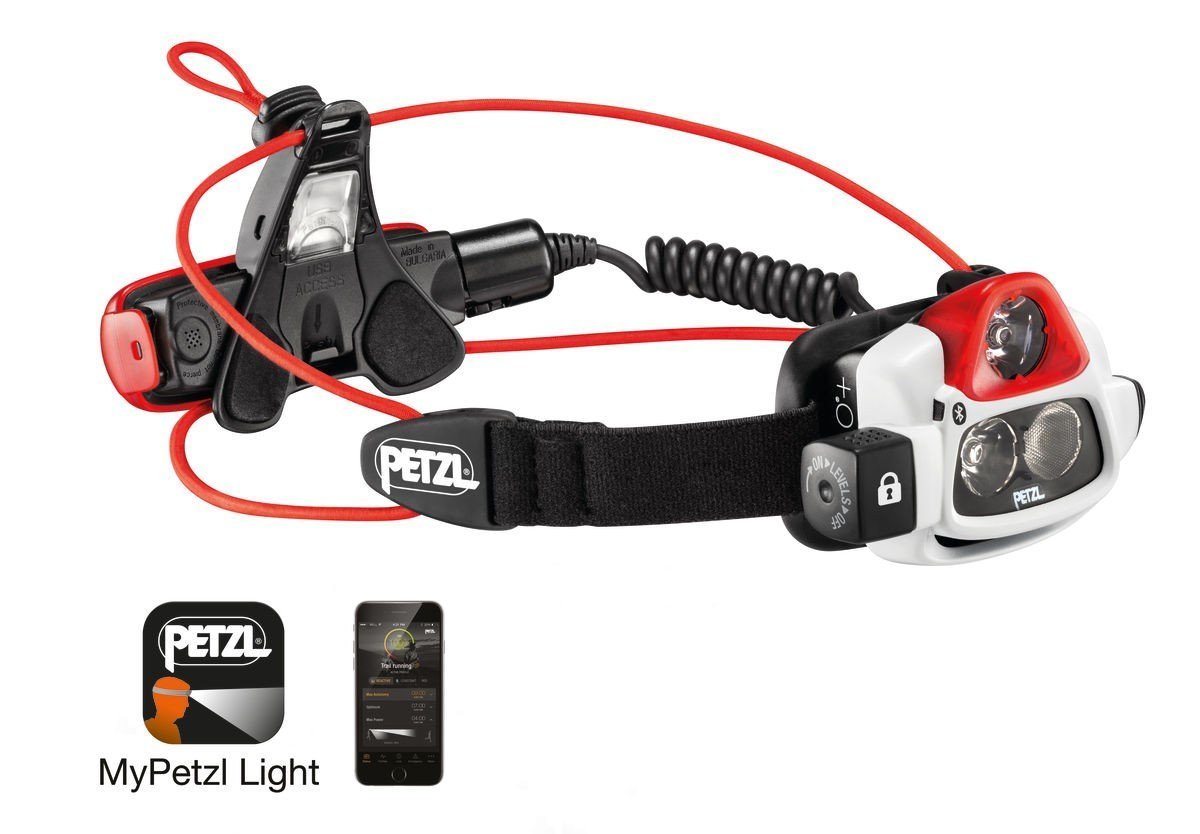
My headlamp of choice is the Petzl NAO + (shown above) because it offers tons of versatility and is a durable rig to boot.
It puts out 750 lumens - more than enough for light painting - so you can create dreamy foregrounds for your astro images.
And not only is it incredibly comfortable to wear, but it also has smart features that make it more functional, too.
In particular, the MyPetzl Light App allows you to keep track of things like battery power, and if you're running low, you can make adjustments to the performance of the headlamp to extend the battery life. Crazy, right?!
The NAO + also boasts a handy feature called Reactive Lighting, which allows the headlamp to instantaneously adjust to the ambient lighting conditions, that way you have just the right amount of light for your photography exploits.
That makes it the perfect choice for light painting and other photography adventures at night!
Either way, if you use an artificial light source to help you get the light you need to focus the shot, it's advantageous to have a lens with an aperture of at least f/2.8 to collect as much light as possible.
Learn More:
Manual Focusing Method #3: Focus on a Bright Star
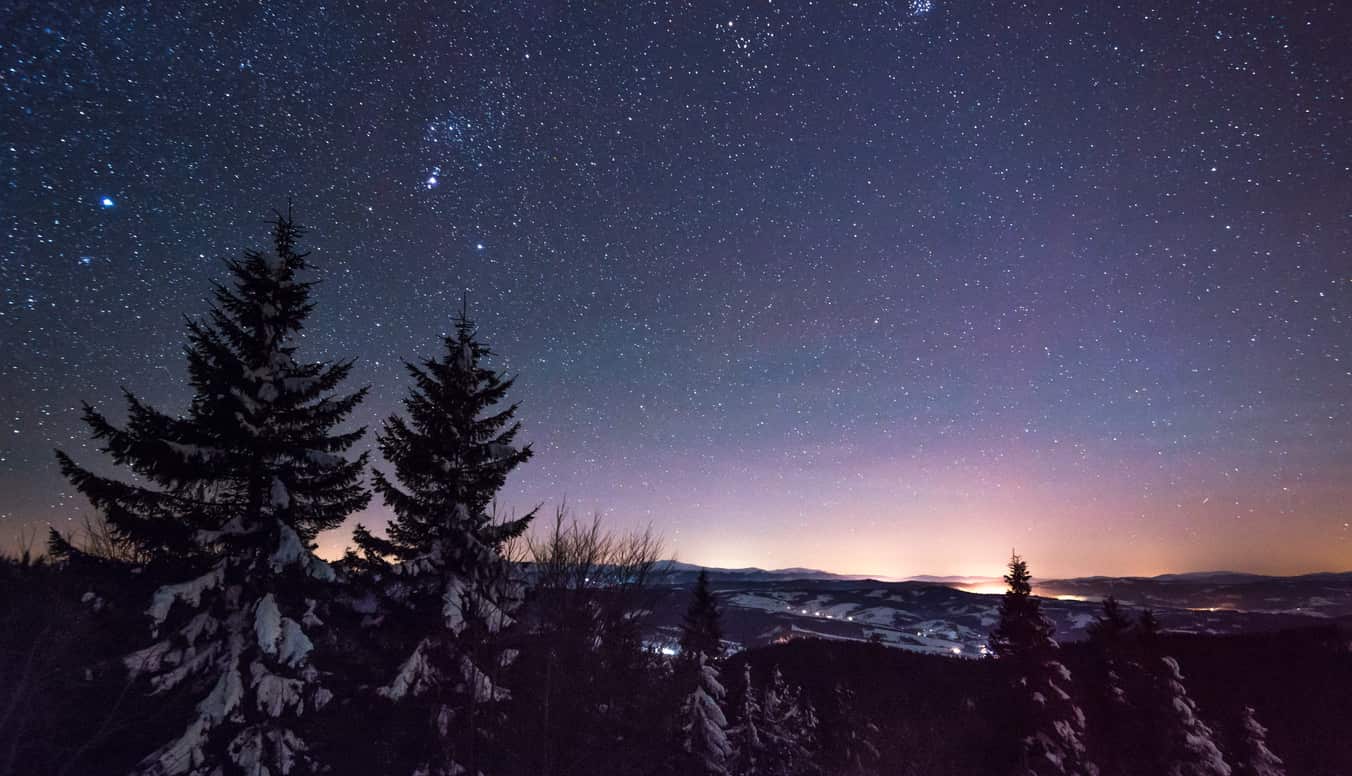
If there's no objects immediately in the foreground of the shot, you can simply use a bright star for acquiring the focus.
To make things easier, you should pre-focus the lens to infinity, as outlined in the first method above. This will at least get you in the neighborhood of having the shot in focus.
That's important because there will be a lot of noise in the shot, so making out stars can be difficult to do.
Using the camera's LCD, zoom in on the brightest star you can find, making adjustments to the focus ring as necessary to bring the stars into focus.
When you think you've got the focus down, take a photo, then review it to make any exposure adjustments. Take additional practice photos until you have a good exposure.
Be sure to zoom in on the images you take to double-check the focus of the shot, refocusing as needed.
If it seems like a complicated process, it really isn't, especially as you get some practice.
In the video above, Greg Benz offers more details about each of these focusing methods and shows you a live demo of how to manually focus at night.
Now all that's left to do is find a dark spot, set up your gear, and set about getting sharply focused images of the stars.
Editor's Tip: For more tutorials on astrophotography, check out our astrophotography section, sponsored by our friends at MrStarGuy. Learn about composition, camera settings, gear, and other essentials for capturing breathtaking photos of the stars and other celestial objects.
Learn More:
We Recommend
Businesses That Will Innovate Photography in 2018

I don't know about you, but I'm incredibly excited about the direction that photography is headed.
We're seeing more innovation than ever in cameras, lenses, and other photography gear, which gives us more power to create epic photos.
Post-processing programs are evolving into highly powerful editing suites that allow us to take our photography to the next level more quickly and efficiently.
We're even seeing changes in how we buy and sell photography equipment, share our photos, and market our businesses.
It's exciting times, for sure!
Here's some of the top businesses in the photography industry that are leading the charge in innovating the artform we love so much.
Sew Trendy Fashion & Accessories
 Legacy Photography
Legacy Photography
Sew Trendy started humbly in a basement just a few years ago.
Today, it's one of the premier wardrobe manufacturers for maternity photography, girls' photography, and newborn photography.
Their success in growing their business is attributable to many different factors, not the least of which that they constantly develop new designs for their line of maternity gowns, girls dresses, and newborn clothing, so photographers have fresh looks to offer their clients.
And in an age in which customer service is often lacking, Sew Trendy certainly bucks the trend. They're with you every step of the way, ready, willing, and able to help you with any questions or concerns you might have.
Valerie Best, the company's Founder and CEO has a lot to do with the success of her company as well.
She's committed to quality, and that shows in every handmade garment that leaves her company's warehouse.
Learn more about Sew Trendy Fashion & Accessories
Sirui

Over the years, Sirui has built a reputation for manufacturing some of the best photography tripods on the market.
I can attest to the quality of their tripods, as I own one!
But Sirui is much more than a tripod company...
They supply photographers the world over with high-quality gear that ranges from monopods to tripod heads, camera bags to lens filters, and even photography accessories for your mobile phone.
As if that's not enough, Sirui also offers a complete line of humidity cabinets, broadcast tripods, and various quick release plates, too.
In other words, Sirui is a one-stop shop for just about all your photography needs, and is definitely a company to keep your eye on in 2018.
CaptureLife

When talking about innovative photography companies that are sure to turn the photography world on its head in 2018, CaptureLife should immediately come to mind.
If you're not familiar with CaptureLife, check this out...
This app allows you to share photos with your clients right on their smartphone.
That means you can streamline how you get photos to clients as well as make it a more personalized process - the images are delivered via a branded text message that's personalized to the client.
On top of that, CaptureLife is a sales platform that allows your clients to order prints right from their phone. They can also share their photos with friends and family, which increases your sales footprint.
Mobile is the future, and if you're in the photography business, you need to capitalize on that by teaming up with CaptureLife!
Click Props

One of the challenges of staying relevant in the photography industry is keeping your ear to the pulse of what photographers need.
Click Props does just that.
With a huge collection of gorgeous portrait backgrounds, Click Props gives photographers the ability to create more impactful portraits no matter who the subject might be.
Aside from their commitment to crafting the best backgrounds in the business, Click Props understands the practical needs of photographers as well.
They offer backgrounds in various sizes, each of which is easy to setup and takedown. They're even easy to clean and easy to store, too.
That means you spend less time messing around getting things setup and stored away, and more time actually taking photos.
What's not to like about that?
Vanguard

Another company that's sure to make waves in 2018 is Vanguard.
I've been a fan of Vanguard for years now, and I can tell you firsthand that in the last couple of years, they've really stepped up their game with their product line.
In particular, their tripods and camera bags are among the best in the business, not just because they have innovative features that make photography easier and more efficient, but because their products are budget-friendly as well.
That means that Vanguard has figured out a way to offer photographers the best of both worlds - high-value, well-made products that won't break the bank.
Vanguard is at the tip of the spear of innovation in photography. If you aren't excited to see what they come up with in 2018, you should be!
Artbeat Studios

Photography isn't just about the gear you use, nor is it just about your skills in composition, framing, post-processing and the like.
Instead, the process of creating an image isn't truly complete until you have a gorgeous print. That's where Artbeat Studios comes in.
I came across Artbeat Studios last year, and after touring their facility, I was blown away by their process and the products they make.
Among their best sellers are their acrylic and metal HD prints, the latter of which you can see in the photo above.
To say that Artbeat's prints are gorgeous is an understatement. What they produce is truly fine art.
That's because they're committed to using archival materials, paying close attention to color fidelity, and providing custom services so you get the exact print you want.
If you're looking to revolutionize the way your photos look, give Artbeat Studios a try!
Learn more about Artbeat Studios
Uniregistry
One of the best things about the photography industry is that there are so many companies doing so many awesome things for photographers.
In 2018, I strongly suggest that you change the way you market your photography business by partnering with Uniregistry.
These guys have two domains - .pics and .photo - that will help you get more eyes on your photos and more clients knocking on your door.
Why?
It's simple - Uniregistry's domains are photography specific, so you can promote your work on your website with a professional and credible domain name.
Not only do .pics and .photo domains tell the world exactly what you do right there in the URL, but they're fresh and new, so the chances of you getting the exact name you want are much greater.
It's just a better way to market yourself on today's crowded internet!
Learn more about .pics and .photo domains
MPB

Let's face it...
Photography gear can be expensive, and all that expense is cost-prohibitive if you're on a budget.
But MPB has changed the way that photographers buy gear because they've created an extensive marketplace where you can find high-quality pre-owned gear for excellent prices.
Not only that, you can sell your old gear to MPB and either pocket the money or get a credit toward the purchase of something on their site.
That means you can refresh your kit from time to time by getting rid of what you no longer want or need and replace it with well-priced, pre-owned gear for less.
Stretch your budget. Get more gear for less. Get better gear for less, too. Not bad, right?
SHUTTERbag

Not that long ago, there was a lack of photography gear specially designed for female photographers.
But in 2010, that all changed when SHUTTERbag was founded.
SHUTTERbag specializes in crafting leather camera bags for women that are beautiful and functional, too.
This commitment to quality is evident in every SHUTTERbag model.
For mom photographers on the go, SHUTTERbag offers the Girls Day Out bag (shown top left, above).
This ingenious camera bag has three separate compartments - one for your camera gear and two zippered compartments for things like a tablet for business tasks and books, toys, diapers and other items for your kids.
Like all SHUTTERbag models, the Girls Day Out is the height of form and function.
It’s an ideal size for daily use, and with its built-in organizational aids, you can keep your photography stuff separate from your personal items with ease.
That means you can grab your camera, your phone or a diaper at a moment’s notice.
Now that’s how you get more production out of your day!
SHUTTERbag’s Trailblazer bag (shown top right, above) is another example of commitment to innovation.
This bag has a unique style and flair that make a strong fashion statement, but don’t think that this bag is just about looking good…
Inside, you’ll find room for a camera body and up to four lenses. Alternatively, you can carry two camera bodies and three lenses. There’s even a spot for your tablet or laptop!
With padded dividers that are removable and adjustable, you can truly customize this bag to suit your specific needs.
For mid-range carrying capacity, SHUTTERbag designed the Heirloom 5-in-1 bag (shown bottom left, above).
Not only can this bag accommodate a camera, three lenses, and up to a 15-inch laptop, but it can also be carried in a variety of ways - as a tote bag, a messenger bag, a shoulder bag or even as a backpack.
Talk about innovation!
Their Journey bag (shown bottom right, above) is a tote bag that’s made of genuine leather and features a breathable cotton lining that provides a soft surface for your gear inside the bag.
The Journey has a detachable strap that has a slip-resistant shoulder pad that gives you confidence when carrying your bag either over the shoulder or across your body.
The bag can easily accommodate a camera with a 70-200mm lens attached, as well as a laptop, a tablet, camera accessories, and personal items like your checkbook and smartphone as well.
And as if their bags aren’t enough to impress, consider this - SHUTTERbag is a small business, so they treat their customers like family.
That means that you not only get to choose from a wide array of incredible camera bags, but you know that you’ll get the service you deserve before, during, and after the sale, too.
nPhoto

When you think of photo albums, you might think that they're all the same or that there's not much room for improvement.
But you'd be wrong.
nPhoto has proven that by becoming one of the top producers of photo albums and other products in the world.
Their handcrafted albums, triplexes, photo boxes, and other products are second-to-none in the industry.
nPhoto uses the best materials to construct their products, from fine textiles and leatherettes for their album covers to silk and metallic papers that give each page of their albums a hefty, crisp, and expensive feel.
What's more, nPhoto gives you plentiful options for customizing their albums, so you can get something that's truly your own or tailored to your clients' specific tastes.
Taking great photos is only half the battle - how you present them matters, too. If you work with nPhoto, you'll certainly have the presentation aspect of it down pat.
MyStudio

The MS20PRO 20”x20”x12” tabletop photo studio by MyStudio is an ideal accessory to help you take your product photography to the next level.
Unlike many other tabletop studios, this one offers a seamless cyclorama infinity background with 90-degree corners that gives you many more shooting angles to highlight the products that you’re photographing.
The studio comes with dual 5000k color-corrected daylight fluorescent lamps, which offer tons of light for your images while providing excellent color as well.
MyStudio also includes 9”x12” white and black bounce/fill cards with easel stands to create nice, even lighting, and a pair of 9.5”x11.5” white and black reflective acrylic panels to create beautiful reflections beneath the products you photograph.
The folks at MyStudio have even produced a series of instructional videos that are available on their YouTube page to get you going with your new photo studio!
MrStarGuy

I only became familiar with MrStarGuy in the latter half of last year, but they quickly became one of my favorite photography companies.
For starters, MrStarGuy is an authority on astrophotography gear - no matter what you need, whether it's a scope, a mount, a tripod, or something in between, MrStarGuy has what you need.
Secondly, these guys offer their high-quality products for prices that you can actually afford. You get tons of bang for your buck, which isn't always the case in photography.
But maybe most importantly, this family-owned business is committed to service before, during, and after the sale.
They're genuine folks that want their customers to feel like old friends.
If you're excited to expand your photography horizons this year and tackle some night sky photography, be sure to visit MrStarGuy to get all the gear you need.
DJI

When I think about where photography is headed in the future, I can't help but think of drone photography.
And when I think of drones, DJI comes to mind.
DJI has some of the very best drones in the business. That's true whether you're a beginner drone photographer or an experienced veteran.
What makes DJI's drones so great is that they're packed with features - like collision avoidance systems and gesture-based flight controls.
Additionally, there are a plethora of options, upgrades, and add-ons that you can use to customize your drone to get the ideal flying and photographic experience.
As drones become more and more popular for photography, you can bet that DJI will be leading the charge in innovating how drones are built and how they perform.
Macphun/Skylum

Macphun has been around awhile, and they've developed a reputation as one of the best in the software business.
As they rebrand and become Skylum, it's important to note that this small team of software experts continues to make waves in the photography industry.
In fact, they've won tons of awards over the years for their products, most recently for their impeccable Aurora HDR 2018, which was named by Apple as the app of the year for 2017.
Considering how many apps there are these days, that's quite the achievement!
Speaking of achievements, with Macphun's software, like the aforementioned Aurora HDR, as well as their Luminar 2018, you can achieve great things with your images.
Not only that, but you can create better-looking photos in less time and with less effort, all within platforms that are smartly designed and give you an effortless workflow.
My goal this year is to do a better job of processing my images, and with Macphun by my side, I have no doubt that I will achieve that goal.
Learn more about Macphun/Skylum
Lensfinder

Have you ever wanted a new lens but just couldn't bring yourself to shell out the kind of money needed to get truly high-quality glass?
Well, that worry is over now that Lensfinder is on the scene.
Lensfinder is a marketplace where - you guessed it - you can find lenses for great prices.
If you're looking for a rare or high-end lens (or everyday lenses, for that matter), you can use Lensfinder's easy search tools to locate what you need.
Then, you can communicate with the seller, ask questions, and even pay for your new-to-you lens via PayPal, right there within Lensfinder.
You can also sell the lenses you no longer want, too, so it's the best of both worlds.
Lensfinder has built-in fraud protections, seller feedback ratings, and other smart tools that help make your transaction as smooth as possible.
If you want to upgrade your kit this year, check out Lensfinder!
Spider Holster
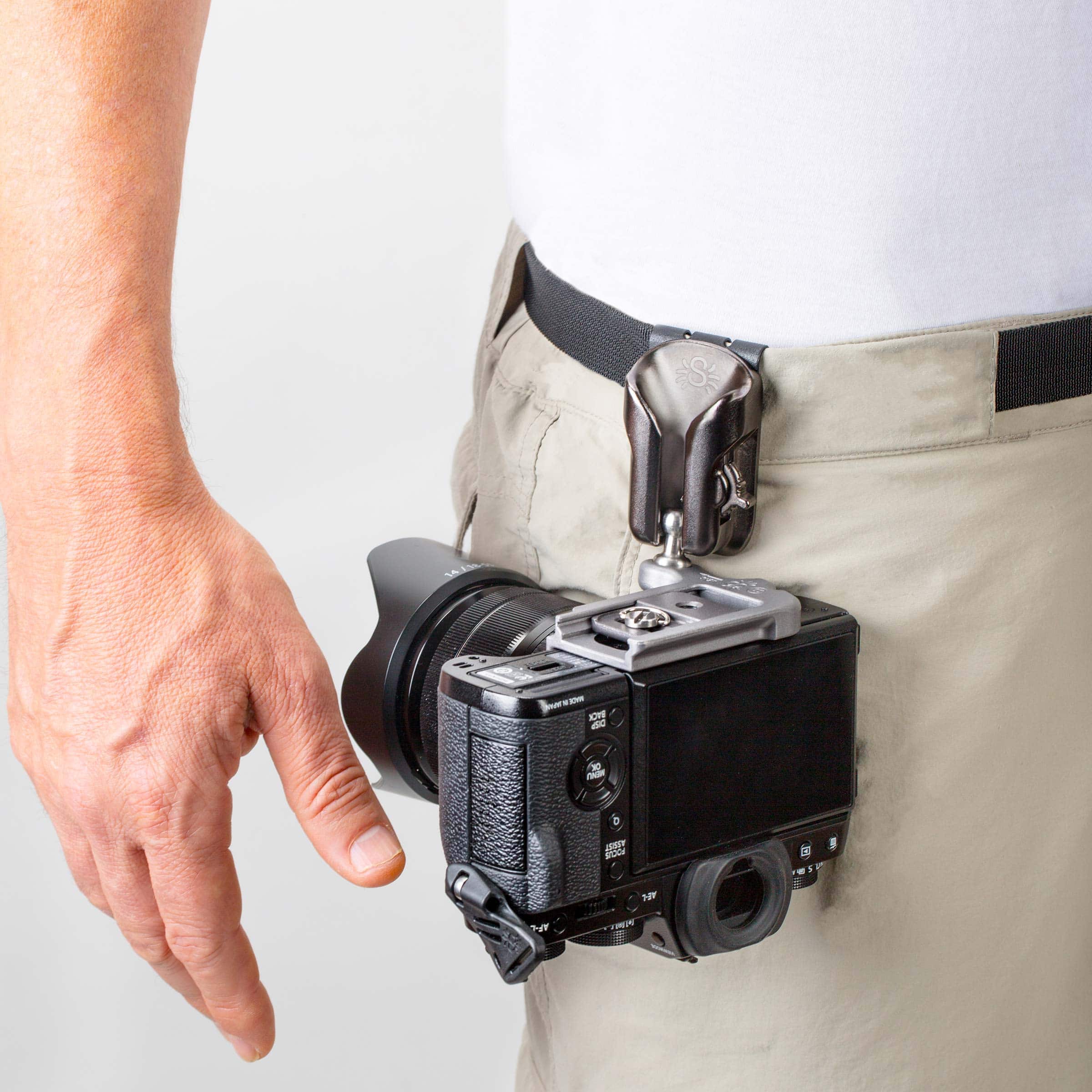
My biggest complaint about cameras is the terrible strap that comes with them at purchase.
The OEM straps are thin, uncomfortable, and just plain get in the way when you're trying to take photos.
That's why Spider Holster is such a game-changer, because they're responsible for getting your camera off your shoulders and onto your hips where you can carry your cameras with greater ease and security.
Just looking at the photo above, you can imagine how much more streamlined your workflow would be if you're using a Spider Holster.
You can carry one camera or two using the Spider Pro (for big DSLRs) or the SpiderLight (for compact, mirrorless, or small DSLR cameras).
They even make hand straps that put your camera right in your hand in the ideal shooting position, all without a long strap always getting in your way.
Spider Holster has revolutionized how to carry cameras. In 2018, I strongly recommend that you let Spider Holster revolutionize the way you work.
Learn more about Spider Holster
Next Insurance

When many people hear the word "insurance," they cringe.
But who can blame them? Buying insurance has historically been a process that's time-consuming and frustrating.
Not now.
Next Insurance has changed how photographers purchase insurance because they've cut out the middleman.
Instead of dealing with a broker, you can visit Next Insurance's website, get a free quote, and get the coverage you need faster and for less money.
By cutting costs, Next Insurance is able to pass those savings on to their customers, so you can get the best coverage without breaking the bank.
From equipment protection to liability for damages to advertising claims, Next Insurance has policies and coverages that will ensure your business will prosper for years to come.
Learn more about Next Insurance
CanvasHQ

Canvas is one of the oldest mediums that artists use for their work.
But, boy, is it still a gorgeous way to print your photos!
That's especially true if you order canvas prints from CanvasHQ.
Like many of the companies on this list, CanvasHQ demonstrates a commitment to crafting the highest-quality products using the finest materials.
And because of that, their canvases look like a million bucks. I should know - I have several in my house!
CanvasHQ gives you a mountain of options to customize your prints, and each print comes with a 100% satisfaction guarantee.
These guys are a small family business, so when you order your canvas, you'll feel like a member of the family, not just another customer.
If that's not enough to convince you to buy from CanvasHQ, I don't know what will!
Syrp

If filmmaking is your passion, then you need to see what Syrp has to offer in 2018.
As one of the most innovative companies in the photography industry, Syrp is always at the leading edge of what's new for filmmakers.
Their line of products helps videographers of all skill levels and experience to create breathtaking films.
Their Genie Mini motion control device (shown above) - which gives you control over your camera to create time-lapse videos using your cell phone - is just one of their incredible products.
They also have sliders, filters, ball heads, motion control bundles, and much more, so you can get outfitted for filmmaking quickly and without spending a ton of money, either.
Never before has making time-lapses and real-time videos been so easy!
Microsoft

I fully admit that I've been an Apple enthusiast for quite some time.
However, my love affair with Apple has waned in the last few years, and that's thanks to Microsoft.
Even though it's a household name and one of the largest companies in the world, Microsoft still approaches the process of creating products the same way - with the end-user in mind.
In particular, their Surface line of products is especially impressive for photographers because they have technologies that make the daily grind of business easier and make things like post-processing a more efficient process as well.
With touch-enabled screens, innovative tools like the Surface Pen and Surface Dial, and machines that are stocked with technology that makes them faster, more efficient, and with more battery life, there's a lot to love about what Microsoft is doing with the Surface product line.
If you want to maximize your workflow, consider seeing what Microsoft can do for you.
Wolverine Data

Sometimes, being innovative means helping bring the past into the present.
That’s precisely what Wolverine Data does.
Their new Wolverine 8mm & Super8 Reels to Digital MovieMaker is a fully automated gadget that digitizes all those old 3, 5, 7 and 9-inch film reels into high-quality movies at 1080p.
It’s a standalone machine that handles the frame-by-frame conversion without the need for software or drivers, or even a computer. The film scans directly to the machine where it’s saved to a SD/SDHC card (not included). The entire process requires just a few steps to complete.
The resulting movies are compatible with all Windows, Mac, and Linux systems, and you can playback the digitized movies directly to a TV with the included TV cable.
If you don’t have tons of old film reels collecting dust on a shelf in your house, I’m willing to bet you know someone that does...
Instead of letting those films degrade and take family memories along with them, this year, use Wolverine Data’s innovative new movie maker to convert your films to digital before those memories are lost forever!
Learn more about Wolverine Data
MyStudio
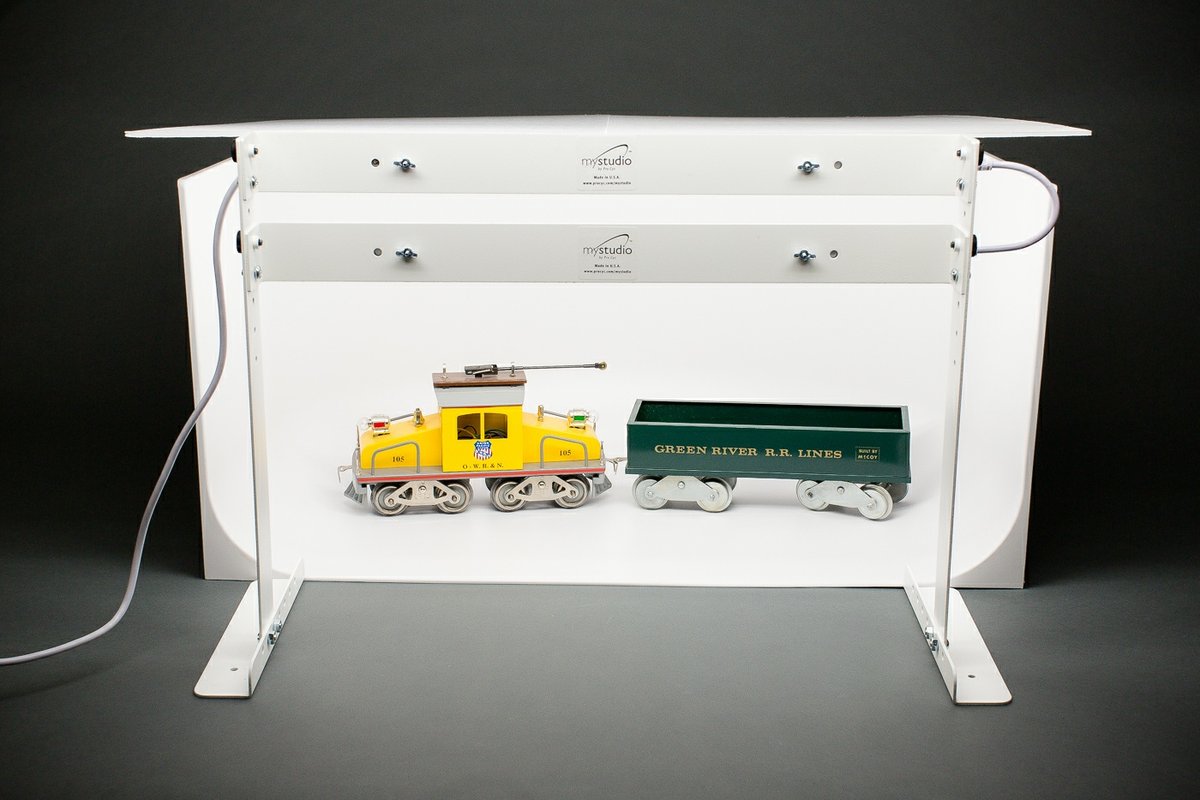
This company is so impressive, I decided to put them on this list twice!
If you photograph products that are bigger than what the MyStudio MS20PRO can accommodate, the MyStudio US31 tabletop photo studio is the perfect choice.
Measuring 31”x19”x16”, it gives you plenty of room to maneuver your products, and true to form, MyStudio has ensured that from every angle, your images benefit from a gorgeous infinity background.
This tabletop studio features two color corrected, 5000K ultra bright LED lights that bathe the studio (and your products) in bright, clean, even light. These lamps are so bright, in fact, that you don’t need any additional lighting whatsoever. Just set up the studio, place your products inside, and you’re ready to go!

You can see just how clean and even the lighting is in the sample photo I took of my camera gear and bag.
I took that image when I was at Photo Plus 2017. I had the pleasure of seeing the folks from MyStudio while I was there, and managed to closely inspect the craftsmanship and materials used in their US31 studio.
They clearly took no shortcuts in the quality of materials used or in the build quality. The design allows for even distribution of light, and quick set up. In short, I was more than impressed with the US31 Studio!
Joy
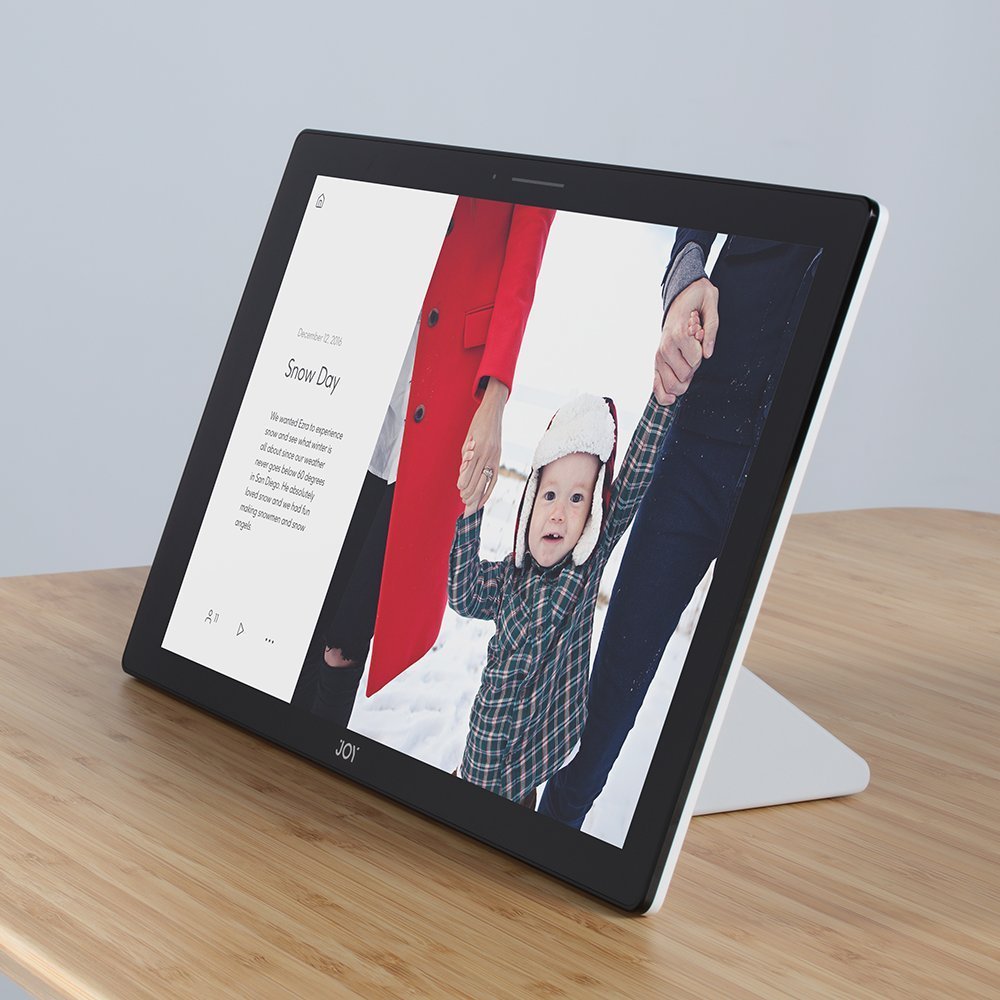
One of the downers about taking photos is that eventually you run out of room to display them.
But the Joy Smart Photo Album takes care of that issue...
It's not your everyday digital photo album, either. Instead, Joy is a storytelling device that allows you to connect with your friends, family, and loved ones because it has voice notes that allow you to narrate each photo memory. You can even conduct voice calls between two Joy devices and share a screen so you can share memories together with loved ones that are far away.
The great thing about Joy is that it doesn't have to remain on the shelf or table - you can take it with you to the couch to enjoy up-close.
And when you aren't enjoying the photo album in your lap, it has a wireless charging stand that charges its batteries and displays your photos in slideshow mode.
Joy has a companion mobile and web app that allows you to load new albums and even invite friends and family to add their photos for display. You can easily pull photos from social media as well.
And with a 13.3-inch full HD display, your photos will look beautiful, too!
Holdfast
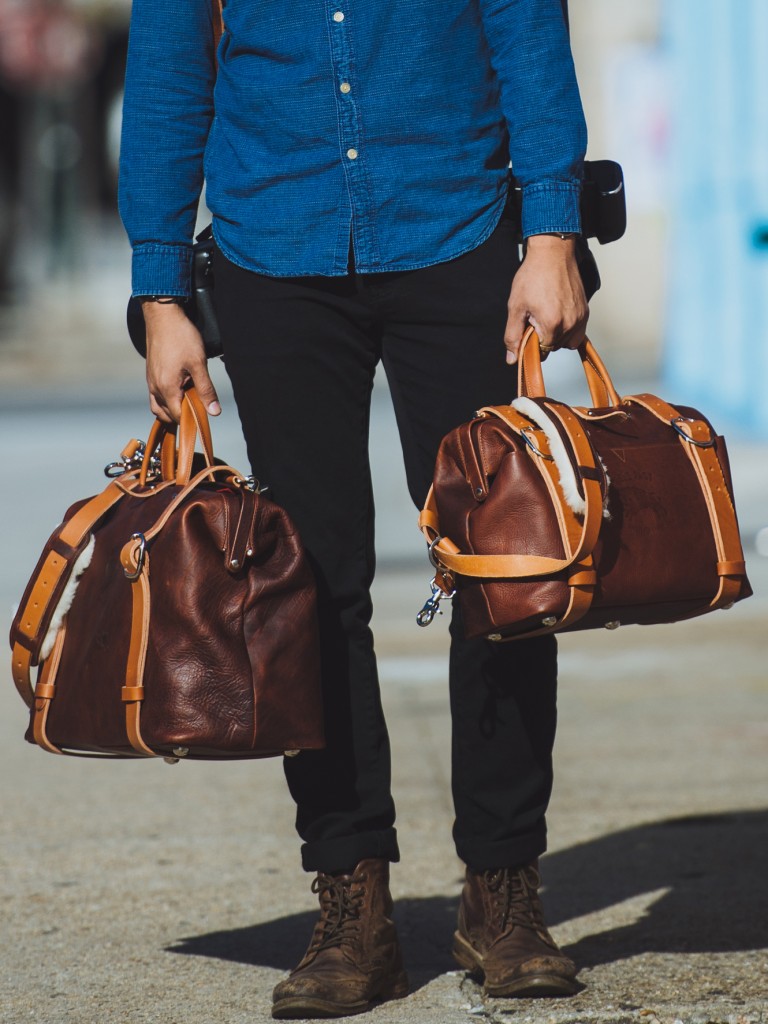
One of the hallmarks of a great photo is attention to detail - ensuring that each aspect of the image is perfect.
Well, that sentiment holds true for photography gear, and there's no one better at the details than Holdfast.
These guys make some of the most incredible camera bags I've ever seen. And that's saying a lot because I've owned plenty of great bags over the years.
But what sets Holdfast apart is that attention to detail I mentioned, as well as the amazing materials they use to craft their bags and other products.
We're talking about bridle leather, water buffalo leather, American bison leather, and even python skin.
On top of that, Holdfast's products are smartly designed so you can carry more gear, more efficiently, all while keeping each piece of kit safe and secure.
If you're looking to upgrade your camera bag in 2018, look no further than Holdfast.
Alpine Labs

When you talk about companies that have revolutionized how you take photos, Alpine Labs has to be in the conversation...
Their Pulse camera remote - and now their new Spark camera remote - have made taking great still photos, time lapse videos, long exposures, and real-time videos much easier and more accessible to even novice photographers.
These gadgets are packed full of powerful software and hardware that literally make it possible for you to create a time lapse video with just a few presses and swipes on your mobile phone.
Creating long exposures is equally as easy.
But don't think that because Alpine Labs has made things easy that their products are somehow cut-rate.
These are the best camera remotes on the market, and Alpine Labs is constantly making them better. That just makes me wonder what they have in store for us in 2018!
We Recommend
Crazy Facts About the Milky Way to Think About as You Photograph It
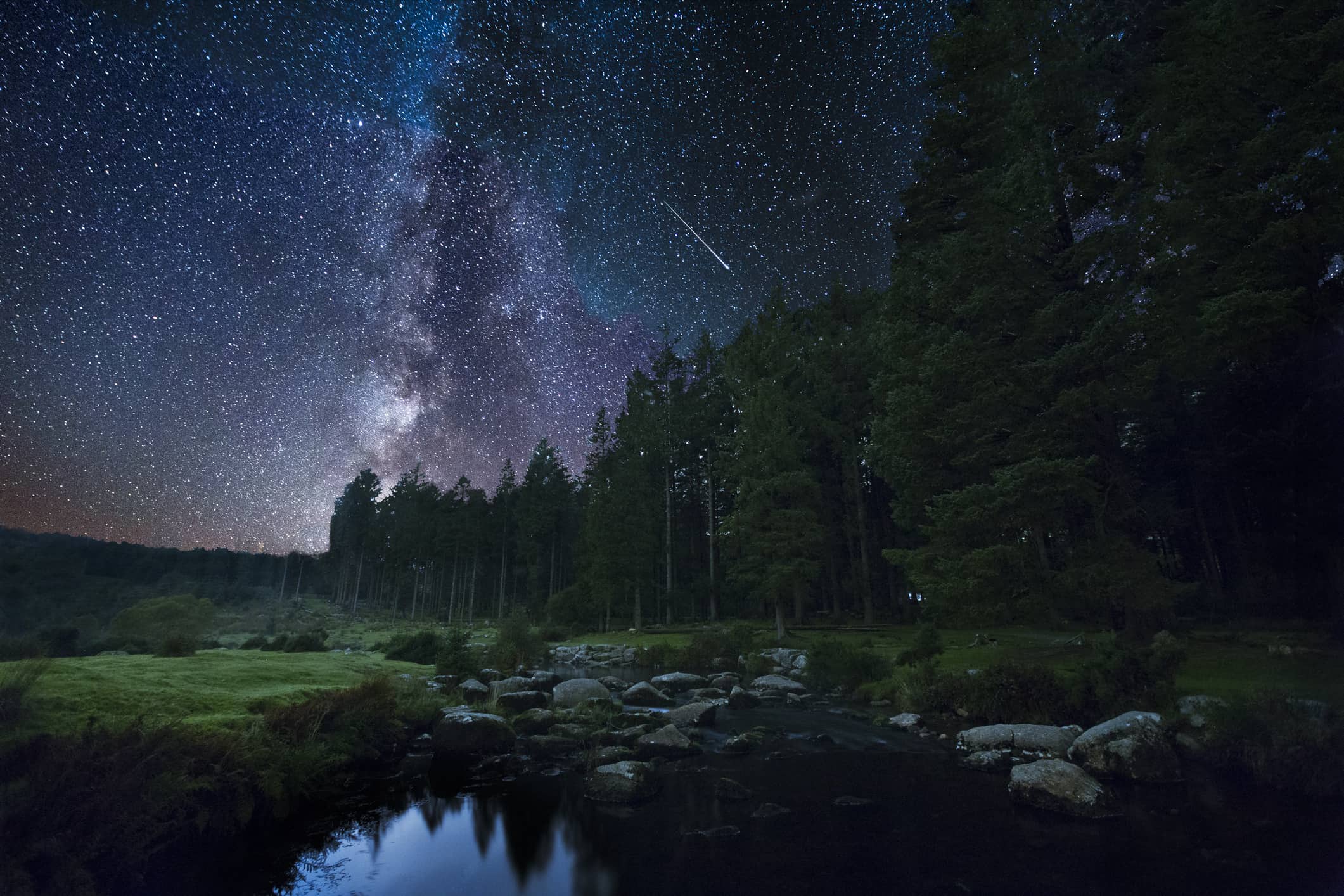
When you grab your gear and head out at night to photograph the Milky Way, you're probably thinking about photography stuff...
You know, composition, framing, camera settings, and so forth.
But have you ever stopped to think about your subject and how incredible it is?
The next time you've got a Milky Way photo shoot planned, think about the following intriguing facts about our home galaxy.
At the Center of the Milky Way is a Huge Black Hole
The black hole at the center of our galaxy isn't just big, it's supermassive.
Called Sagittarius A, it's so big that it weighs about 4 million times more than the sun.
It's never been seen before because it's shrouded in a thick cloud of gas and dust, but astronomers are working on a way to get the first glimpse of this black hole.
Most galaxies have black holes at their cores, so the Milky Way isn't unique in that regard. But the sheer size of Sagittarius A is a little unusual.
Get a look at the center of our galaxy in the video above by the Chandra X-Ray Observatory.
Learn More:
- How to Photograph the Milky Way (in Simple English)
- These Common Astrophotography Mistakes are Holding You Back
A Shroud of Dark Matter Engulfs the Milky Way
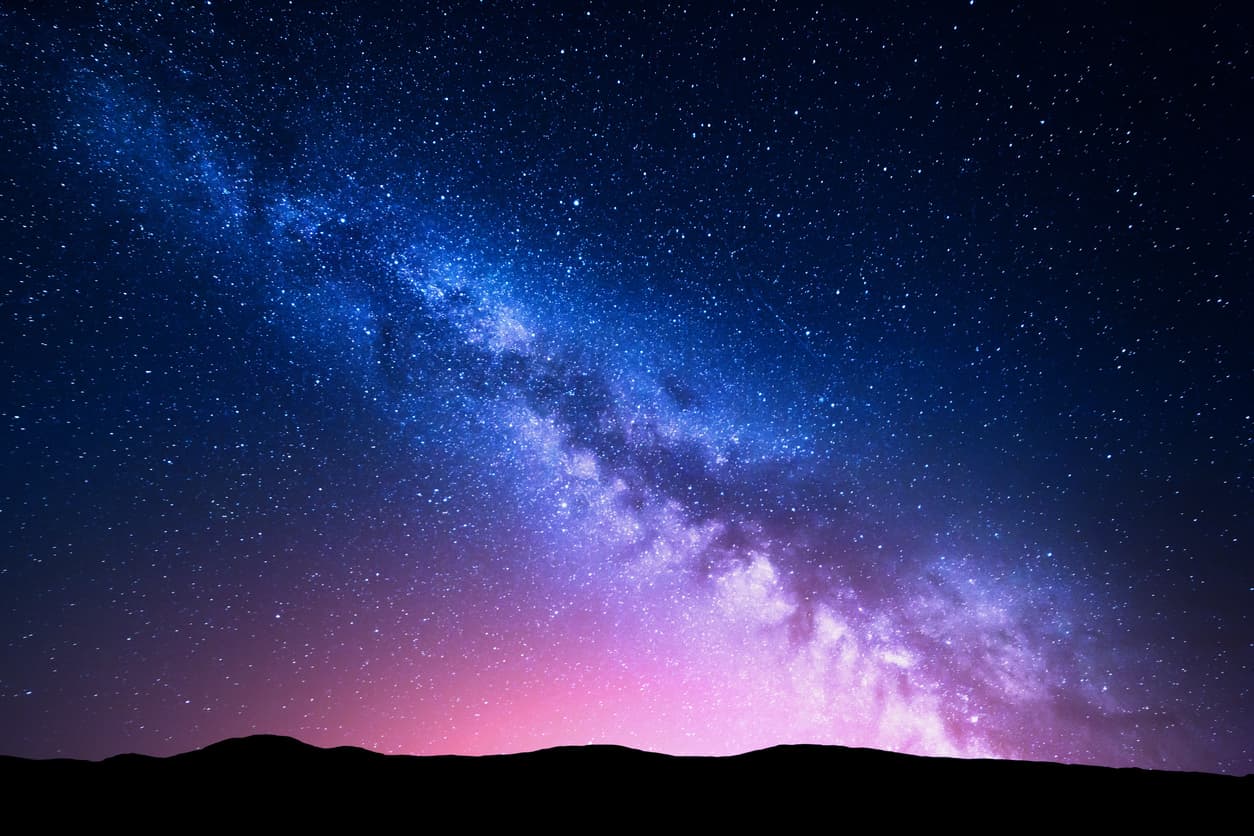
The dark matter that surrounds our galactic home is much, much larger than the galaxy itself.
It's more than a mysterious cloud, though.
Since stars in the galaxy rotate around the galaxy's center at such incredible speeds, without something there to hold them in place, the stars would simply fly outward.
Shaped like a halo, this dark matter actually prevents that from happening, keeping the galaxy together.
The Milky Way Consumes Nearby Galaxies
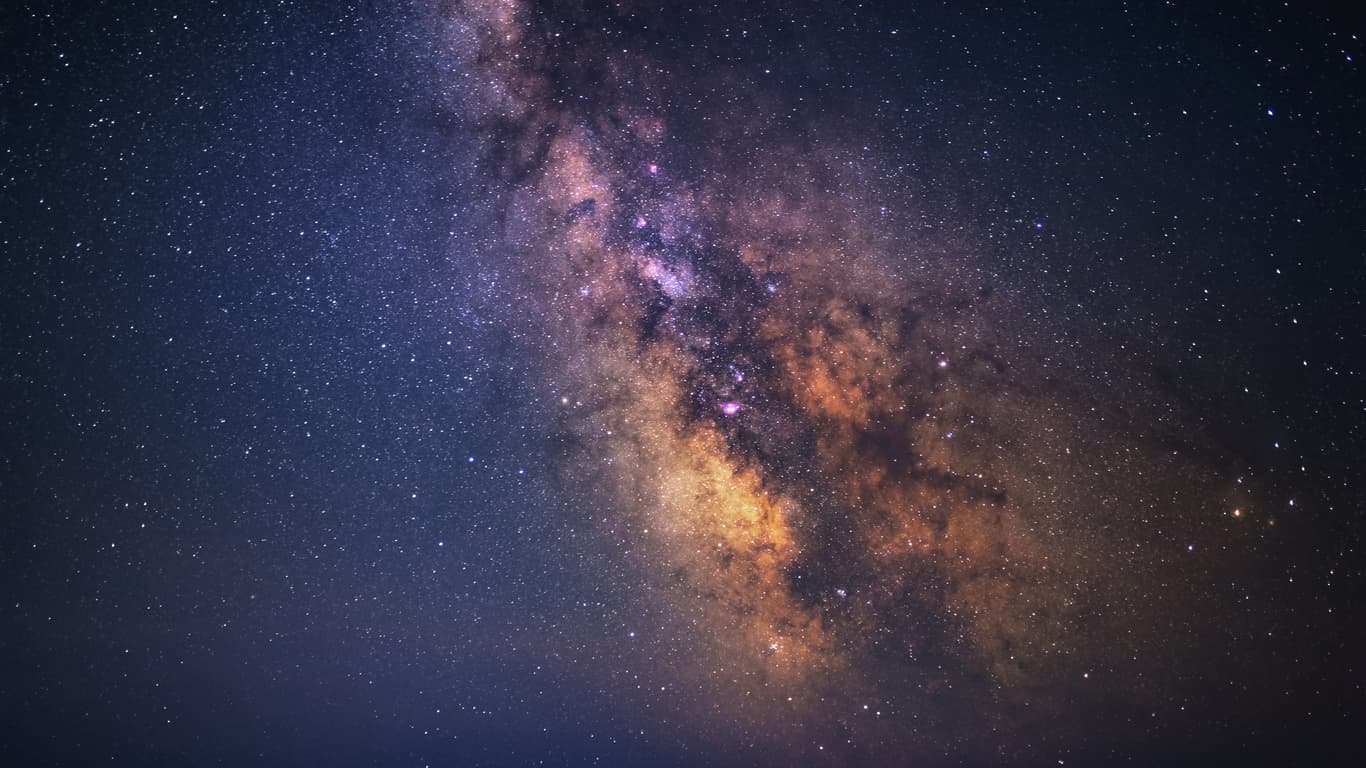
The Milky Way seems to have an appetite...
How do we know?
Decades of scientific study have revealed about 24 remnants of stars on the edges of the Milky Way.
These leftover stars are parts of galaxies that once existed, but got too close to the Milky Way.
The Milky Way was able to gobble these galaxies up because its gravitational forces were much stronger than those smaller galaxies.

Editor's Tip: Maximize your ability to get beautiful, clear, and sharp images of the Milky Way by using the Vixen Polarie Star Tracker from MrStarGuy. This device attaches to a normal tripod and accommodates cameras that weigh up to seven pounds. Using the built-in compass or North Star Alignment Window, you can orient the Polarie to face north, and once set, it will track the motion of the stars as they move across the sky. This eliminates star trails and results in tack-sharp images of the Milky Way. Visit MrStarGuy to learn more.
Our Galaxy is Mostly Flat
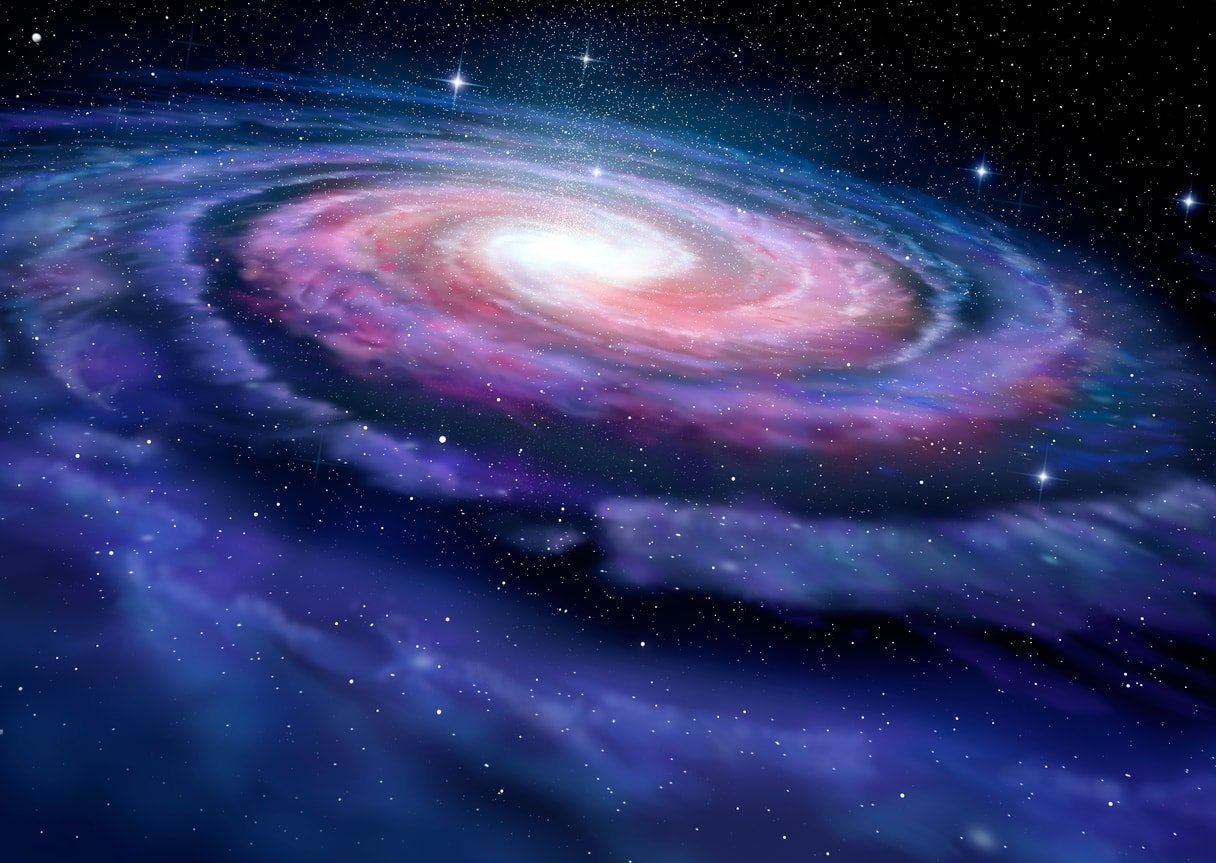
Earth might be round, but the Milky Way is virtually flat.
Scientists have measured the Milky Way at one hundred thousand light-years across, but it measures just one thousand light-years thick.
We're located in one of the galaxy's "arms," roughly 26,000 light-years away from the core of the Milky Way. At the core is a huge collection of stars and dust.
The illustration above depicts what the Milky Way might look like from afar.
Learn More:
The Milky Way Isn't Just a Band of Stars in the Sky
When you look at the Milky Way, you can clearly see it streaming across the sky like a ribbon.
But that ribbon of stars is just part of the Milky Way. In fact, every single star you see when you look up at the sky is in the Milky Way.
If you find a spot that's dark enough, you can actually see the clouds of dust and gas in deep space that prevent some of the light from stars from reaching earth.
In the video above by daveachuck, you can take a simulated tour of our galaxy, beyond the dust and gas that prevent us from seeing further into space.
The video uses images taken by the Spitzer Space Telescope's infrared view of the sky.
The Milky Way is Dying
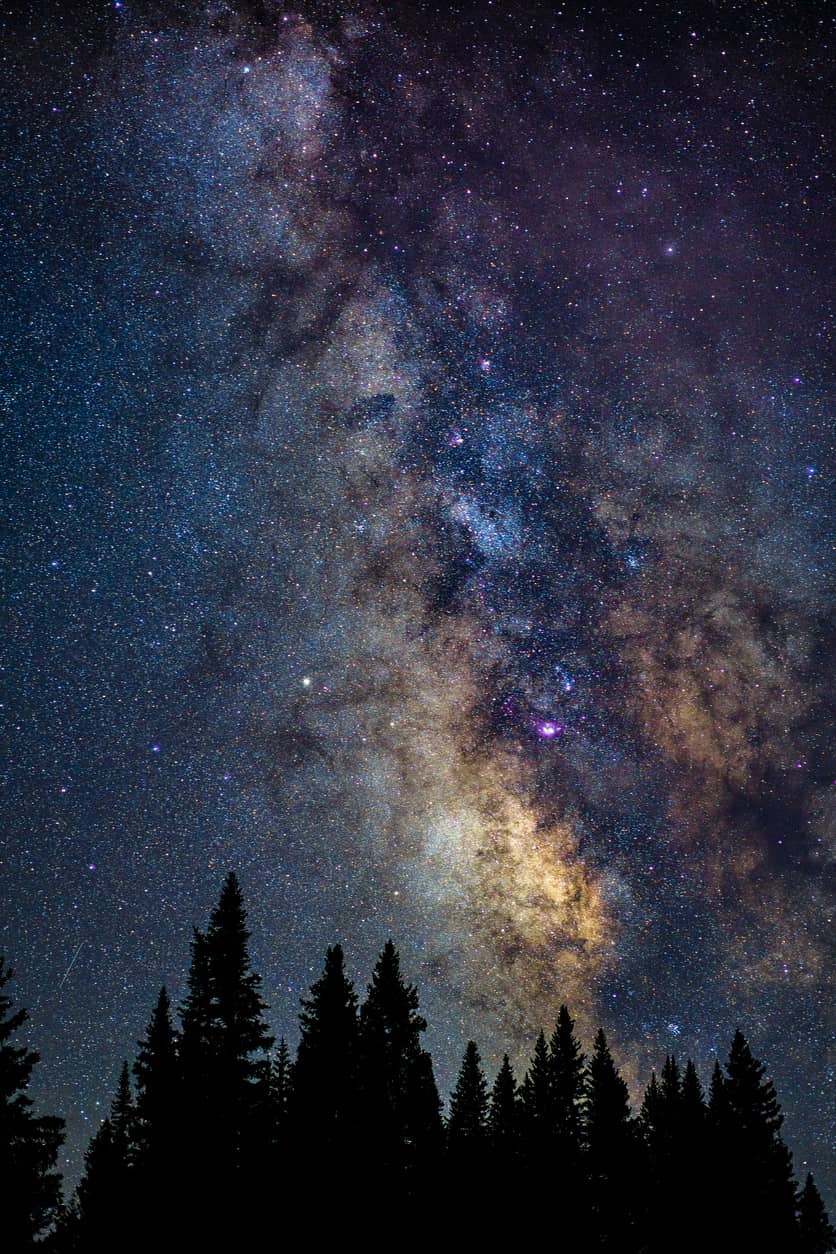
The Milky Way's nearest neighbor, the Andromeda Galaxy, is getting nearer and nearer.
At some point, likely around 4 billion years from now, the two spiral galaxies will collide.
And though that sounds like something that would likely destroy everything in the two galaxies, scientists don't think that will happen.
Instead, the theory is that the two galaxies will combine, with very little damage being done to the stars and planets in either galaxy.
In fact, scientists believe that Earth will survive, and that the newly combined galaxy will provide an even more incredible show in the sky than we already see today.
Editor's Tip: For more tutorials on astrophotography, visit our astrophotography section, sponsored by our friends at MrStarGuy.
We Recommend
Essential Astrophotography Questions, Answered
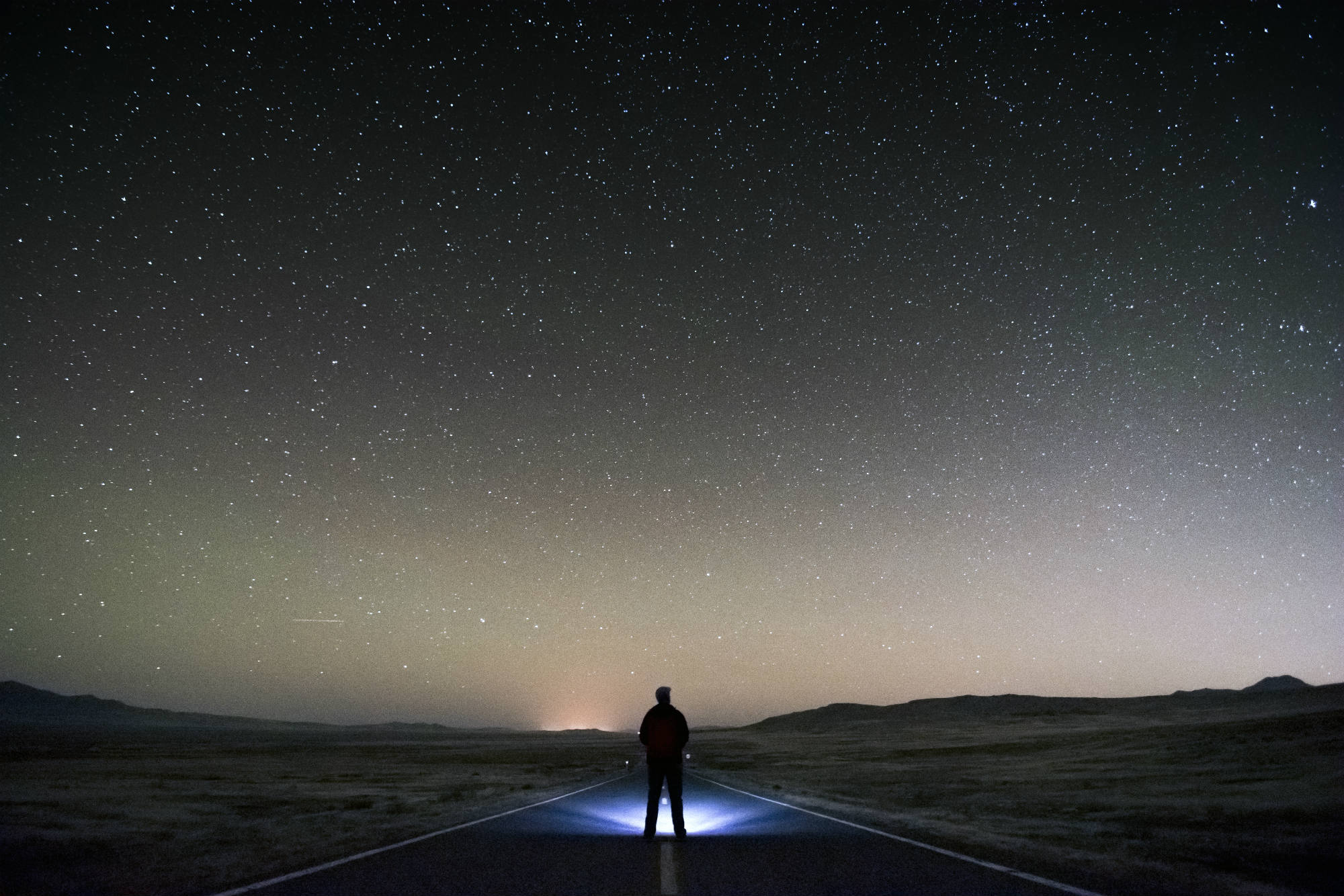
There are many challenges with astrophotography, to be sure.
But it's a mistake to think that it's not something that the average photographer can master.
In fact, if you're armed with the right gear and have a strong understanding of the fundamentals of photography, astrophotography doesn't have to be any more difficult than taking a regular photo.
In the night sky photography tutorial below, we've answered a few questions about astrophotography camera settings and other common questions.
Astrophotography Camera Settings: What White Balance Should I Use?
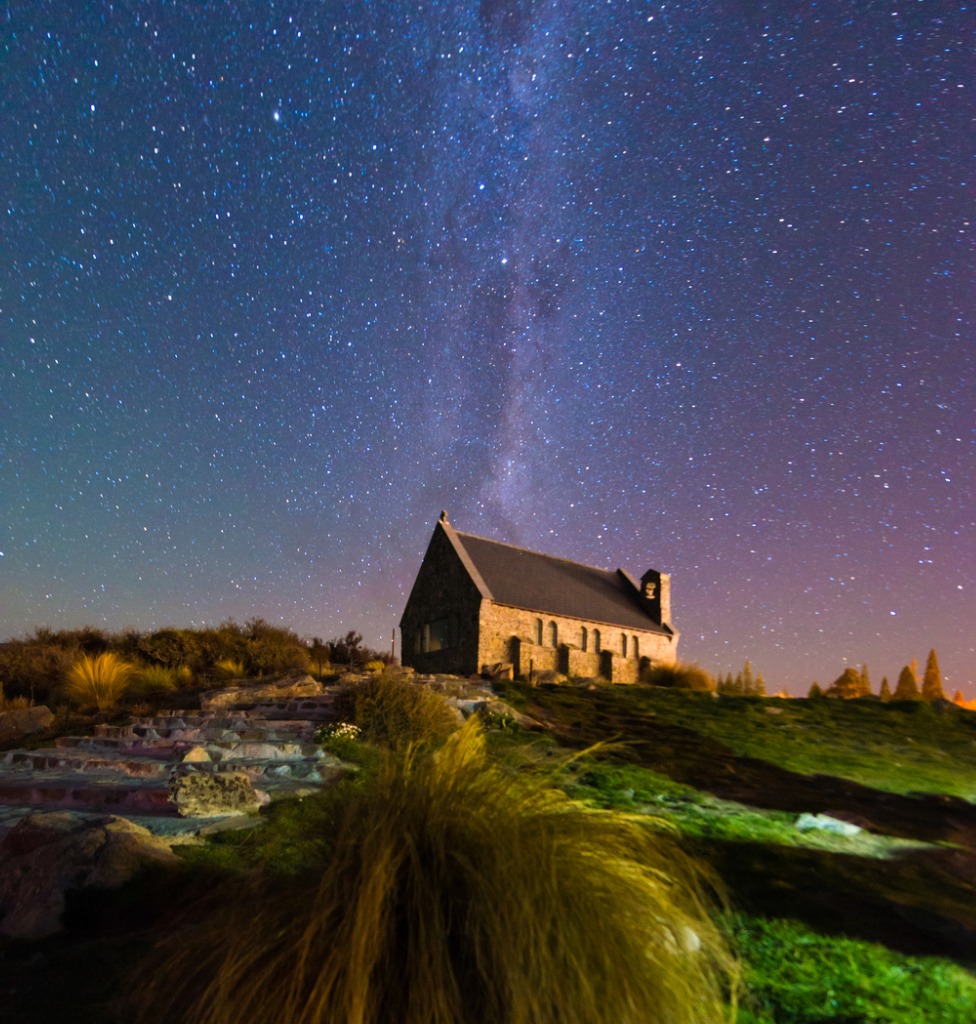
The nice thing about digital photography is that if the white balance is off in your images of the night sky, you can always correct it in post-processing.
Even better, shooting in RAW enables you to make white balance adjustments before you open the file in Photoshop, Lightroom or whatever program you prefer to use.
However, getting the white balance just right in-camera will save you the time required to fix it later.
In many cases, the daylight white balance will get you the best results.
Though it seems counterintuitive to use the daylight white balance setting when taking photos of the night sky, it produces the best colors of the stars.
Learn More:
What Aperture is Best for Astrophotography?
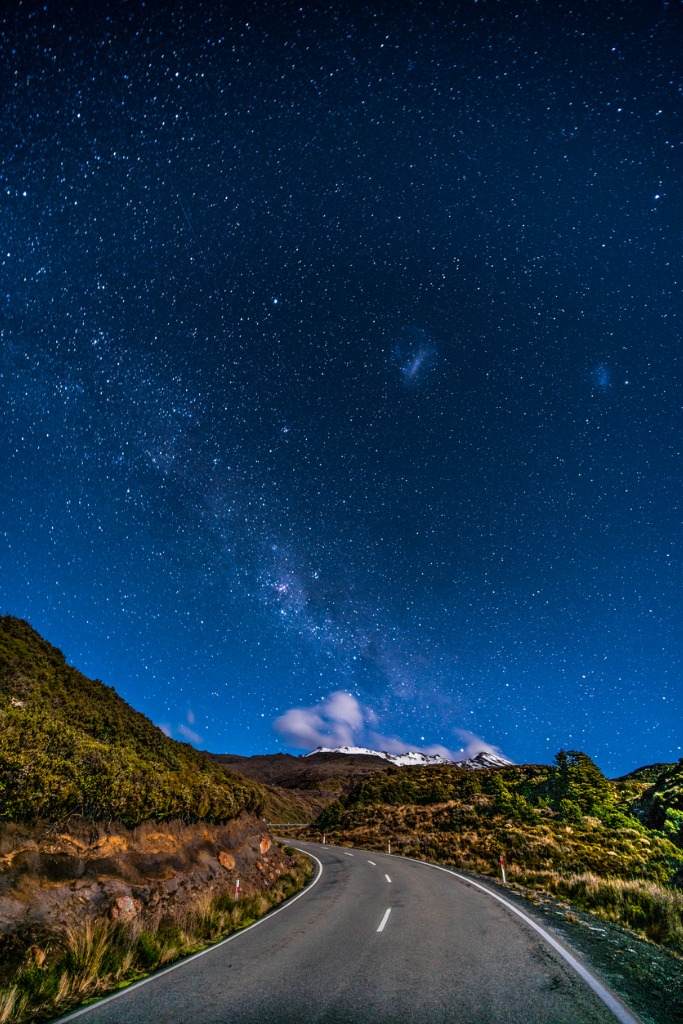
When thinking about how to do astrophotography, a primary question people have is what aperture is the best?
Well, the answer to that question is that it depends.
That's because each situation is unique and each lens performs a little differently.
So in some situations, an aperture of f/3.2 might be the best bet while in other situations an aperture of f/8 might work better with many variations in between.
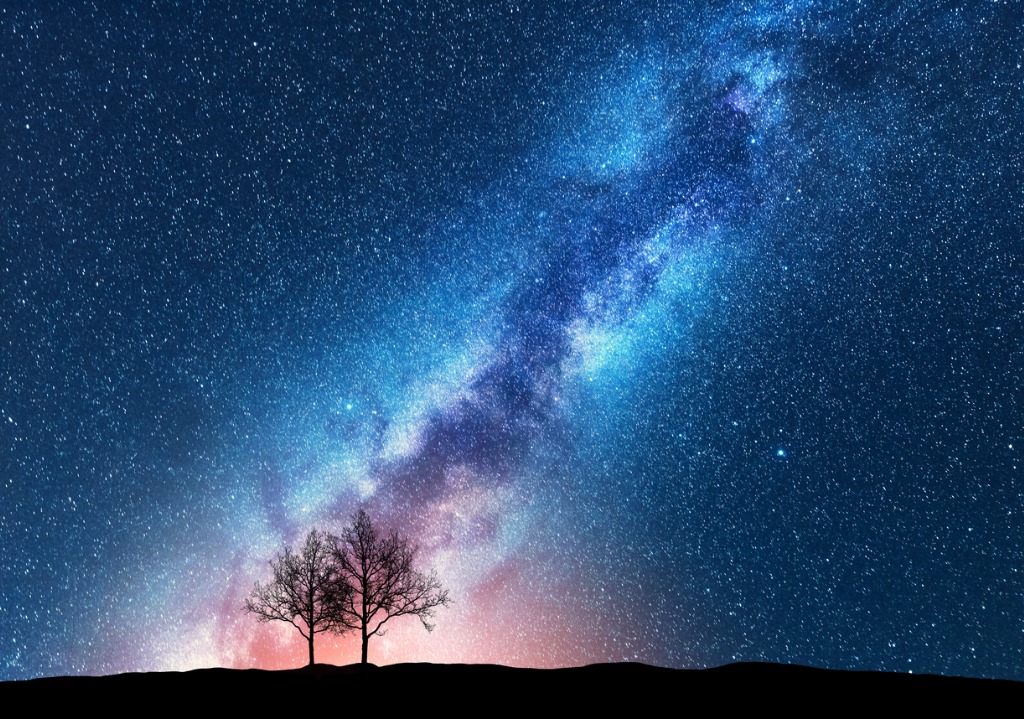
What's important to remember is this: the smaller the aperture, the lower the amount of light entering the lens.
So, if change the aperture from f/2.8 to f/5.6, you'll need to either extend the shutter speed or boost the ISO (or both) to brighten the image to account for the reduced amount of light.
But also keep in mind that while larger apertures allow more light into the lens, they also don't provide as sharp of results as shooting with an aperture closer to the lens's sweet spot.
That is, shooting at f/2.8 might be great from a light perspective, but shooting at f/8 might get you a much sharper photo.
As with many things in photography, finding the right aperture for your astrophotography will require some practice and patience.
Should I Include Foreground Interest?
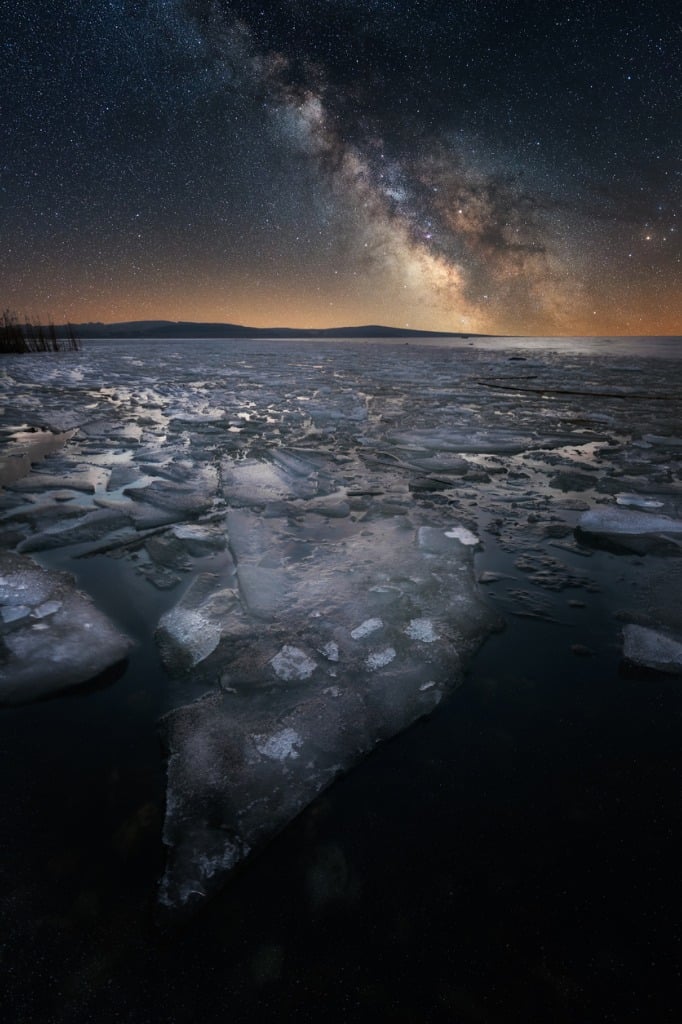
As a beginner astrophotographer, you might find yourself drawn to composing images of the night sky by itself.
And while there's nothing wrong with that, you might also find that if you include foreground interest of some sort, that the photos you create have much more visual appeal.
For example, in the image above, the Milky Way is obviously what makes this photo.
However, by taking a vertical shot and including the frozen lake in the foreground, the photo has much more interest and context, making for a far better photo.
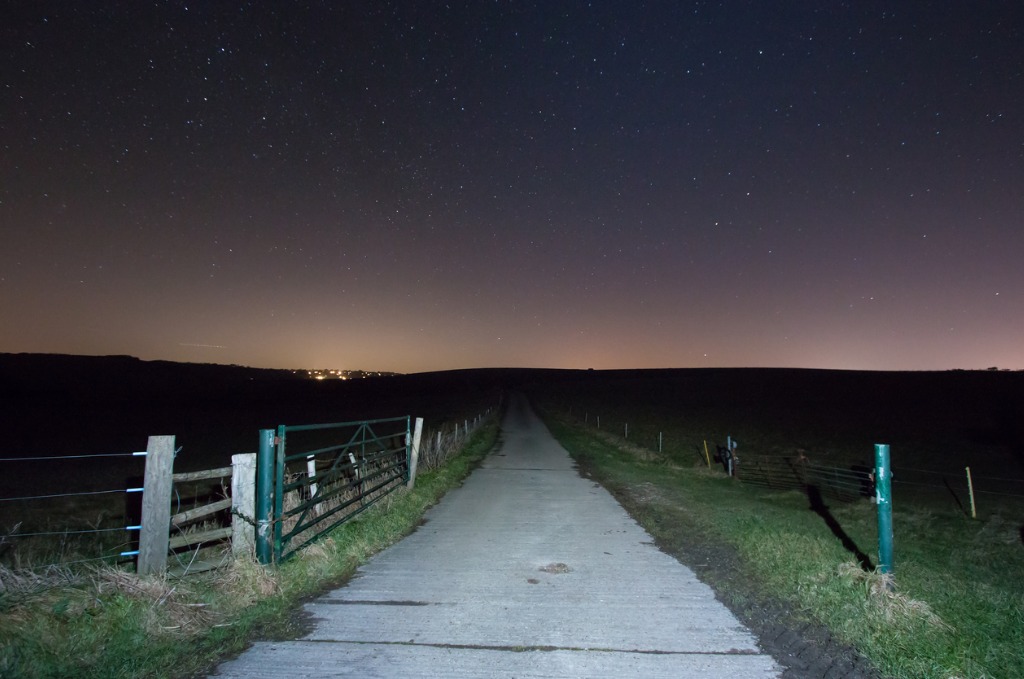
For this tip to work, though, the foreground needs to be interesting...
In the shot above, the foreground is both uninteresting and too bright. The result is a photo that isn't all that appealing.
So, adding foreground interest isn't always a given. Instead, experiment a little, and if it works, great! If not, there's nothing wrong with taking a photo of the sky by itself.
Learn More:
- How to Photograph the Milky Way (in Simple English)
- Take Better Photos of the Stars With These Quick Tips
How Do I Avoid Star Trails?
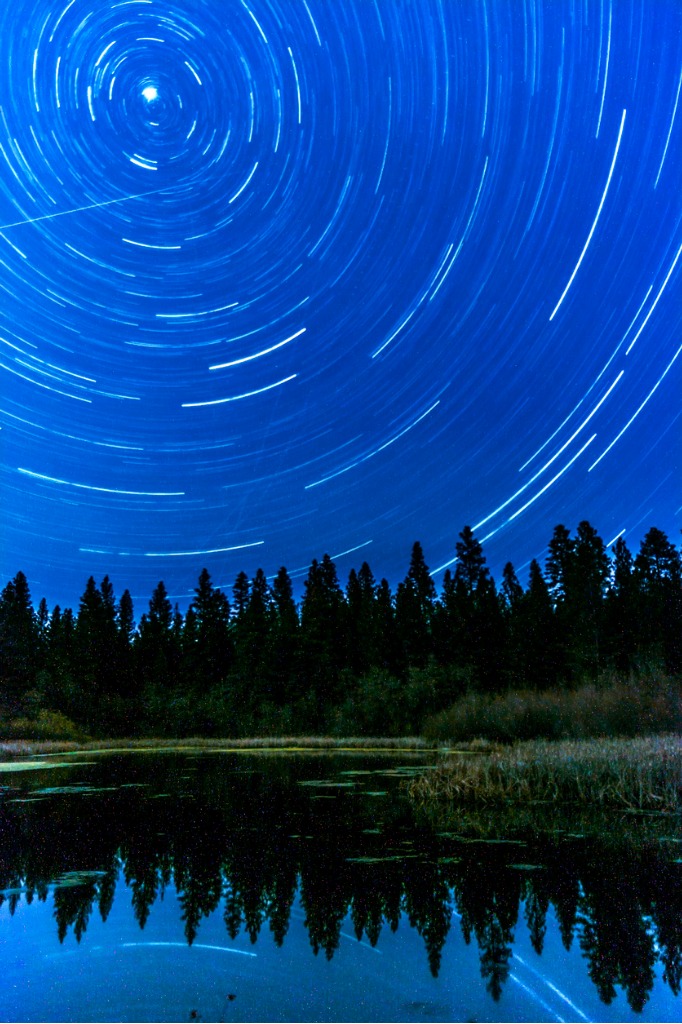
Photos like the one above that show the movement of the stars in the sky are beautiful.
But sometimes you want to capture the scene like you see it - with sharp, pinpoint stars.
There are a variety of ways to go about doing this - some easy and some more complicated.
On the complicated end is to calculate the longest shutter speed you can use and still avoid capturing the movement of the stars.
This is called the 500 Rule, which states that dividing 500 by the focal length of your lens generates the longest shutter speed you can use.
So, if you're shooting with a 50mm lens, you'd have the following formula: 500/50 = 10 seconds.
It's simple math, so it isn't overly complicated, but there is a better way.

If you use a star-tracking mount like the Vixen Polarie shown above, you don't have to worry about math at all.
In fact, all you have to do is mount the Polarie to a standard tripod, and, in turn, mount your camera to the Polarie.
Then, with the included compass on the Polarie, orient it to face north and use the North Star alignment window to point at Polaris.
Once the Polarie is all set, it will track the movement of the stars in the night sky, thereby eliminating star trails.
The result will be a beautiful, star-filled night sky like the one shown above. It's easy-to-use, easy to setup, and anyone can use it to create gorgeous photos!
Learn More:
- Get the Specs and Pricing on the Vixen Polarie Star Tracker Mount
- Quick Tips for Photographing the Full Moon or Supermoon
We Recommend
Get Ready: The First Super Blue Blood Moon Eclipse in 150 Years is Happening Soon
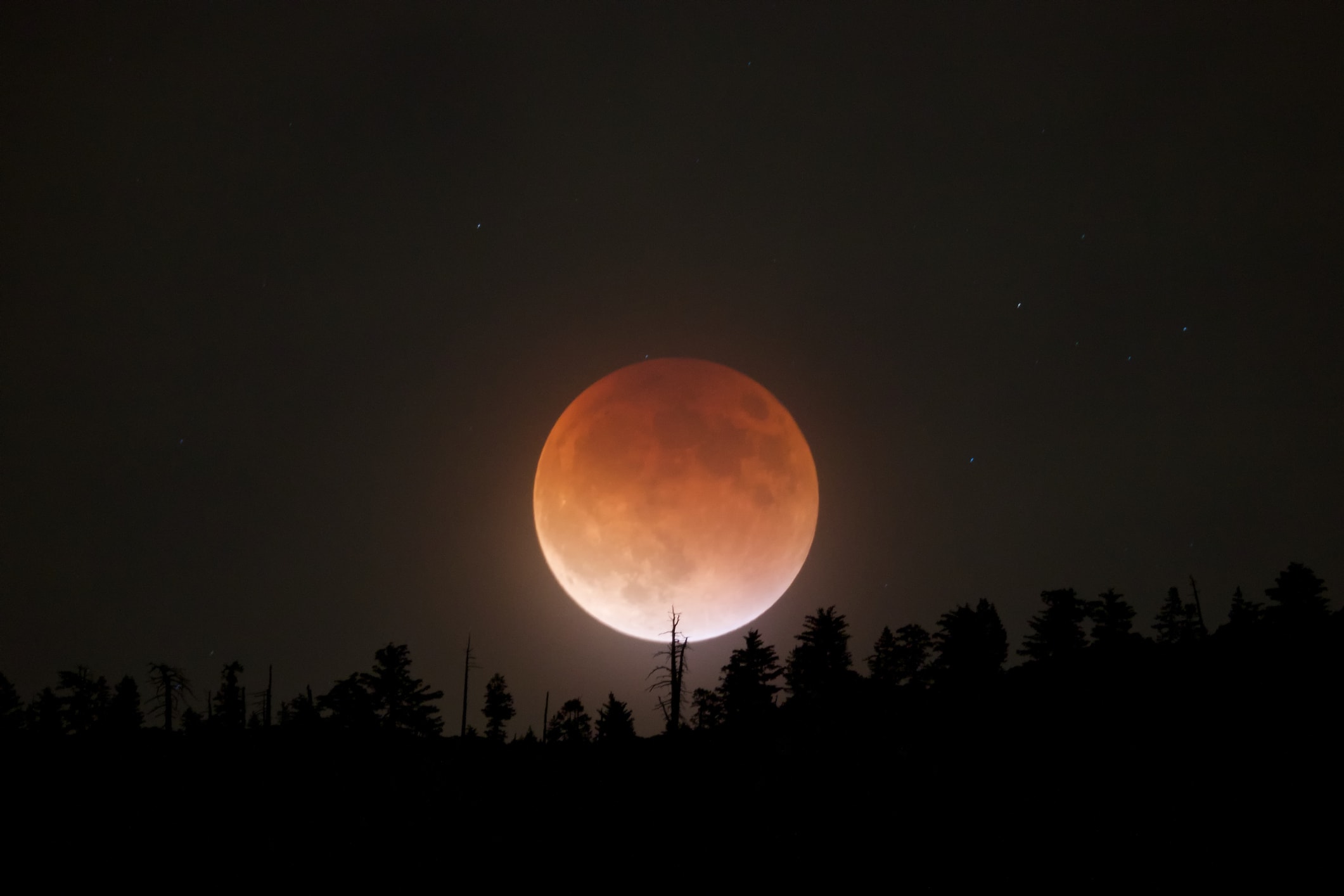
If you've never heard of a Super Blue Blood Moon Eclipse, you're not alone...
That's because for the first time in a century-and-a-half, this rare celestial event will occur on January 31, 2018, delighting stargazers with a supermoon, a blood moon, and a lunar eclipse, all at the same time.
That's a lot to absorb, right?
Here's your quick go-to guide for understanding exactly what a Super Blue Blood Moon Eclipse is.
Editor's Note: Need to get geared up for this month's Super Blue Blood Moon Eclipse? Visit MrStarGuy for all your astrophotography and astronomy gear needs. MrStarGuy has everything you need to observe and photograph the beauty of this rare event, from astro binoculars to telescopes, astrophotography mounts to tripods. Explore their inventory by clicking here.
As the video above from United News International explains, the first component is a blue moon, which occurs when there are two full moons in the same calendar month. The first one this month occurred on New Year's night.
Then, add to that a lunar eclipse, which occurs when the earth moves between the moon and the sun, casting the planet's shadow on the moon's surface.
Unlike their solar eclipse counterparts, lunar eclipses can bee seen anywhere on Earth, so long as it's night. Get more details on lunar eclipses in the video below from NASA:
The final component is a supermoon, which occurs when the moon's perigee (the point at which it's closest to earth) happens at the same time as a full moon. However, during a supermoon, casual observers might not even notice a difference in the moon's size, as it's perceived size is just 14 percent larger than normal, according to NASA.
Separately, none of these events are particularly rare. However, all three happening at the same time is definitely a rare show.
Learn More:
- Quick Tips for Photographing the Full Moon or Supermoon
- How to Compose a Killer Shot of the Night Sky
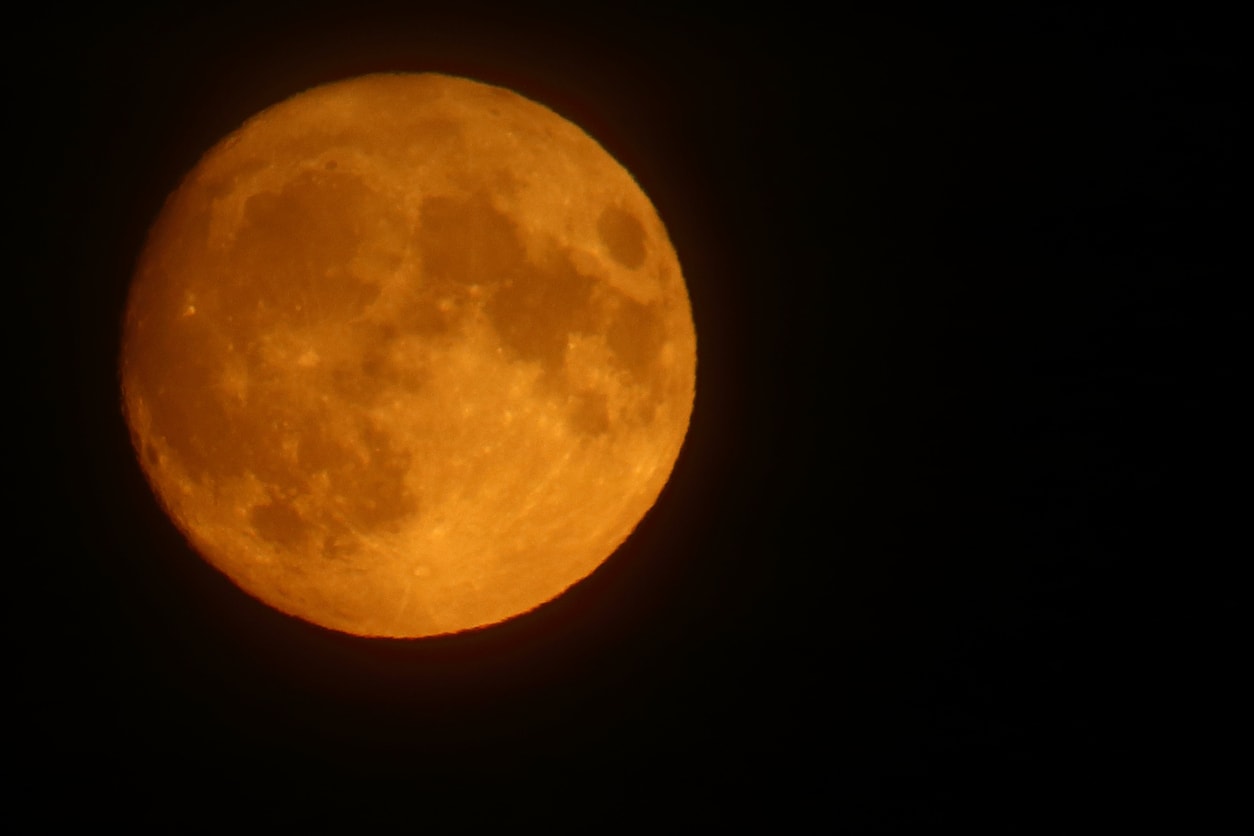
As a result of all this lunar action, the moon will appear less bright than normal, with a reddish hue, thus the name "Blood Moon."
That red color is thanks to the way that the Earth's atmosphere bends light.
And while this beautiful astronomical event can be seen in many parts of the world, some will get a better show than others.
The best locations to see it will be those in the Pacific region, especially Australia, New Zealand, Indonesia, and the central and eastern parts of Asia.
Further west in India, the Middle East, and Europe, there will be less of a show, but skywatchers that wait for the moon rise will still be able to see part of the show.
Editor's Note: If this is your first foray into astrophotography, be sure to check out our Astrophotography section for tips, tricks, and tutorials that will help you get the highest quality shots. Our astrophotography partners at MrStarGuy offer our readers an excellent selection of gear at great prices. Add to that top-notch customer service, and you have a winning combination for learning how to take photos of the night sky with the right gear at the right price.
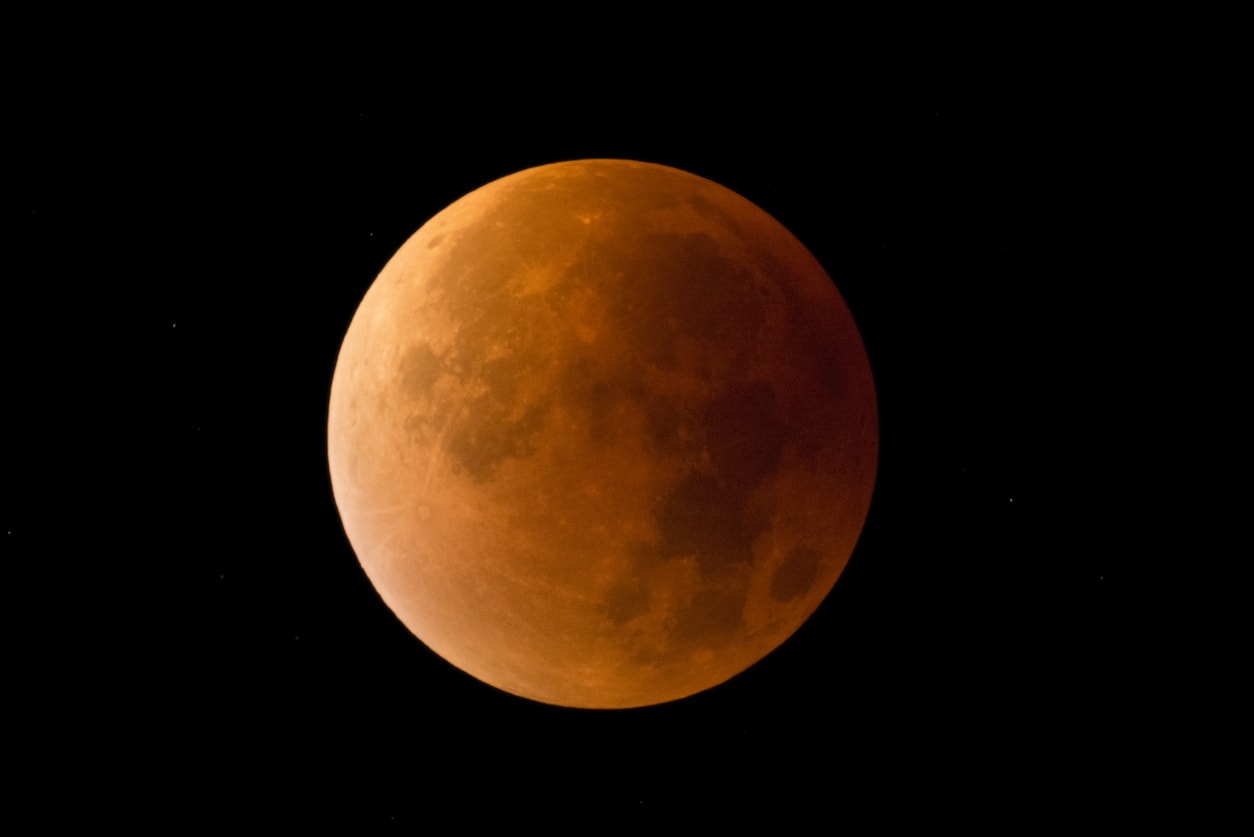
For those of us in the United States, the best viewing areas will be along the West Coast, the Rocky Mountain region, and the Midwest.
You have to be up early, though, as the best time for seeing the Super Blue Blood Moon Eclipse will be in the early morning hours.
In California, for example, the best viewing time is 4:51 am local time, at which point the total phase of the lunar eclipse will begin.
Skywatchers in the Rocky Mountain region will have to get up earlier, and be ready at 3:51 am local time when the eclipse begins.
Unfortunately, Americans living on the East Coast won't have as good a view. But that's okay - the next Super Blue Blood Moon Eclipse is less than 11 years away on December 31, 2028.

Editor's Tip: To get the best results of the Super Blue Blood Moon Eclipse, use a Vixen Polarie Star Tracking Mount to track the eclipse as it occurs. Just set up your camera to bracket the exposure and time lapse, then set the Polarie for a lunar rate. Once you have the Polarie set, it will track the entire eclipse, and all you need to do is check the exposure when it gets close to totality. Get all the details about this incredible astrophotography device right here.
Learn More:
We Recommend
How to Compose a Killer Shot of the Night Sky
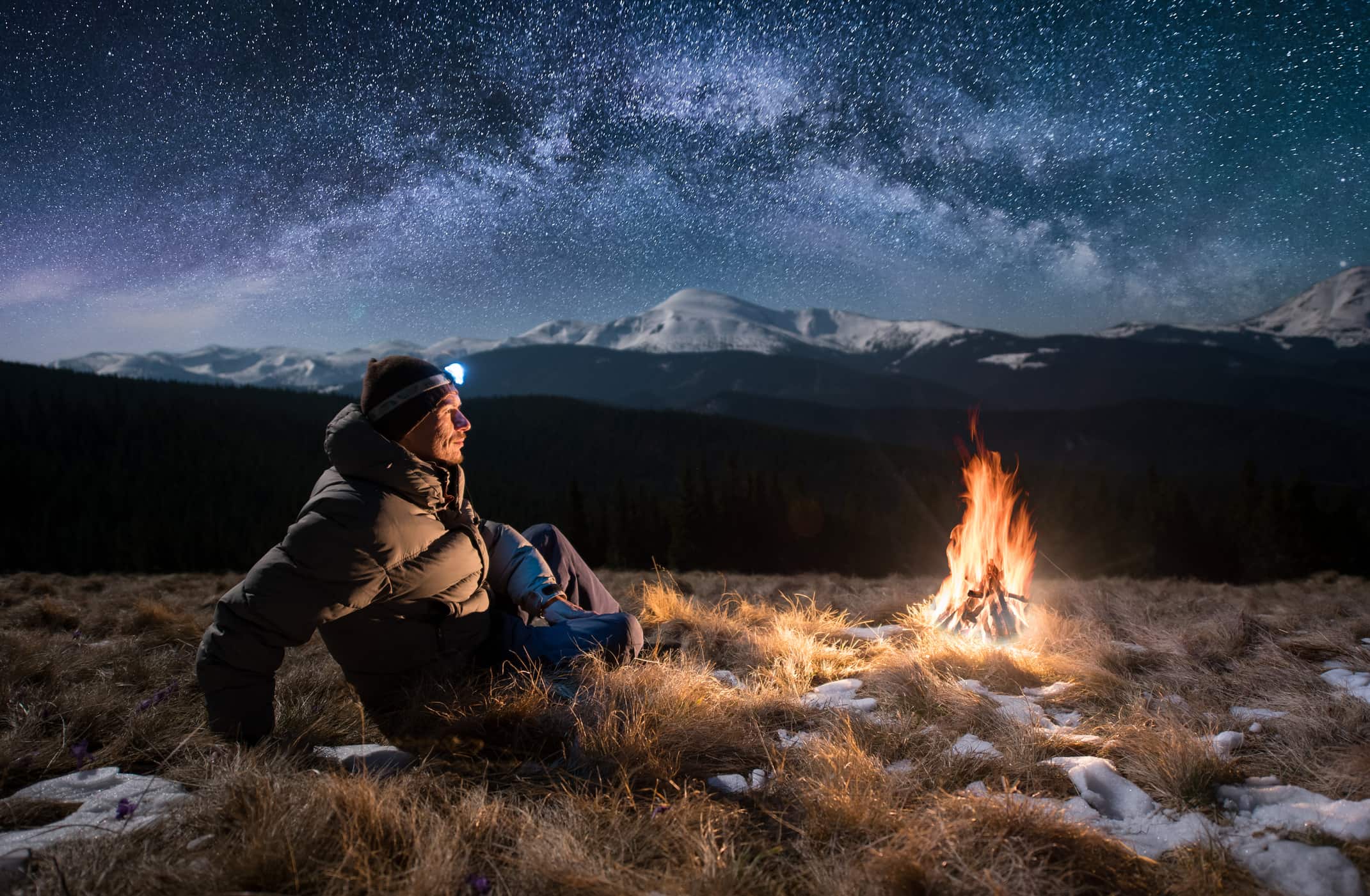
I don't think it's any secret that astrophotography can be a challenge.
I mean, on the one hand, it's a little more technical than traditional photography. But challenging yourself once in awhile is a good thing!
On the other hand, astrophotography can be challenging simply because it's hard not to be so enamored with what you see in the night sky that you forget to double-check things like camera settings, focus, and composition to ensure you get the best possible shot.
In this guideline, I'd like to offer up a few basic composition tips that will help you create better images of the night sky.
Editor's Note: Whether you're new to astrophotography or a seasoned veteran, if you need gear, MrStarGuy is the place to go. From telescopes to binoculars, astrophotography mounts to tripods, MrStarGuy has everything you need to capture the beauty of the night sky in stunning detail. Their competitive prices and commitment to customer service mean you get the gear you need without breaking the bank and with the peace of mind that you'll be supported after the purchase. Check out their complete line of products at MrStarGuy.com.
Use Leading Lines
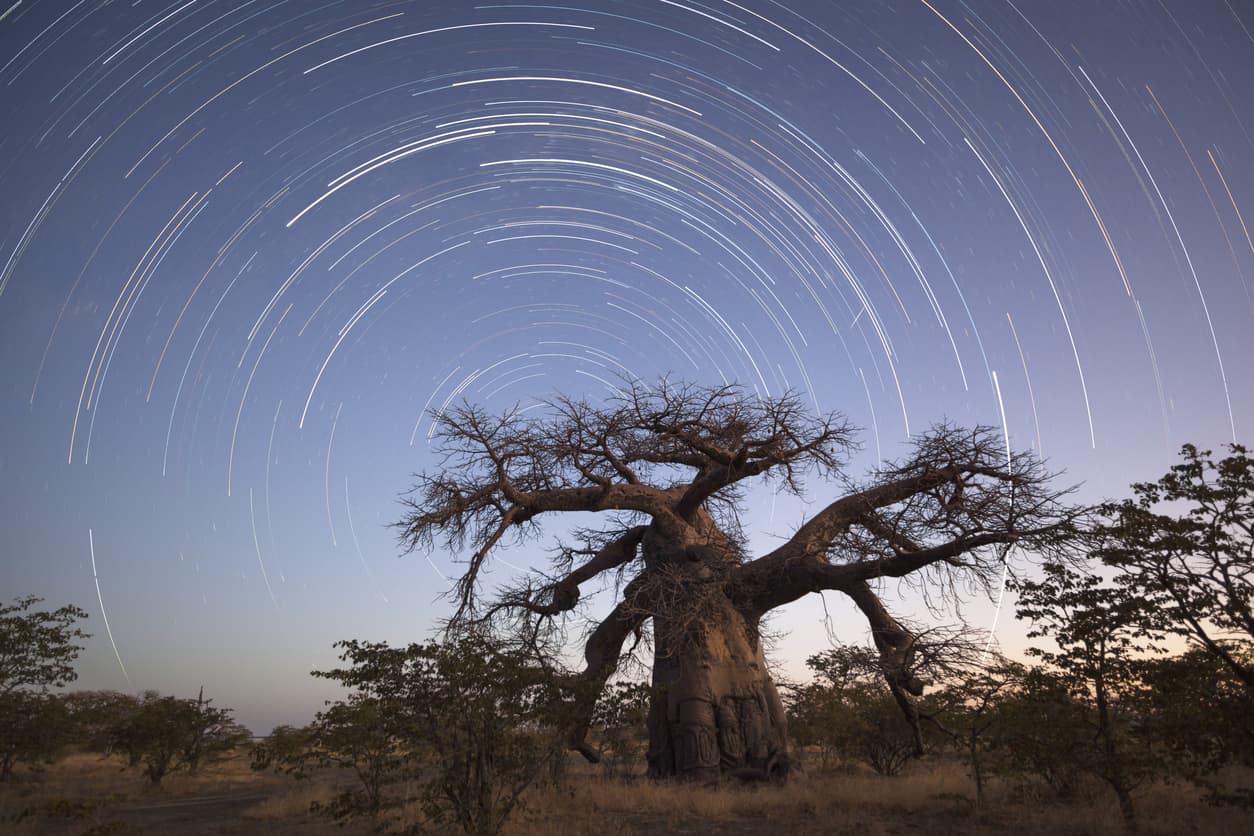
Our eyes naturally follow lines, so it follows that if you include lines in your photos of the night sky, that the viewer's eyes will follow them.
It's a great way to direct the viewer's attention where you want their eyes to go. It also helps you create images that have a greater feeling of depth.
For example, the tree in the image above is an ideal leading line because it immediately grabs your attention and points your eyes toward the sky where they can gaze upon the star trails.
But the use of leading lines needn't be so obvious, either.
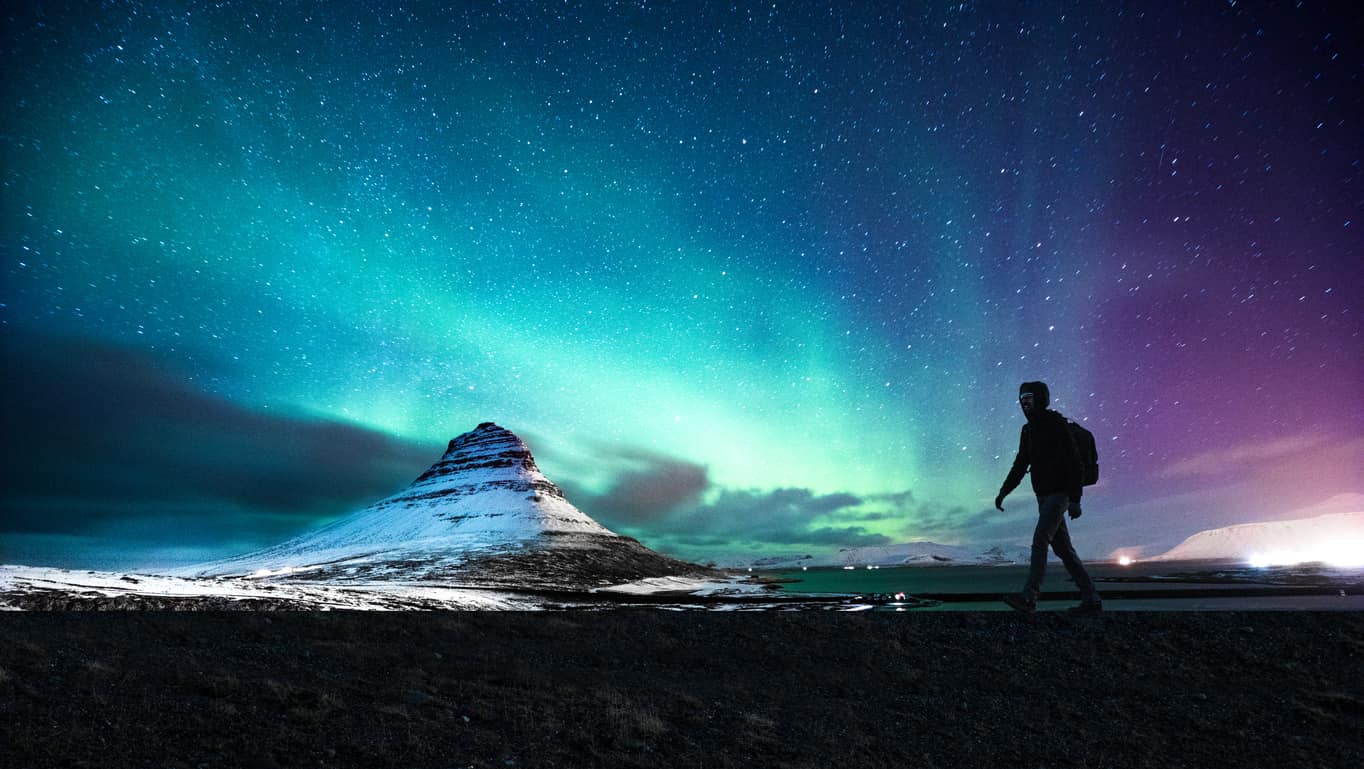
In this image, there's two leading lines that are much more subtle than in the previous photo.
One is the mountain, with its peak pointing toward the colors of the Northern Lights.
The other leading line is the man walking through the frame. Again, the verticality of his silhouette helps drive the eye upward toward the light show in the sky.
Learn More:
- Landscape Photography Composition Rules You Need to Start Using Today
- Quick Tips for Photographing the Full Moon or Supermoon
Remember the Rule of Thirds
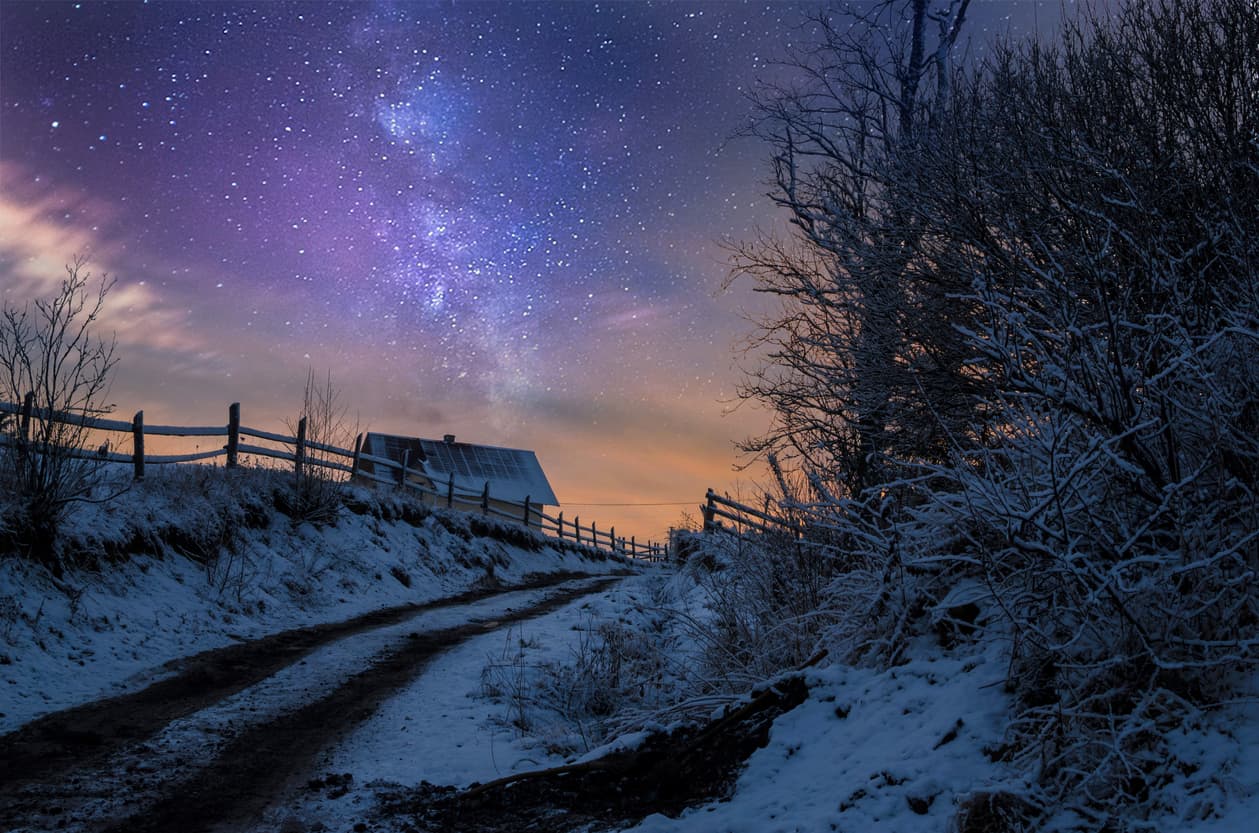
The rule of thirds is probably the most well-known photography rule.
Yet, it's surprising to see so many photos of the night sky with the featured element smack dab in the middle of the frame, precisely where the rule of thirds says not to put the subject.
Now, there's something to be said about bending or breaking photography rules now and again, but more often than not, the rule of thirds will help you create a more dynamic and balanced shot.
In the image above, notice how the Milky Way is shifted to the left of center to more closely align with the rule of thirds. That helps balance out the visual weight of the trees on the right side of the shot.
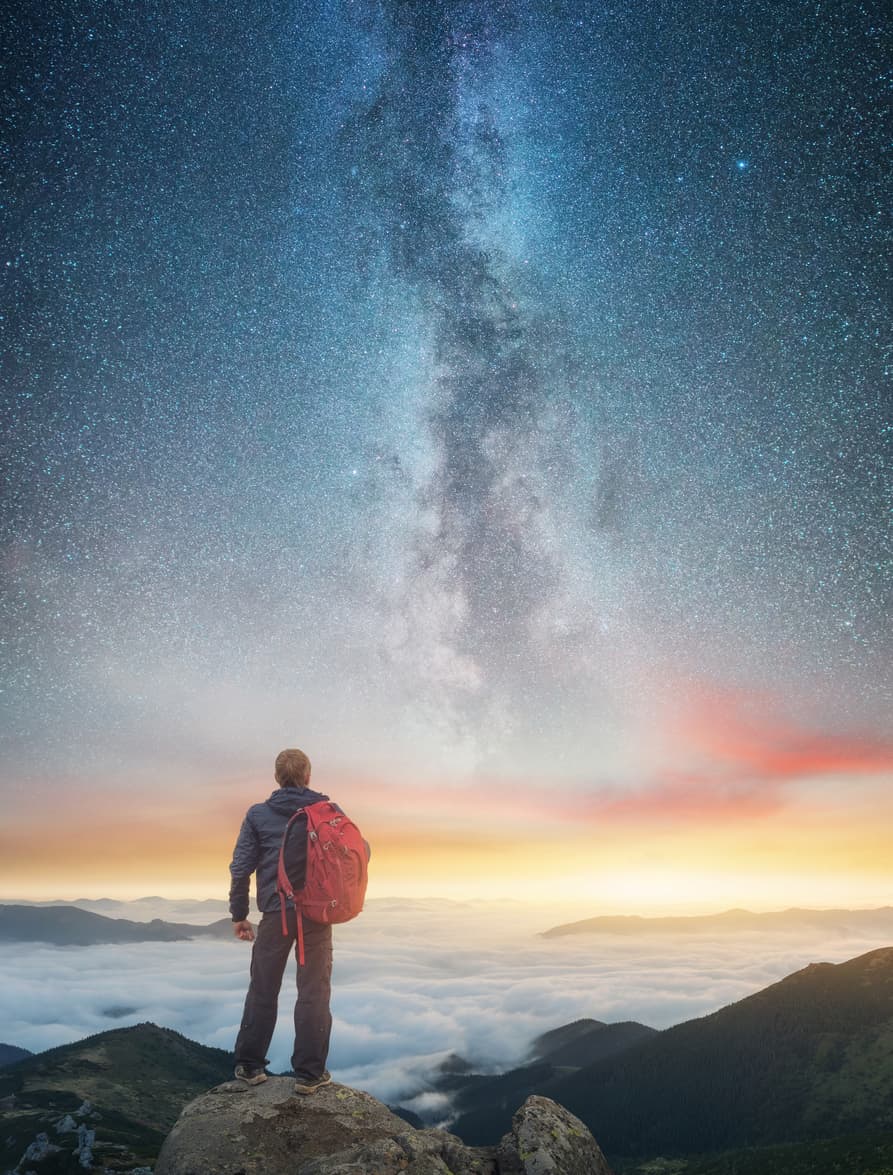
In this image, the Milky Way is positioned in the middle of the frame.
However, because the man commands so much attention in the shot, it was more important to shift him off-center.
The result is an image that feels incredibly balanced and has a lot of depth - you almost feel like you're standing there behind the man gazing at the Milky Way in the distance.
Editor's Tip: One instance in which you might not adhere to the rule of thirds is when you fill the frame with a subject. This is sometimes the case when conducting deep sky astrophotography with a telescope, like a Newtonian Reflector Telescope. In the video above, you can see some examples of deep sky astrophotography that place the subject more in the middle of the frame. Because these objects have such incredible colors and textures, filling the frame with them still results in an eye-catching photo. Click here for more details about telescopes for astrophotography.
Learn More:
Include Foreground Interest
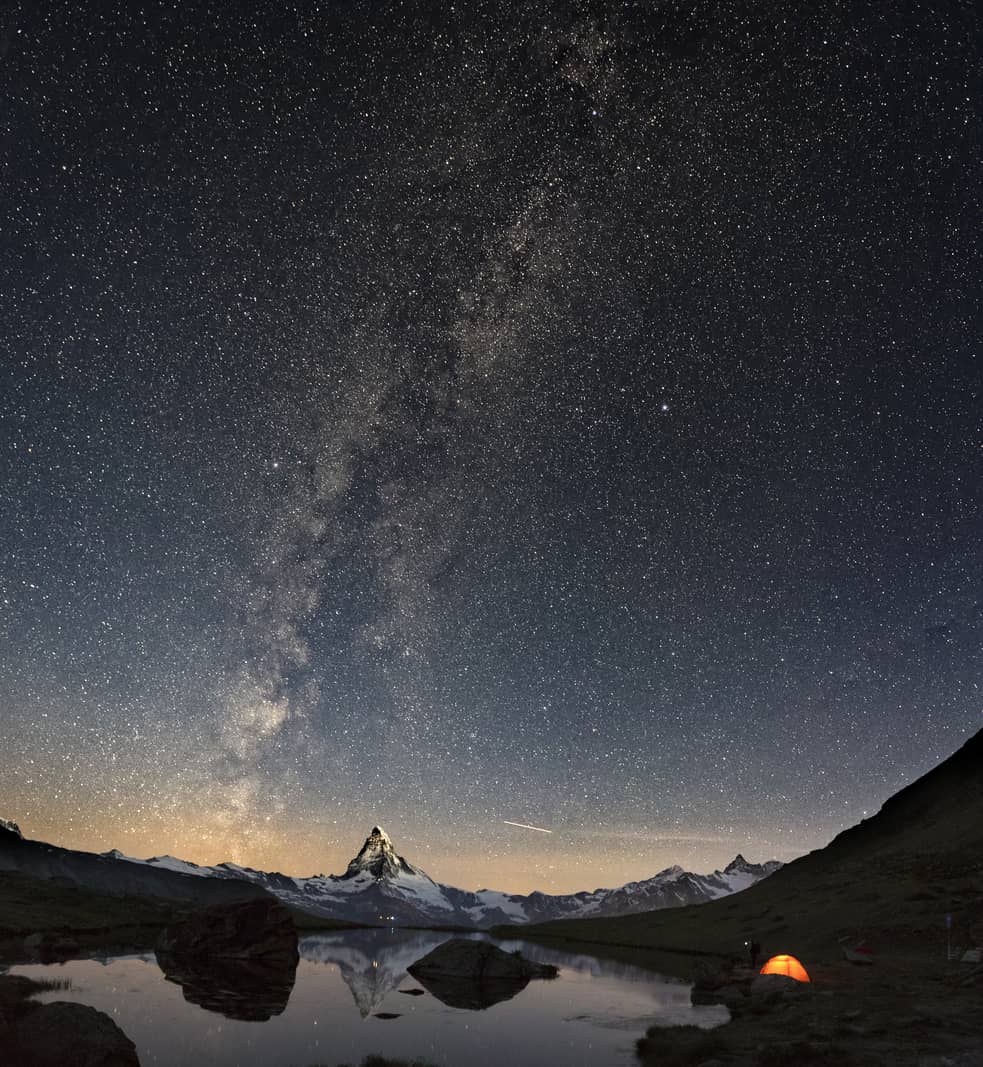
When taking photos of things like the moon or the Milky Way, it's important to include foreground interest in the shot.
Why?
Two reasons...
First, including foreground elements helps give the image some context. In the image above, for example, having the illuminated tent in the foreground sets the stage for the vastness of space above it.
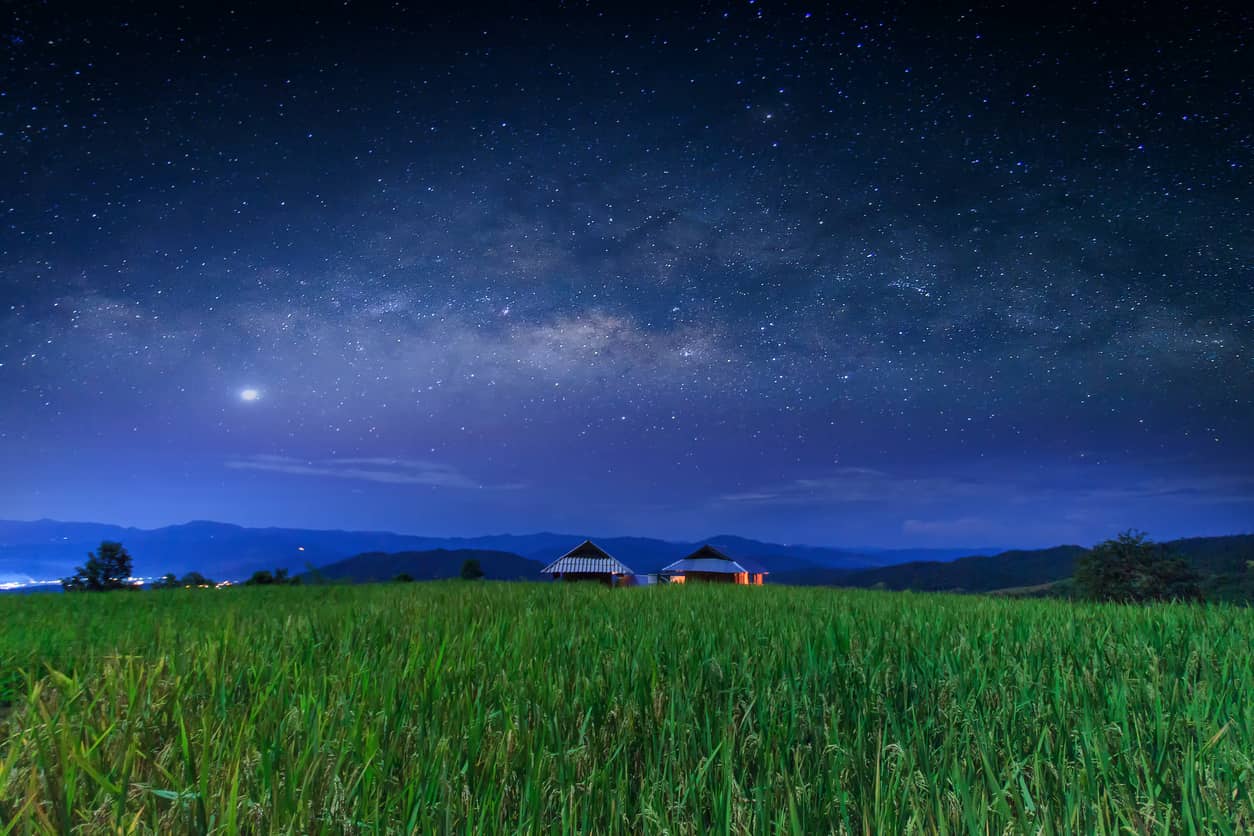
Second, elements like grass, the buildings, and the distant mountains in this shot add more interest to the photo.
This isn't to say that the stars in the sky are a boring subject; it's just that their beauty is enhanced by having other elements in the shot.
In that regard, each of these compositional tips is meant to ensure that you compose the most compelling image.
Great photos aren't great simply because they're of a beautiful subject.
Instead, you need to pay attention to the composition and framing of the shot so that you create a photo that represents that beauty to its fullest.
Editor's Tip: For more tips on improving your astrophotography and getting the right gear for your photos of the night sky, be sure to check out our astrophotography section.
Learn More:
We Recommend
How to Edit Milky Way Photos in Lightroom
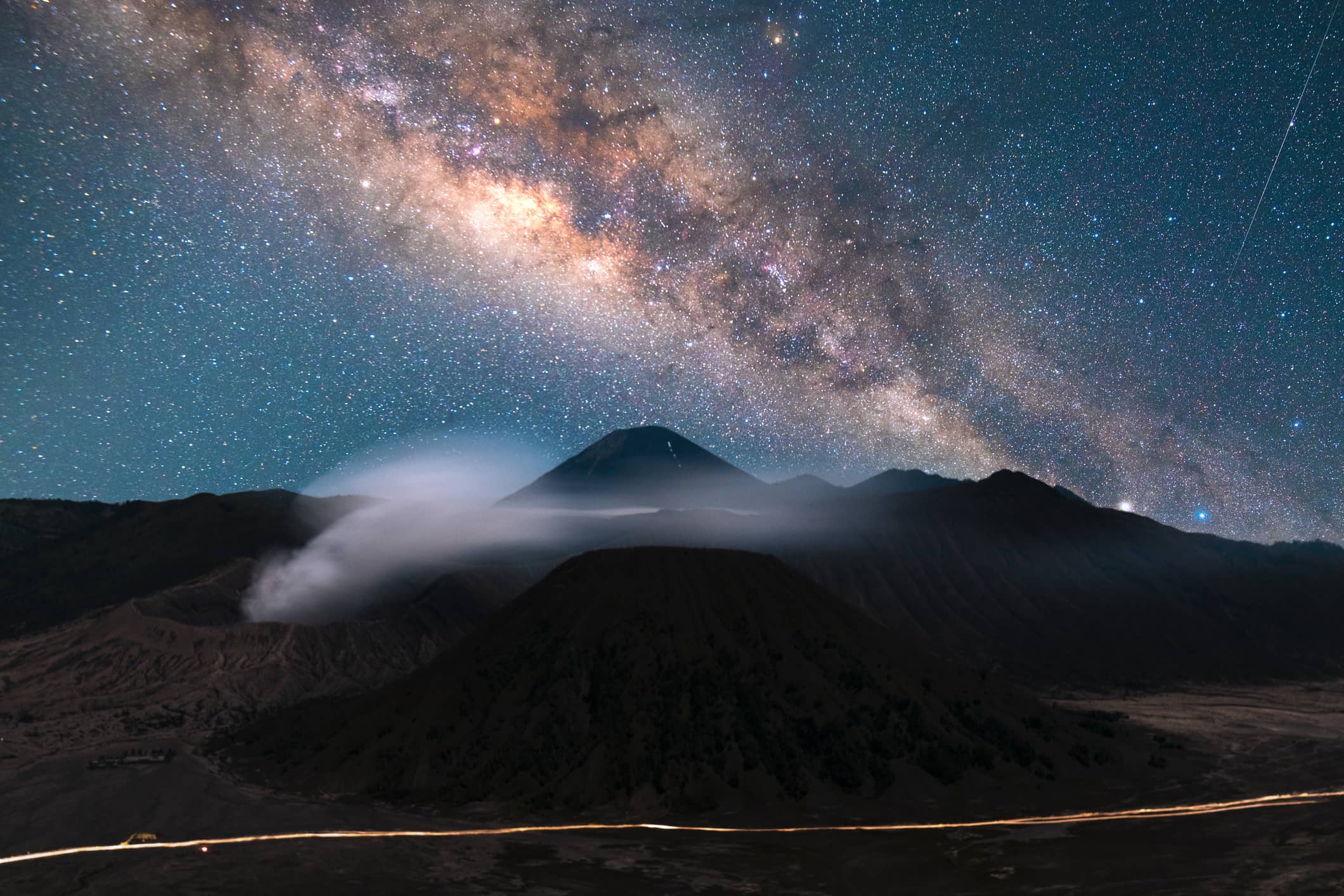
You can spend all kinds of energy planning astrophotography outings, getting the camera settings just right, gearing up with the right equipment to get the best shots, and so forth.
But if you don't know how to edit Milky Way photos and images of other celestial bodies, you're leaving a ton of possibilities on the table for improved photos.
In the video above by 52Things, a basic Lightroom workflow for editing your astrophotography is outlined.
With the quick and simple steps provided here, you can turn your so-so photos of the night sky into incredible works of art.
Follow along in the video above, and for a step-by-step overview, read on below!
Editor's Tip: Great astrophotography begins with having the right gear for the job. Get all the astrophotography gear you need.
Step 1: Begin Editing in the Develop Tab
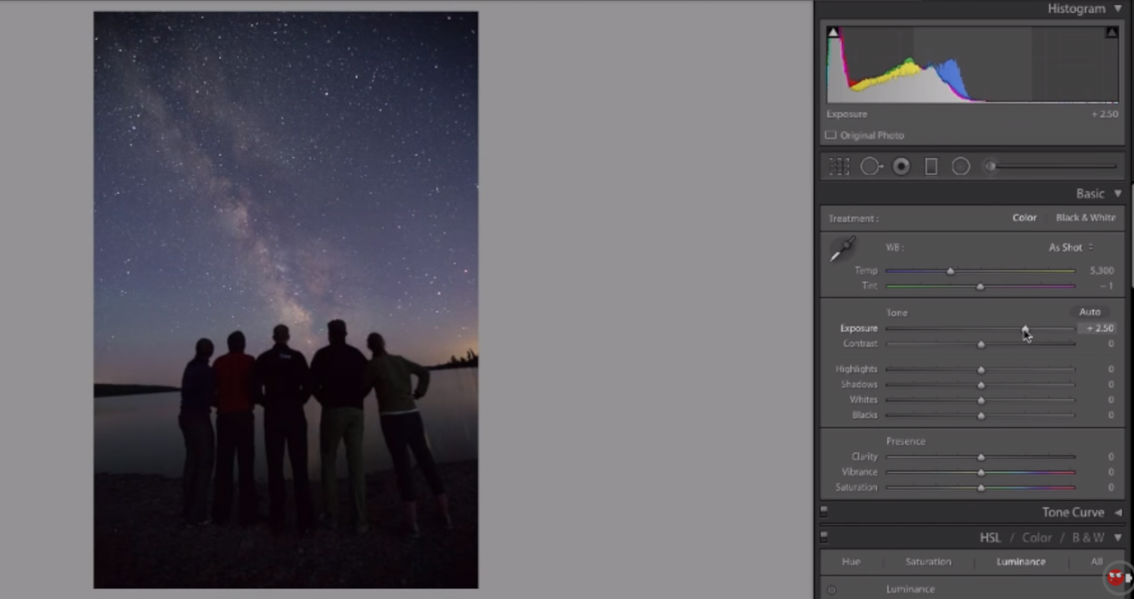 YouTube Screenshot/52 Things
YouTube Screenshot/52 Things
After importing your image into Lightroom, the first task is to work on the image in the Develop Tab.
There are loads of tools in the Develop Tab that will help you build the image into something much more visually pleasing.
In the case of the image above, it's really dark, so increasing the exposure by shifting the exposure slider to the right is the first order of business.
As you can see in the screenshot, this one adjustment has already made the image much better.
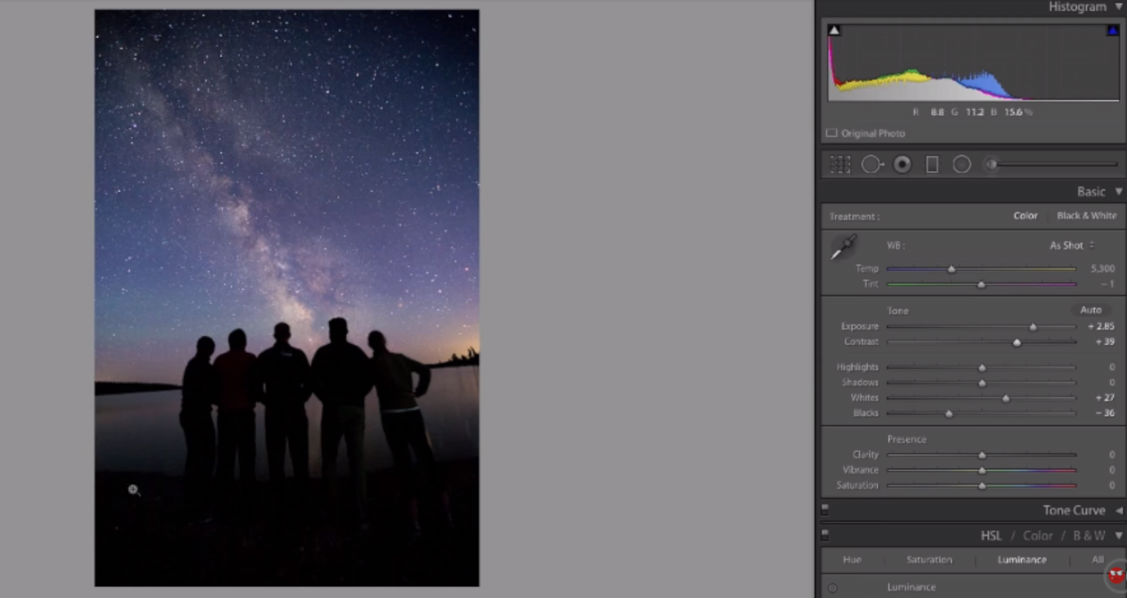 YouTube Screenshot/52 Things
YouTube Screenshot/52 Things
Other tools you can use to make a dull image pop is adjust the contrast, highlights, shadows, whites, and blacks.
In this case, increasing the contrast and whites while decreasing the blacks ever so slightly brings much more contrast to this photo.
Learn More:
Step 2: Apply a Gradient, if Needed
 YouTube Screenshot/52 Things
YouTube Screenshot/52 Things
Unless you paint the foreground with light, you'll often find that after the first round of astrophotography post processing that the foreground is quite dark.
The easiest and most effective way to brighten foreground subjects in Lightroom is to apply a gradient.
At the top of the Develop Tab is the Gradient Tool. Just click it, then click on the image and drag to apply the gradient, as shown in the screenshot above.
But because it's a night photo, you need to make a few adjustments to keep the noise low.
That means reducing sharpness, noise, and clarity to prevent the noise in the image from getting out of control.
Step 3: Crop the Photo
 YouTube Screenshot/52 Things
YouTube Screenshot/52 Things
Though it's nice to get the composition and framing perfect in-camera, it doesn't always happen.
Besides, when you have a chance to look at your photos on a larger screen, you might see a better composition that you want to create by cropping.
Cropping in Lightroom is dead simple - just a matter of dragging the crop box over the image, fine-tuning the size and shape of the crop, and pressing enter.
In the example above, you can see how the crop has brought the people in the photo to the vertical midline and their heads more or less align with the bottom rule of thirds grid.
The result is a much more balanced photo that's starting to take shape as a much more impressive image.
Learn More:
- How to Compose a Killer Shot of the Night Sky
- Take Better Photos at Night With These Simple Astrophotography Tips
Step 4: Tone the Highlights and Shadows
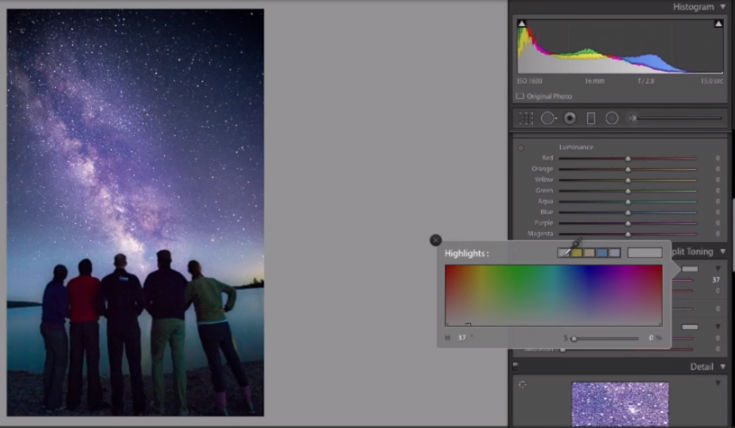 YouTube Screenshot/52 Things
YouTube Screenshot/52 Things
You can add a little color and depth to your astrophotography by adding tones to the highlights and shadows.
This is done in the Develop Tab in the Split Toning Panel.
Just select colors using the color picker (as shown above) and Lightroom will apply those colors to the shadows and highlights, respectively.
The effect should be more subtle than anything - incorporating too many bright, saturated colors can make the image look overly processed.

Editor's Tip: To get clear, sharp stars like those seen in these example images, use a star tracking mount like the Vixen Polarie. Not only is the Polarie easy to use, but it's compatible with a wide range of cameras, from mobile phones to full frame DSLRs. Just orient the Polarie to the north, and once set, the Polarie will keep pace with the movement of the stars to eliminate star trails.
Final Thoughts
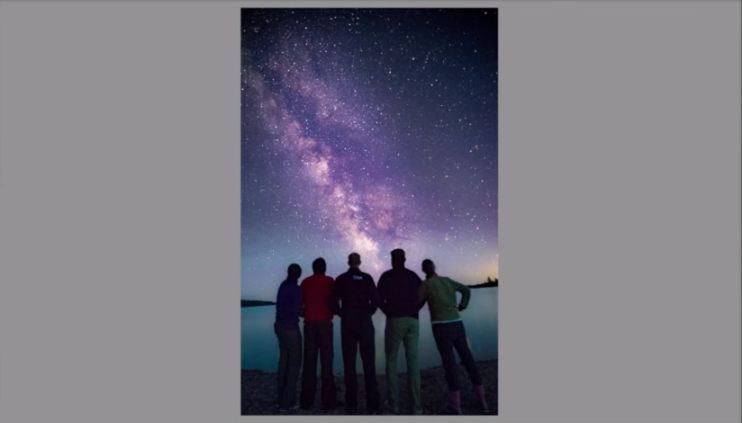 YouTube Screenshot/52 Things
YouTube Screenshot/52 Things
As you can see in the final image above, with just a few key steps, this photo has been transformed from something that looked like a throwaway to something that's quite eye-catching.
Granted, there are plenty of other manipulations that one can make in Lightroom, but the point here is to outline the basic steps you can take to improve your astrophotography editing workflow.
Follow these guidelines the next time you're editing in Lightroom, and you will have all the tools you need to create jaw-dropping photos of the night sky!
Learn More:
We Recommend
How to Photograph the Milky Way (In Simple English)
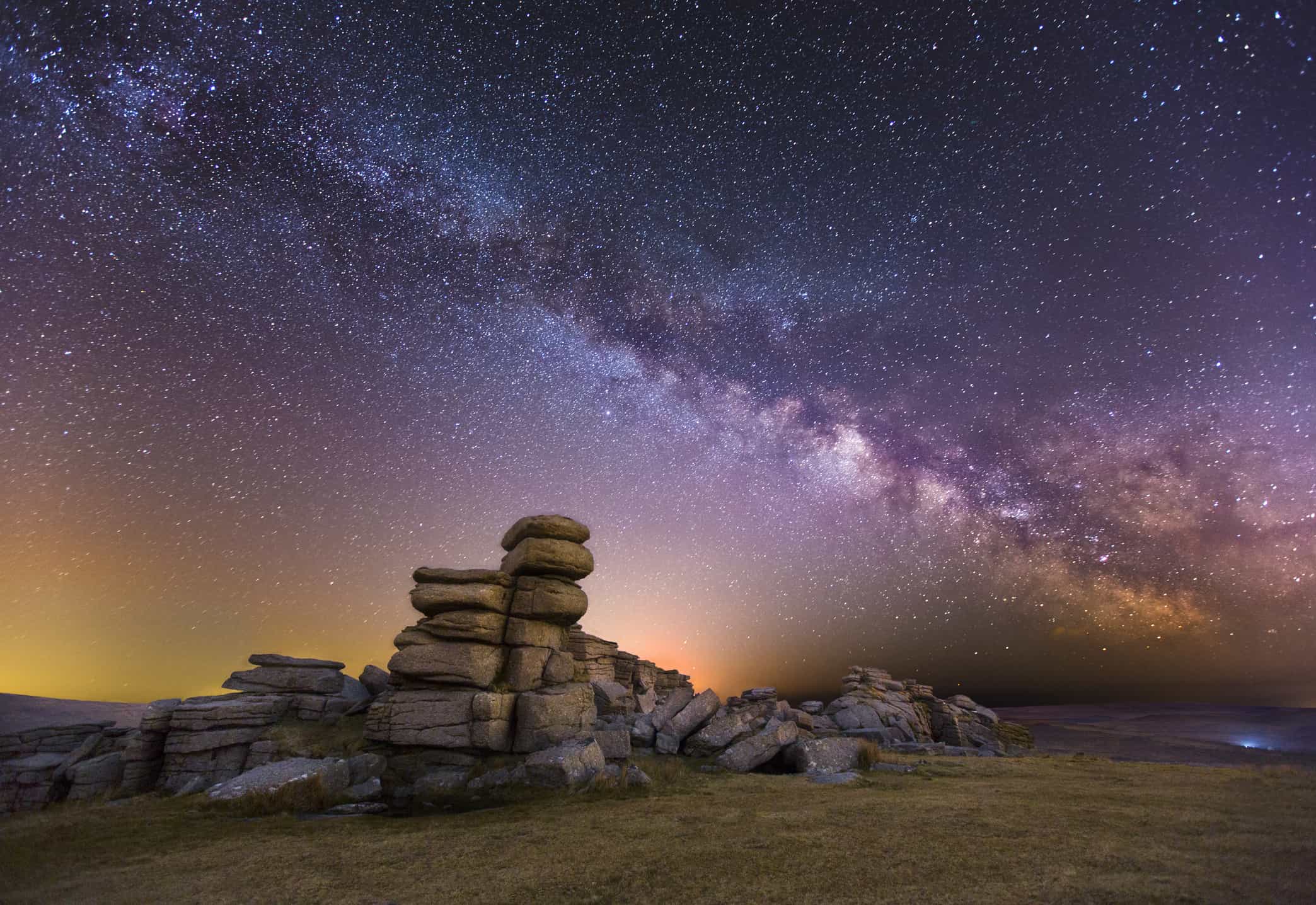
When most people see images like the one above, they likely think "gee, that looks hard to do."
And though it takes a good amount of planning and preparation, the right compositional choices, and the right gear, once you get the basic steps down, you might just be surprised at your ability to get breathtaking shots of the Milky Way.
In this tutorial, I offer up a step-by-step process for photographing the Milky Way.
Editor's Tip: To capture images of the night sky with ease, we suggest using the Vixen Polarie Star Tracker. This compact mount attaches to a standard tripod and can accept cameras that weigh up to seven pounds. You can orient the Polarie to face north using the included compass or by using a North Star Alignment window. You can use a polar scope for alignment as well. Once set, the Polarie tracks the motion of the stars which eliminates star trails. The result? Tack-sharp images of the night sky! Learn more about the Vixen Polarie Star Tracker at MrStarGuy.com.
Step 1: Plan Ahead
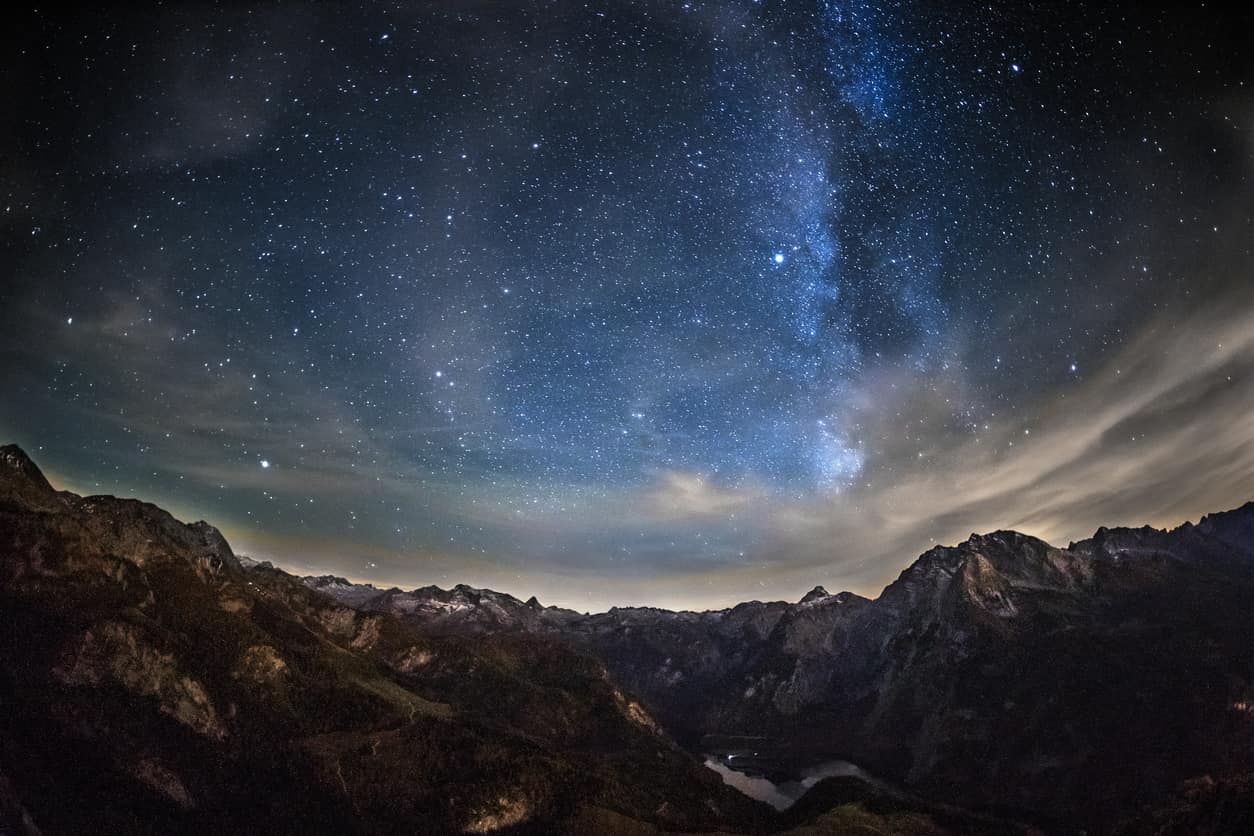
One of the factors to consider when photographing the Milky Way is the current lunar phase.
To get the clearest shots, you'll want minimal light pollution, so try to avoid shooting during a full moon.
Likewise, vantage points that are away from city light pollution will afford you the best chance of getting the clearest shots.
The Photographer's Ephemeris is a handy app for keeping tabs on the lunar cycle, and Dark Site Finder will help you find a nice, dark spot to set up your gear for your Milky Way photos.
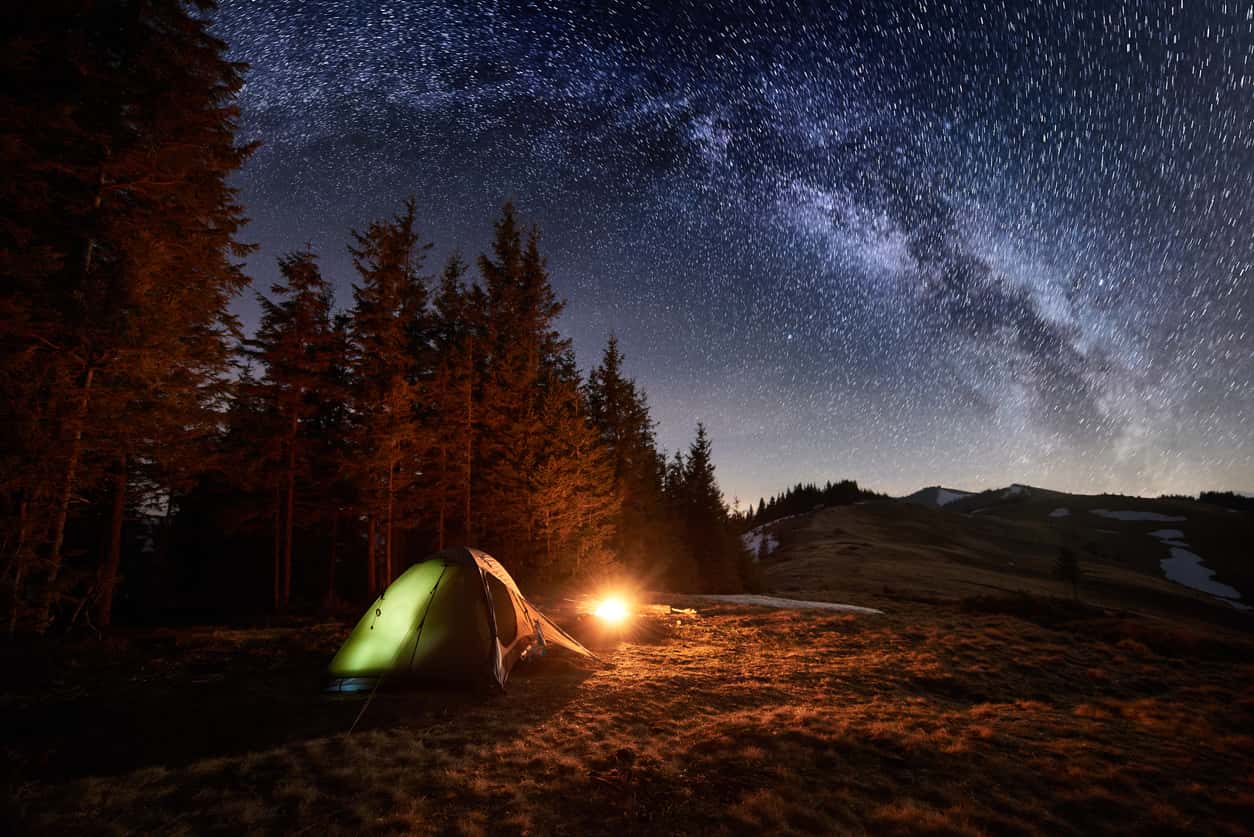
Now, this isn't to say that you absolutely must have completely dark skies to get pleasing shots of the Milky Way.
If there's distant light pollution from a city or town, don't worry about it! In fact, if you can see the Milky Way with your own two eyes, the chances are good that you can get a solid picture with your camera.
You'll also want to check the weather forecast as you plan your Milky Way photo shoot.
Naturally, you'll need clear skies to maximize your view of the Milky Way, but don't be scared off by a few clouds here and there. In fact, some stray clouds can add drama to the shot.
I use the National Weather Service's website to get up-to-the-minute and accurate forecasts for my area.
Learn More:
Step 2: Consider the Composition
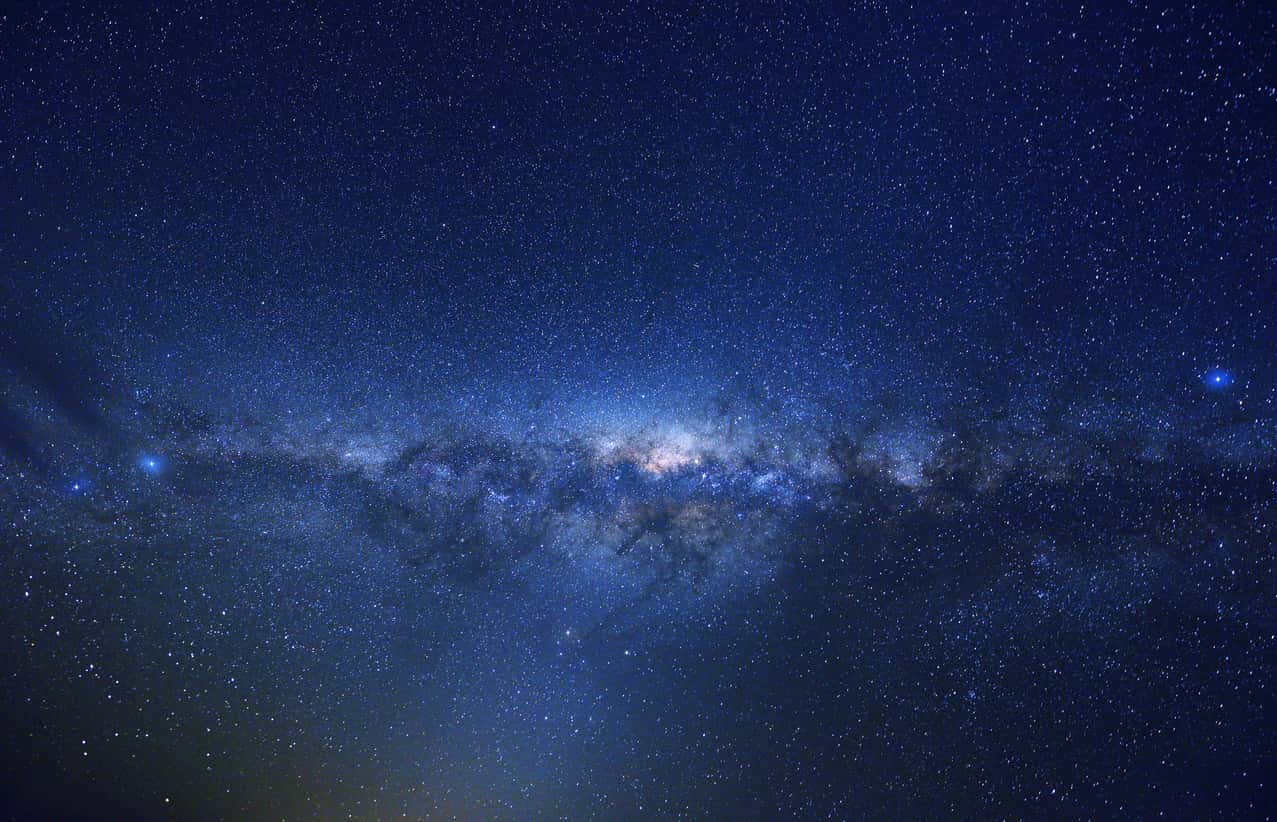
When you plan your Milky Way photo shoot, there's another factor to consider - the composition.
On the one hand, you can frame up a shot of nothing but the Milky Way, giving viewers an eyeful of the galaxy in a tightly framed shot.
As you can see in the image above, this type of Milky Way shot can be truly awe-inspiring.
On the other hand, you might also consider taking some shots in which you include some foreground interest from the landscape.
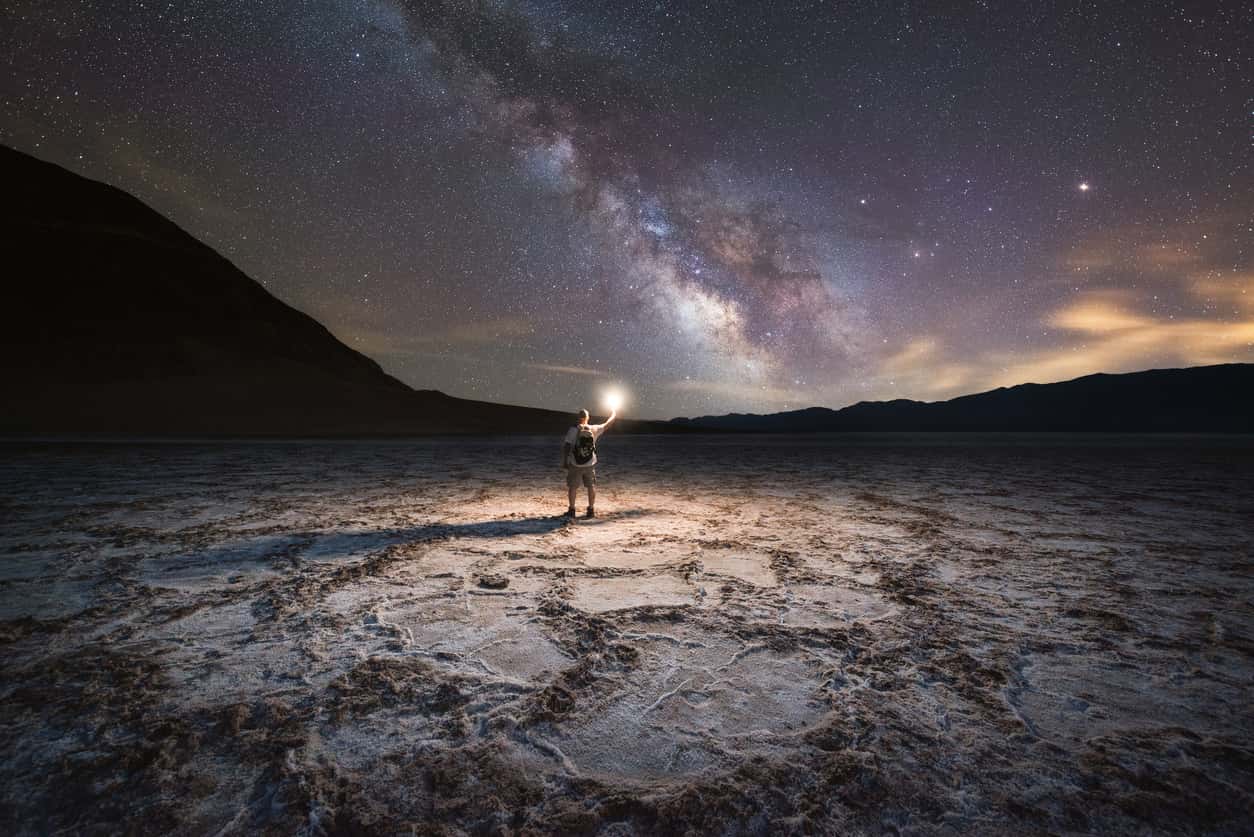
By adding foreground interest, you not only provide context to the shot, but you also provide a little bit of depth.
What's more, you can get a more dramatic shot by including foreground interest, particularly if you add a person to the frame, as seen above.
But don't just frame up the shot with foreground interest for the sake of doing it...
As with any photo, make sure that whatever is in the foreground - be that a person, a mountain peak, an interesting tree, or some other landscape feature - that it has a purpose, that it's balanced well with the Milky Way, and that it doesn't distract from the real focus of the shot, the sky above.
Step 3: Get the Gear
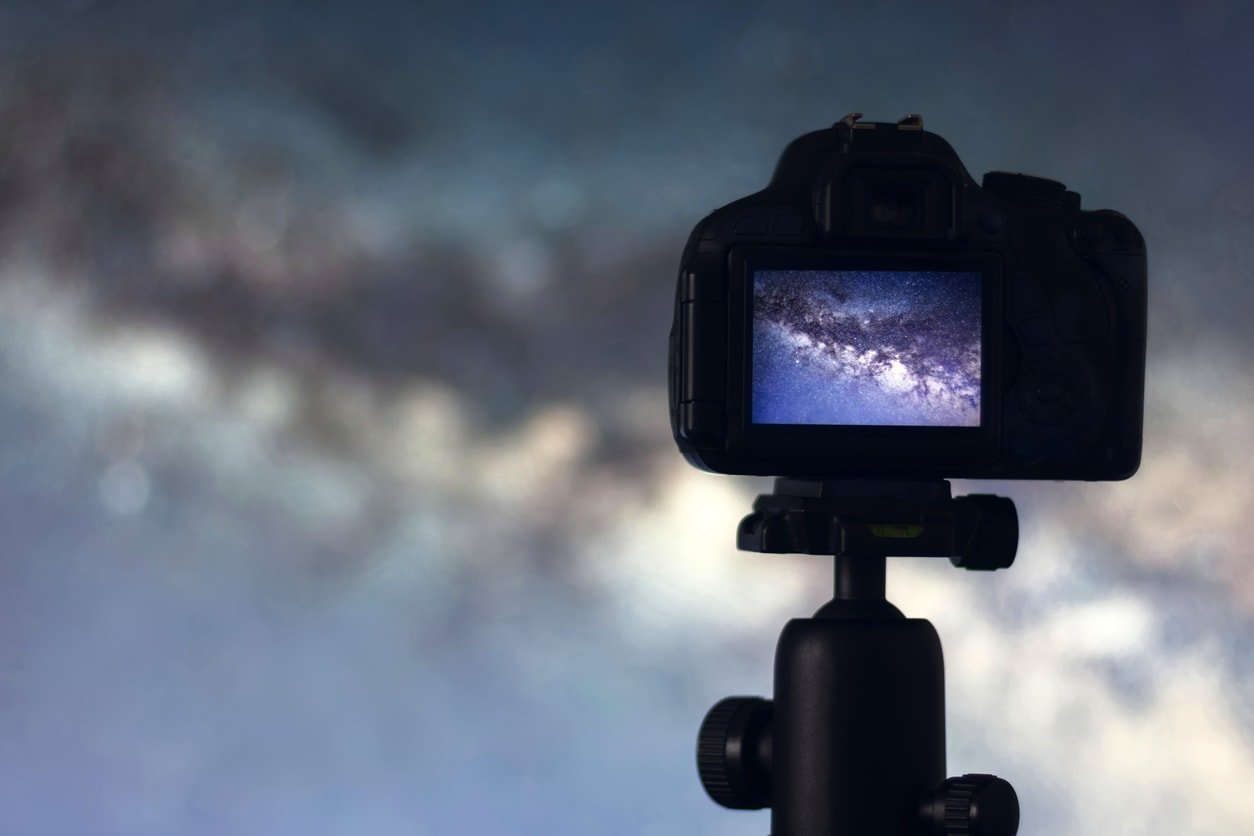
There are a few essentials you'll need for photos of the Milky Way.
First, you'll need a camera. Full frame cameras are most adept at nighttime photography because they have larger sensors and improved low-light shooting capabilities.
Models like the Nikon D850, the Canon 5DS, or the Sony A7S would be good choices.
However, all of those cameras are pricey, and not everyone has the budget to purchase one.
That being said, you can still capture nice images of the Milky Way with an APS-C or micro four-thirds camera.
What's essential, however, is that the camera has live view mode, manual exposure controls, a good ISO range (to at least ISO 3200), and the ability to change lenses.
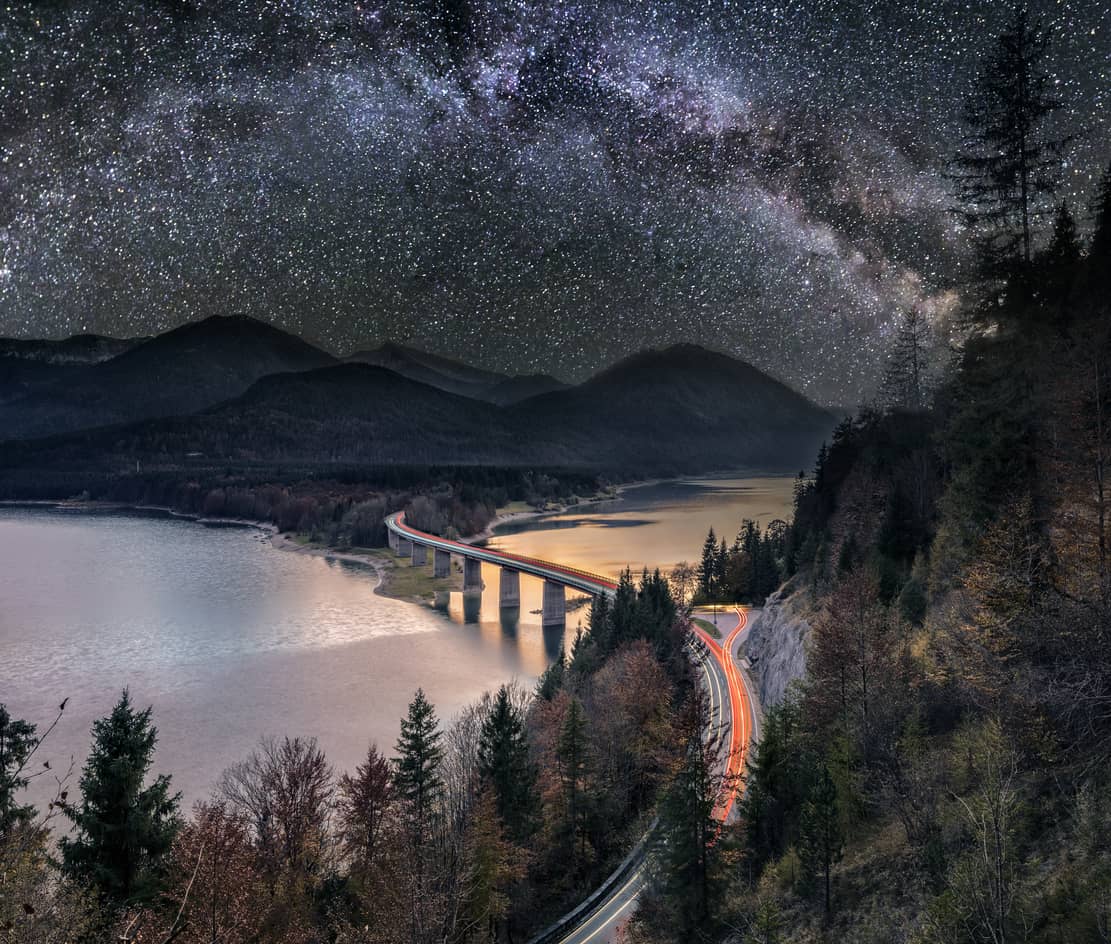
Speaking of lenses, the faster the lens, the better.
In this sense, faster refers to the size of the lens' maximum aperture - the larger the aperture, the more light the lens collects and the faster the shutter speed you can use.
Ideally, if you have the budget, a f/1.2 lens would be the way to go, though f/1.4, f/1.8, f/2, and even f/2.8 will also do the trick. Naturally, the bigger the aperture, the bigger the price tag.
The focal length of the lens is really a matter of personal preference.
If you want wide, sweeping shots of the Milky Way and foreground elements, a wide-angle lens would be best.
If you want more intimate shots like the one above, a normal lens or telephoto lens would be advisable.
Just be sure that whatever lens you use, that it has manual focus controls. You'll have to manually adjust the focus to get the clearest, sharpest photo.

Finally, as I noted in the introduction, having a star tracker mount like the Vixen Polarie shown above comes in handy for tracking the movement of the stars to eliminate star trails.
The Polarie is easy to set up and operates on two AA batteries. It's stepping motors offer incredibly accurate movement as well.
What's more, you can even get the Polaire bundled with a tripod, which is another essential piece of gear.
Having a longer tripod not only enhances the stability of your camera as it takes photos of the Milky Way, but that extra bit of height can afford you improved views as well.
And since your shutter speeds will be quite slow, having your camera on a tripod will only help you get the sharpest images possible.
Check out some examples of astrophotography taken with the help of the Vixen Polarie Star Tracker in the video above by MrStarGuy.
For more details about the Polarie and the Polarie with tripod bundle, check the Learn More links below.
Learn More:
- Get the Specs and Pricing on the Vixen Polarie Star Tracker Mount
- Get the Specs and Pricing on the Vixen Polarie Star Tracker Mount with Tripod
Step 4: Test Your Camera Settings
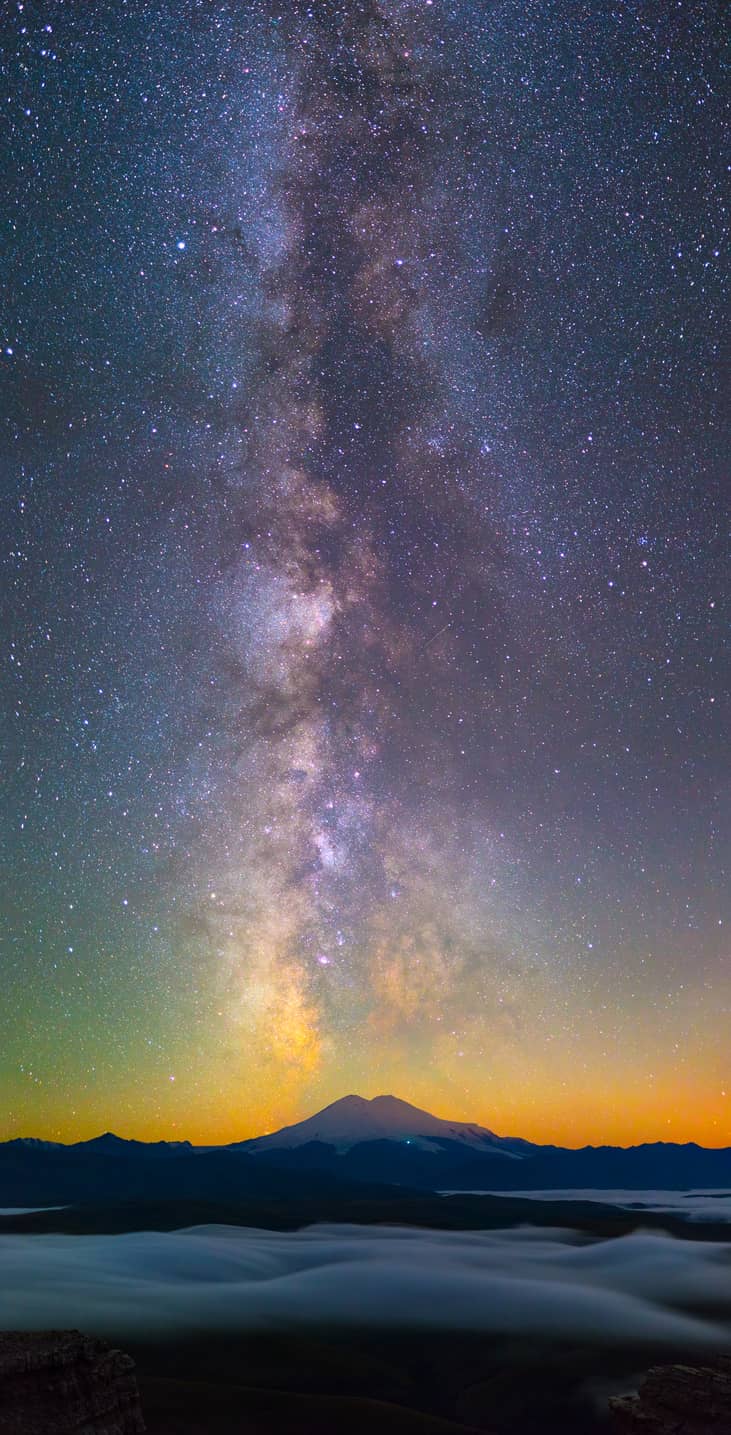
Now that you've gotten geared up and planned your shots of the Milky Way, now comes the time to execute the shot.
To begin, you'll need to turn your camera to Manual Mode (M), that way you have control over the camera's aperture, shutter speed, and ISO (you can also shoot in aperture priority, shutter priority, or program mode, should you desire). Set your aperture to the widest setting possible so you maximize its ability to collect light.
Also be sure your camera is set to record images in RAW format - not JPEG.
Set the focus to manual, crank up the ISO to 3200 or 6400 (at least to begin), and using live view (or the electronic viewfinder, if your camera is so equipped), set your focus on the Milky Way.
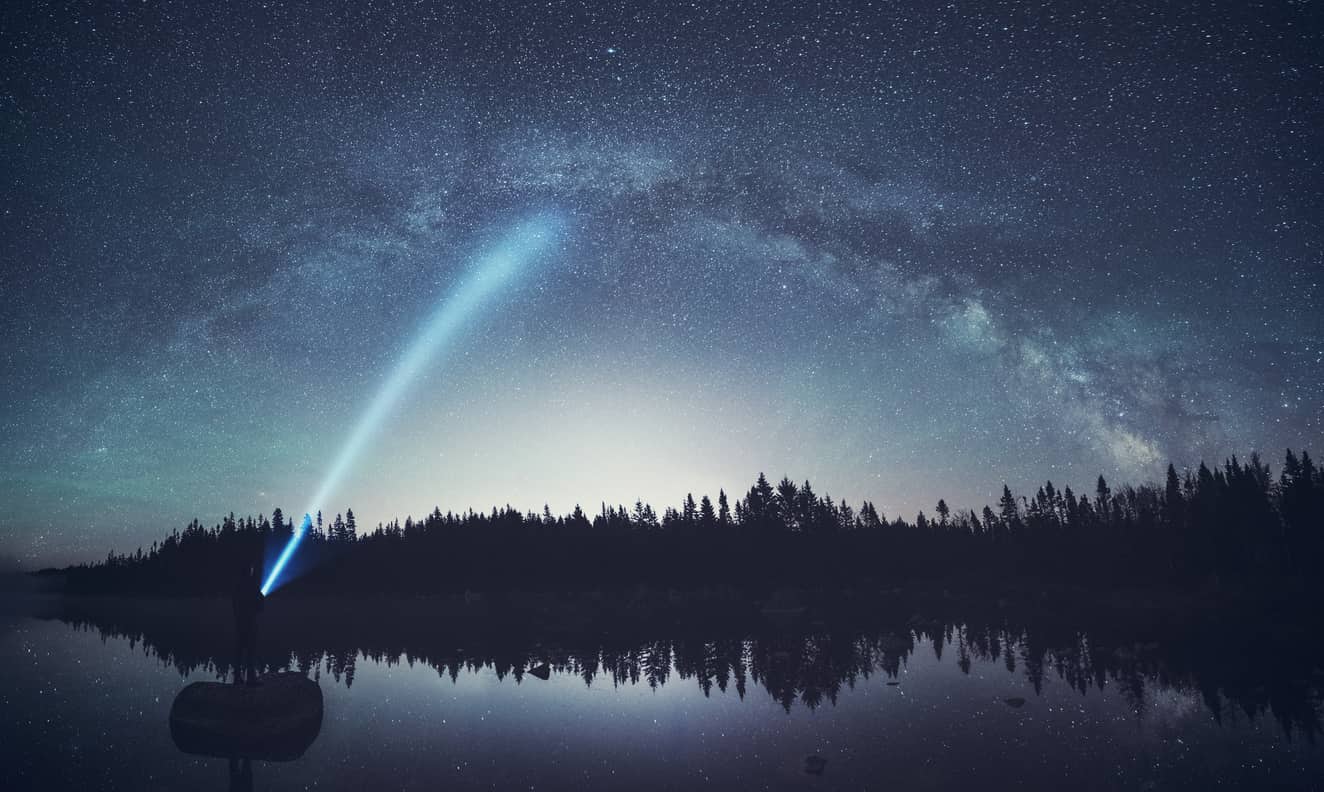
When setting your focus, choose a bright star in the Milky Way to serve as your focal point.
Using the zoom function on your LCD or viewfinder, magnify the image so you can see the star as large as possible. At that point, turn the focus ring on your lens until the star is tack-sharp.
Now that you've got the image focused, recompose the shot to include foreground elements as described earlier, if so desired.
Set your shutter speed to about 10 seconds and take a test shot. At this point, you're just trying to nail the composition, so don't worry too much about the exposure of the image.
Step 5: Finalize the Camera Settings and Take the Shot

Once the composition of the shot is to your liking, revisit your ISO setting and lower it to about 1600. The goal here is to use the lowest ISO possible so you can minimize the presence of digital noise in the shot.
Then check your shutter speed, perhaps trying a 15-second exposure first.
Check your light meter reading in your camera's viewfinder to see how you're doing with the exposure. If the meter is to the left of 0, you need to brighten the image by slowing the shutter speed or boosting the ISO. Conversely, if the light meter is to the right of 0, the image is too bright and needs a faster shutter speed or a lower ISO.
You'll need to experiment a little to get the ideal exposure. Just be sure you use your camera's LCD to zoom in on each shot to check it more closely for exposure and details. Continue to adjust as needed.
And with that, you have a step-by-step process to follow for taking tantalizing photos of the Milky Way!
Learn More:
We Recommend
How to Photograph the Night Sky
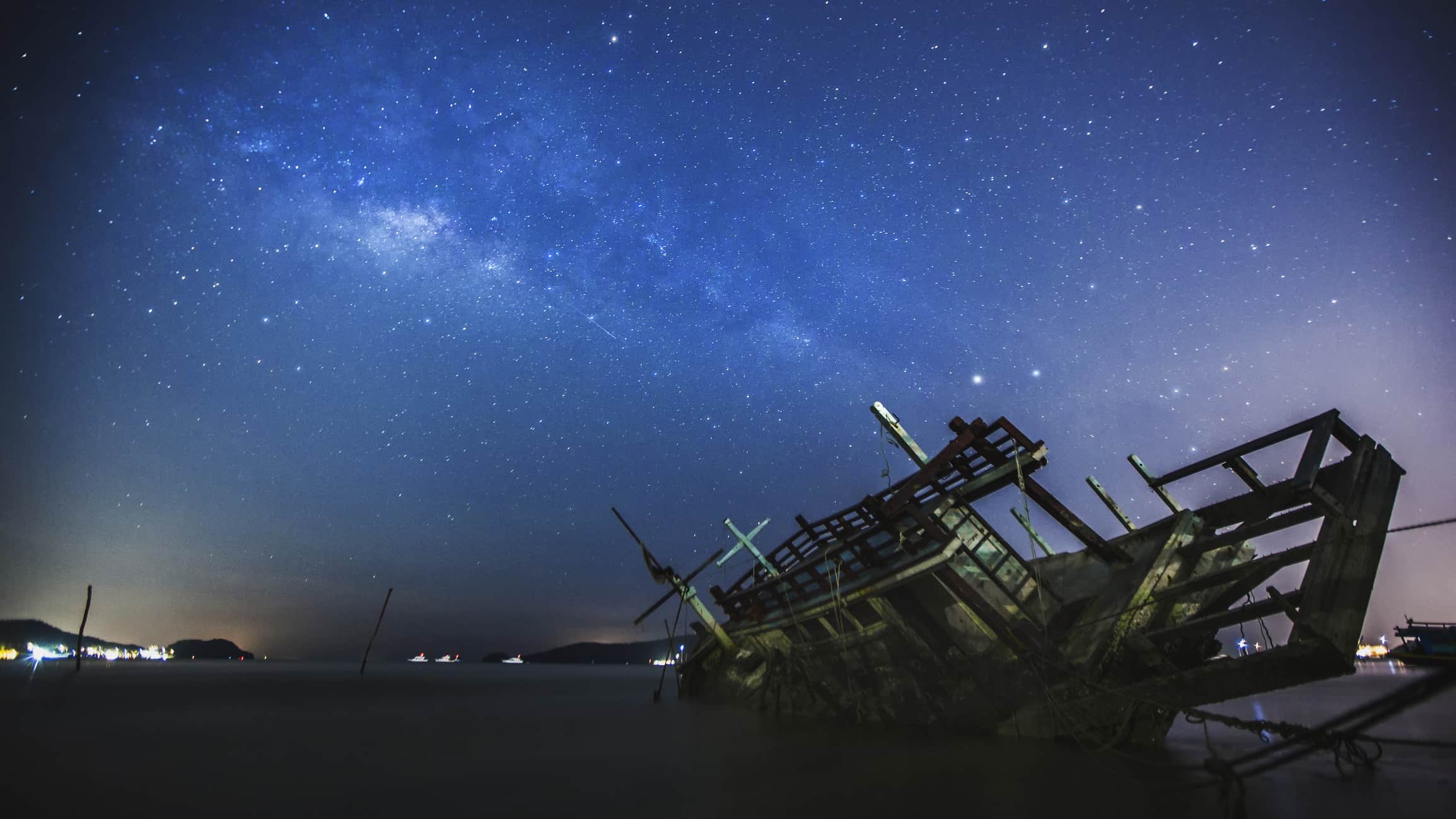
There are plenty of ways to create incredible images of the night sky.
This includes stars that appear as pinpoints, star trails, and timelapse videos, just to name a few.
In this article, we offer an overview of these and other techniques you can use to photograph the night sky.
Editor's Tip: A great way to get started in astrophotography is to use a star tracker mount like the Vixen Polarie, which is compatible with any standard tripod and can accept any digital camera that weighs up to 7 pounds. The Polarie has a compass for orienting the mount to face north, a North Star alignment window for easier alignment, and can track the motion of the stars as they move across the sky to eliminate star trails. Learn more about the Vixen Polarie Star Tracker Mount by visiting their website.
Pinpoint Stars and Star Trails
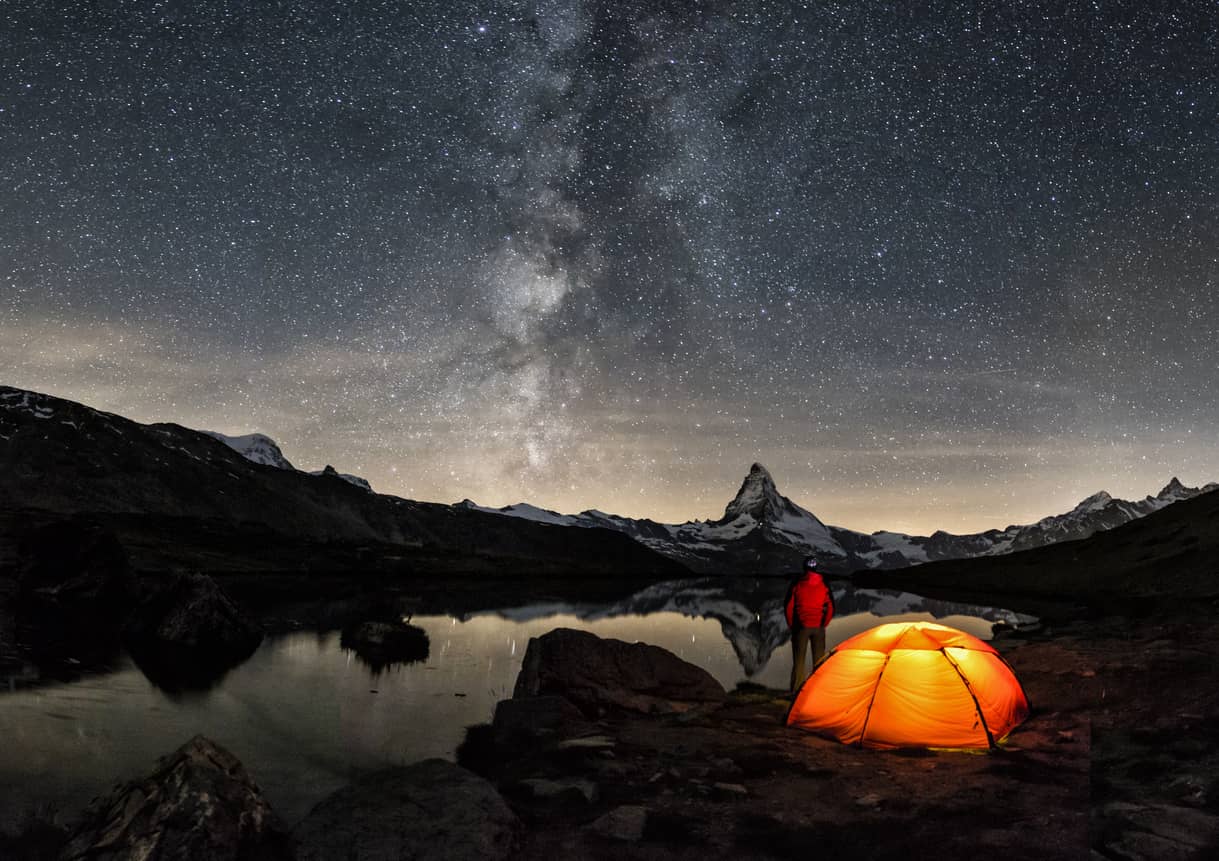
When deciding whether you will represent stars as points of light or as trails, think about what the scene offers in terms of visual interest.
For example, if there is a lot of interest in the foreground of the shot, pinpoint stars might be the way to go. That's because they offer a nice complement to the scene that doesn't overtake what's going on in the foreground.
To get pinpoint stars, you need special gear to track the stars as the earth moves, like the Vixen Polarie Star Tracker Mount I recommended above. Watch a quick tutorial on how mounts like this work in the video below:
As far as camera settings go, start with an f-stop that's nice and wide, like f/1.2 or f/1.4 (or the widest your lens allows) and a shutter speed in the neighborhood of 20 seconds. If needed, increase the ISO to get a better exposure, bearing in mind, though, that the higher the ISO, the more noise that will be evident in the shot.
For a little extra drama, consider lighting the foreground of the shot by light painting with a flashlight or a headlamp.
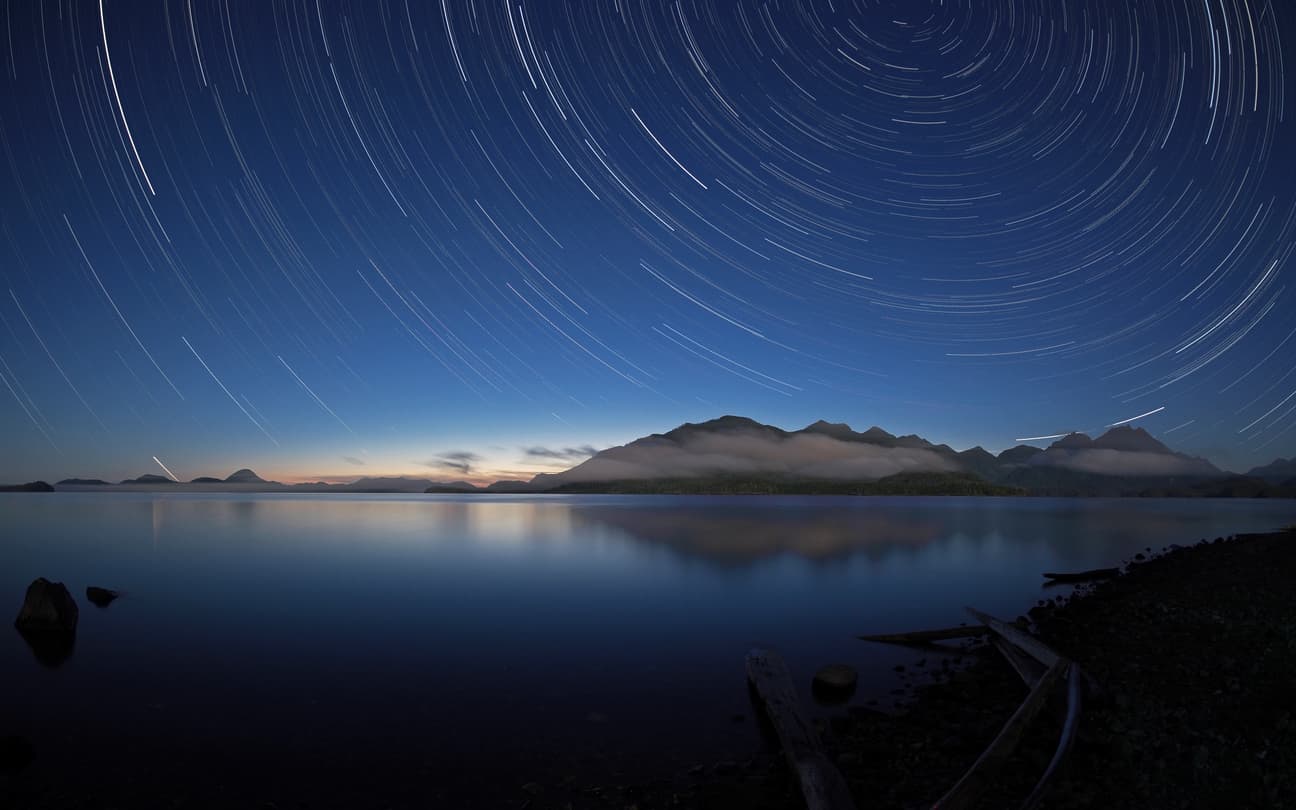
To shoot light trails, you really only need a camera, a lens, a tripod, and a remote shutter release.
The rest is left up to the earth as it rotates on its axis, making the stars and other celestial bodies appear as though they're moving across the sky.
You can capture that movement by using your camera's bulb mode to take a long exposure image.
The length of the exposure will depend on several factors, perhaps most important of which is how long you want the star trails to appear.
Get a complete rundown of taking star trails images in the video below by Tony and Chelsea Northrup:
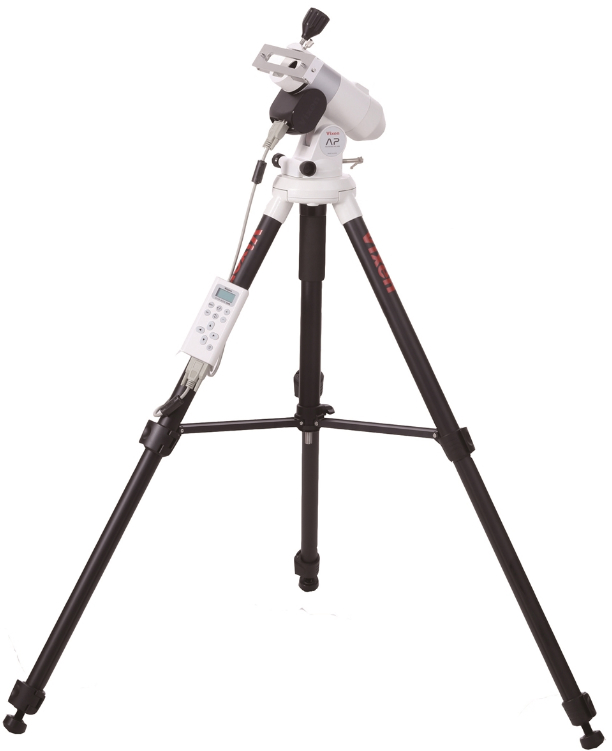
Editor’s Tip: To help facilitate long exposure astrophotography, we recommend using a photo guider for more accurate tracking. The Vixen Advanced Polaris (AP) Photo Guider is a lightweight star tracker that’s equipped with the Star Book One hand controller that gives you the ultimate in comfortable and precise operation. Using a moderate telephoto lens and the AP Photo Guider, you can snap images of Messier objects and other deep sky objects as well. Learn more about the AP Photo Guider by visiting MrStarGuy.com.
Timelapse Video of the Night Sky

One of the great things about digital photography is that it allows you to not only shoot traditional still photos and long exposures of the night sky, but you can also make timelapse videos that show the passage of time.
Some cameras come with a built-in interval timer that controls the time between exposures as well as the total number of photos that are taken in a pre-determined period of time. If your camera doesn't have a built-in intervalometer, you can pick one up without spending a ton of money.
Either way, the settings you enter into the interval timer determines how smooth the timelapse video appears. Naturally, the shorter the interval between each image, the smoother the movement will be.
Once you have your series of images, you use post-processing software like Quicktime Pro to create a timelapse video that shows each of the individual images in motion.
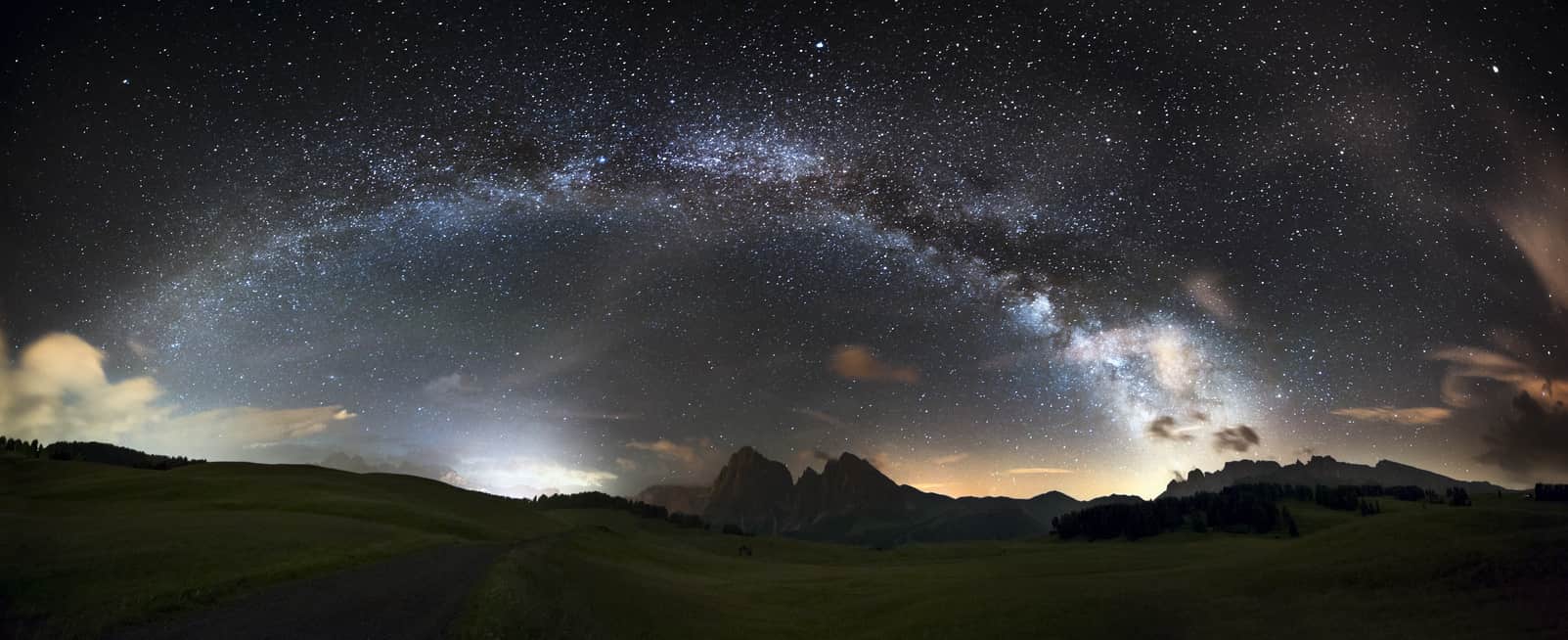
To get started with a timelapse video, you need to dial in appropriate exposure settings by using your camera's manual mode.
A good place to start is with an aperture around f/5.6 if the moon is full or f/2.8 if it isn't. Take a test shot using a shutter speed of about 10 seconds. Use the camera's LCD to zoom in on the image, looking to see if there is appropriate detail in the stars and the foreground of the shot.
Adjust the aperture, shutter speed, and ISO as needed to get a good overall exposure, being wary of using a shutter speed longer than about 20 seconds. Otherwise, star trails will become evident.
Once you have a well-exposed test image, set the interval between each image (around 30 seconds is a good place to start) and the duration for the shoot using the interval timer.
When the camera is taking the images, be careful not to move the camera or change any camera settings as any such changes will be noticeable in the timelapse video.
Adding Foreground Interest
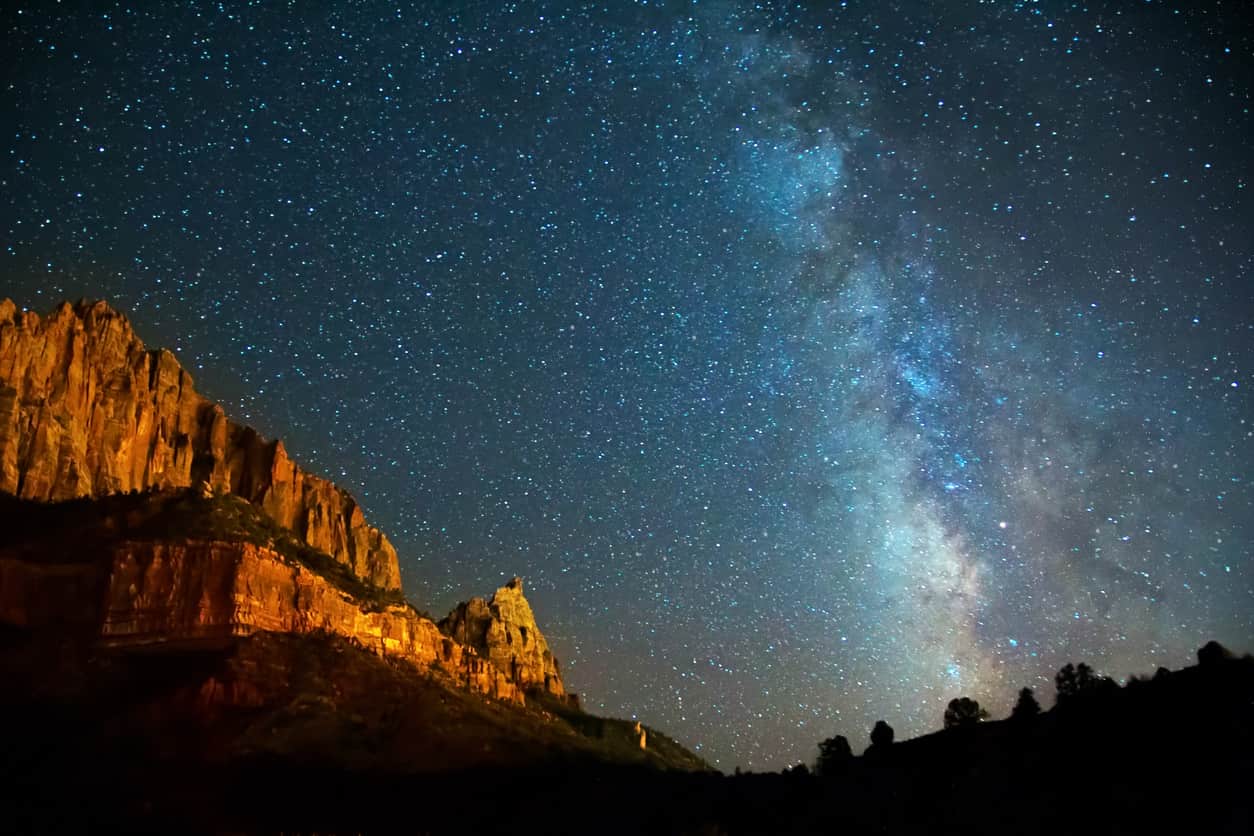
As I mentioned earlier, if there's interesting elements in the foreground of your photos or timelapses of the night sky, it's worth taking measures to ensure that the detail contained therein is visible in the shot.
Having interesting elements in the foreground helps give the image context, added visual depth, and also offers a nice contrast to the expanse of stars in the background of the image.
You can incorporate foreground interest in many ways, including using a wide-angle or a fisheye lens, or by setting up your gear in such a way that you can frame the foreground interest into the shot.
If the moon is out in full force, your lens will likely be able to collect enough light to capture the detail of the foreground elements.
But if there isn't much moonlight, you can light up the foreground using any number of techniques.
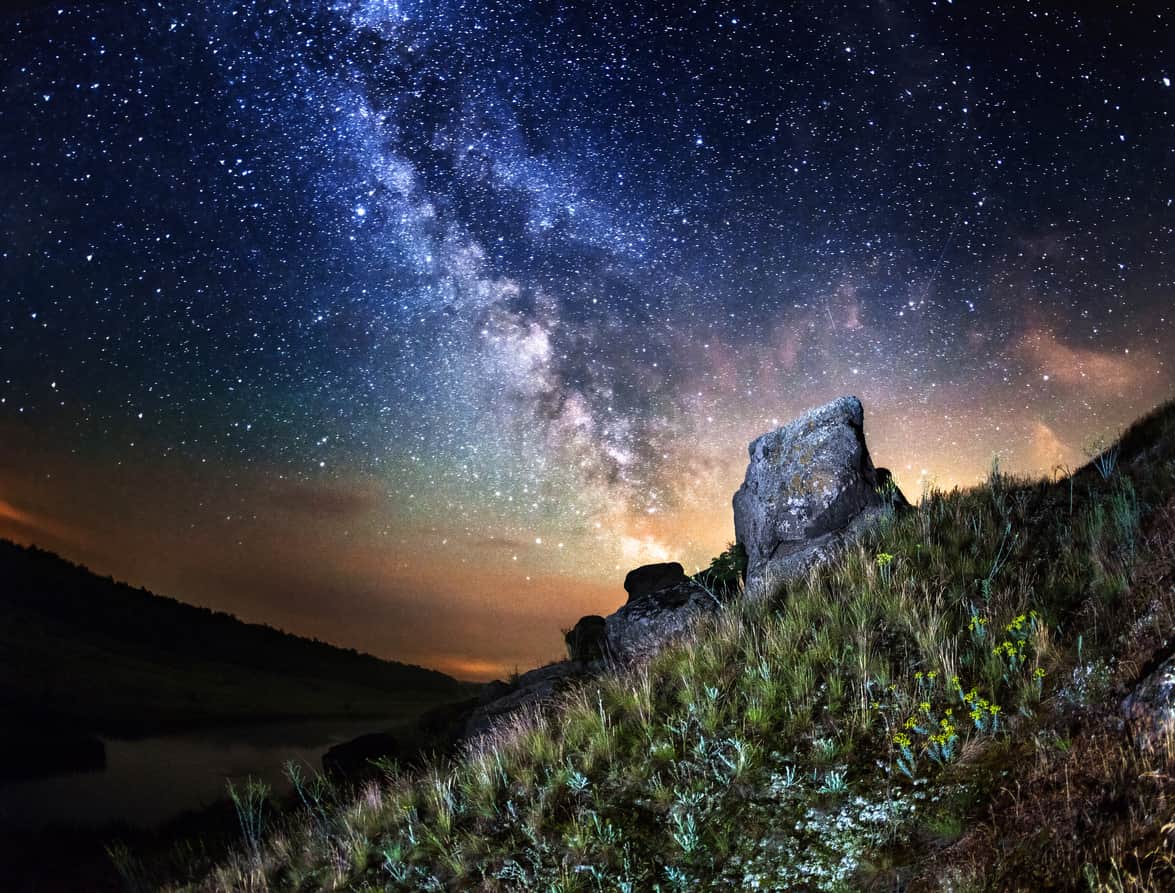
As noted earlier, you can paint with light by using a flashlight to illuminate foreground elements.
You can also use a speedlight. To do so, press the speedlight's flash button while the camera's shutter is open, and move the light from one side of the scene to the other to light up the entirety of the foreground. For a more unique look, think about painting with light using your speedlight in short pops of light. To do so, simply press the speedlight's flash button several times over the course of the exposure.
You can use a constant light source as well. Again, while the shutter is open, move the light around the scene for the duration of the exposure.
No matter what type of light source you use, be sure to keep it moving so the image doesn't have hot spots.
Final Thoughts
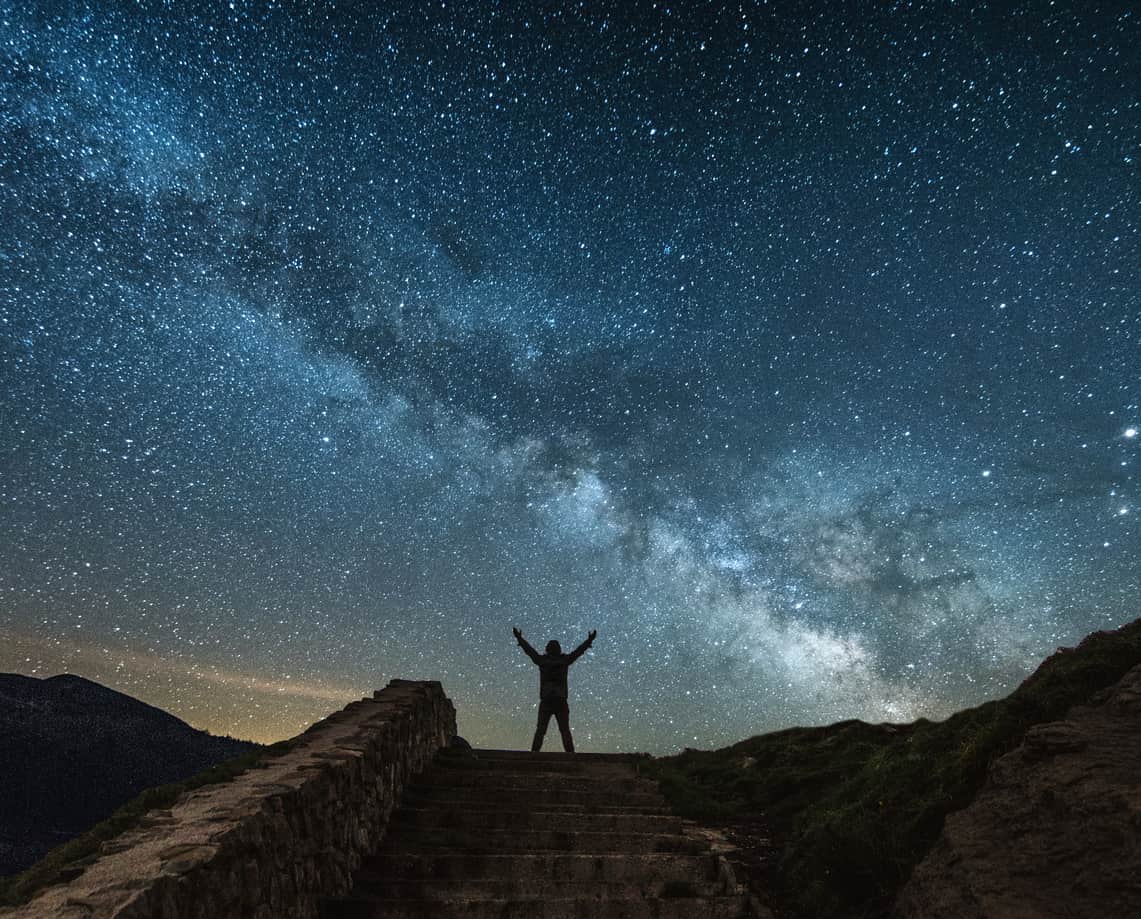
When you first venture into astrophotography, it can be a bit of a scary proposition.
However, if you dedicate yourself to learning a few fundamentals, outfit yourself with the right gear, and practice the art of night photography, before long, you'll have the knowledge and skills to create breathtaking images like those above.
To get outfitted with astrophotography gear, be sure to visit our partner, MrStarGuy, for excellent deals on everything binoculars, telescopes, mounts, tripods, and more.
We Recommend
How to Take Sharp Photos at Night
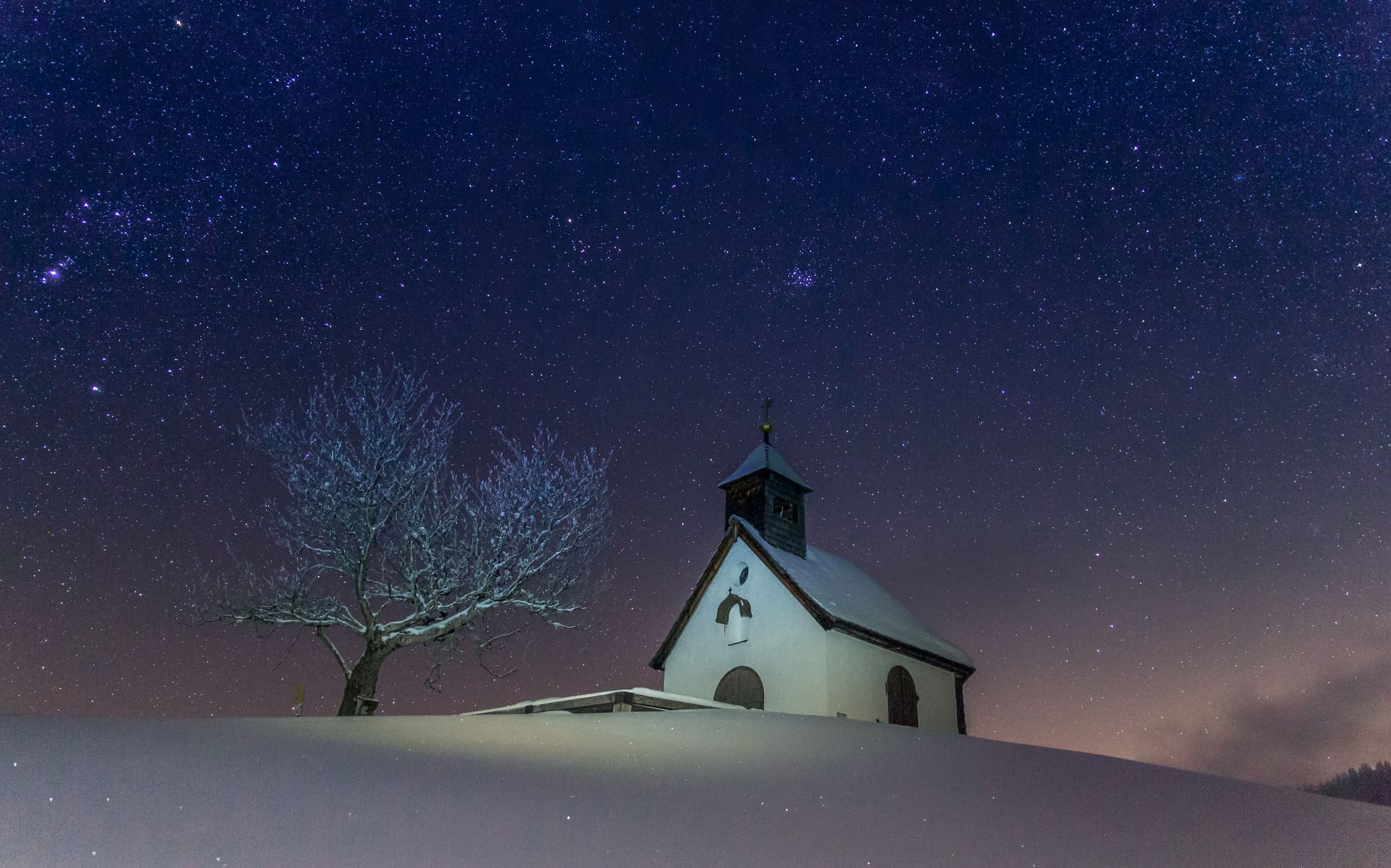
When you shoot photos during the day, the autofocus system on your camera is good enough to work like a charm in most instances.
Granted, it's not perfect, but the instances in which it isn't spot on are few and far between.
But shooting at night is another story...
Even the most sophisticated autofocus systems struggle to acquire focus at night or when shooting a dark scene. The question is how to take sharp photos at night.
Fortunately, there are quite a few things you can do to get the tack-sharp photos you're after.
Editor's Tip: New to astrophotography? Get all the latest tips and tricks in our astrophotography section, sponsored by our friends at MrStarGuy. If you need a tripod, a telescope, astro binoculars, or any other astrophotography gear, MrStarGuy - a family-owned business that treats you like a friend - is the place to do it!
How to Take Sharp Photos at Night: Manual Focus
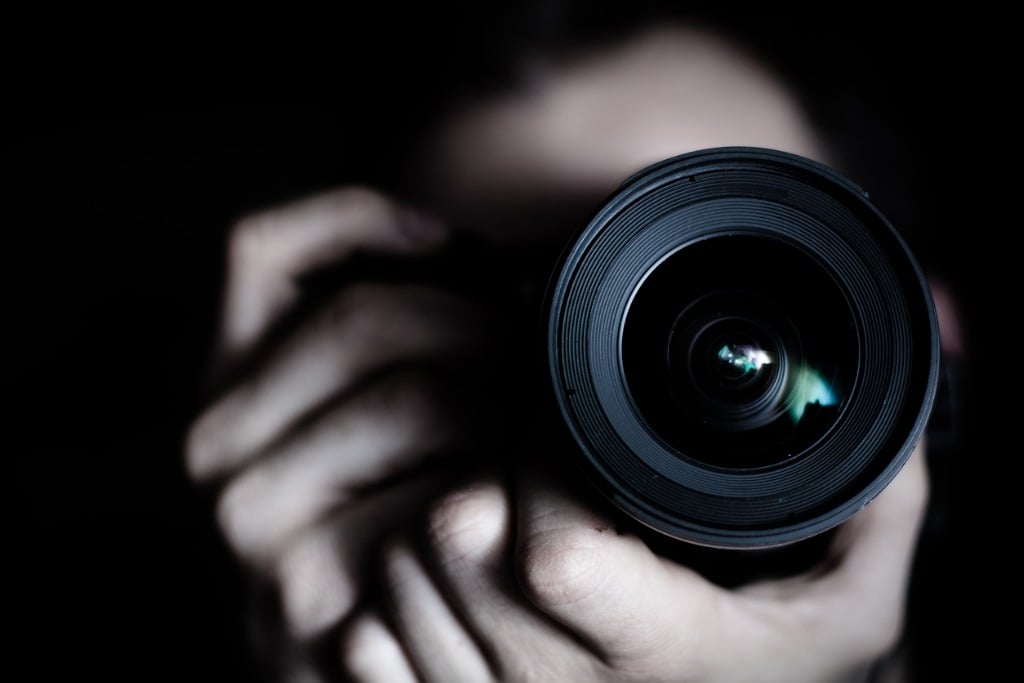
Even if you have a camera with a superb autofocus system (like the Sony a7R III), it's still not good enough to acquire focus on its own at night.
That means that you need to take control of focusing and manually focus the lens to get the sharpest focus in your photos of the night sky.
I've explored manual focusing in detail in this post, but as a quick guideline, you simply need to do the following:
- Set your lens to manual focus
- Set the focus at infinity
- Enable live view
- Frame the shot, with the brightest object in the sky in the center of the frame
- Use live view to zoom in on the bright object
- Fine-tune the focus by manually adjusting the focus ring
- Take a test shot
- Inspect the results
- Lock the focus in place with gaffer's tape once the focus is spot on
This method might seem a little laborious, but the sharpness of the images you take certainly make all the effort worth it.
Besides, the more you practice, the faster you'll become at performing each step.
Check out a quick and simple overview of manually focusing your lens for astrophotography in the video above by Michael Coustier.
Refining Manual Focus for a Sharp Picture
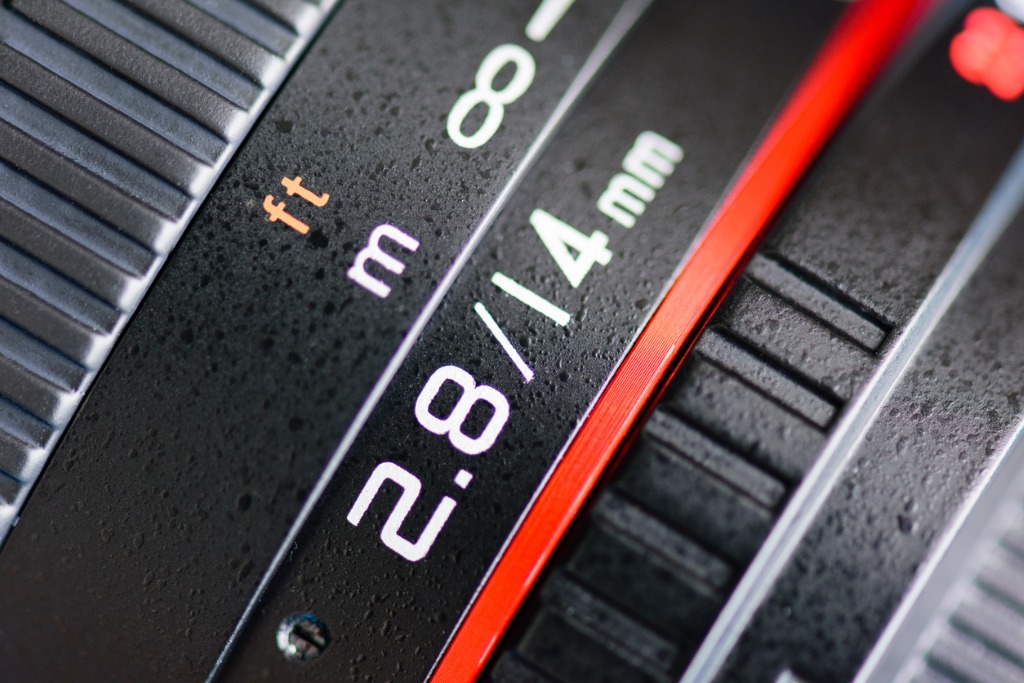
As noted above, a good place to start with manual focusing is to set your lens at the infinity mark.
But there's a catch...
You can't just use the infinity mark on your lens because the marks on your cameras lens are seldom perfectly accurate.
That means you need to fine-tune the focus to get optimal results.
Zooming in using live view as described above is one way to get sharper focus.
Since you can't zoom in using the viewfinder, relying on the LCD panel on the back of your camera to get as close as possible to the target subject will help you zero in the focus with much better accuracy.
But there's another way to get a sharp picture at night...
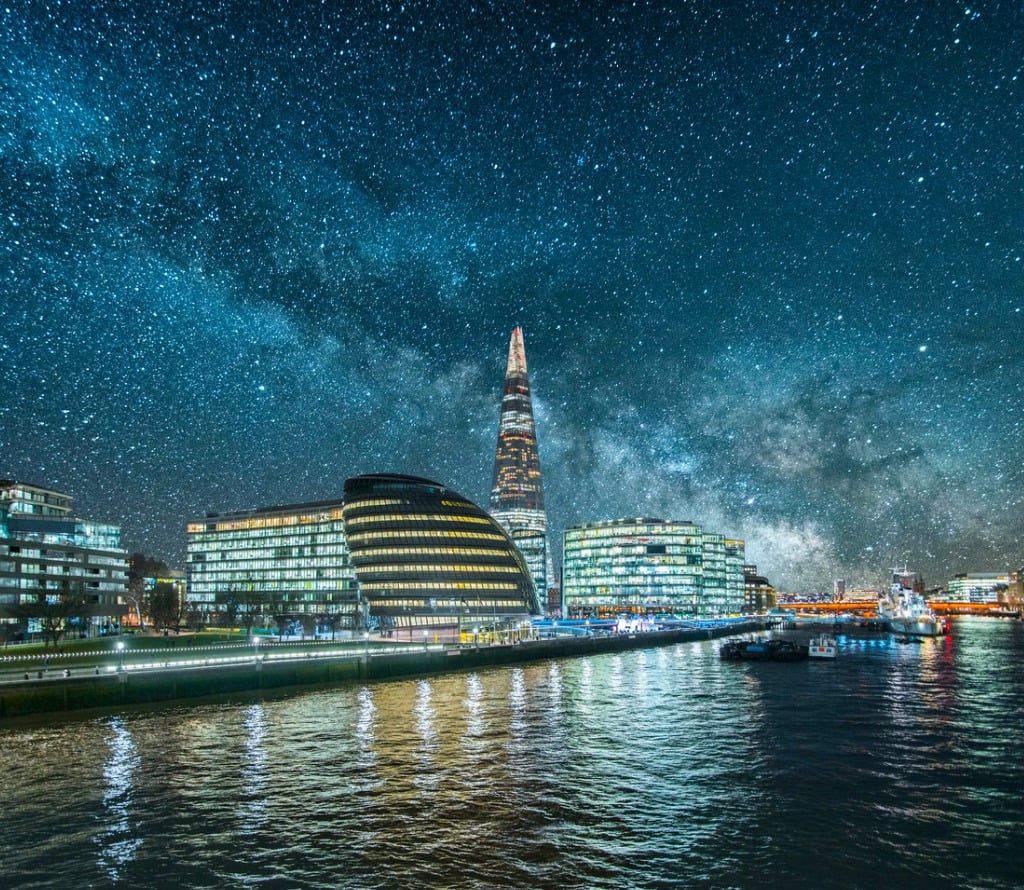
If you can't seem to acquire focus on a star or other celestial body, you can often use a bright object that's much closer to get the focus right in your shots.
Whether that's the light emanating from a town far away, the lights on a building in the distance or something else of the sort, as long as it's far enough away (at least 100 feet) for your camera to focus at infinity, it will help you get the stars in the sky above in sharp focus, too.
Learn More:
Taking Photos in Low Light: How to Tell if Your Camera is Focused
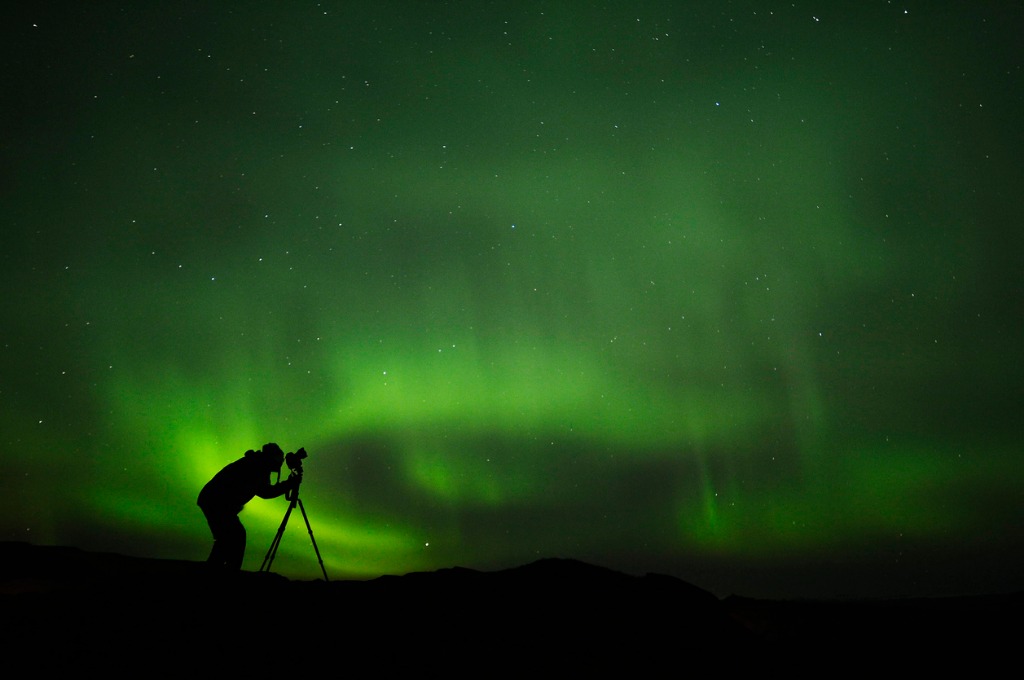
When zooming in using live view and manually adjusting the focus ring, it can still be a little tough to tell if your focus is spot on.
Perhaps the easiest way to get a sharp picture is to inspect the size of the object on which you've focused.
If you're focusing on the brightest star in the sky, it should look like the head of a pin - like a clear, crisp dot that is virtually perfectly white.
If the star isn't in focus, you can tell by its color because it will appear green if the focus is in too far and magenta if it isn't focused enough.
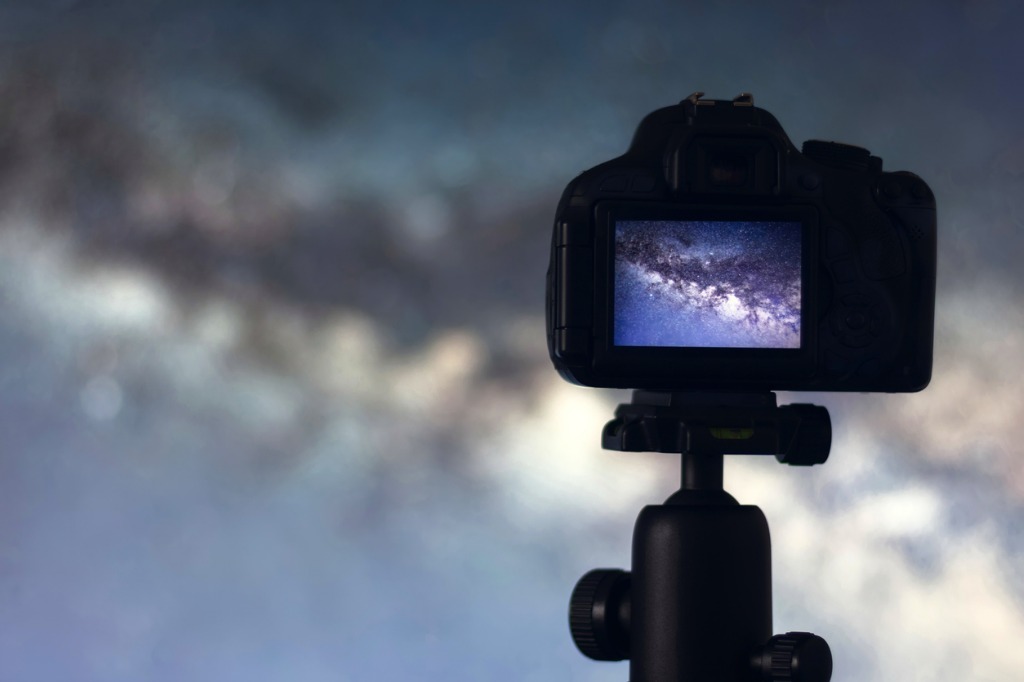
This change in the color of the stars as they go in and out of focus is due to spherical aberration that's common in lenses with very large apertures.
This aberration is called spherochromatism, which causes the colors shifts I mentioned above in very high-contrast highlights that are out-of-focus.
When using live view to zoom in and check focus, simply check for these color changes and use them as a guide to hone the focus of the shot.
If you see green, focus in more. If you see magenta, bring the focus back. If you see bright white, you've got it, and should see better results when taking photos in low light.
Bonus Tip: How to Get Pinpoint Stars
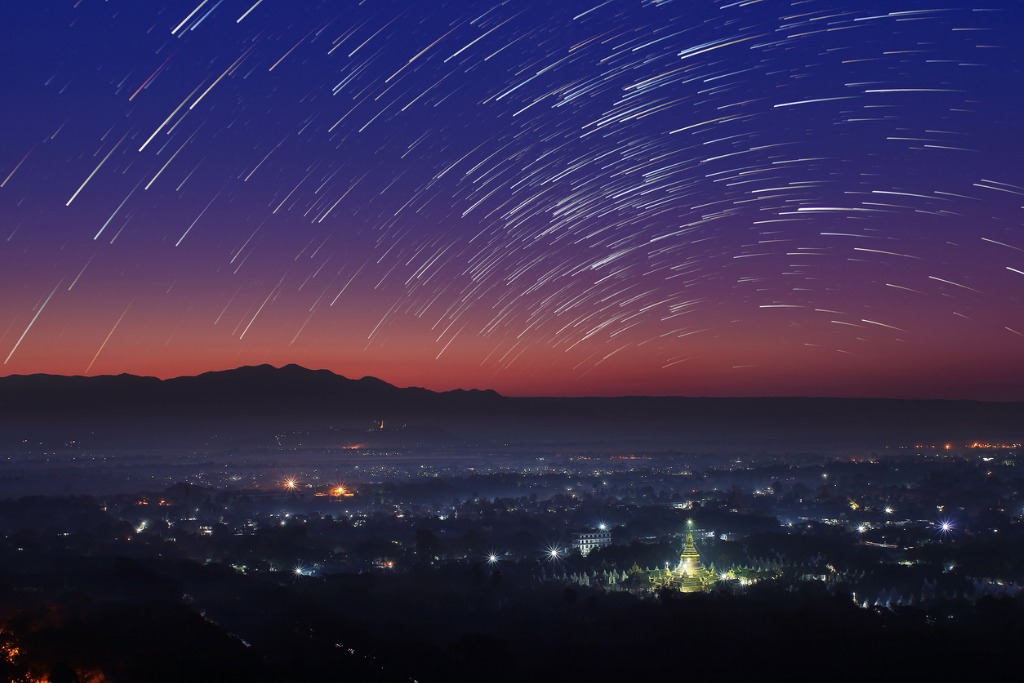
Though images like the one above can be beautiful, when you want to avoid the movement of the stars and photograph them as sharp pinpoints, using a star tracking mount is the way to go.
These mounts, like the Vixen Polarie shown below, make it easy for anyone to photograph the night sky.

Just attach the mount to a standard tripod, attach your camera to the mount, and orient the mount to face north.
Once the Polarie is set, it will track the movement of the stars for you, and eliminate star trails.
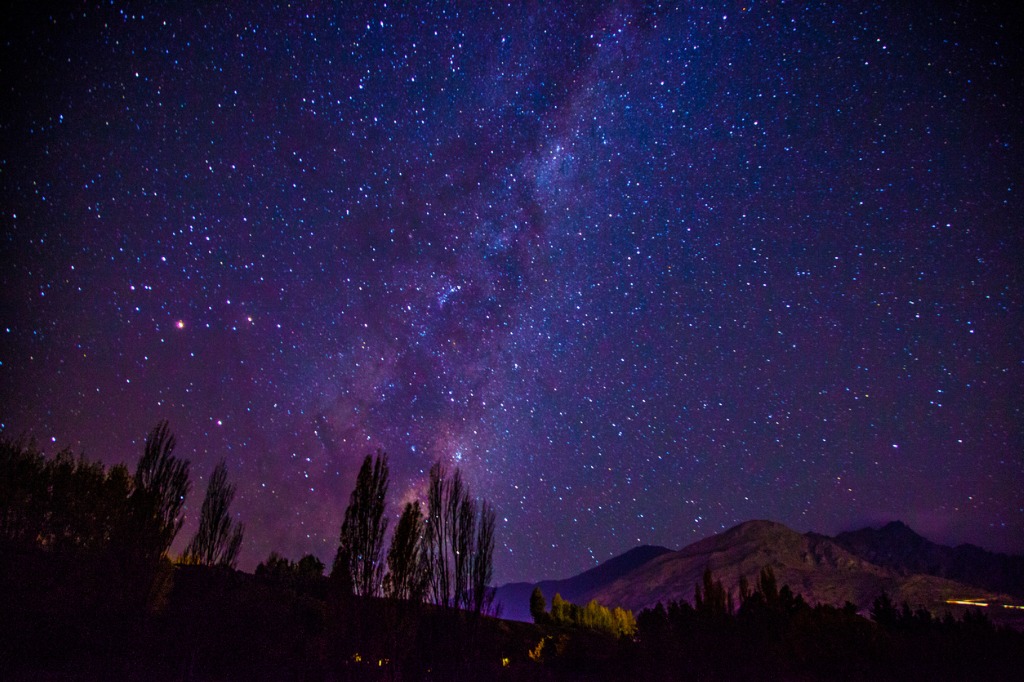
The resulting images will show the night sky just as you see it - with gorgeous, bright stars that are sharply in focus.
The Polarie is easy to setup, easy to use, and can be used with any camera that weighs up to seven pounds. You can even use it with your smartphone!
Learn More:
- Get the Specs and Pricing on the Vixen Polarie Star Tracker Mount
- Take Better Photos of the Stars With These Quick Tips
We Recommend
Introduction to Astrophotography
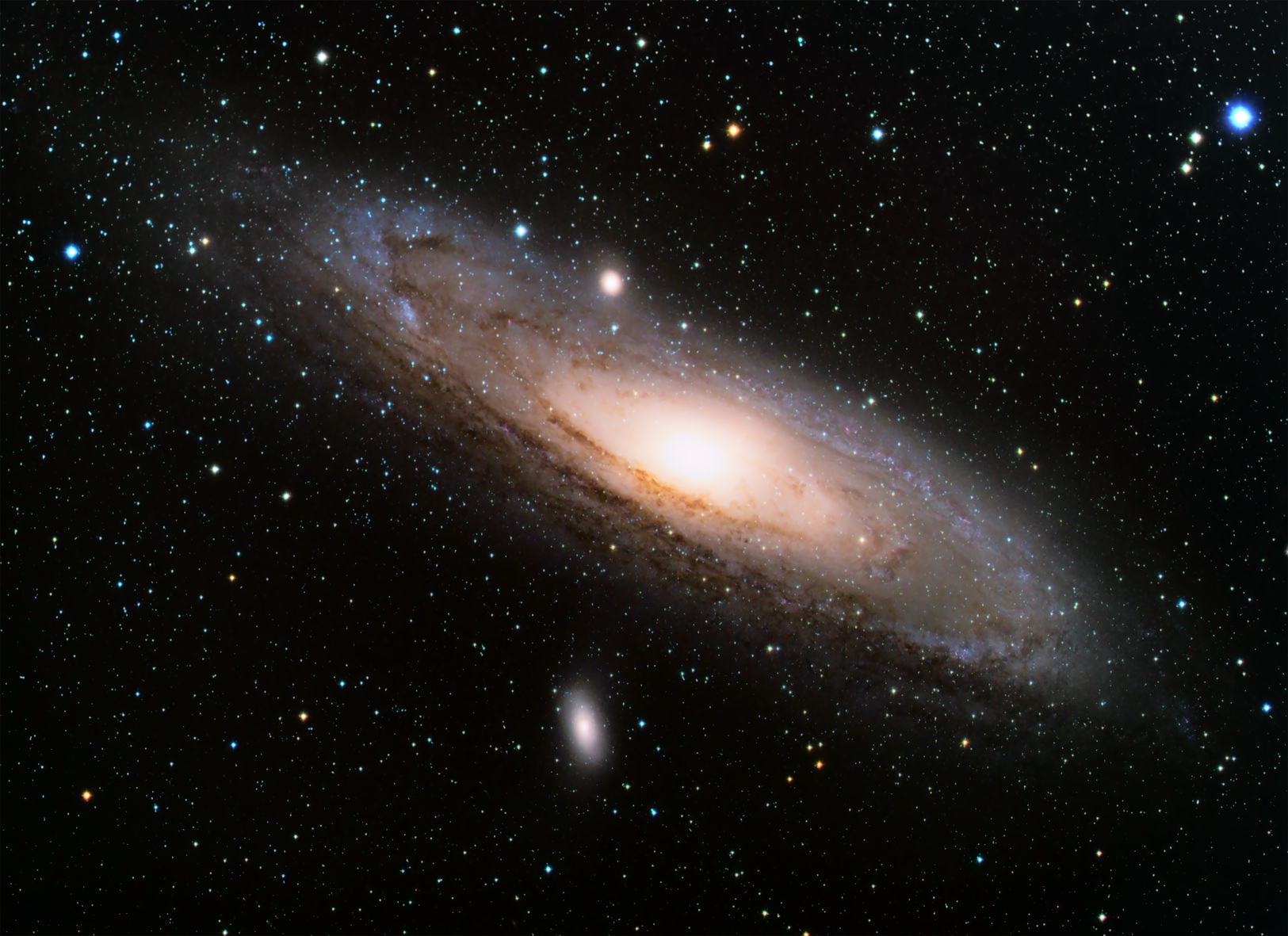
The Universe and our own solar system have always been awe-inspiring subjects for those of us living on this little, blue planet.
Capturing images of what's "out there" is an undertaking that we've tried to perfect since the invention of the camera and we – as a race – have developed extremely sophisticated instruments and technologies with that in mind. We've even launched incredibly complex telescopes and cameras into near space and sent others to the outer reaches of our solar system to beam back photographs of our nearest planetary neighbors.
The field of astrophotography emerged as a result of human efforts to gather those images of the Heavens and what they hold.
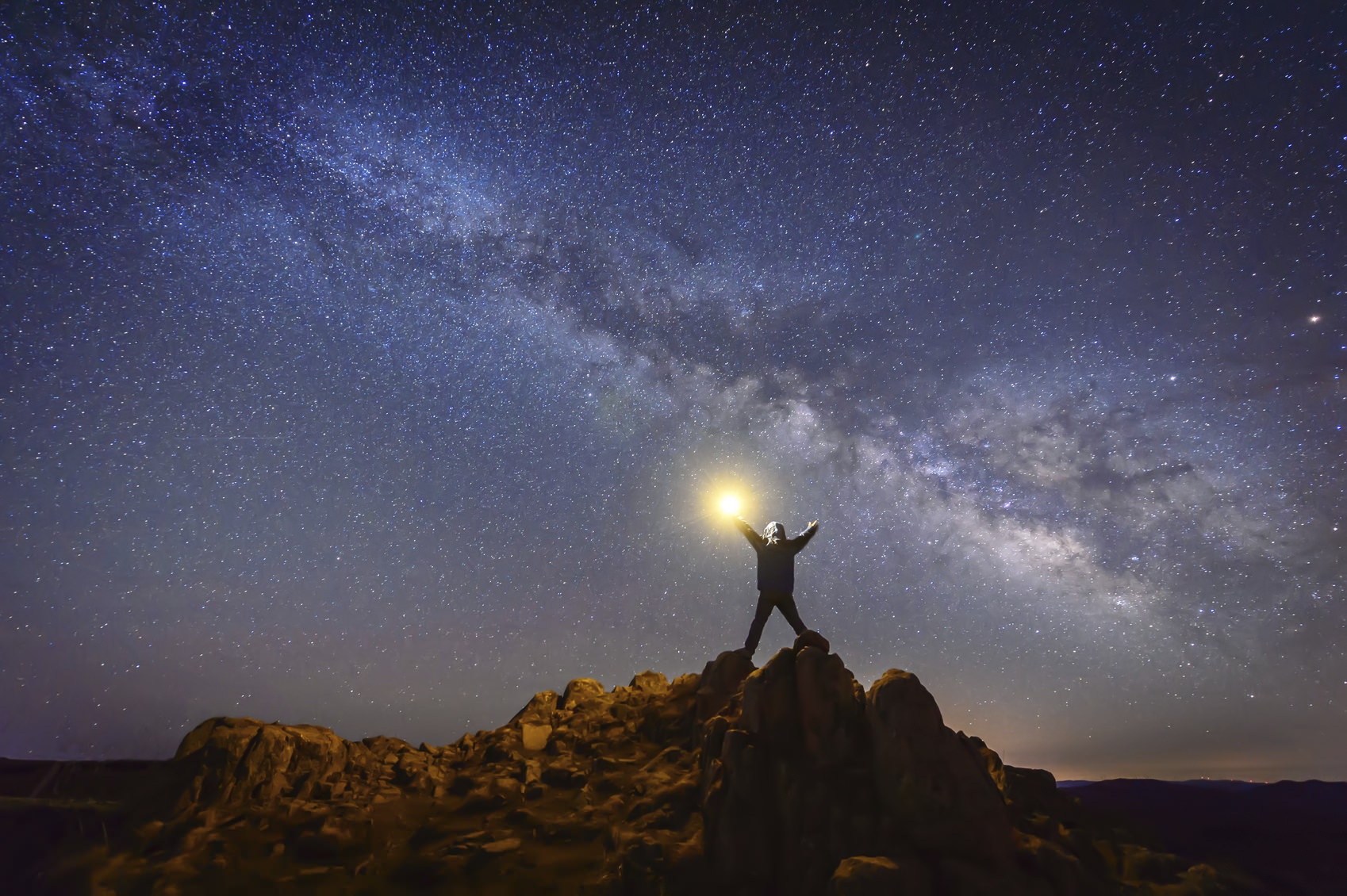
Its definition is, simply, photographing astronomical objects and the night sky. That definition covers a lot of areas, and so does the field itself.
When you point your smartphone camera at the moon, you're practicing astrophotography, just like that lucky guy or gal with an observatory in the backyard. From wide shots of the Milky Way to close-ups of planets, comets and asteroids, all of these images fit into the field of astrophotography.
Because of its wide scope, terrestrial-based astrophotography is generally divided into three distinct categories.
Wide-Field Astrophotography
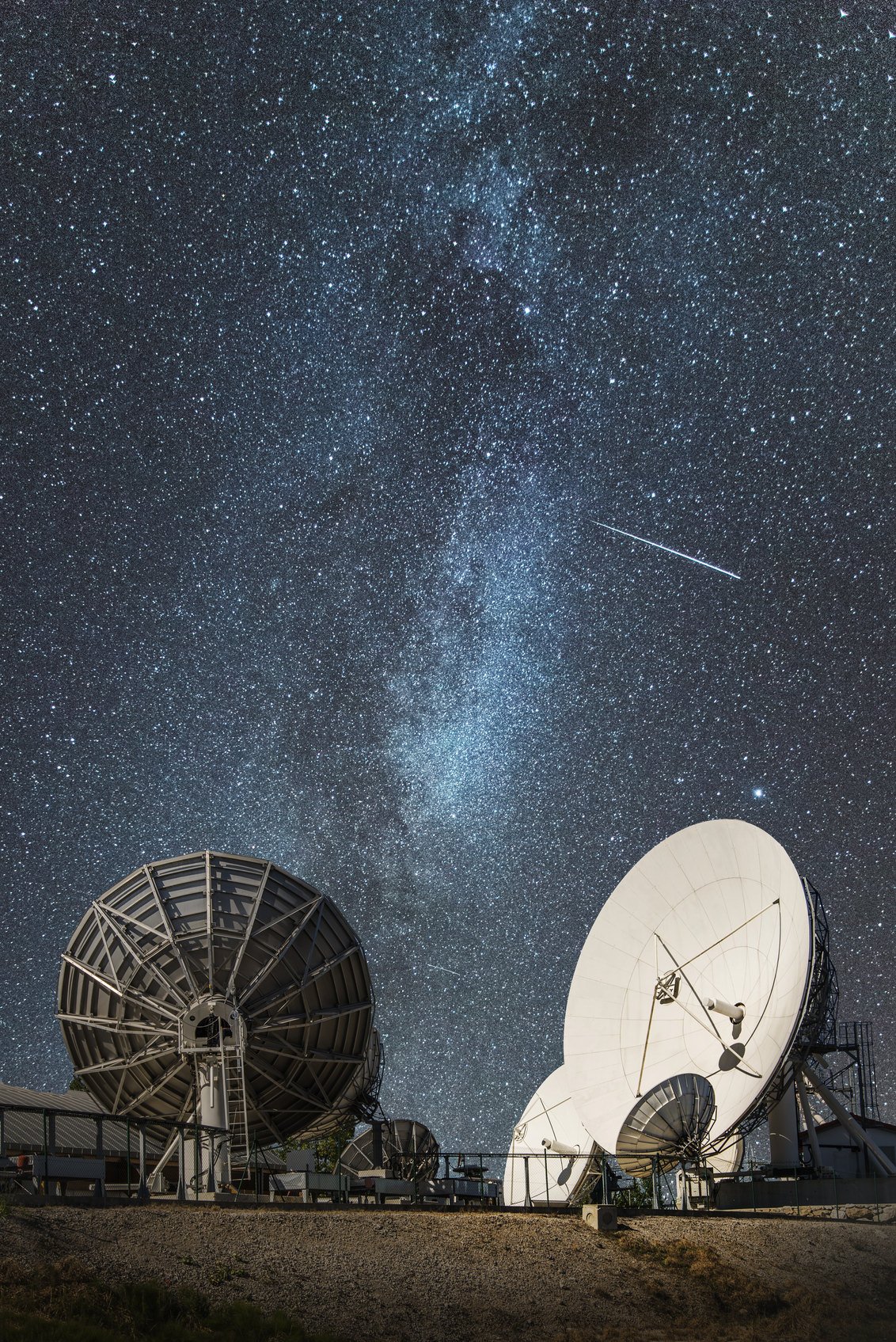
This category deals with images of the night (or pre-dawn or dusk) sky and the stars, planets and other objects visible in it. This type of photography requires little more than a camera, tripod, and patience, though a star-tracking mount is a great addition as well.
Wide-field images often include atmospheric phenomena such as the Aurora Borealis or Aurora Australis as well as the moon and/or landscape or architectural features. Star trail images also fall into this category.
In our collection of astrophotography articles, we'll touch on wide field photography techniques and some of the specialized equipment available, such as astronomy DSLRs, which can greatly enhance your astrophotography images.
Planetary Imaging
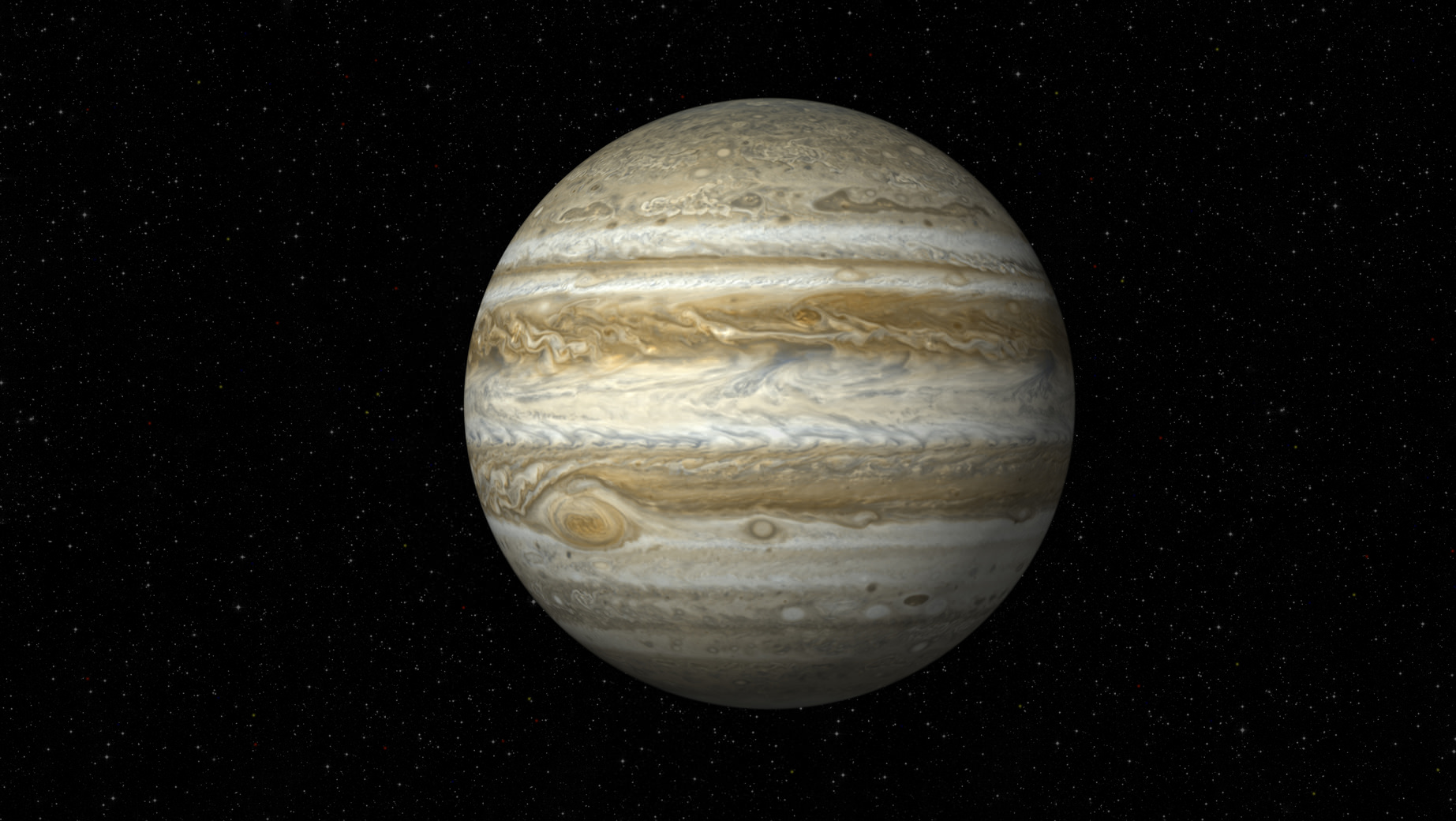
As the name implies, this category involves capturing images of individual planets. The reason it isn't referred to as planetary photography is due to the fact that images of planets and other celestial bodies are usually created from stills extracted from digital videos, then composited and enhanced.
As you might expect, this type of imaging requires a telescope with high enough magnification to let you locate a planet within the field of view, although many software applications exist that allow you to create stunning images from surprisingly small "blobs." It's also possible to adapt and use your DSLR to record the original videos, although specialized video recorders are available.
Deep Sky Astrophotography
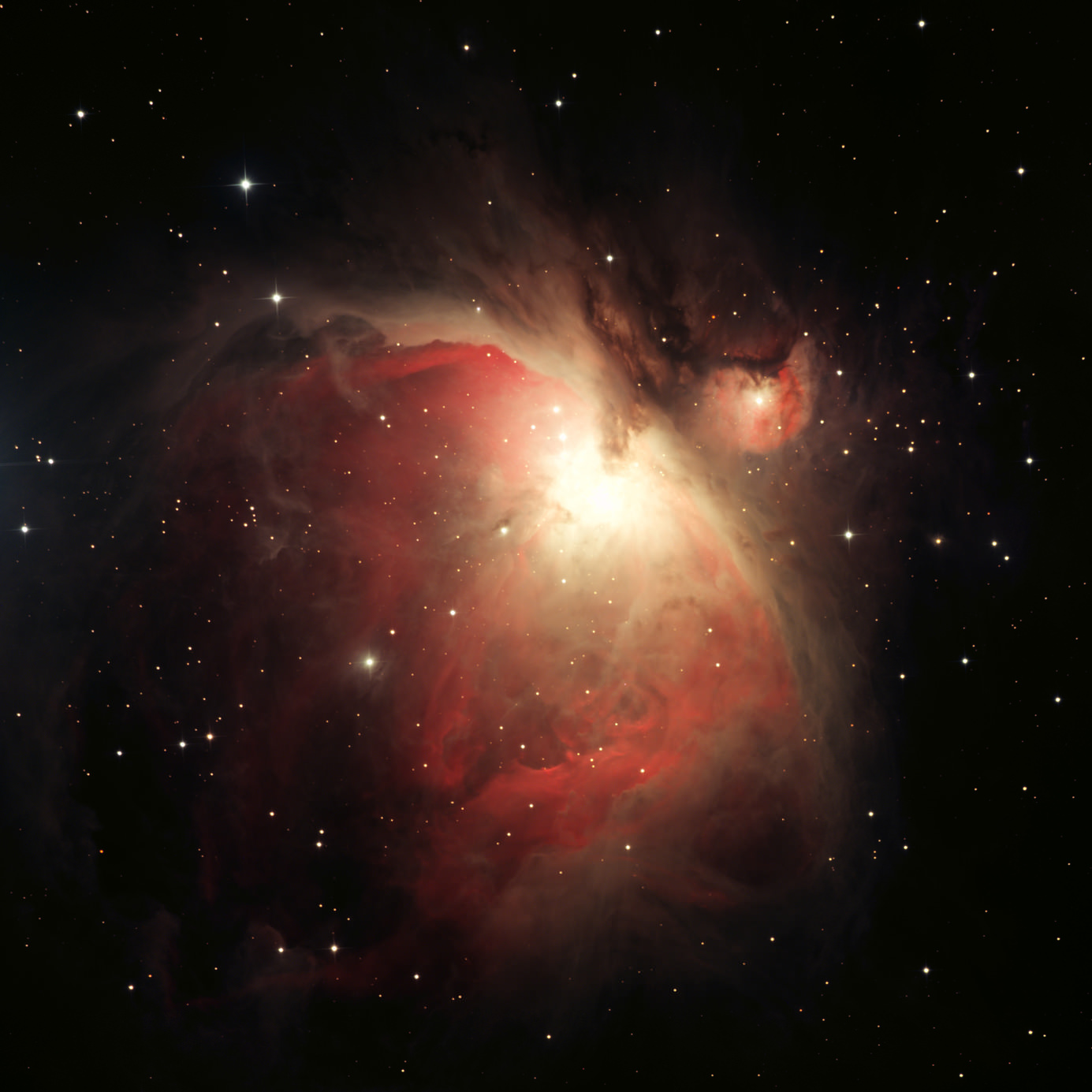
Images of nebulae, other galaxies, and other distant bodies in outer space might be considered the pinnacle category of astrophotography. This type of imaging requires specific techniques, including extremely long exposures. As with the previous category, creating deep-sky images often involves stacking several long exposures to help reduce noise.
A good quality, powerful telescope, a stable mount, and a top-quality photo guider are, of course, a requirement for this type of imaging. A DSLR may be used to record the original images, with the proper adapters. Again, the use of an astronomical DSLR will greatly enhance images taken of distant celestial objects.
If you've ever dreamed of capturing those breathtaking images of what's hidden out there, beyond the range of our vision, keep exploring our astrophotography section to get tips on everything from composing your images to learning the right camera settings to getting geared up with astrophotography equipment.
We Recommend
Quick Tips for Photographing the Full Moon or Supermoon

The great thing about photographing the moon is that you have many chances each month to photograph it in its various phases.
That means that if you don't quite get the shot you want the first time you try, just give it another shot the next day.
Even the full moon gives you an opportunity each month to capture its beauty. On more rare occasions, you can even photograph a supermoon!
The question is, how do you go about photographing the moon?
In this tutorial, I offer up a few tips to help you do just that.
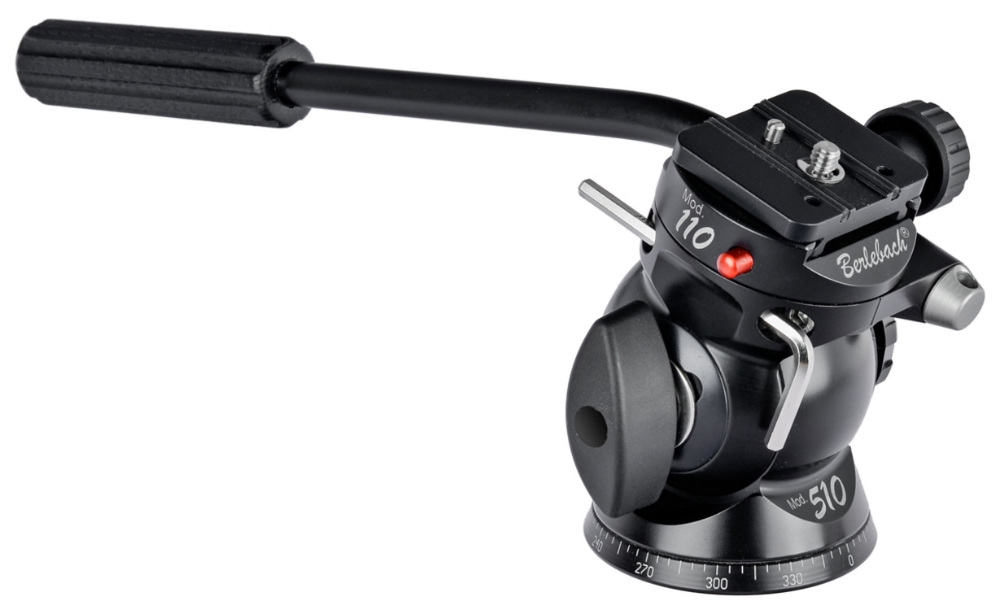
Editor's Tip:To photograph the moon, you can use a regular DSLR or mirrorless body and a zoom lens like a 70-300mm. That will give you a wide range of focal lengths for getting shots that include interesting foreground elements as well as tighter shots of the moon on its own. You'll need a sturdy tripod to give your camera and lens a stable base for capturing the sharpest images, and a tripod head for smooth movement. We recommend the Berlebach Two-Way Tilt Head (shown above) because it has a high load capacity as well as the ability to swivel in the vertical direction by 90-degrees on both sides. Friction is adjusted using a wheel opposite the clamping element, and the guide handle is mountable for both right-handed and left-handed shooters. It's versatile, too, so you can use it with a spotting scope or binoculars, in addition to your camera
Scout a Location
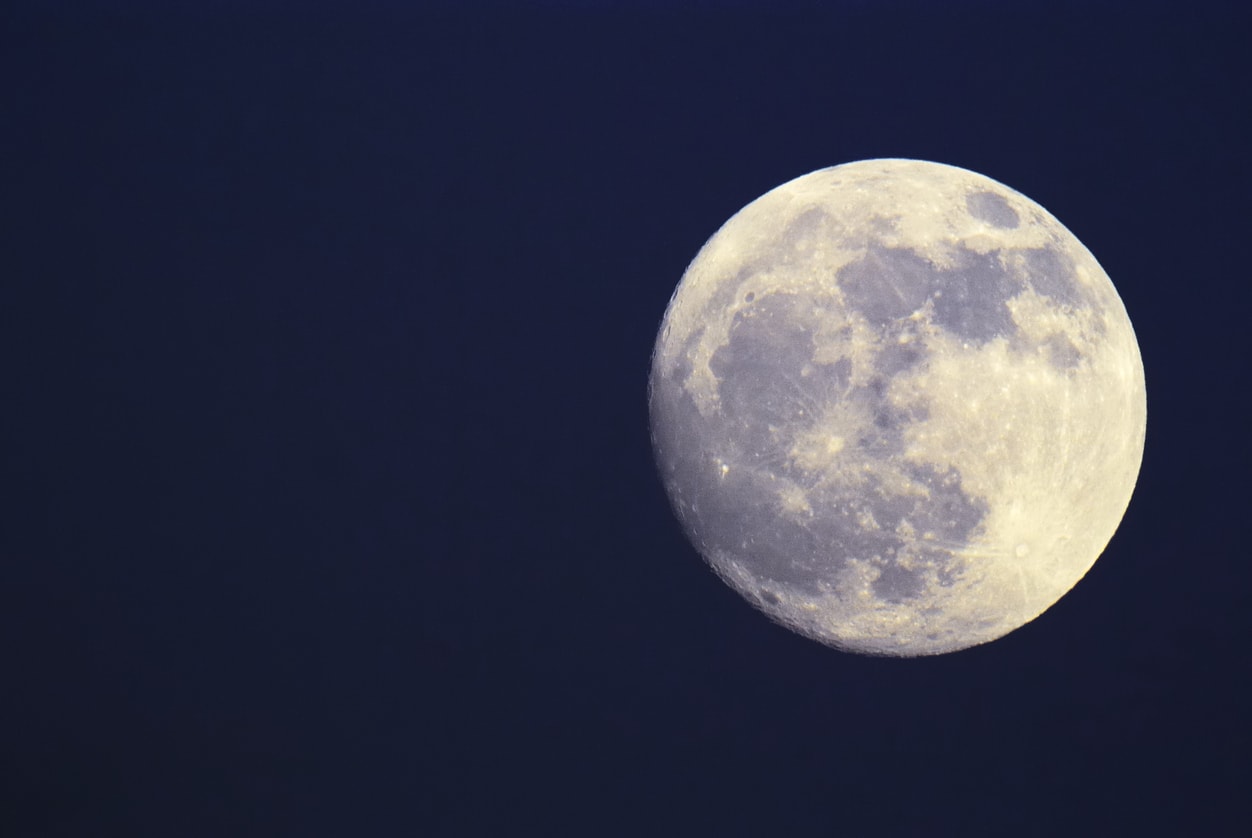
When photographing a full moon or supermoon, think about the type of image you want to create.
Naturally, if you want to fill the frame with the moon, you'll need a vantage point that offers an unobstructed view, as seen in the image above.
Close-ups of the moon offer the best view of its features and are perhaps the easiest to compose. Likewise, when adjusting your exposure settings, you have just one feature in the image to be concerned about, making it an easier shot from an exposure standpoint as well.
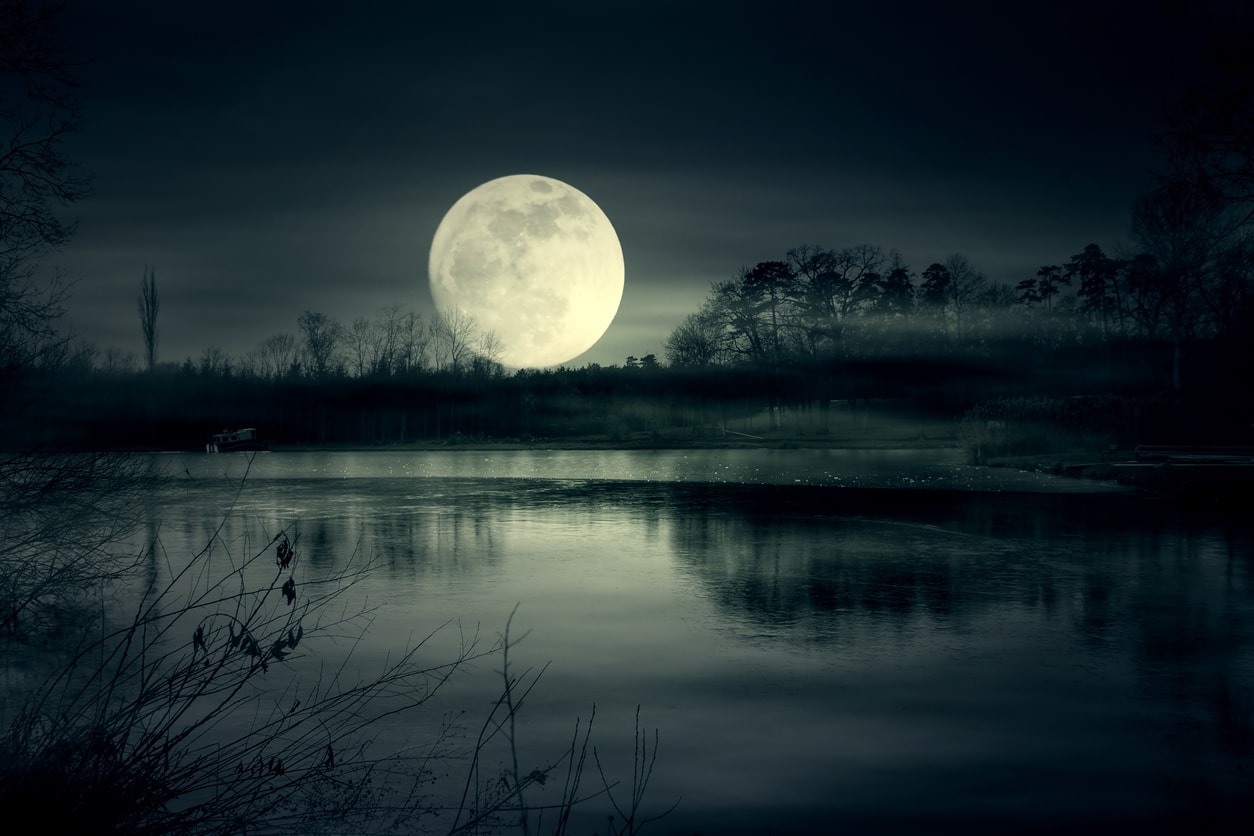
If you want to incorporate foreground elements into the shot, look for vantage points that allow you to include things like mountain peaks, trees, or other landscape features.
A wider shot like this requires that you work a little harder to get a well-exposed image.
That's because you'll have a wider dynamic range in the shot - from the very bright moon to darker foreground elements. If you expose for the moon, the foreground might be way too dark. Conversely, if you expose for the foreground, the moon might be far too bright.
An effective solution for this problem is to take multiple exposures - one exposed for the moon and one exposed for the foreground - and blend them together in a program like Photoshop or Lightroom.
When creating a composite, it is absolutely imperative that you do not move the camera. Otherwise, the two images won't line up perfectly.
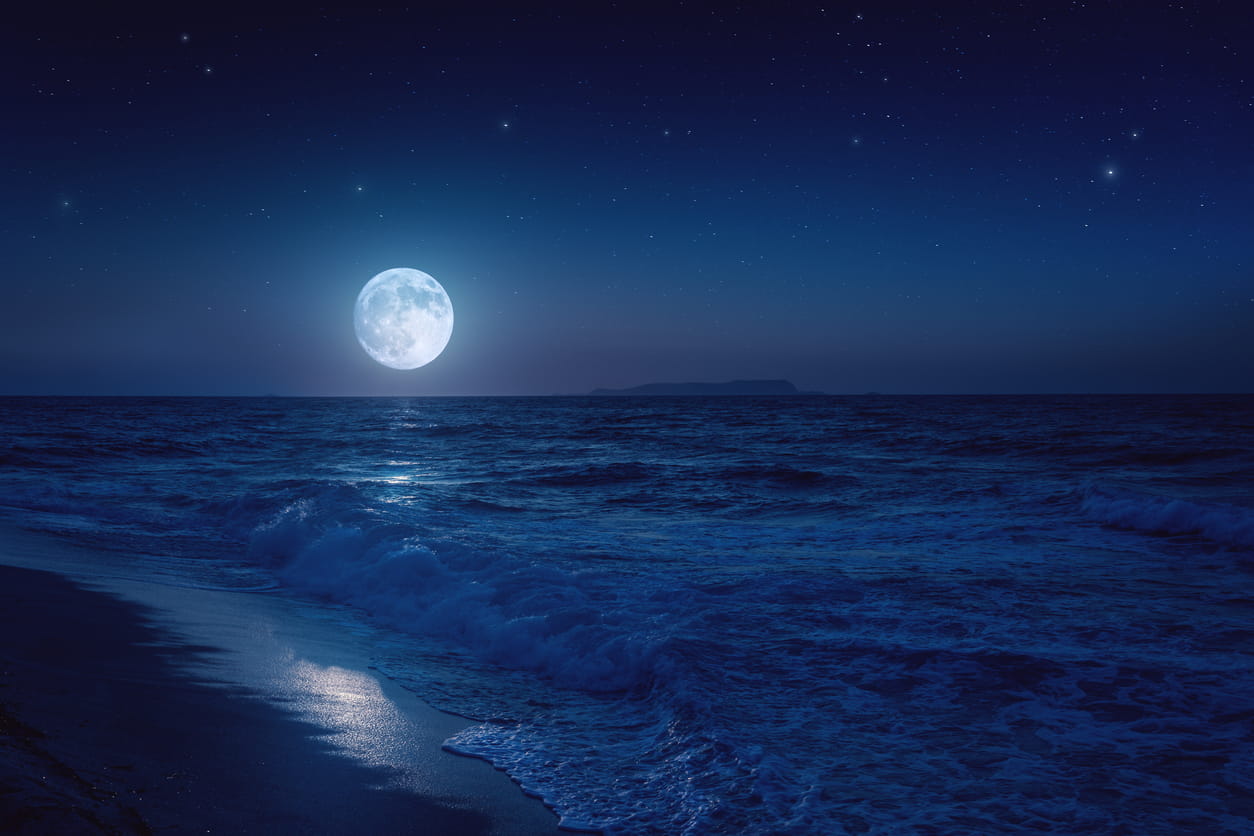
Something else to think about when scouting a location is if you want to create a composite by taking two completely different images.
For example, perhaps you take a shot of the moon on its own and then go to another location to photograph a night landscape.
Then, in post-processing, you can combine the two images together. This helps get around the issues of dynamic range discussed above, and also allows you to highlight both the moon and the landscape in a single image.
If you choose to utilize this method, just be sure you shoot both images with the same focal length to make the process of compositing the images easier. It also generates a more realistic result.
Learn More:
- Get Geared Up for Viewing and Photographing the Moon and Other Celestial Objects
- Learn How to Create a Composite Lunar Image in Photoshop
Set the Exposure
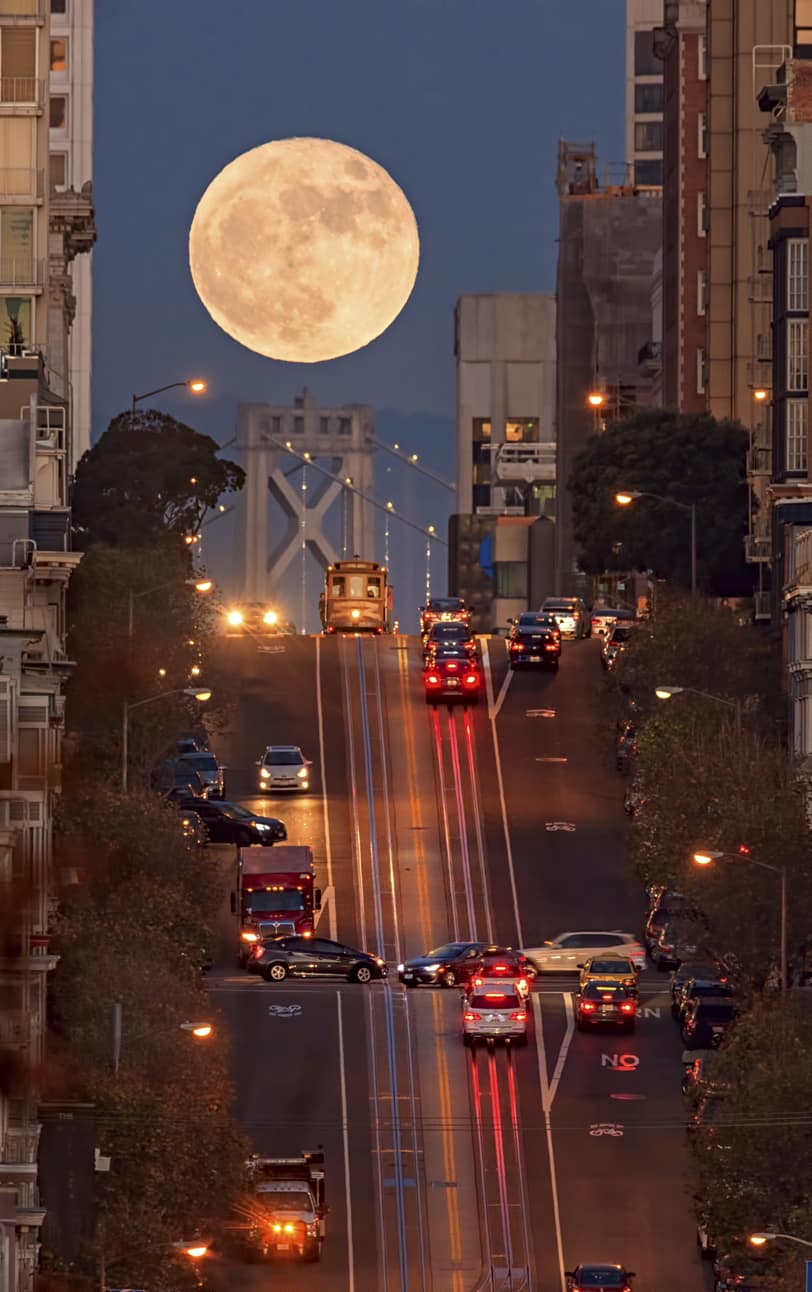
When photographing the full moon or a supermoon, it's advisable to dial in the exposure settings manually. You don't necessarily have to use manual mode, either, as aperture priority mode, shutter priority mode, or program mode can be used as well.
When dialing in the settings, err on the side of underexposing the image, that way you can retain the detail of the moon's surface without blowing out the highlights.
To determine the best settings, use spot metering to get a reading off of the moon and take a few test shots with bracketed exposures to find which one best aligns with your vision for the shot. Granted, if you're going to create a composite image, meter off the moon for one shot and for the other shot, meter off the landscape.
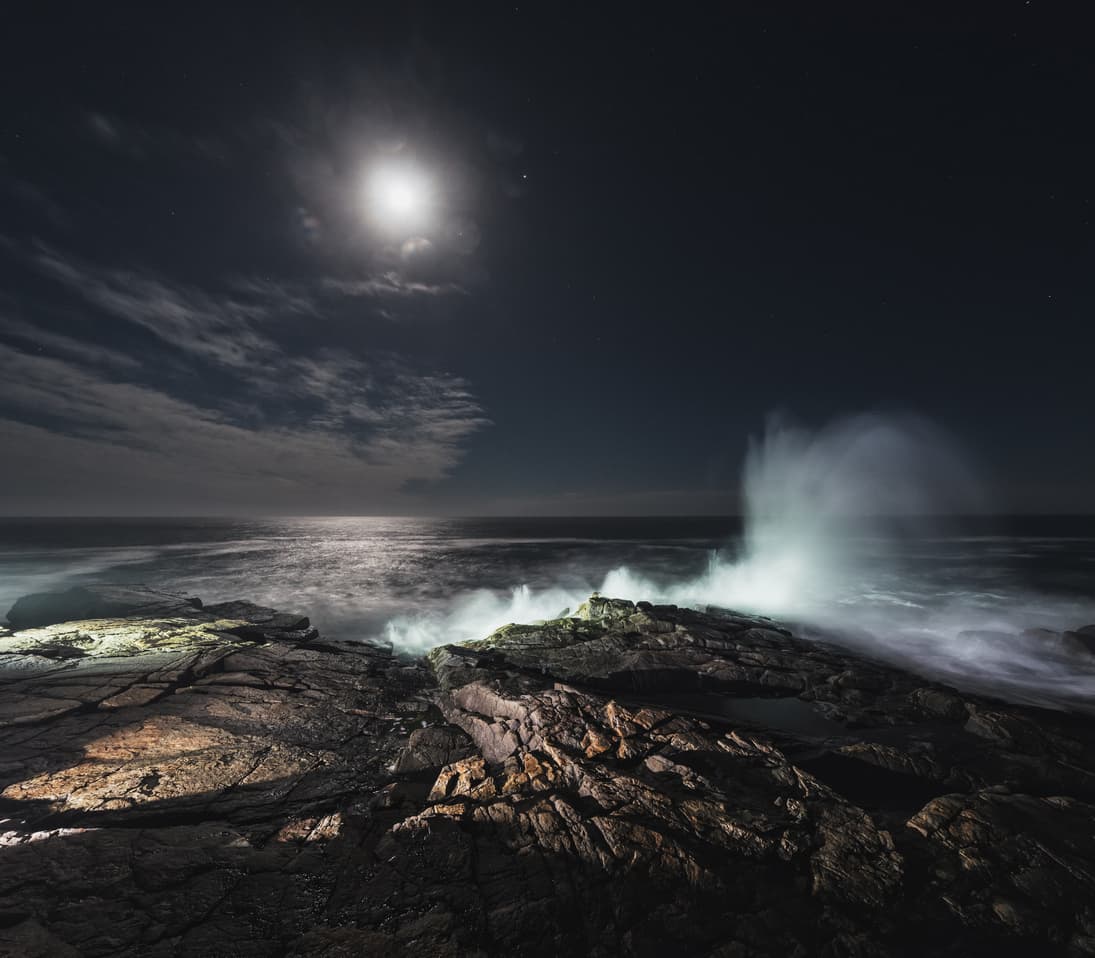
When choosing a shutter speed, start with 1/15 seconds, choosing faster shutter speeds if necessary as the movement of the moon is quite fast.
Next, select an aperture, probably in the range of f/8 or f/11, and set the focus to infinity. Adjust the ISO as needed to fine-tune the exposure.
From there, it's a matter of taking the photo or multiple photos if you want to create a composite as described earlier.
To avoid camera shake, use a camera remote or the camera's built-in timer to take exposures without causing vibrations to the camera.
Remember, you'll need to do some experimentation with the camera settings to get the exposure just right, but if you follow these steps, you can get great shots of the full moon, supermoon, or its various phases.
Learn More:
- Understanding Manual Mode of a DSLR Camera
- Beginner Photography Tip: Advanced Camera Controls That Will Take Your Photos to the Next Level
- Best tool for photographing moon and stars
We Recommend
Take Better Photos at Night With These Simple Astrophotography Tips
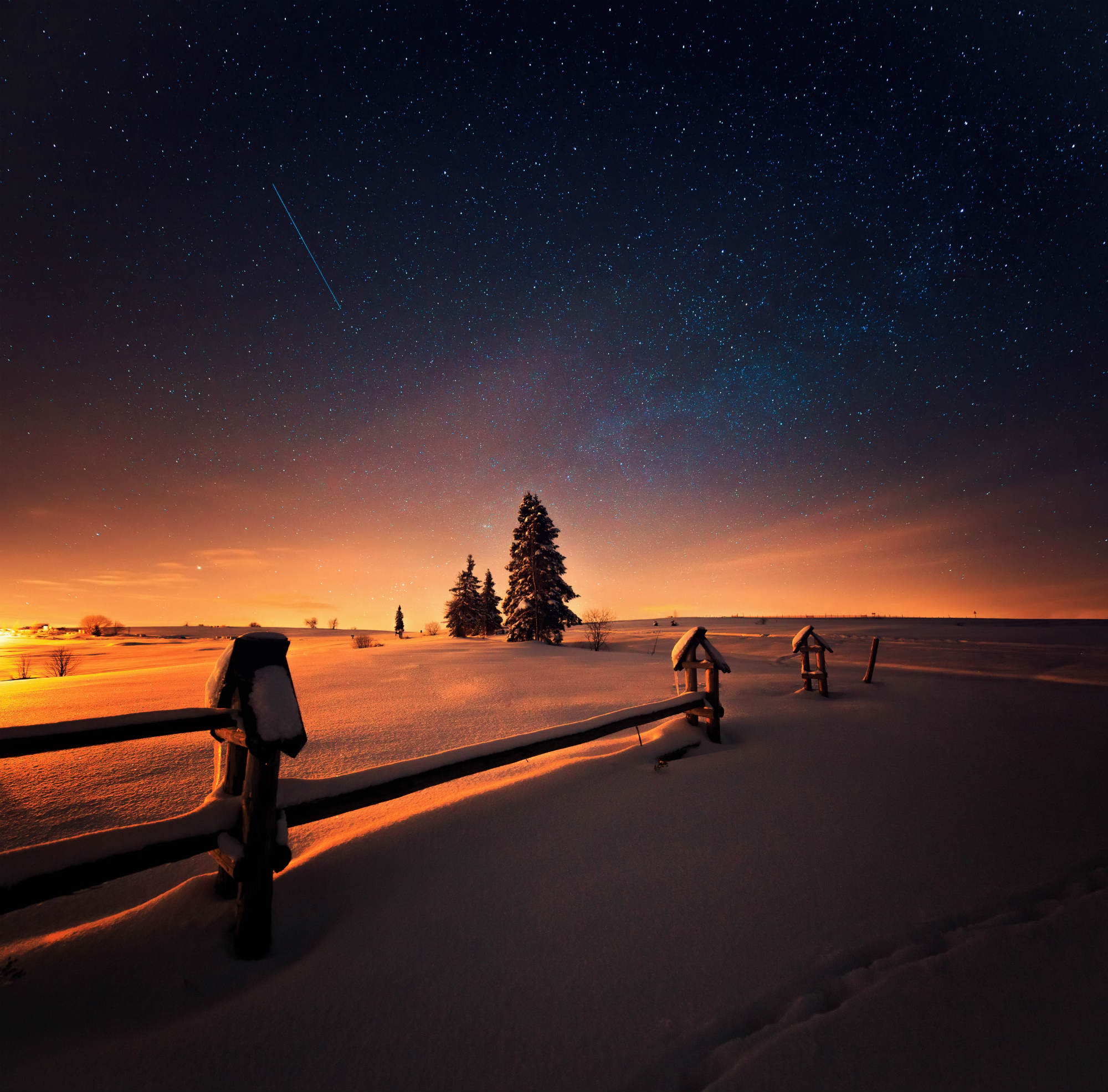
Sometimes the most difficult part of taking beautiful photos of the night sky is simply knowing where to begin.
That's where this tutorial comes in...
With the quick and easy tips outlined below, you'll get the pointers you need to start taking better shots of the stars sooner rather than later.
Let's get started!
Editor's Tip: Before you can take the best photos, you need the right astrophotography gear. Get geared up.
Use a Wide-Angle Lens
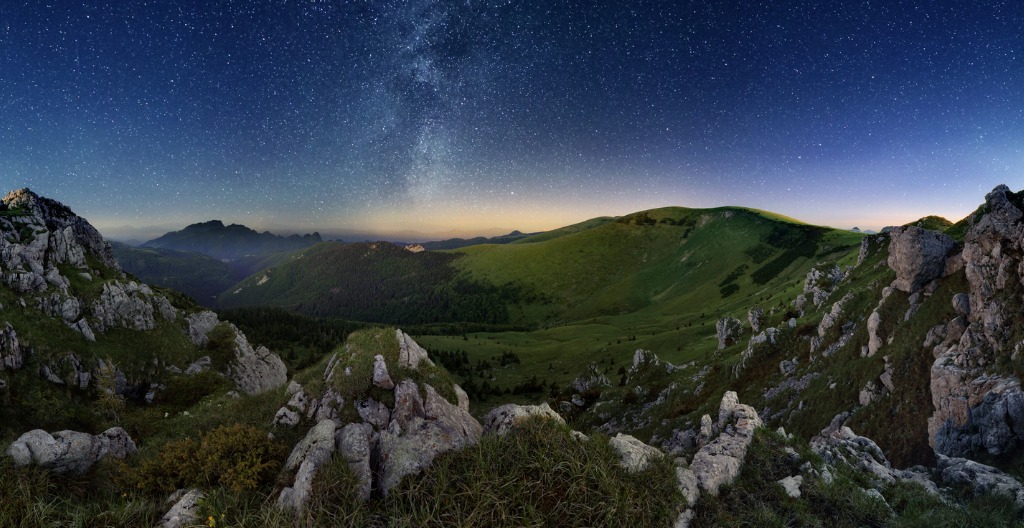
The wide angle of view afforded by a wide-angle lens means that you can incorporate more of the night sky into your photos, as well as the landscape beneath them.
Though you don't want to overwhelm the shot with too much detail, it's nice to be able to include elements that give the photo depth and context.
For example, in the photo above, the use of a wide-angle lens allowed the photographer to include much more foreground interest. That, in turn, gives the shot excellent dimension and depth.
Quick Tip: If you're in the market for a solid wide-angle lens, a 24mm f/1.4 is tough to beat.
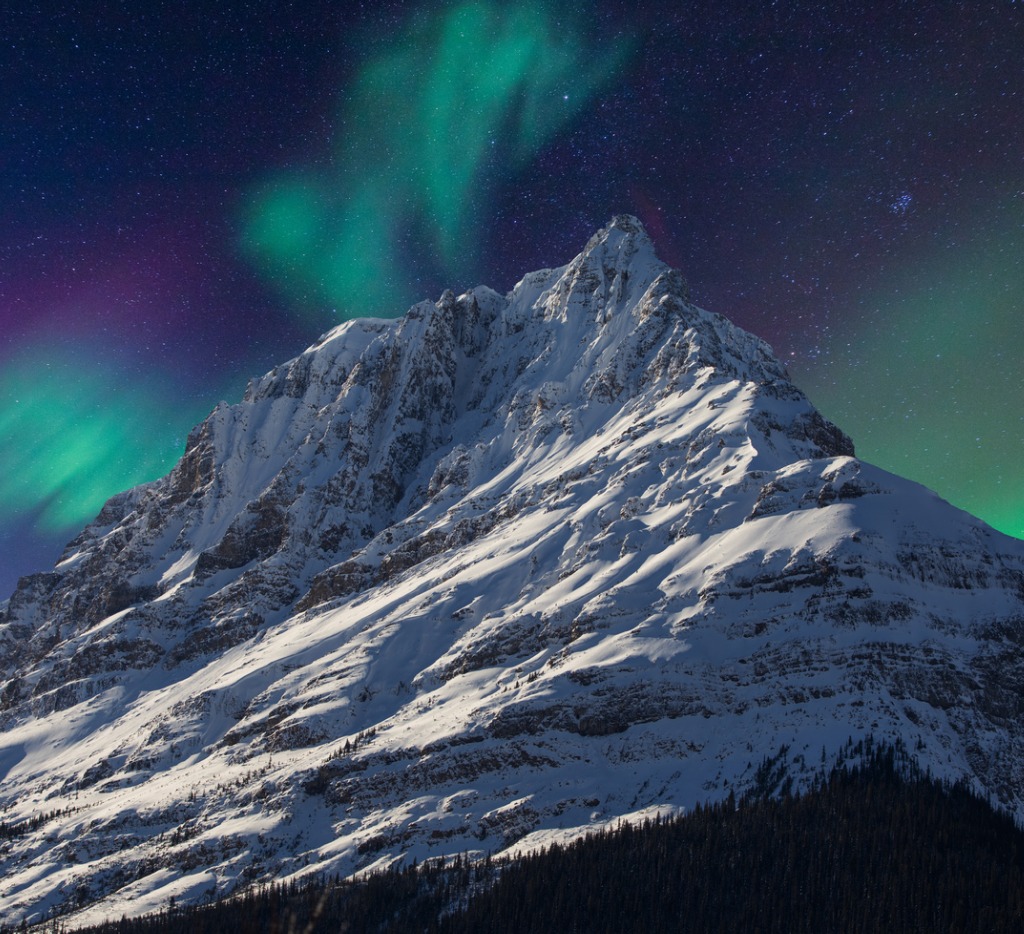
But as with any photography rule of thumb, you have to be willing to make exceptions.
Just because wide-angle lenses are great for this type of photography doesn't mean that you can't try other types of lenses.
As you can see above, a tightly-framed shot with a telephoto lens can produce gorgeous results as well.
Learn More:
Use the 500 Rule for Sharp Stars (or Get a Star Tracker Mount)
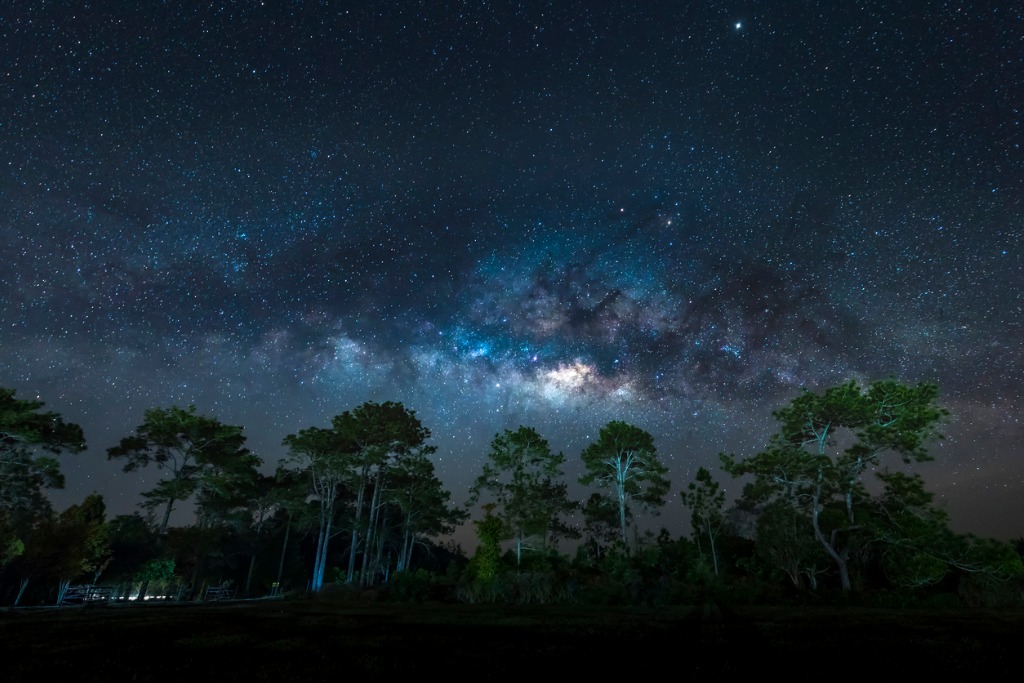
To get clear, pinpoint stars like those that you see in the image above, you have to figure out what shutter speed you can use without getting star trails.
The 500 rule stipulates that if you divide 500 by the focal length of your lens, that you'll get an exposure time that will get you pinpoint stars.
So, using our recommended 24mm lens, the equation would be: 500/24 = 20.83.
That means that with a 24mm lens, you can dial in a shutter speed of up to about 20 seconds and still get sharp photos.

An even easier way to get pinpoint stars is to use a star tracker mount, like the Vixen Polarie shown above.
This rig is purpose-built to help you get high-quality photos of the night sky because it's incredibly easy to setup and use.
Just mount the Polarie to any standard tripod, and in turn, mount any camera weighing up to seven pounds to the Polarie.
Then use the included compass to orient the mount to face north or use a polar scope for alignment.
Once the Polarie is in position, it will track the movement of the stars across the sky for you. That means you get pinpoint stars without having to mess about with the 500 rule!
Editor's Tip: It's easy to get pinpoint stars. Find out how right here.
Use a Remote or the Camera's Self-Timer
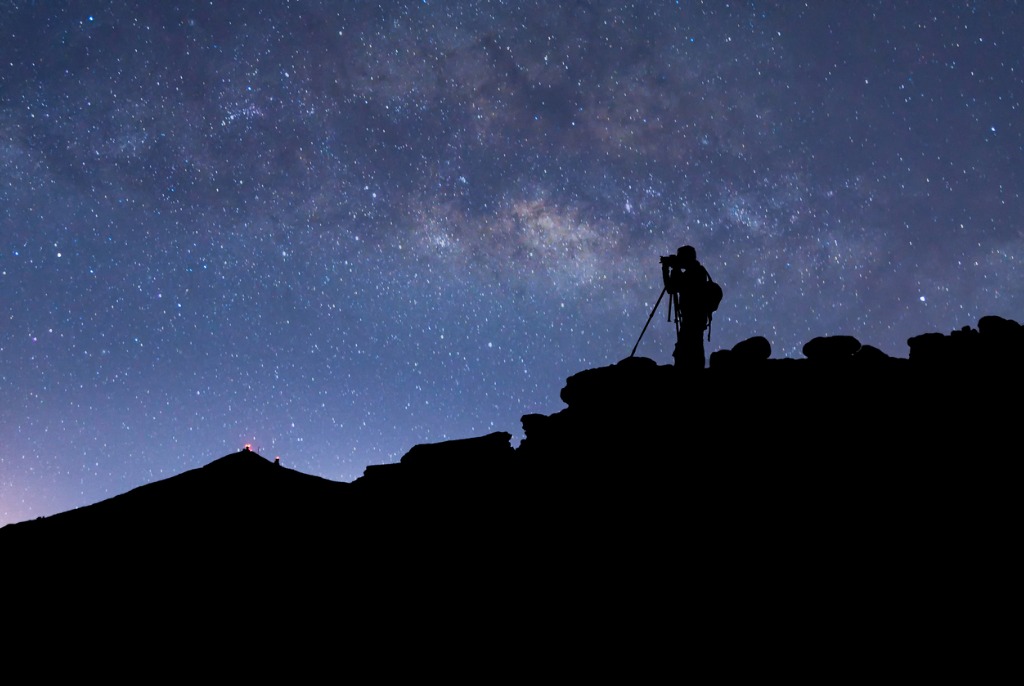
Since you need long exposures to get photos at night, that means that your camera is susceptible to camera shake.
Camera shake occurs when the vibrations you cause by pressing the shutter button result in a blurry photo.
If you remove that element of touching the camera from the equation, you'll get sharper photos as a result.
Just about every camera has a built-in timer that allows you to select from a variety of short delays.
Even a two-second delay should be enough time to let any vibrations calm down before the shot.
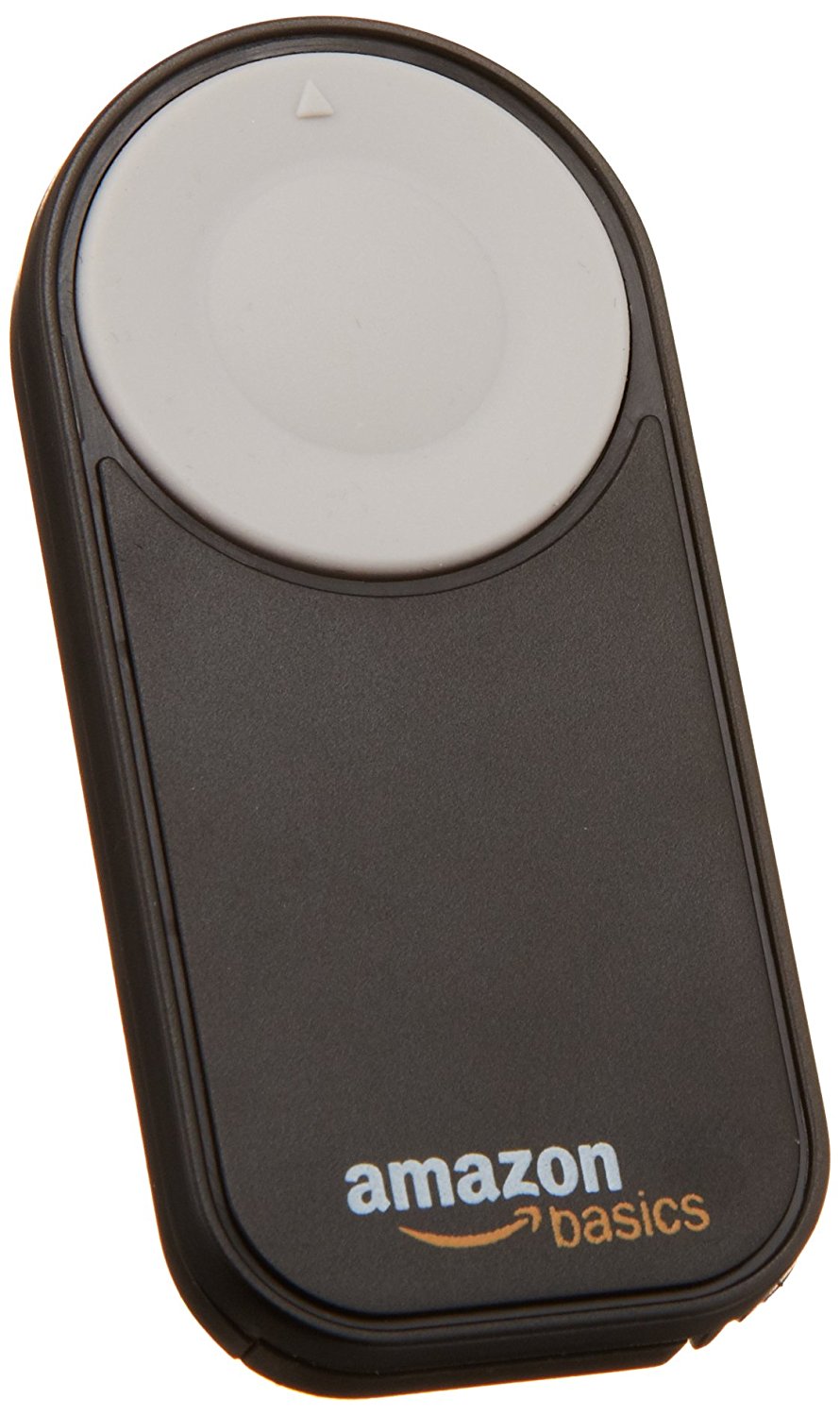
But for better results, it's best not to touch the camera at all.
Do do that, you need a camera remote.
You can pick up inexpensive remotes for less than $10 on Amazon, so it's not a huge investment of money to get one.
Even if you opt for something a little more spendy, the results will be worth it!
Editor's Tip:
Final Thoughts
As I noted in the introduction, sometimes all you need to get going are a few simple tips.
The tips outlined above will get you started on the right foot and help you get improved photos of the night sky.
For additional tricks to improve your astrophotography, check out the video above by Mango Street.
In addition to the instructions I've provided above, they offer hints on how to focus your shots, get sharper images, and camera settings to use, among other things.
We Recommend
Take Better Photos of the Stars With These Quick Tips
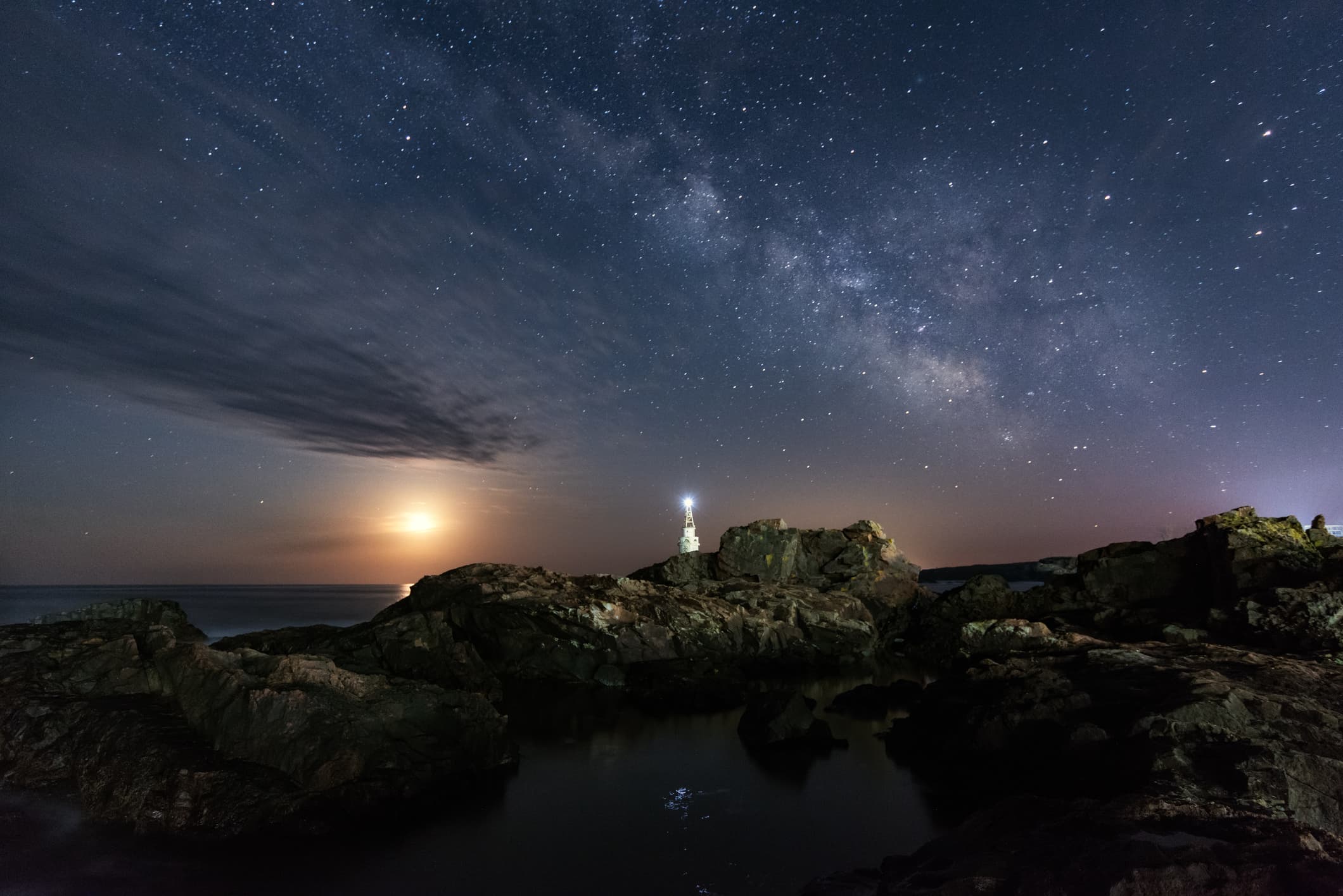
If you ask me, the night sky is one of the most beautiful subjects you can photograph.
The problem is conveying that beauty in the photos you take - it's a process that can be easier said than done at times.
However, astrophotography doesn't have to be overly complex or intimidating.
In fact, there are a number of quick and easy ways you can improve your photos of the stars.
Use a Fast Lens
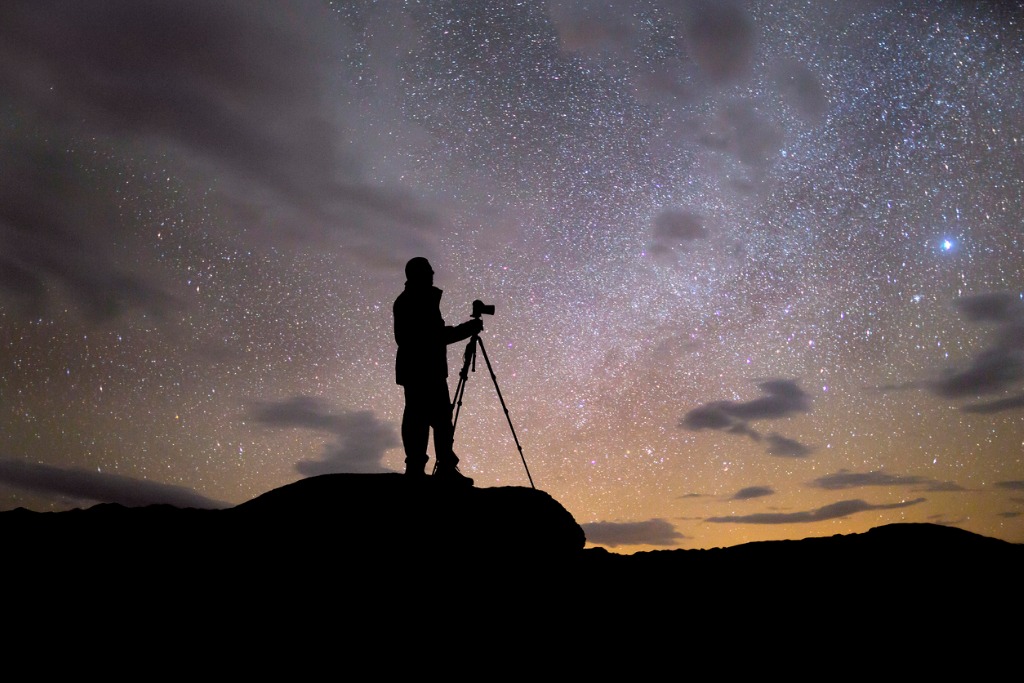
A photography term that causes a lot of confusion for beginners is "fast lens."
Though a "fast lens" might indicate that it can achieve very quick shutter speeds, the term actually refers to the lens's aperture.
That is, a very wide aperture, like f/1.2, opens the aperture blades and lets in tons of light.
Since the lens can collect so much light, that means you can use a faster shutter speed in return, thus the term "fast lens."
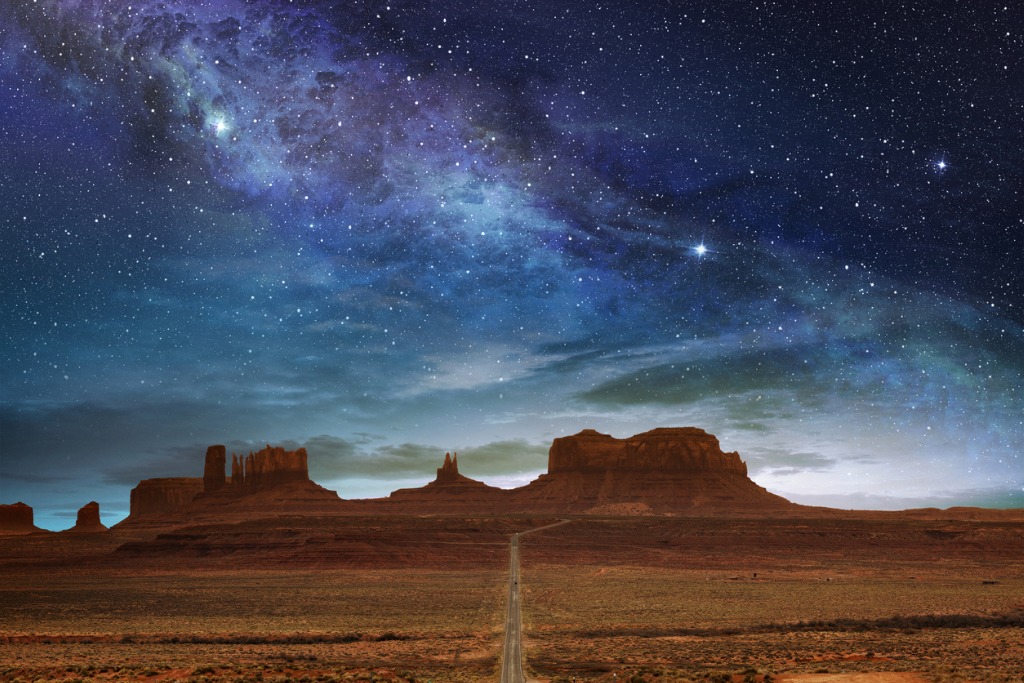
But a fast lens offers you further benefits as an astrophotographer.
For starters, the large aperture opening allows your camera to capture light from even the most distant stars. The result is a sky full of twinkling light.
Additionally, a fast lens allows your camera to capture that light in a shorter period of time, which helps in eliminating star trails (more on that next).
A standard kit lens opens up to f/3.5 at its shortest focal length, and you can get adequate results with that.
But if you really want to improve the lightness and brightness of the starry sky, upgrade to a lens with a larger aperture like f/2 or f/1.8 at the least.
Learn More:
Get a Star Tracking Mount
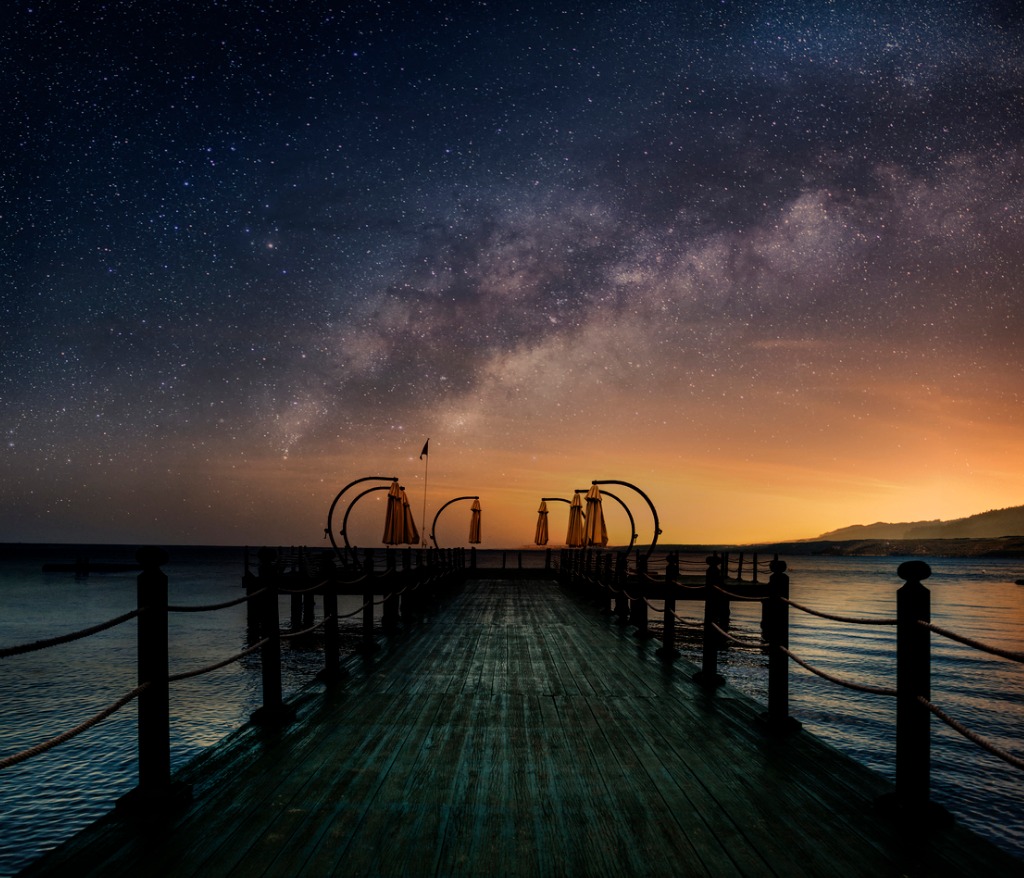
As noted in the previous section, a fast lens helps eliminate star trails, resulting in photos like the one above in which you see tack-sharp, pinpoint stars.
But to really make that a possibility, you need a star tracking mount.
The Polarie Star Tracker Mount shown below allows you to orient your camera to the north, and once set, it will track the motion of the stars as they move across the night sky.

But don't think that that's the only advantage of a star tracking mount...
Mounts like the Polarie are quick to setup - it attaches to a standard camera tripod and accepts any digital camera that weighs up to seven pounds.
Heck, you can even use it with your smartphone!
Additionally, the Polarie is easy to use, too. You can orient it to face north with the included compass, the North Star alignment window, or you can use it in conjunction with a polar scope for alignment as well.
In other words, this rig has all the features you need to step up your astrophotography game.
But don't take my word for it - check out the video above for sample images captured when using a Polarie.
Learn More:
- Get the Specs and Pricing on the Polarie Star Tracker Mount
- How to Compose a Killer Shot of the Night Sky
Processing Your Images is a Must
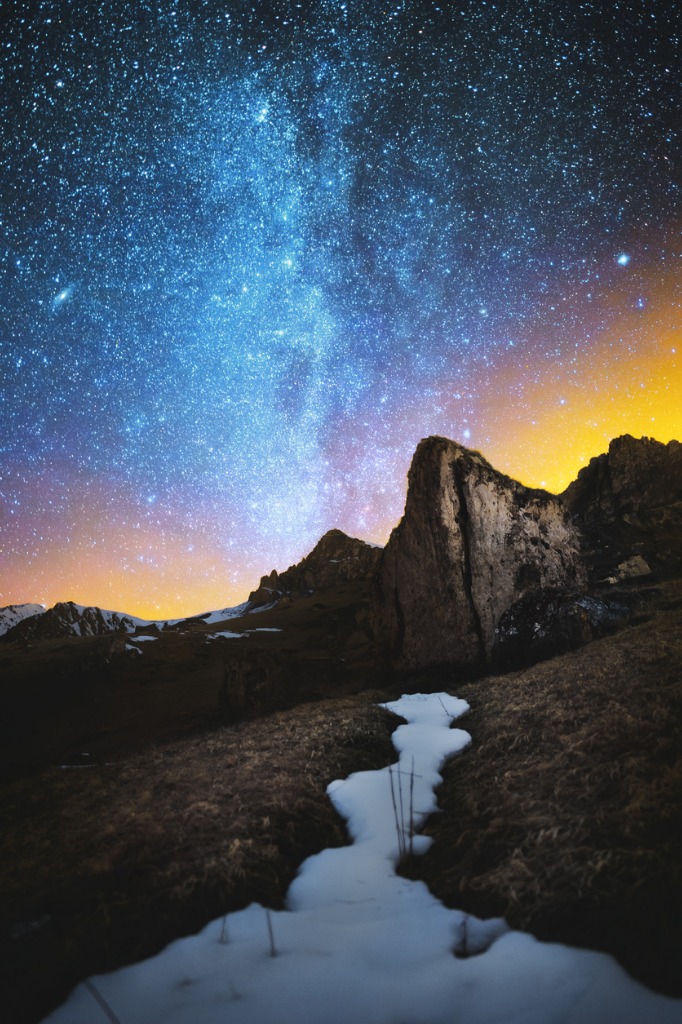
The raw, untouched images captured by your camera can be quite impressive, especially if you've put in the time and effort to plan your nighttime photo shoot and compose your images to have maximum impact.
However, even the nicest looking untouched images can be brought to life with post-processing.
Using a program like Photoshop or Lightroom, you can fine-tune your photos of the night sky such that the light of the stars pops.
Likewise, you can make adjustments to levels, curves, white balance, contrast, and so forth to give your images a more vibrant and colorful appearance.
You can even use post-processing programs to create panoramas, focus stack images, and other complex tasks.
For a beginner's tutorial on Photoshopping your photos of the night sky, check out the video above by AstroBackyard.
And with that, you have three rock-solid and easy tips to integrate into your astrophotography workflow that will help you maximize the visual appeal of your photos of the stars.
Learn More:
- These Common Astrophotography Mistakes are Holding You Back
- How to Photograph the Milky Way (in Simple English)
We Recommend
The Best Cameras for Beginner Astrophotographers
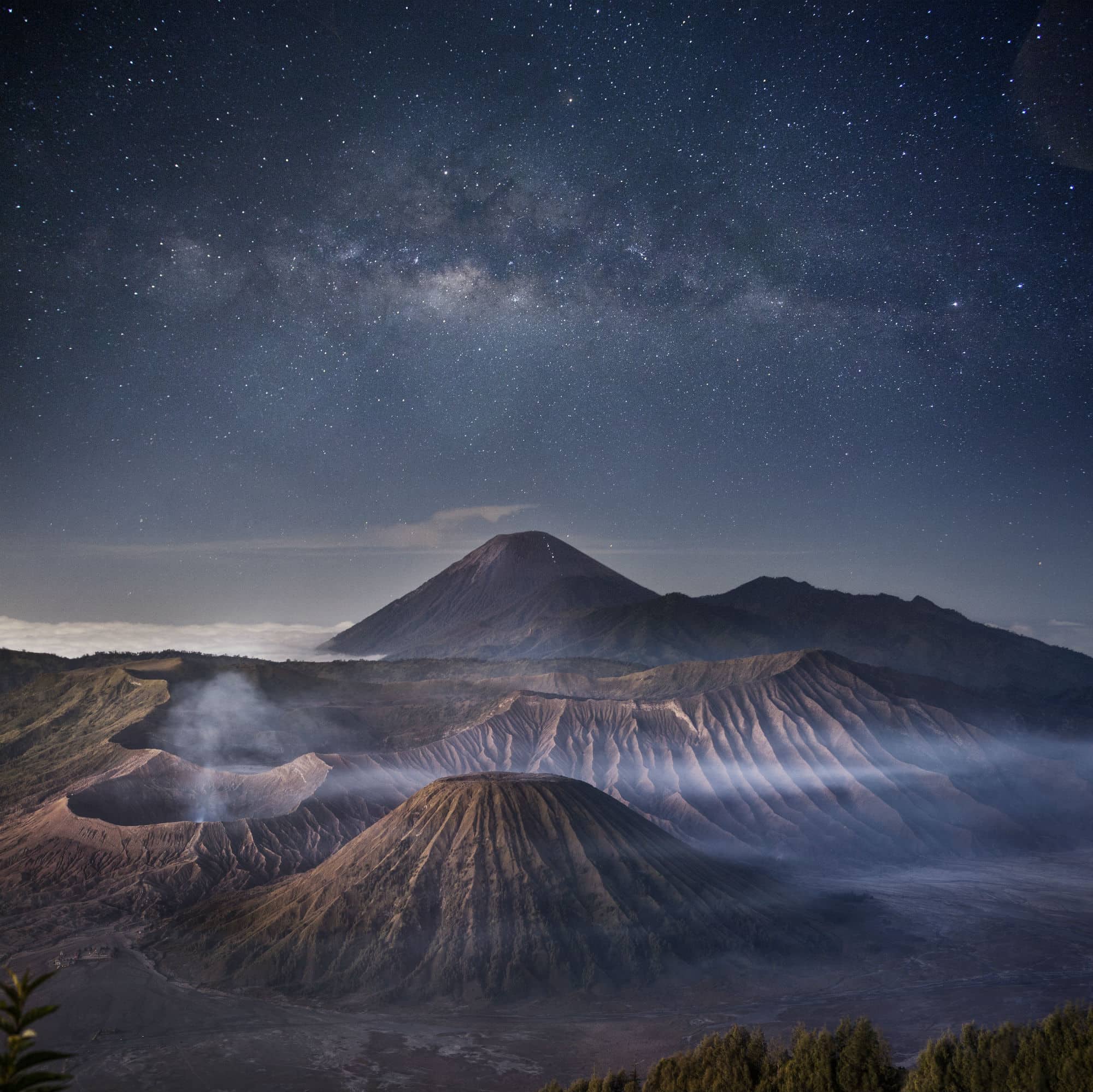
When getting outfitted with a camera for astrophotography, some beginners look at things like price above all else.
And while your budget is certainly an important consideration, so too are the features the camera offers for maximizing your ability to get high-quality nighttime shots.
With that in mind, I've put together this quick overview of some of the features to look for as well as a short list of the best cameras for beginner astrophotographers.
ISO Performance
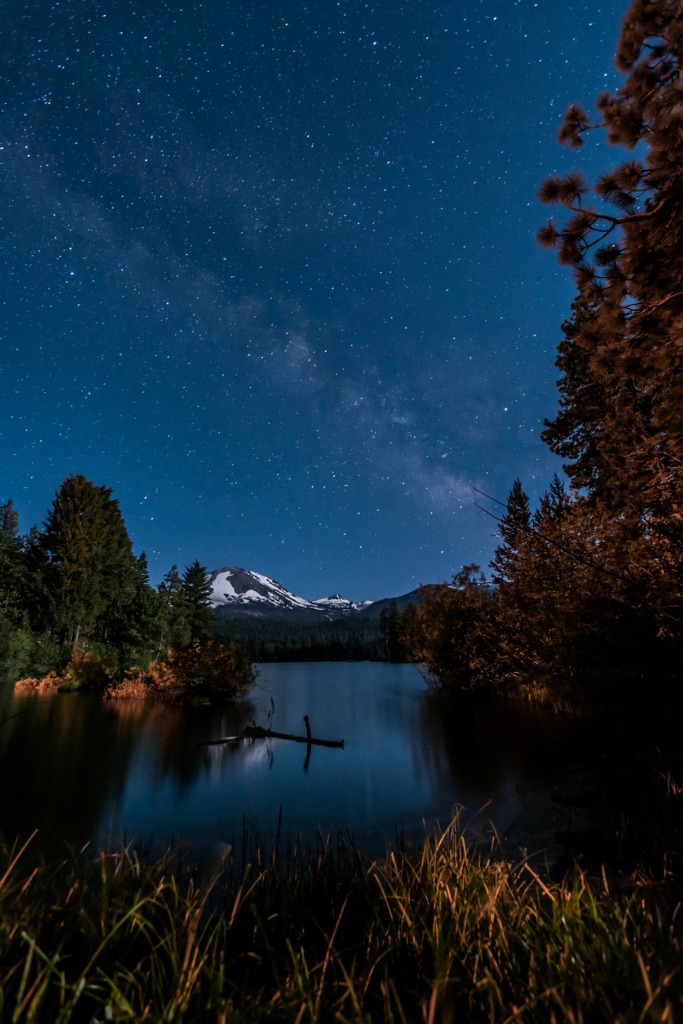
A good astrophotography camera needs to have certain functionalities in order to get you the results you want.
Primary among them is good ISO performance, which needs to be considered on two different points.
First, the camera needs to have a high ISO range, that way you can increase the sensitivity of the sensor in the absence of light.
Many cameras today - even entry-level models - have native ISO ranges up to 12800, 25600, and even higher.
But it's important not to get caught up in just the ISO range that's available.
Instead, you need a camera that performs well at high ISOs too. That is, the camera should be able to create images at higher ISOs with minimal noise.
The less noise the camera produces, the cleaner the images will be. What's more, a camera with noise reduction further allows you to get cleaner shots even at higher ISOs.
Battery Life, Vibration Control, and Articulating LCD
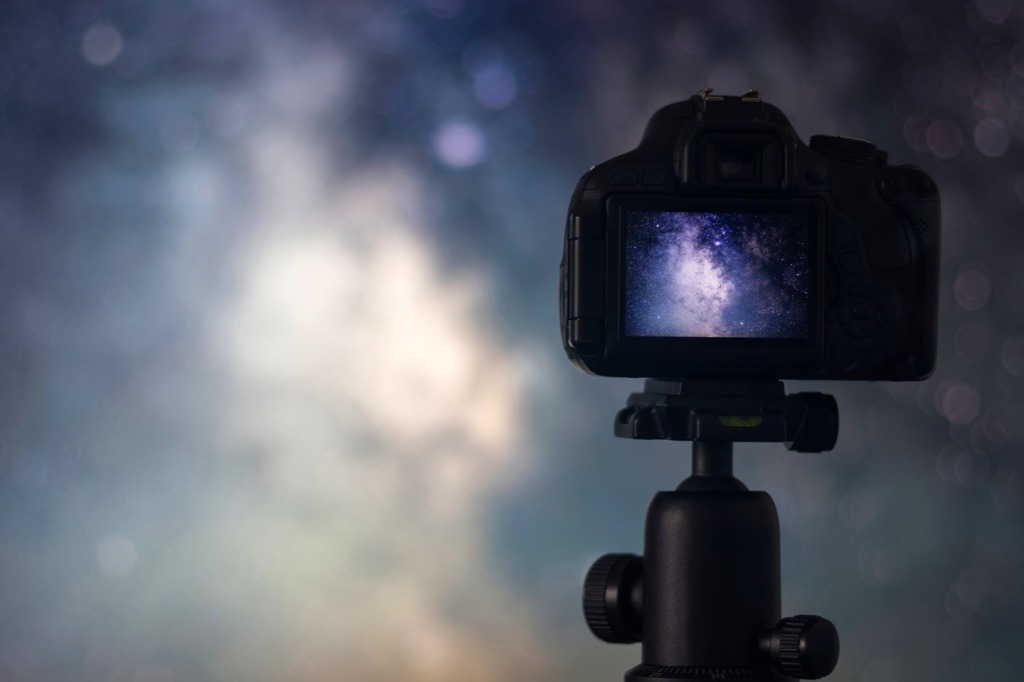
An additional feature to look for in an astrophotography camera is battery life.
Though Sony puts out some excellent mirrorless camera bodies, their battery life is notoriously short, so they aren't ideal for astrophotography.
Likewise, mirror vibration control is a handy feature to have to ensure sharper images. An articulating LCD is another feature to consider, as it enables you to more easily check your framing and composition, even when the camera is positioned at a steep angle towards the sky.
Editor's Tip: A crucial accessory for astrophotography is a solid tripod to give your camera a stable base. Shop for high-quality astrophotography tripods and other accessories at MrStarGuy.
Construction
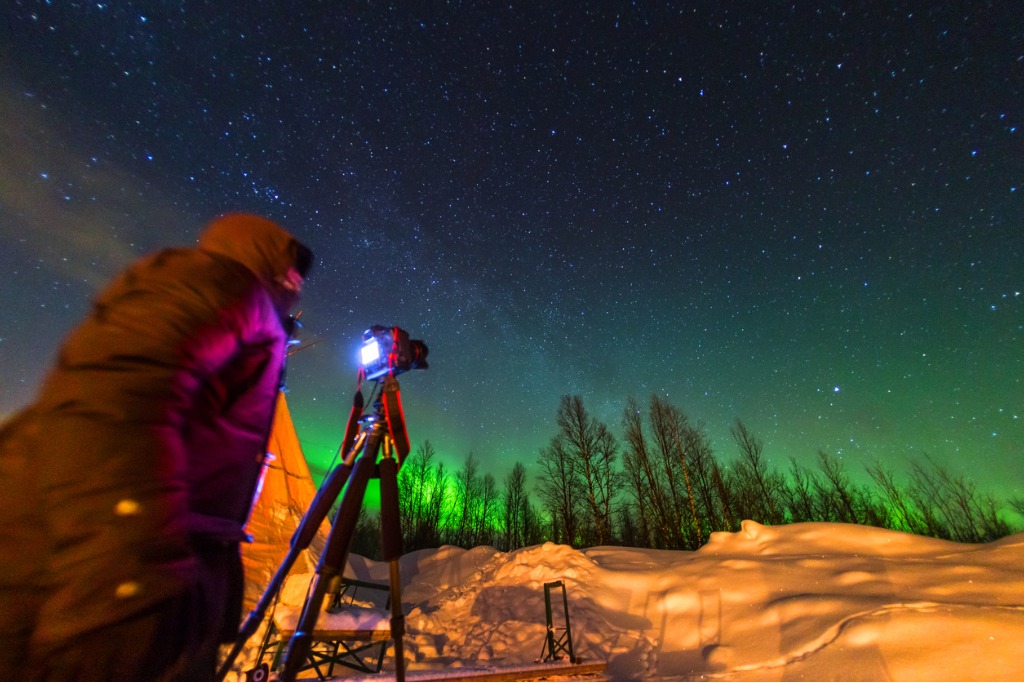
The build quality of the camera is another factor that you must consider.
First, you don't want to spend hundreds and hundreds of dollars on a camera that isn't built to last. Granted, your camera won't be with you forever, but you want it to be constructed such that you get five or more years of good use out of it.
Second, since astrophotography is a night pursuit and requires you to be outdoors for long periods of time, you want a camera that can stand up to cold temperatures and inclement weather like rain or snow.
That means looking for a camera body that's weather-sealed to protect it against the elements.
Learn More:
Suggested Cameras for Astrophotography
There is a long, long list of cameras that are well-suited for photography out of the box, or are good candidates for astrophotography.
However, I've narrowed the list down to three models, each at a different price point. All three offer good ISO performance, low noise for long exposures, great battery life, and good build quality.
For Big Budgets: Nikon D810
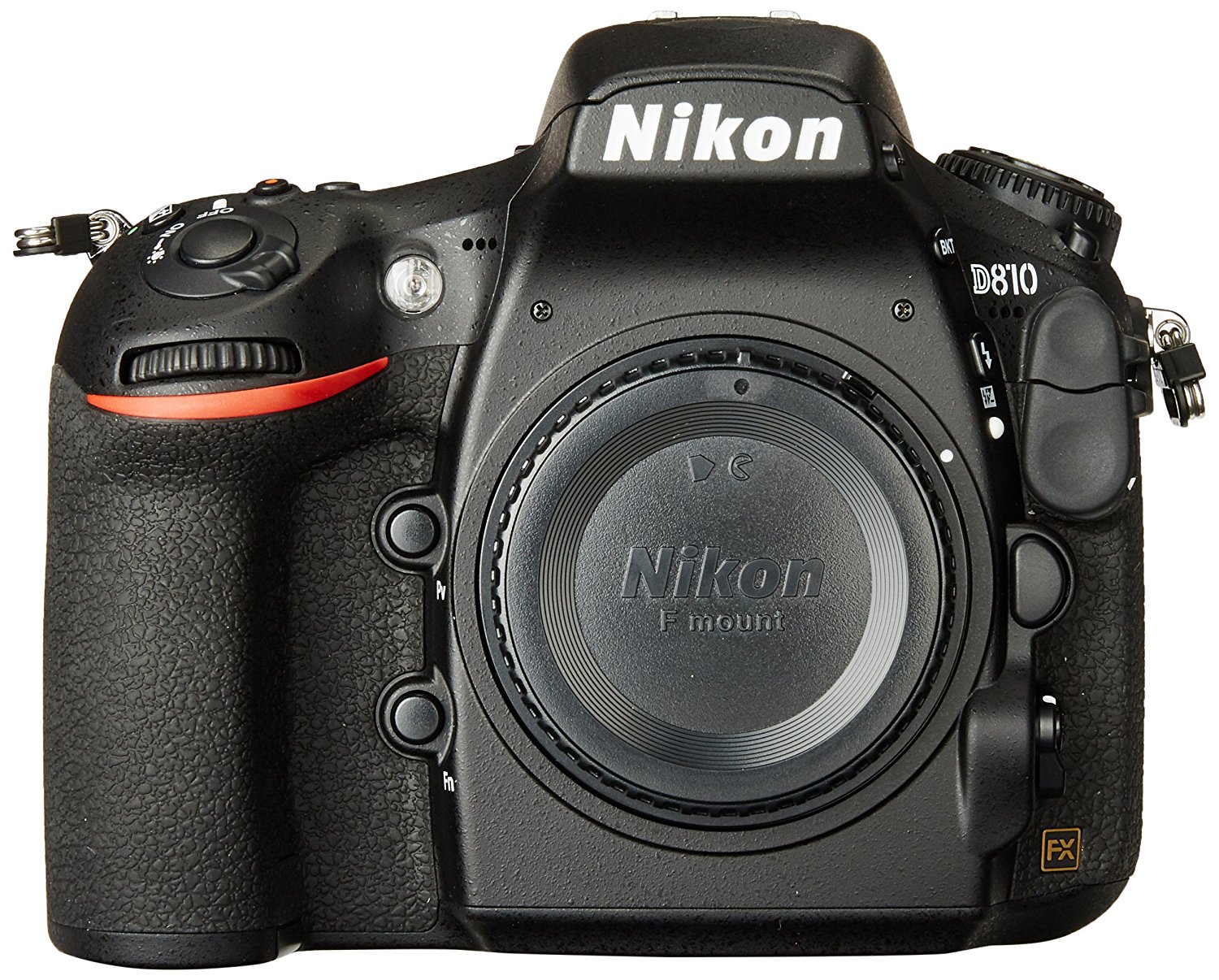
Though the Nikon D810 has since been replaced by the Nikon D850, it's still an excellent camera, and now that it's an older model, it can be found much cheaper, too. As of this writing, a new Nikon D810 runs around $2,800 for the body, compared to around $3,300 for a D850.
It's a full frame camera, which means it has a larger sensor and has improved low-light performance that translates into photos that are cleaner with less noise.
Other specs include:
- 36.3-megapixel full frame CMOS sensor
- Native ISO to 12800 (expandable to 51200)
- 3.2-inch LCD with 1.229-million dots
- 51-point autofocus systemWeather-sealed body
Nikon also makes a D810a, which is specifically designed for astrophotography.
The D810a's sensor is more sensitive to H-alpha red tones by a factor of 4, meaning it can capture celestial bodies like nebulae with much more sharpness, detail, and dynamic range.
It has an electronic front curtain shutter as well, which helps eliminate vibrations. This is especially handy when taking long exposures.
That being said, a normal Nikon D810 will be more than sufficient for a beginner astrophotographer.
Learn More:
For Mid-Range Budgets: Canon EOS 6D
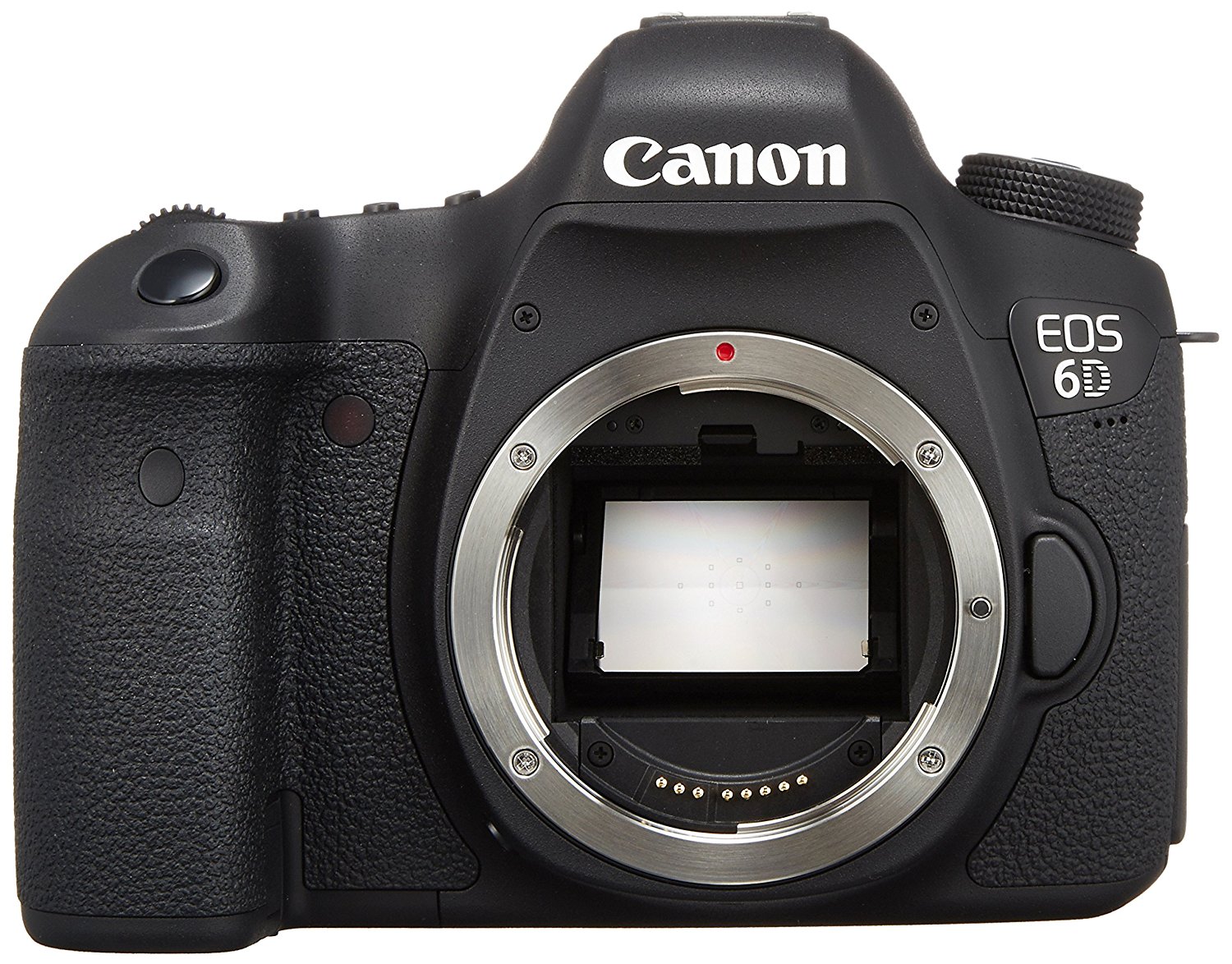
Like the Nikon D810, the Canon EOS 6D is an older full frame camera with excellent low-light performance that you can find brand new for around $1,000.
For that price, you get just about all the must-have features you need for astrophotography, including:
- 20.2-megapixel full frame CMOS sensor
- Native ISO to 25600 (expandable to 102800)
- 3-inch LCD with 1.04-million dots
- 11-point autofocus system sensitive to -3EV
- Weather-sealed body
Clearly, the 6D's sensor isn't quite what the D810 offers, and its LCD isn't quite as large or resolute. However, for $1,800 less than the D810, you get a full frame sensor, a huge expanded ISO range, and a weather-sealed body.
The 6D also has built-in Wi-Fi and GPS, an electronic level to help you get the horizons perfectly straight, and a DIGIC 5+ image processor that makes quick work of in-camera processing tasks.
Learn More:
For Budget-Minded Buyers: Pentax K-S2
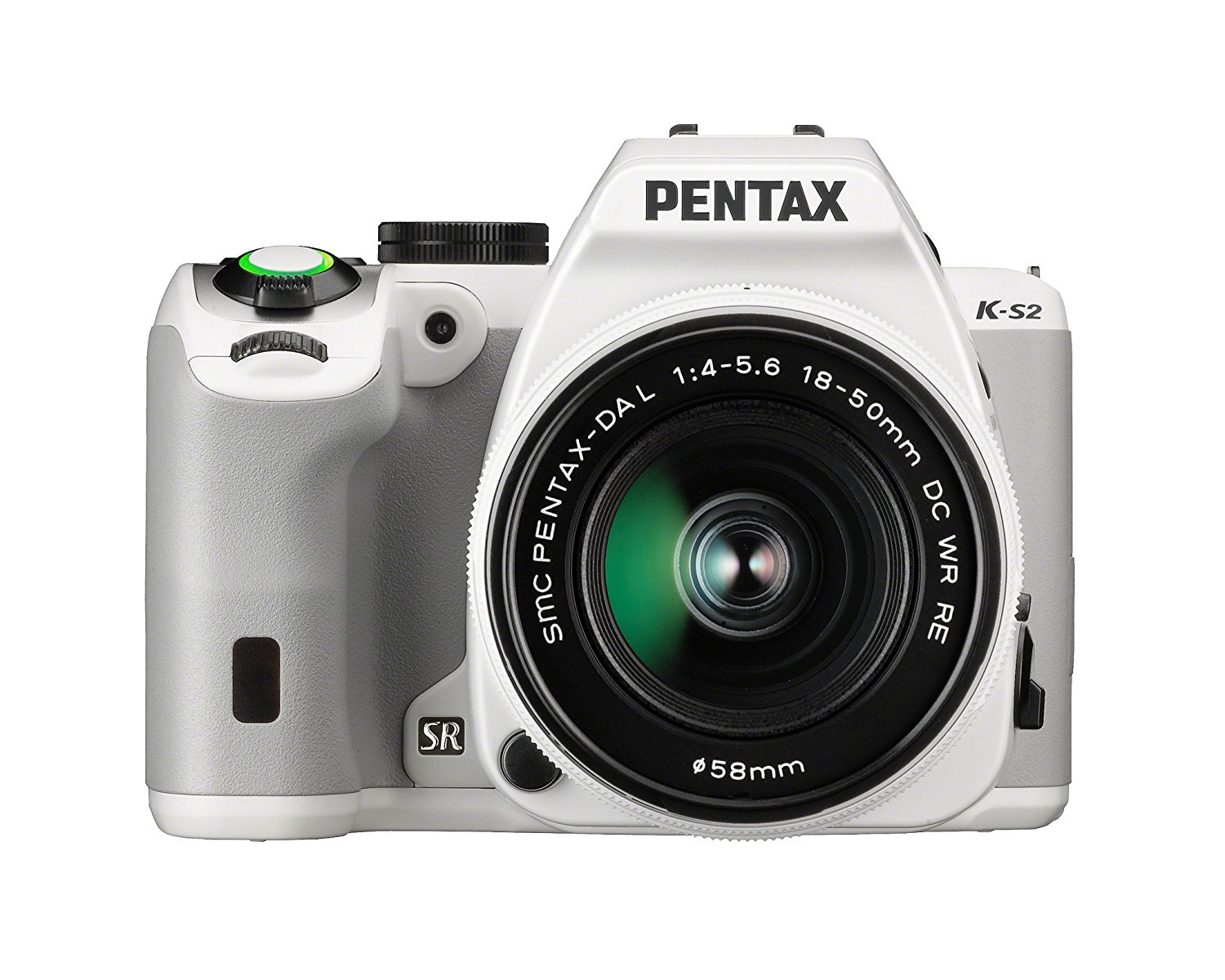
An excellent budget-friendly option for astrophotography is the Pentax K-S2.
Unlike the previous two recommendations, the K-S2 is a crop sensor camera, meaning it has a smaller sensor than the D810 and 6D.
However, the Pentax lacks an anti-aliasing filter, which results in sharper images. It also has excellent ISO performance, with the highest native ISO capabilities of the bunch.
Additionally, the Pentax features:
- 20-megapixel APS-C CMOS sensor
- Native ISO to 51200
- 3-inch fully articulating LCD with 921,000 dots
- 11-point contrast-detect and phase-detect autofocus system
- Weather-sealed body
Furthermore, because the K-S2 is a crop sensor camera, it weighs less and has a smaller form factor than the other two cameras on this list.
That could be a bonus for photographers that want something that's easier to carry or who are looking for a camera that can pull double-duty as a small, yet capable everyday camera.
Learn More:

Editor's Tip: No matter what camera you use, maximize your ability to capture gorgeous photos of the night sky by using an astrophotography mount like the Vixen Polarie. Compatible with any camera that weighs up to seven pounds, the Polarie will track the motion of the stars to eliminate star trailing. It's also easy to use and setup and is designed to function in most weather conditions. Learn more about the Vixen Polarie Star Tracker Mount.
We Recommend
These Common Astrophotography Mistakes are Holding You Back
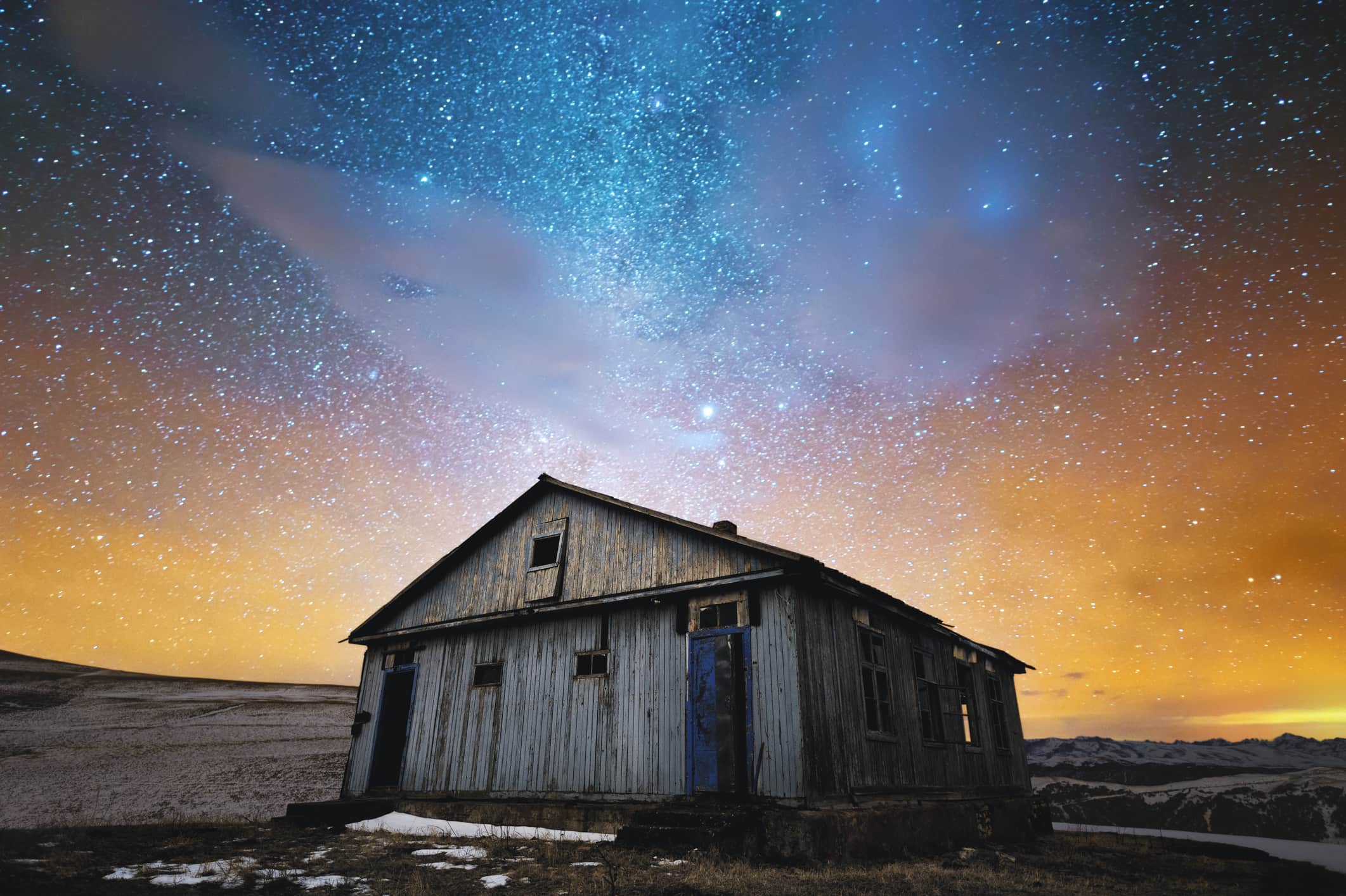
Let's face it - photography is difficult to master.
And astrophotography, well, that's a tough cookie, too.
But just because it's difficult doesn't mean that with practice you can't master the art of photographing the night sky.
There are some common astrophotography mistakes to avoid, however, if you're going to reach your potential.
Editor's Tip: Part of becoming a master astrophotographer is having the proper tools. We highly recommend MrStarGuy for all your astrophotography needs. With a wide selection of telescopes, tripods, mounts, and other accessories, it's your one-stop shop for everything you need. Visit MrStarGuy to learn more.
Mistake #1: Forgetting to Change the Camera Settings
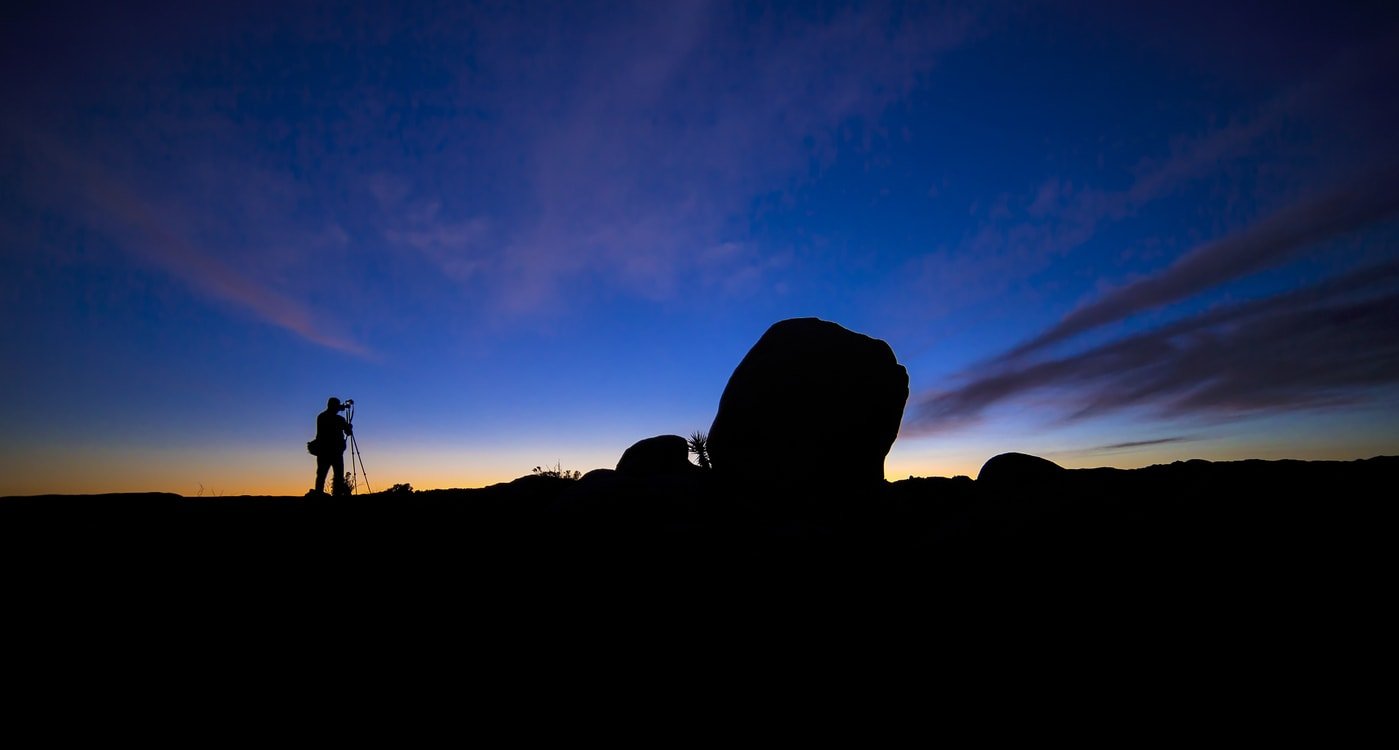
When you get your gear setup and you begin the process of framing the shot and getting it in focus, you need to use different camera settings than what you use for the actual exposure.
For example, when adjusting the focus, many astrophotographers use a very high ISO to shorten the exposure time so they can inspect the focus faster.
Unfortunately, some astrophotographers also forget to readjust the ISO for the actual shot, which renders their images too bright and full of noise.
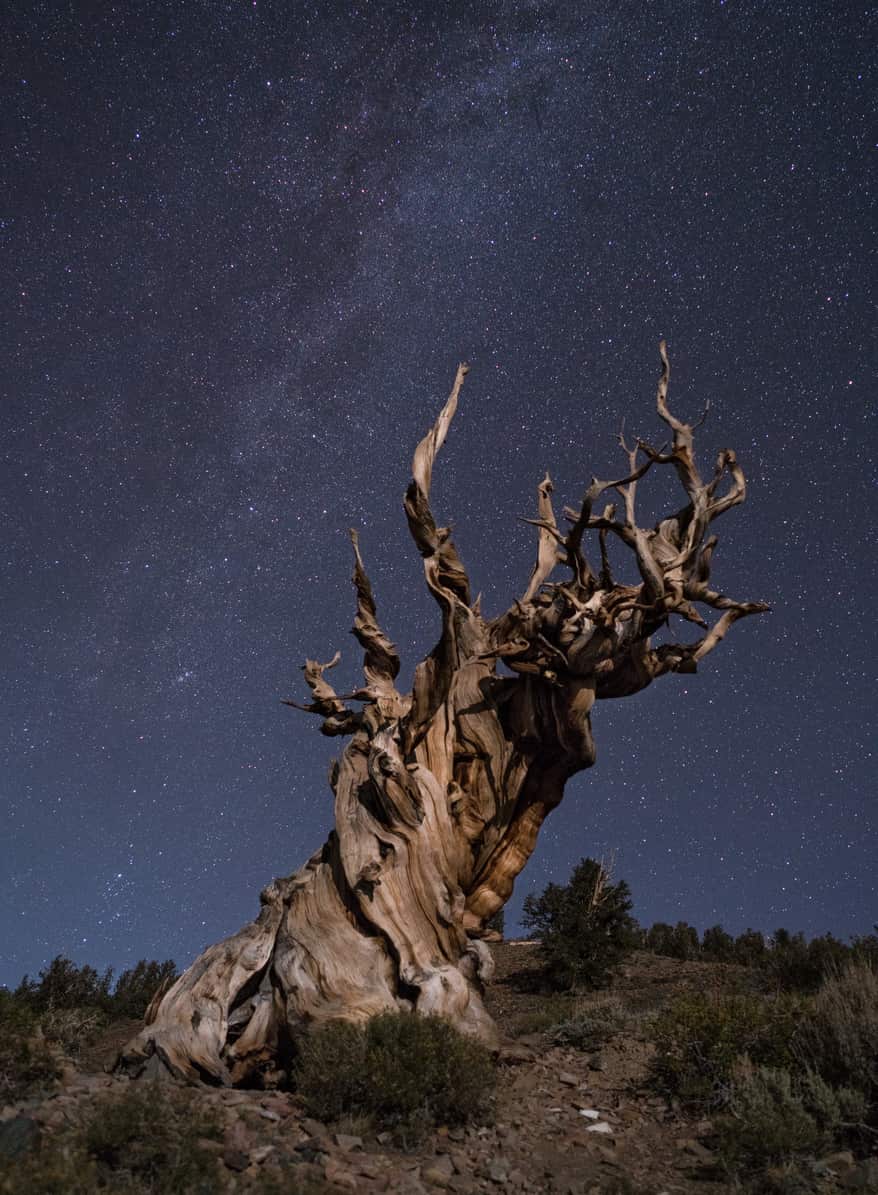
Aperture can also cause a few problems for night photography.
If you shoot during the day, you'll likely use a much smaller aperture than you'd use at night given the abundance of light during daytime hours.
But if you forget that you switched the aperture from the desired nighttime setting, the first shot you take of the stars could very well be an underexposed mess.
Though these seem like silly errors, photographers of all skill levels make them from time to time.
Just be sure that when you're setting up for your nighttime shots that you take a few seconds to get your camera settings lined out, and you'll avoid this problem.
Learn More:
Mistake #2: Not Using the Ideal Aperture
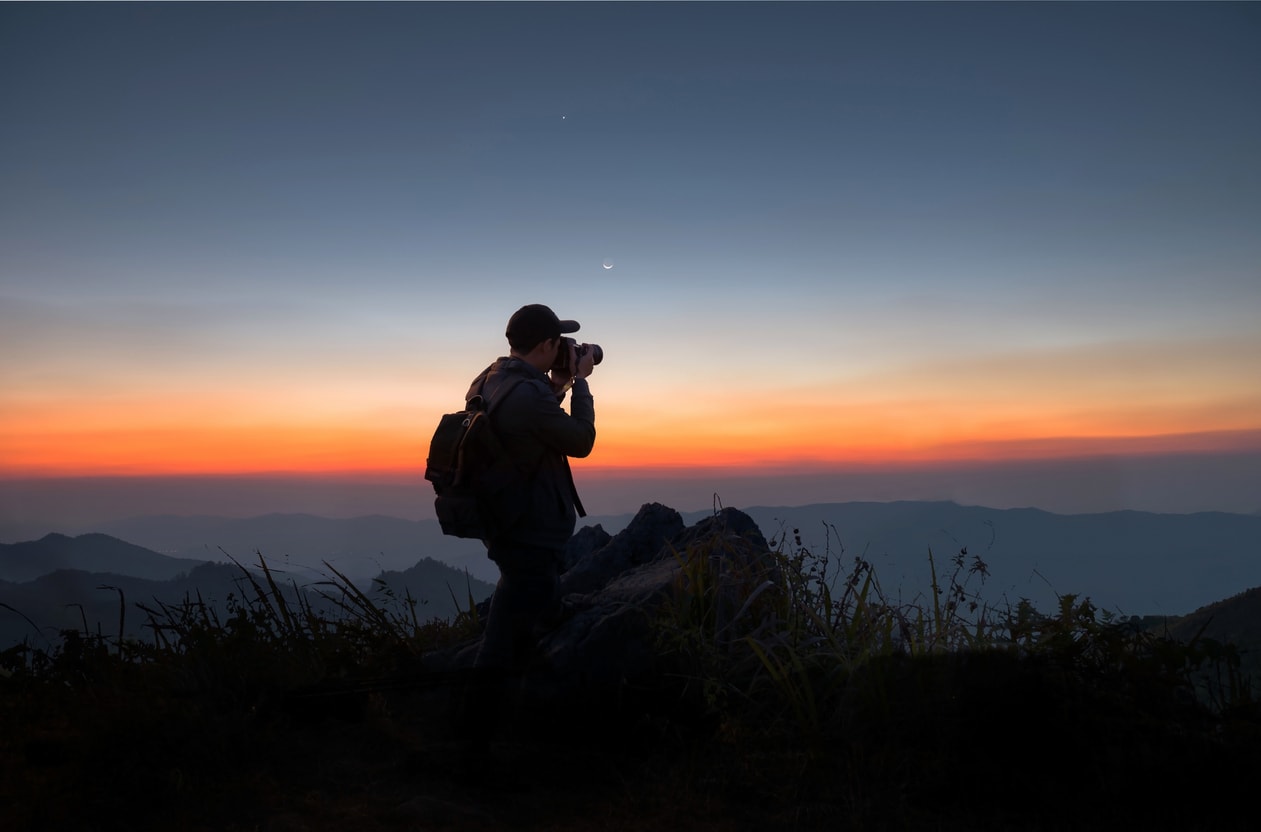
To build off the previous point, some astrophotographers mistakenly believe that using the largest aperture their lens allows will give them the best shot because it allows the most light into the lens.
The problem is that no lens performs its best at its maximum aperture.
That is, if you have a lens that opens up to f/1.4, the lens will not be able to produce as sharp an image at f/1.4 as it can at f/2, f/2.8, and so on.
All zoom lenses have a sweet spot - the ideal aperture for sharpness - which is typically around f/8 or f/11. Using that small of an aperture could create problems with the exposure of a nighttime shot, though.
So, the next best thing is to step your aperture down by one or two stops.
The reduction in light that results from doing so is a worthy trade-off for working at an aperture that gets you sharper results.

Editor's Tip: The aperture you use isn't the only factor in whether your photos of the stars are tack-sharp. To account for the rotation of the earth, you need a star tracking device like the Vixen Polarie Star Tracker (shown above), which eliminates star trails and helps you get images with gorgeous pinpoint stars. It's easy to setup, easy to use, and is compatible with any digital camera weighing up to seven pounds - including your mobile phone! Click here to learn more about the Vixen Polarie.
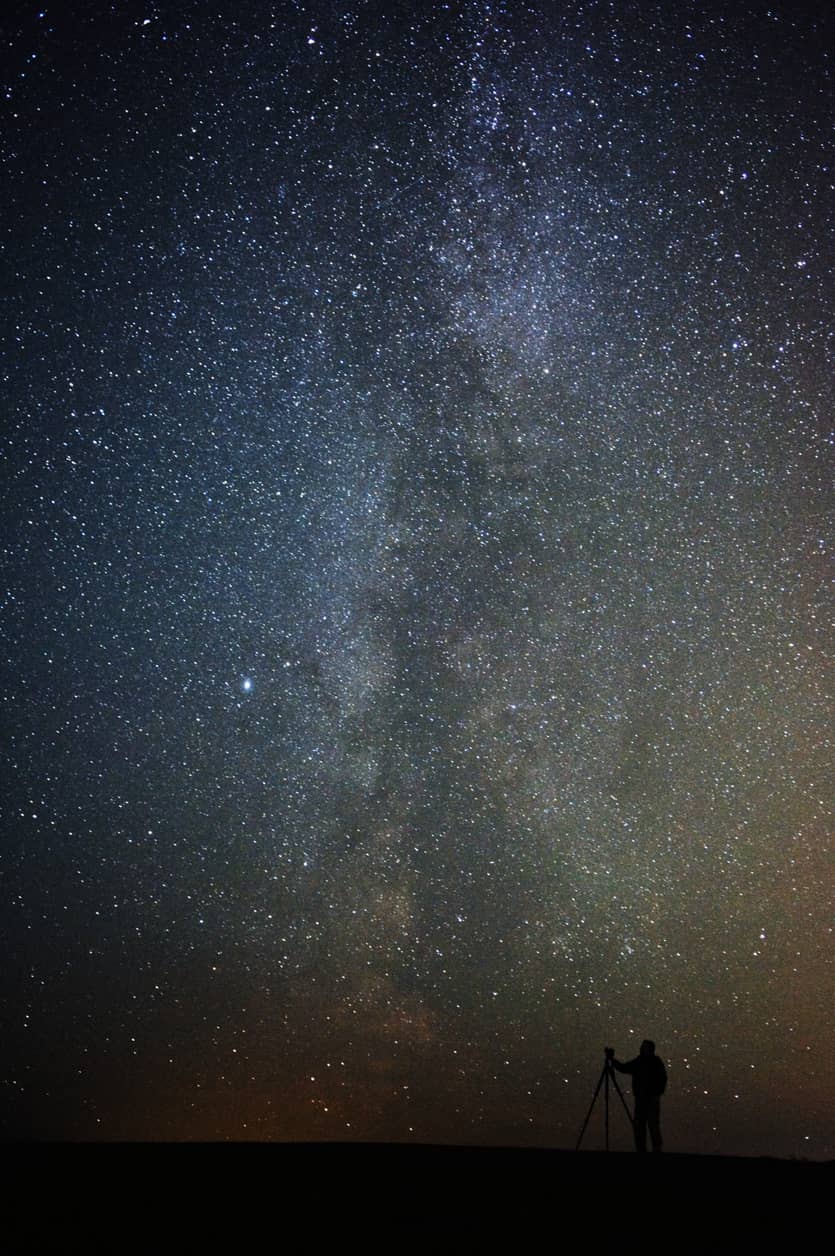
When discussing manual exposure settings for astrophotography, there are really no hard-and-fast settings because each situation is different.
However, when getting set up, consider the following as a guideline for where to start with your exposure settings:
- Shooting mode - Manual
- Aperture - f/2.8
- Shutter speed - Will vary, though you can dial in up to 30 seconds on your camera, or use Bulb Mode for longer exposures.
- ISO - 1600 or below
Again, these are not settings that will work in every situation, but it's at least a good starting point from which you can fine-tune things for your specific needs.
Learn More:
- Get Sharper Photos by Finding the Sweet Spot of Your Lens
- How to Photograph the Milky Way (In Simple English)
Mistake #3: Poor Planning
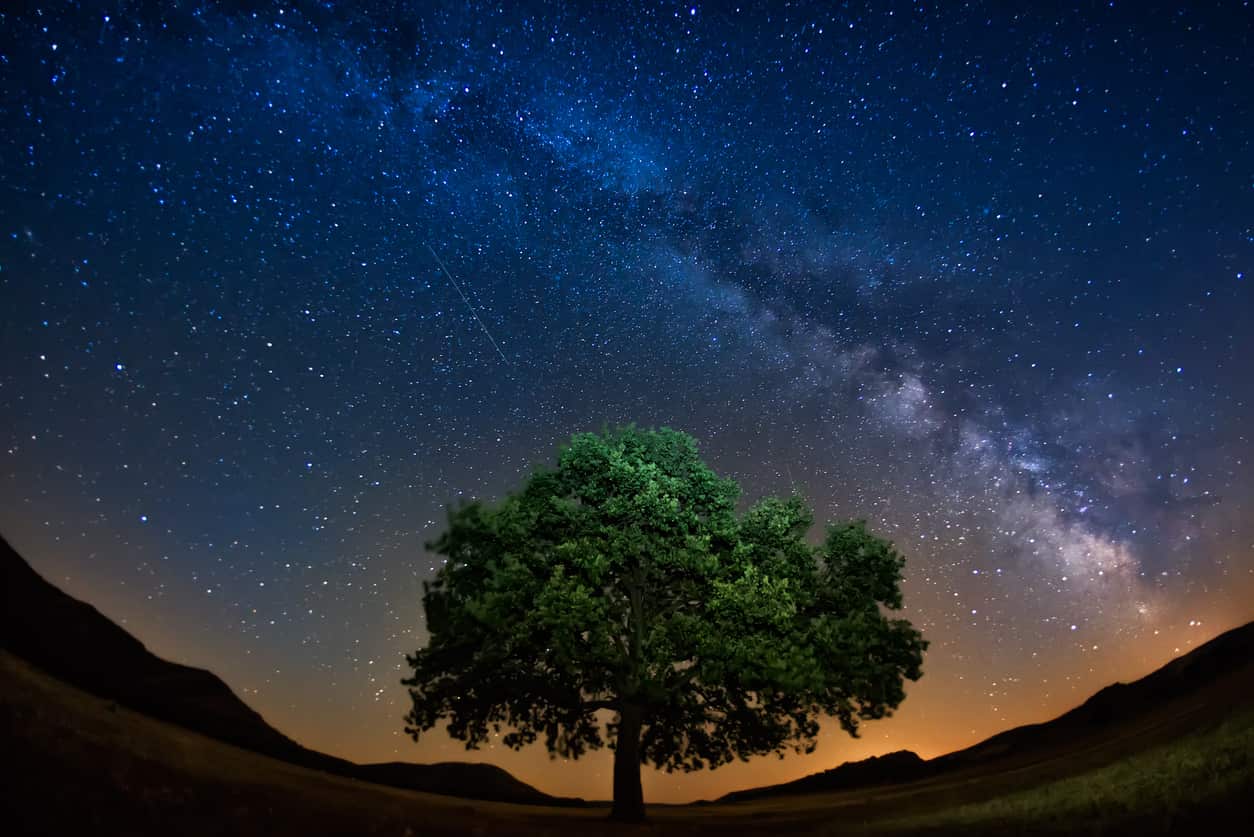
As my dad used to say, "prior planning prevents poor performance."
If you want to create the best astrophotography images, you need to be willing to invest a lot of time and effort into the process, especially the part where you plan things out.
The less time you spend planning, the more time you'll spend wandering around trying to find a spot to take your photos.
What's more, if you don't take the time to actually learn how to use your gear (i.e., manually focusing your lens), then any time you save skipping those steps ahead of time will be spent getting frustrated in a dark field somewhere because you don't know what you're doing.
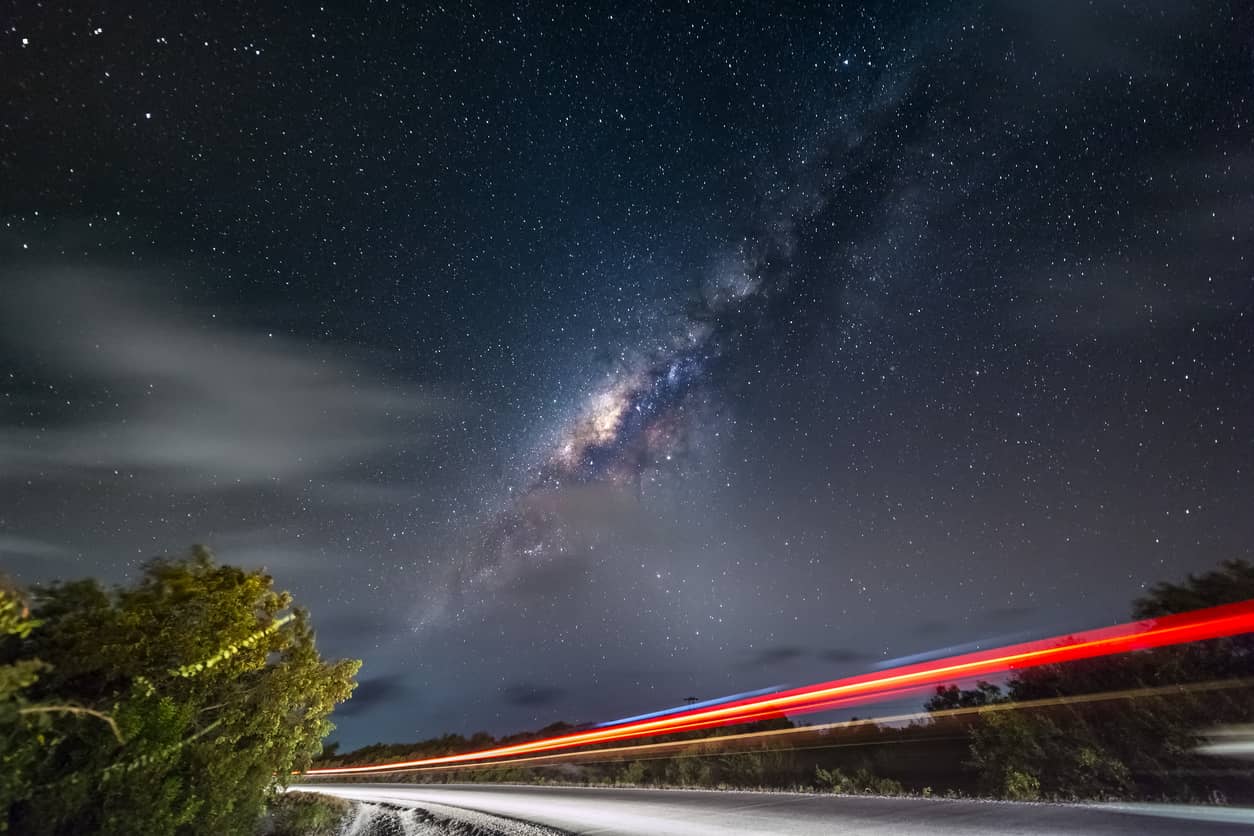
Along those same lines, if you don't understand when the sun sets, when it rises, the phases of the moon, weather patterns, and so forth, you might find yourself setting up in the dark, setting up too late to capitalize on the darkest hours of the night, or under the cover of clouds.
Naturally, none of these situations is conducive to astrophotography...
The point is that capturing gorgeous shots of the night sky isn't only dependent on your skill as a photographer and the gear you use.
Instead, a large part of your success will be determined long before you even set up your camera in the planning phase.
By having a solid plan in place, outfitting yourself with quality gear, and paying attention to your camera settings, you'll be able to minimize at least three common mistakes astrophotographers make and improve your chances of getting great shots of the stars.
Learn More:
We Recommend
These Hubble Space Telescope Photos Will Absolutely Boggle Your Mind
 By NASA, ESA, and M. Livio and the Hubble 20th Anniversary Team (STScI) [Public domain], via Wikimedia Commons
By NASA, ESA, and M. Livio and the Hubble 20th Anniversary Team (STScI) [Public domain], via Wikimedia Commons
Taking photos of celestial bodies is no small feat.
Well, taking good photos of celestial bodies, anyway...
But NASA sure has perfected that art.
Then again, they have the best tools in the business, including the aging, but still pretty darn good Hubble Space Telescope.
Over the years, Hubble has captured some pretty amazing images.
Here are just a few that are sure to knock your socks off.
Editor's Note: To see celestial objects, we suggest visiting MrStarGuy to purchase your optics. MrStarGuy has a complete line of scopes, including reflector and refractor models, as well as grab and go scopes, astro binoculars, mounts, tripods, and so much more. As a family-operated company, MrStarGuy is dedicated to providing the best in optics along with the best possible customer service. Visit MrStarGuy today to get outfitted!
The Sunflower Galaxy
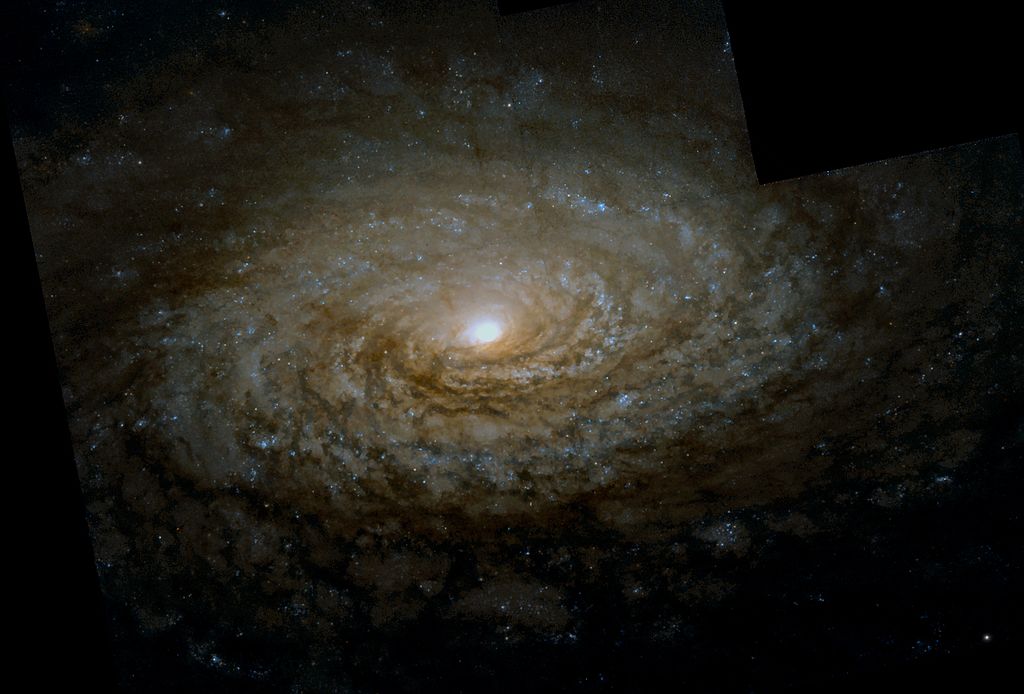 By NASA/ESA - The Hubble Legacy Archive (HLA): Space Telescope Science Institute (STScI), the Space Telescope European Coordinating Facility (ST-ECF), and the Canadian Astronomy Data Centre (CADC) - zoranknez (Aladin software) (Hubble Space Telescope) [Public domain], via Wikimedia Commons
By NASA/ESA - The Hubble Legacy Archive (HLA): Space Telescope Science Institute (STScI), the Space Telescope European Coordinating Facility (ST-ECF), and the Canadian Astronomy Data Centre (CADC) - zoranknez (Aladin software) (Hubble Space Telescope) [Public domain], via Wikimedia Commons
Also known as M63, the Sunflower Galaxy was first discovered by Pierre Mechain in 1779.
It was one of the first galaxies identified that have the signature spiral structure that you can see in the image above, taken with the Hubble Space Telescope.
Its arms are made up of new blue-white giant stars, and some astronomers believe that there is a supermassive black hole at its center.
I Zwicky 18
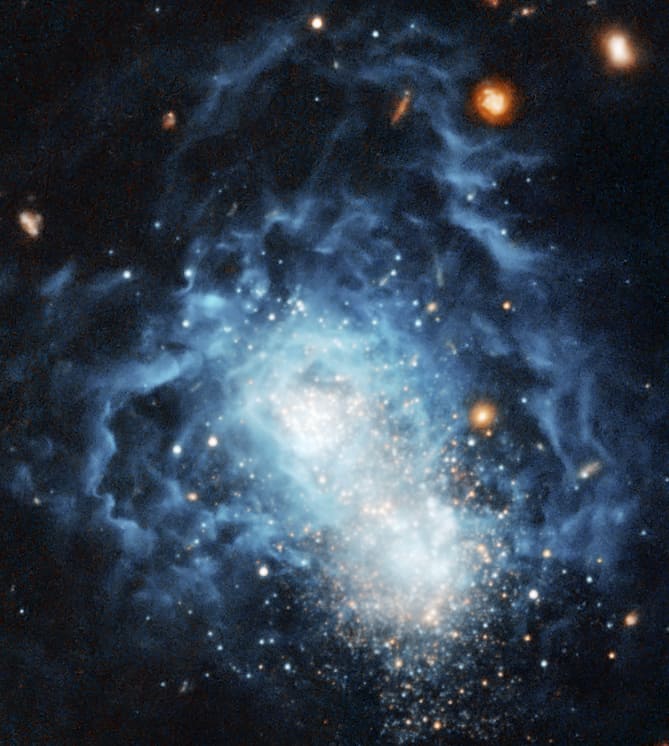 By NASA, ESA, and A. Aloisi (Space Telescope Science Institute and European Space Agency, Baltimore, Md.) (HubbleSite: NewsCenter) [Public domain], via Wikimedia Commons
By NASA, ESA, and A. Aloisi (Space Telescope Science Institute and European Space Agency, Baltimore, Md.) (HubbleSite: NewsCenter) [Public domain], via Wikimedia Commons
Its name isn't the only strange thing about this galaxy...
For starters, I Zwicky 18 is a dwarf irregular galaxy, meaning it doesn't have a distinct or regular shape.
It also demonstrates some odd star development.
It's a relatively young galaxy at about one billion years old, yet some of its stars develop in a manner that's more typical of galaxy formation in the earliest days of the universe.
Whatever the case, it wasn't until 1930 that it was discovered by Fritz Zwicky.
Crab Nebula
 By NASA, ESA, J. Hester and A. Loll (Arizona State University) (HubbleSite: gallery, release.) [Public domain], via Wikimedia Commons
By NASA, ESA, J. Hester and A. Loll (Arizona State University) (HubbleSite: gallery, release.) [Public domain], via Wikimedia Commons
This composite image from the Hubble Space Telescope is actually 24 separate images put together.
What it shows is a supernova remnant in the Taurus constellation. The supernova exploded almost 1,000 years ago, an event that was recorded by Chinese and Japanese astronomers at the time.
And if you're wondering why it's named the crab nebula, it's because William Parsons, Third Earl of Rosse made a drawing of it after observing it with a 36-inch telescope in 1840. His drawing resembled - you guessed it - a crab.
Carina Nebula
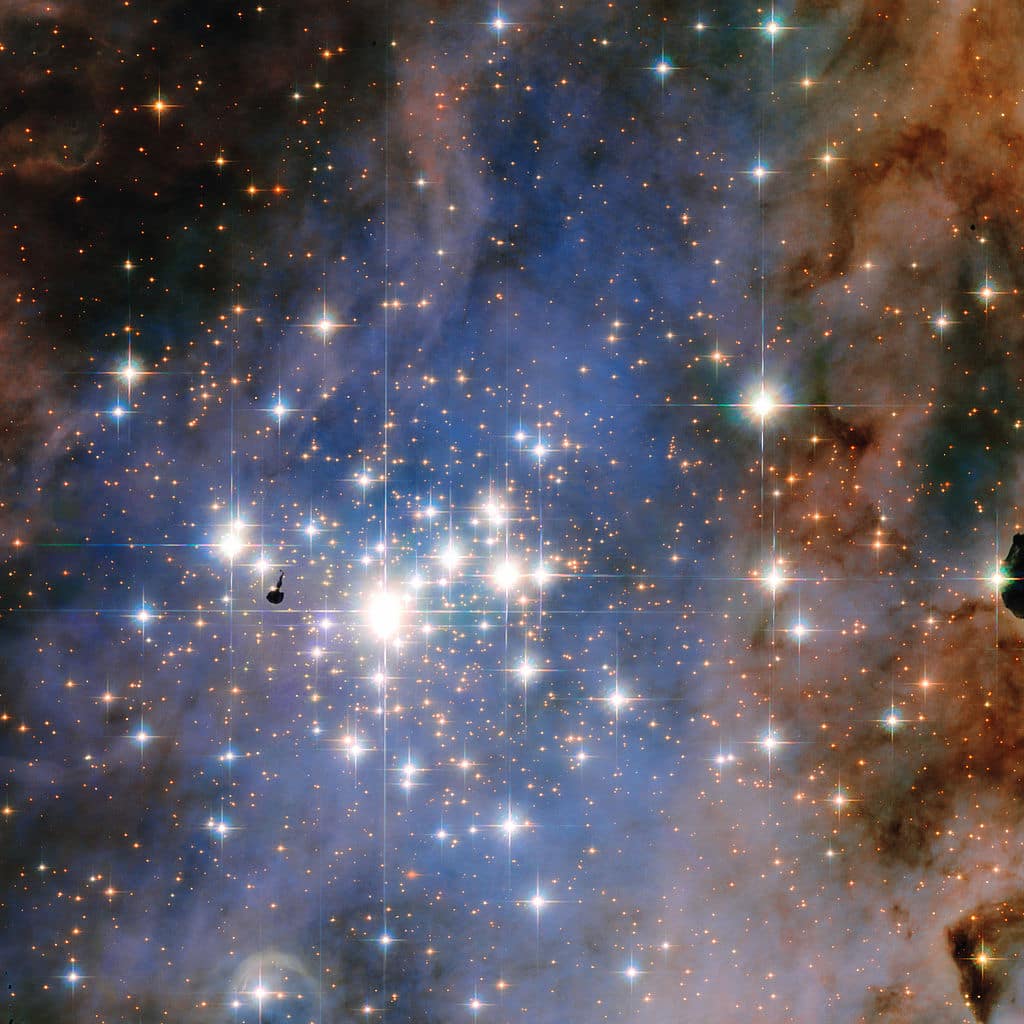 By NASA & ESA, Jesús Maíz Apellániz (Centro de Astrobiología, CSIC-INTA, Spain) (http://www.spacetelescope.org/images/heic1601a/) [Public domain], via Wikimedia Commons
By NASA & ESA, Jesús Maíz Apellániz (Centro de Astrobiología, CSIC-INTA, Spain) (http://www.spacetelescope.org/images/heic1601a/) [Public domain], via Wikimedia Commons
The Carina Nebula is an interesting structure because it is so large and complex. It's actually one of the largest diffuse nebulae in the galaxy.
Within its area are open clusters, O-type stars, Wolf-Rayet stars-Rayet stars, and huge star clusters as well.
In fact, Trumpler 14 (shown above), one of the nebula's star clusters, is home to the most luminous star in the Milky Way, named WR 25.
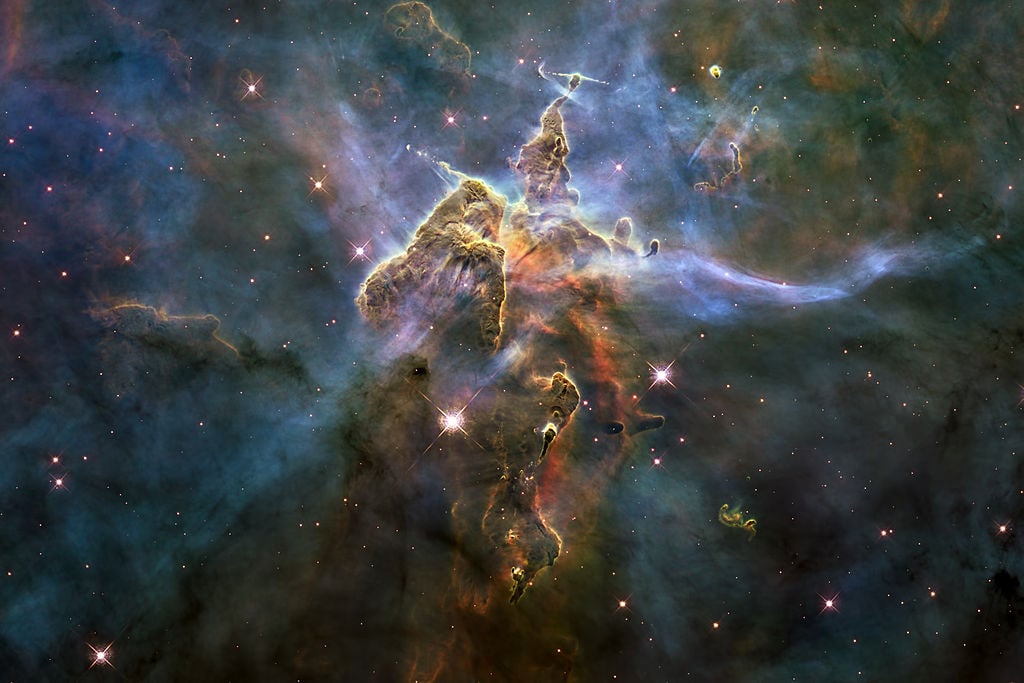 By NASA, ESA, and M. Livio and the Hubble 20th Anniversary Team (STScI) [Public domain], via Wikimedia Commons
By NASA, ESA, and M. Livio and the Hubble 20th Anniversary Team (STScI) [Public domain], via Wikimedia Commons
Another part of the nebula, Mystic Mountain (shown above), is a dust-gas pillar that measures three light years in height.
The huge peaks that resemble mountaintops are created when nascent stars release gas, which streams outward to form the peaks.
This image was taken by the Hubble Space Telescope on its 20th anniversary in February 2010.
Whirlpool Galaxy
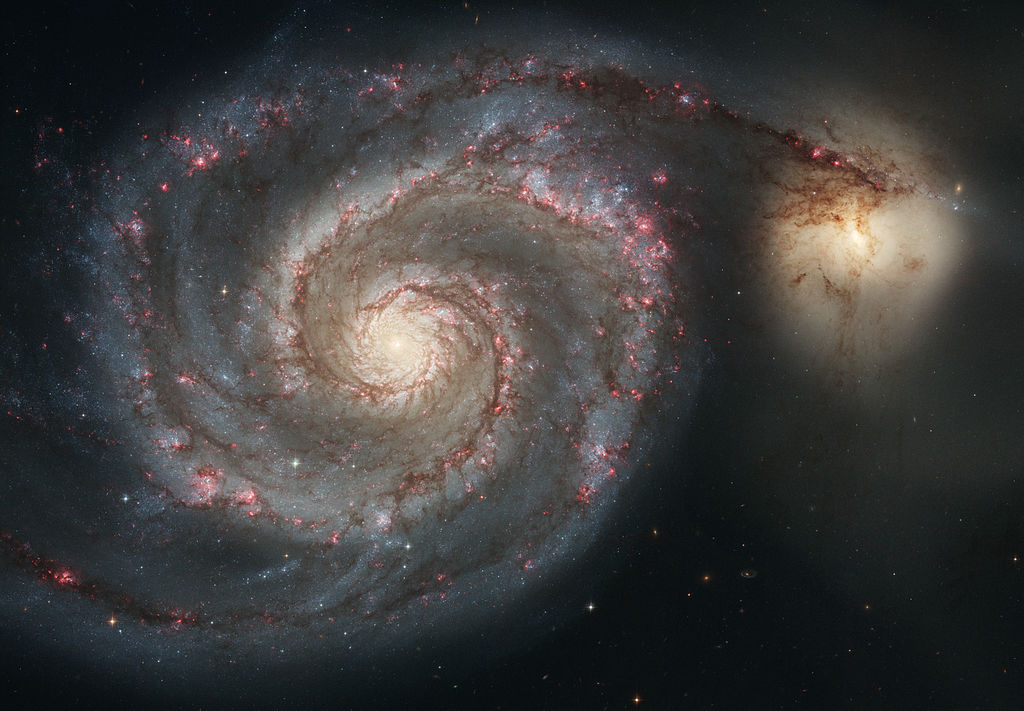 By NASA and European Space Agency [Public domain], via Wikimedia Commons
By NASA and European Space Agency [Public domain], via Wikimedia Commons
As you can see in the image above, the Whirlpool Galaxy is very aptly named, given its classic spiral shape. That shape is most likely due to the interaction of the galaxy with its neighbor, NGC 5195, shown upper right in the image above.
Aside from being spectacularly beautiful, the Whirlpool Galaxy is also home to a number of black holes as well as three supernovae.
It's also one of the most easily observed galaxies, and can even be seen with binoculars.
Pillars of Creation
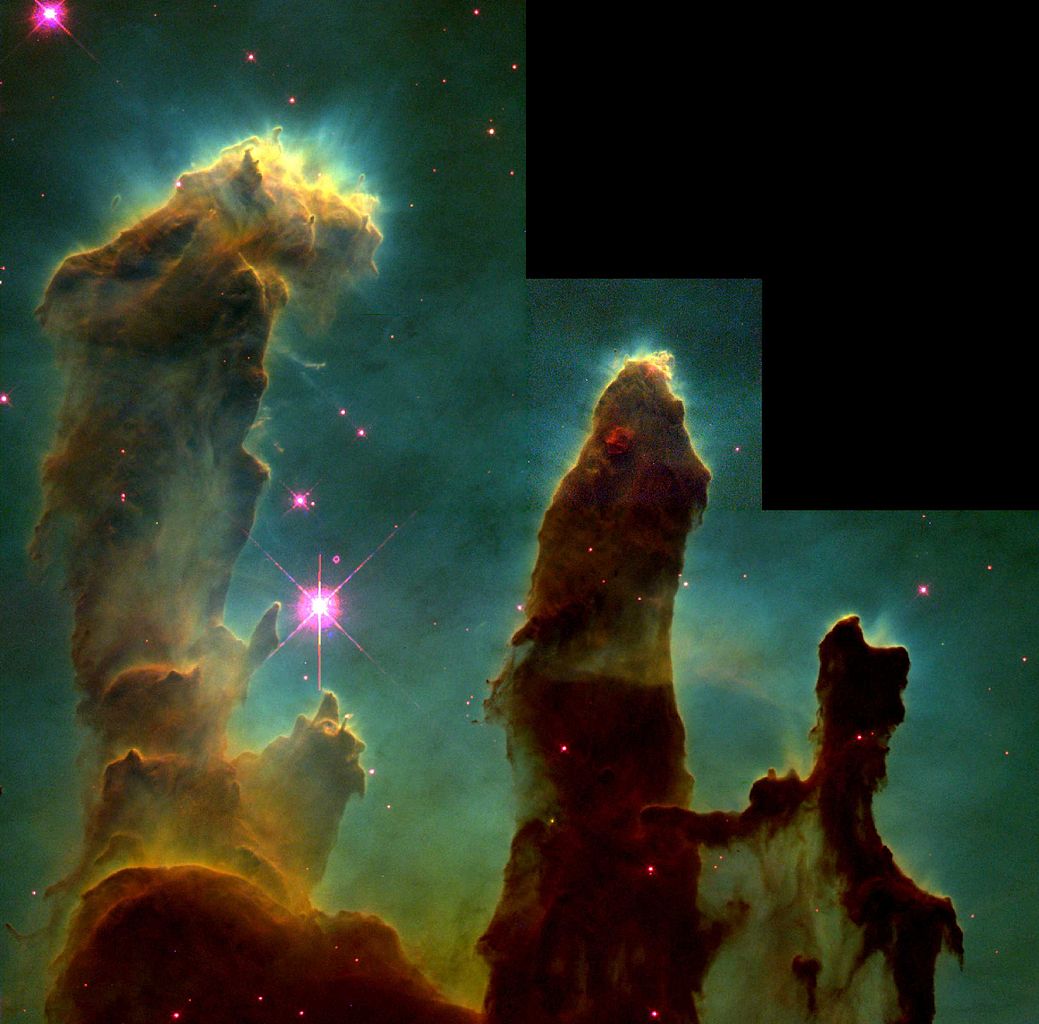 By Credit: NASA, Jeff Hester, and Paul Scowen (Arizona State University) [Public domain], via Wikimedia Commons
By Credit: NASA, Jeff Hester, and Paul Scowen (Arizona State University) [Public domain], via Wikimedia Commons
One of Hubble's most well-known photographs is this one of the Pillars of Creation in the Eagle Nebula, taken way back on April 1, 1995.
The pillars are comprised of interstellar gas and dust that are in the midst of creating new stars.
Interestingly, as they create new stars, the pillars are also being destroyed by the light from recently-formed stars nearby.
This photo is a composite of 32 different photos from four different cameras on the Hubble.
The green areas are hydrogen, the red is singly-ionized sulfur, and the blue indicates double-ionized oxygen atoms.
Westerlund 2
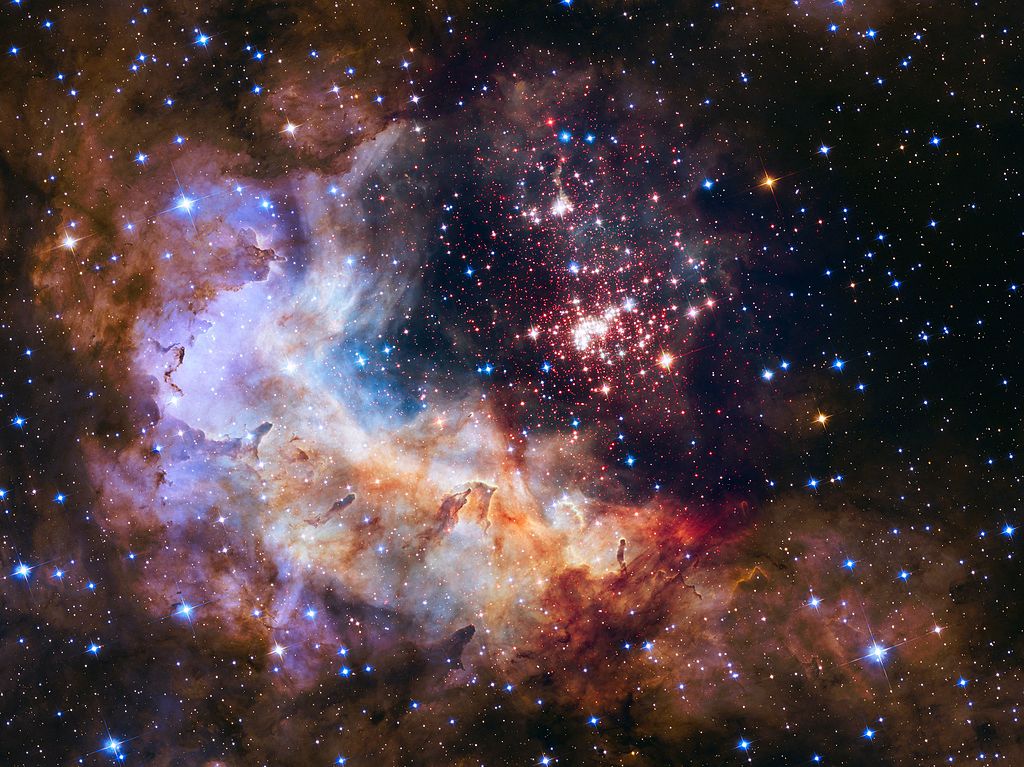 By NASA, ESA, the Hubble Heritage Team (STScI/AURA), A. Nota (ESA/STScI), and the Westerlund 2 Science Team [Public domain], via Wikimedia Commons
By NASA, ESA, the Hubble Heritage Team (STScI/AURA), A. Nota (ESA/STScI), and the Westerlund 2 Science Team [Public domain], via Wikimedia Commons
An obscured compact young star cluster, Westerlund 2 is home to some of the brightest, hottest stars as yet discovered.
The cluster is about 1-2 million years old, and wasn't even discovered until the 1960s by Bengt Westerlund.
So far, astronomers have identified more than a dozen early O stars and a number of Wolf-Rayet Stars within the cluster.
The image above was taken by the Hubble Space Telescope in honor of its 25th anniversary in 2015.
Editor's Note: If these images have sparked an interest in astrophotography, check out our astrophotography section for how-to guidelines for taking photos of the night sky. Be sure to visit our friends at MrStarGuy to get outfitted with all the necessary astrophotography gear, too. A top recommendation is their Vixen Polarie Star Tracker. This compact, yet highly functional mount attached to a normal tripod and can be used with cameras that weigh seven pounds or less. Using the included compass, a North Star Alignment Window, or a polar scope, you can orient the Polarie to face north. Once it's set, the Polarie will track the stars as they move across the sky, eliminating star trails and allowing you to take images of pinpoint stars. Learn more about this and other astrophotography gear at MrStarGuy.
We Recommend
Top 10 Gifts for Photographers Under $2,500 - 2017 Edition

All of a sudden, it's almost Halloween, and that means one thing - Christmas isn't far behind.
If you've got a photographer on your list for holiday shopping, you know how particular they can be about the gear they use.
That's where this guide comes in...
With a budget of up to $2,500, you've got a whole wide world of photography gear, gizmos, and gadgets to choose from for the people on your holiday list.
Here's my top 10 favorite gift ideas at this price point.
ModiBooth
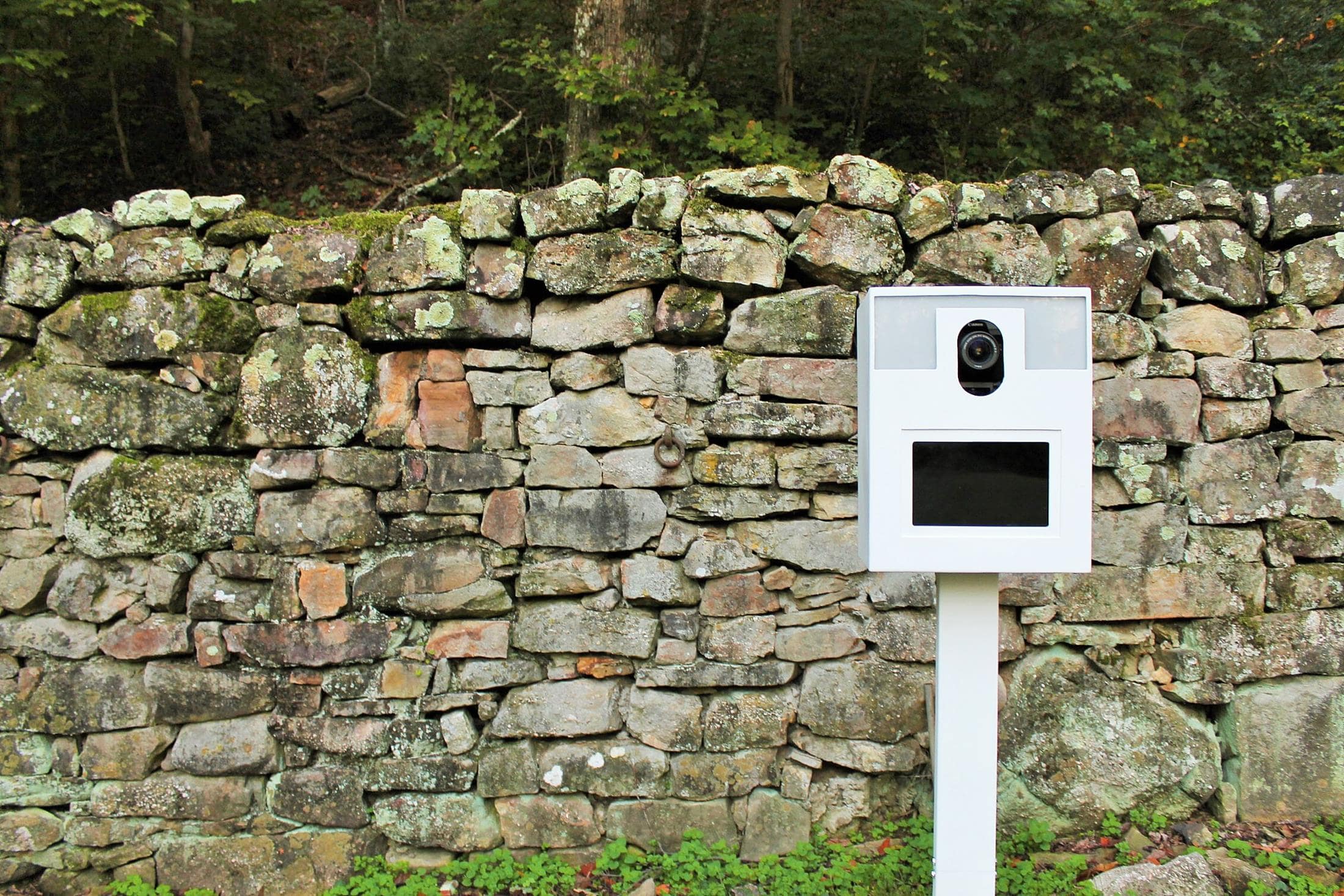
Here's the great thing about ModiBooth...
It's the gift that keeps on giving!
For the photographer on your list this year, a ModiBooth portable photo kiosk is a great way to help them expand their revenue stream.
These things are built to last right here in the USA, and can be deployed at all sorts of events - birthdays, wedding receptions, corporate events, and so forth - to give attendees a fun and interactive way to get their photo taken.
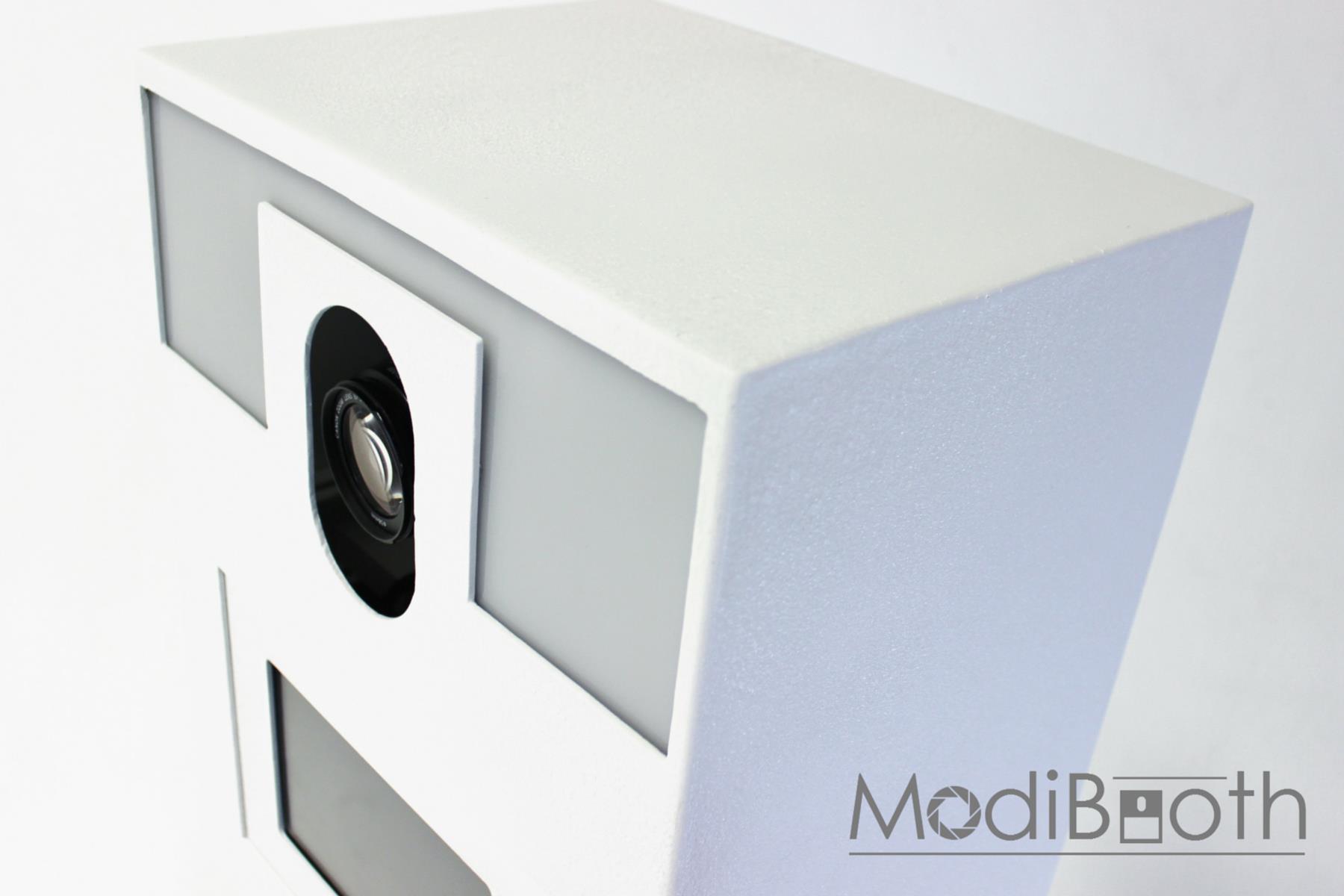
That means that while your favorite photographer is hard at work taking photos with his or her camera, ModiBooth is working for them as well.
The kiosk is easy to set up, easy to take down, and easy to transport - all its components will fit inside a single Husky Case.
And since it's made of steel, photographers can customize how it looks with magnetic wrapping that's specific to their brand.
ModiBooth can accommodate a variety of different tablets, multiple types of cameras, and different types of lighting, too.
Canon EOS 5DS
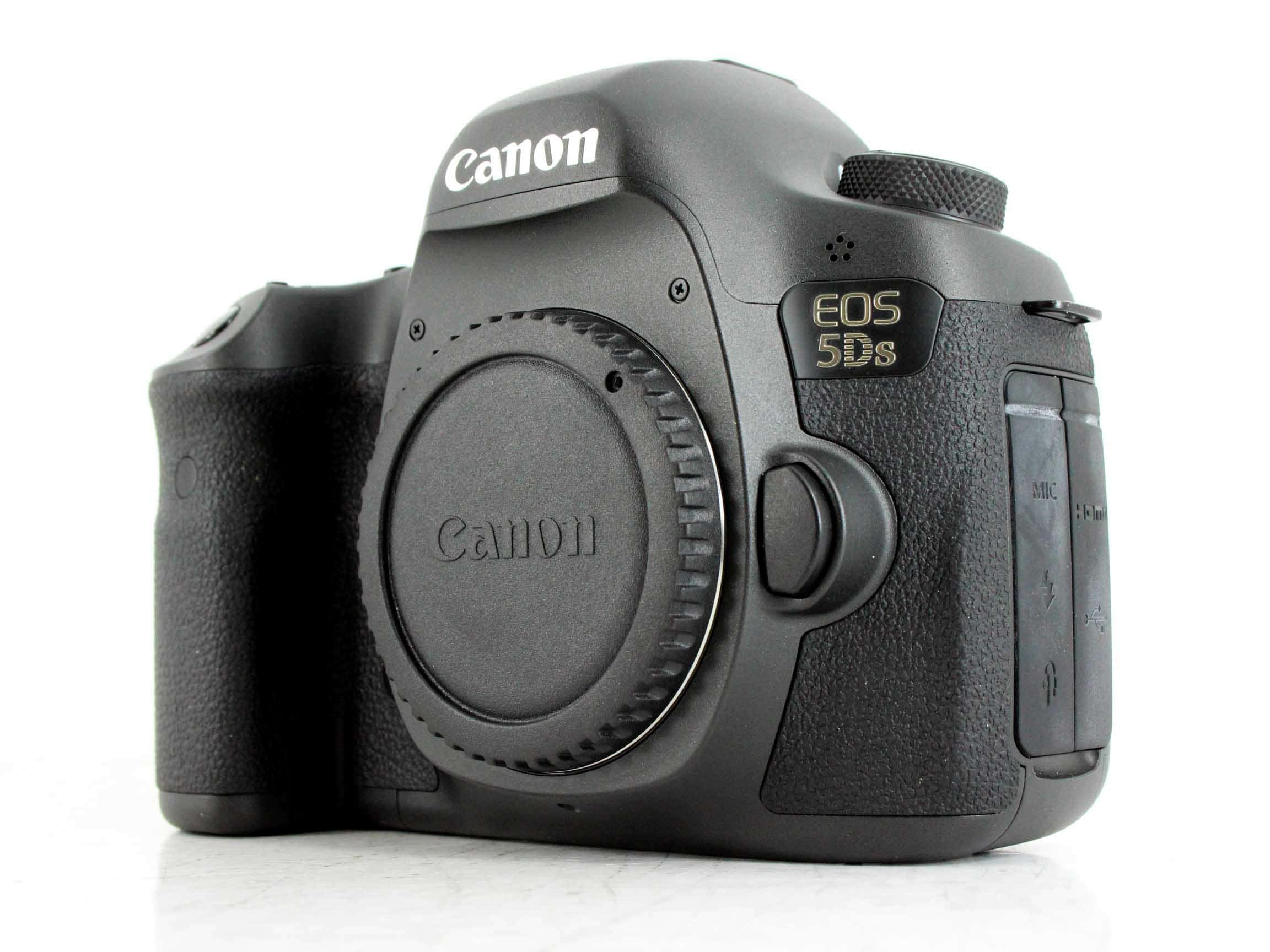
With a budget of up to $2,500, you can get all sorts of goodies for the photographer on your holiday wish list.
That includes a pre-owned professional camera like the Canon EOS 5DS shown above!
This camera has an incredible 50.6-megapixel sensor that's among the highest resolution sensors ever made.
It's got 5fps continuous shooting for capturing action, and a silent shutter mode that will allow your loved one to capture images of skittish subjects without scaring them off with loud shutter sounds.
Its dual DIGIC 6 image processors make quick work of tasks, and the 61-point autofocus system with 41 cross-type sensors will help the photographer on your list ensure they capture their subjects in sharp detail.
Whether your loved one photographs people or places, animals or everyday things, this camera has the tools, features, and price tag that make it an ideal choice for the holidays!
Learn more about the Canon EOS 5Ds.
Vixen ED103S Refractor Telescope

With high-grade optics and a meticulous design for superb views, the photographer on your holiday list is sure to love the Vixen ED103S Refractor telescope for viewing the heavens.
Its high-definition SD lens gives top-notch optical performance but packaged in a small tube for easy handling.
The Super Extra Low Dispersion lenses produce bright images from an f/7.7 focal ratio to capture crisp images with high contrast and true colors as well.
The lenses in this telescope focus the full visible spectrum of light in a way that's highly accurate and virtually free of chromatic aberration with sharpness from edge to edge.
If you're shopping for a photographer this holiday season, they will be highly pleased with the high contrast images through this telescope.
Learn more about the Vixen ED103S Refractor Telescope.
CanvasHQ Canvas Prints
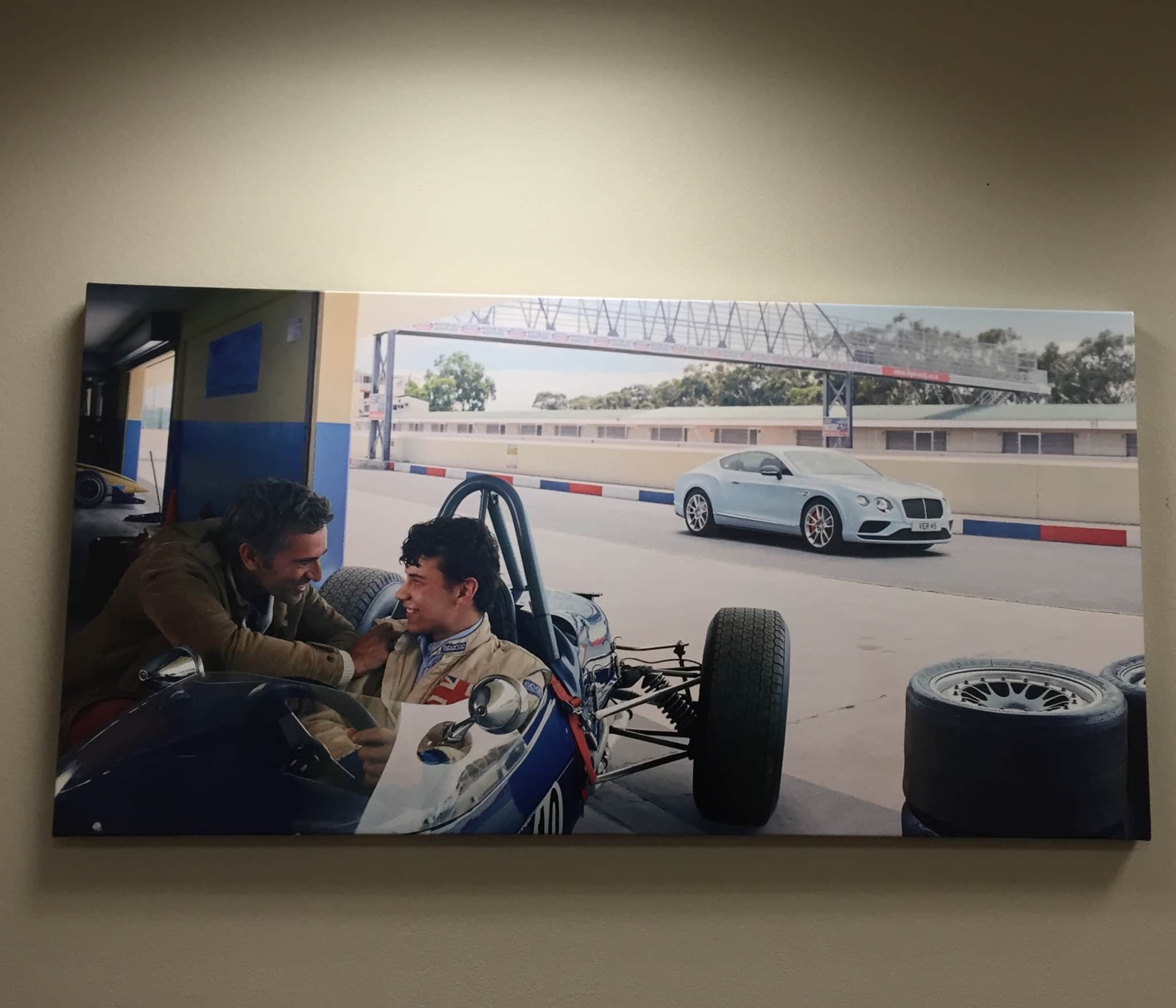
I love a good canvas print, and I'm sure most photographers do as well.
The operative word here is good, though...
Some canvas prints you get online are just plain terrible. But that's not the case with CanvasHQ.
In fact, for the photographer on your list, I'd suggest getting them a set of prints for Christmas!
With a budget of $2,500, you can go hog wild with CanvasHQ prints.
You could opt to get six 40x60" canvas prints and still have money left over! Of course, you can mix and match sizes, too, and give the photographer in your life a whole collection of their photos printed on top-quality canvas using premium inks for a print that looks great and will last for generations.
CanvasHQ is committed to customer service and offers a money-back guarantee as well, so it's really a gift you can't go wrong with this Christmas!
Learn more about CanvasHQ Canvas Prints.
Microsoft Surface Book - 512GB

One of the best laptops money can buy is the Microsoft Surface Book.
And their flagship model - the 512GB version - offers top-of-the-line SSD storage, 8GB of RAM, and a 6th generation Intel Core i5 processor.
On top of all that, this laptop has a gorgeous detachable 13.5-inch PixelSense touchscreen display that's both functional and beautiful at the same time.
Loaded with Windows 10 Pro - the best operating system Microsoft has put out in years - it's a laptop/tablet combination that can handle any tasks a photographer throws at it.
And, even better, the incredible Microsoft Surface Pen is included, making it an even more functional device for everything from taking quick notes to making pinpoint edits to photos.
Learn more about the Microsoft Surface Book 512GB.
Holdfast Roamographer Duffle Bag, Camera Bag, and MoneyMaker
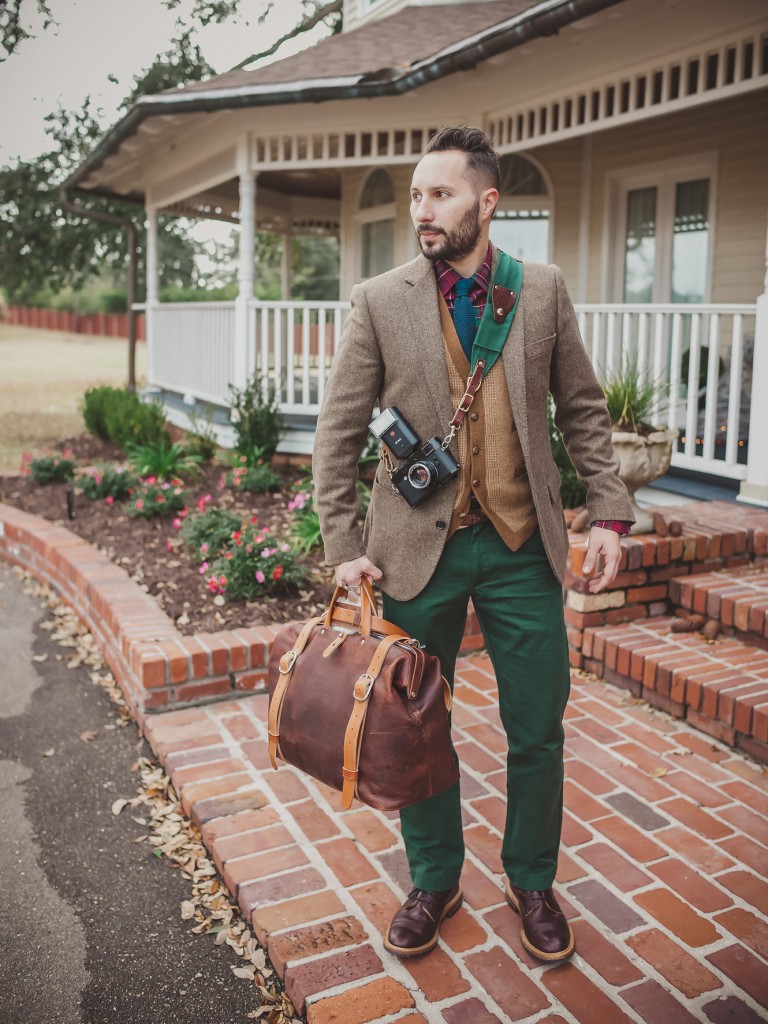
Talk about the ultimate photography setup!
If you're aiming to impress a photographer this Christmas, go ahead and give them a bundle of products from Holdfast.
Their top-of-the-line Roamographer bags not only look incredible, but they're also highly functional, too.
Give them the Roamographer Duffle Bag for those long weekends out taking photos.
The duffle is handcrafted out of American Bison hide and has a shearling lined shoulder strap for easy carrying. It's the perfect bag for a quick trip, and with a metal frame that keeps the bag open during packing and unpacking, two boot bags to keep your shoes away from your clothes, and tons of pockets for small items, it'll become their favorite getaway bag.
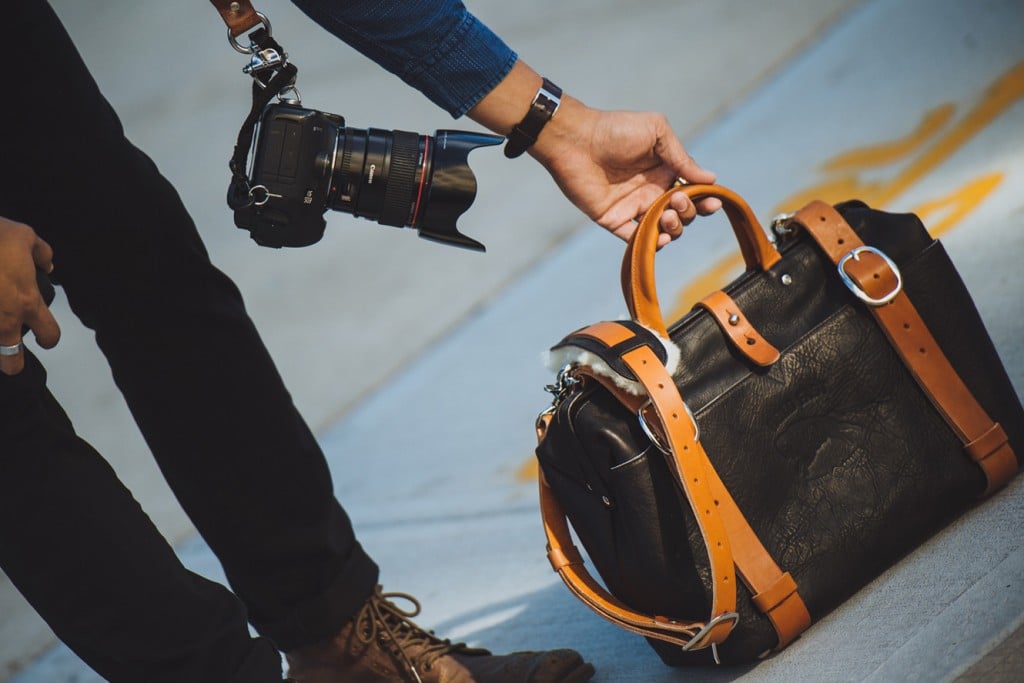
To carry their gear, you can include a Holdfast Roamographer Camera Bag as well.
Like the duffle, the camera bag has a vintage aesthetic but with modern features.
The camera insert cradles each camera item, ensuring their safety during transit.
The carrier straps accommodate a tripod for easy carrying, and the shearling lined shoulder strap makes it easy on your favorite photographer's shoulder to carry the bag, too.
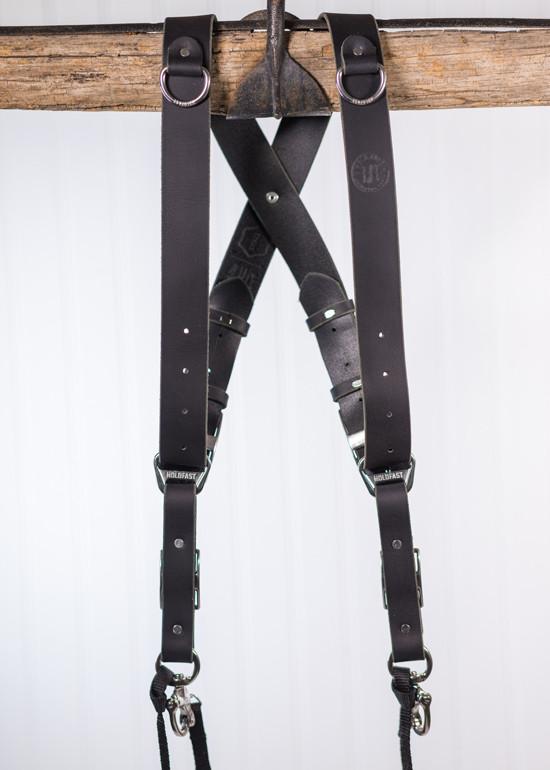
While you're at it, you can throw in a Holdfast MoneyMaker dual camera system.
The dual straps mean that a photographer can carry up to three cameras in ultimate comfort, and with their gear right at their fingertips for safe carrying.
What's more, for quick shots, their cameras are easy to reach, making the MoneyMaker just about the most functional gear you could give a photographer this holiday season.
And, like all other Holdfast products, the MoneyMaker looks like a million bucks.
You can pick up all three of these products and still have money to spare with a $2,500 budget!
Learn more about Holdfast products.
Artbeat Studios 40x60 HD Acrylic Print (Set of 3)
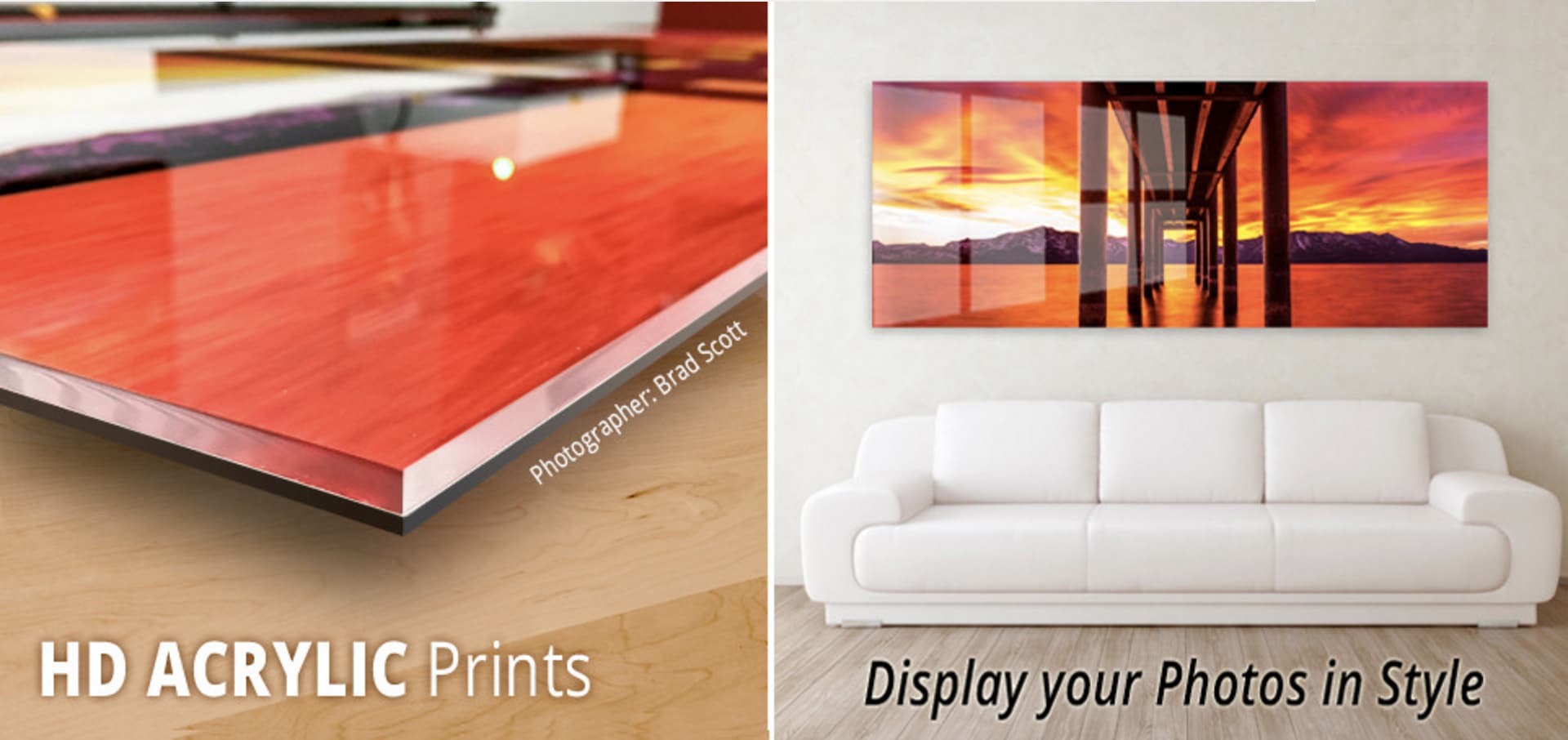
No one ever said that when you get someone a photo print that you have to get them just one...
Artbeat Studios has HD Acrylic prints that look outstanding and give photos an impeccable look that will leave people breathless.
For photographers on your holiday list, HD Acrylic Prints are the ideal gift because it allows them to showcase their work in large format (and with a $2,500 budget, they can get three prints made, too!).
Artbeat Studios uses the finest materials to construct these prints, including high-resolution archival Epson Metallic Photo Paper, Epson Archival Inks, wood or aluminum wall mounts, and, of course, gorgeous acrylic that's got polished edges for a diamond shine.
Better still, these acrylic prints are face-mounted, giving them higher resolution and clarity for a final product that is simply stunning.
Learn more about Artbeat Studios acrylic prints.
Nikon D810
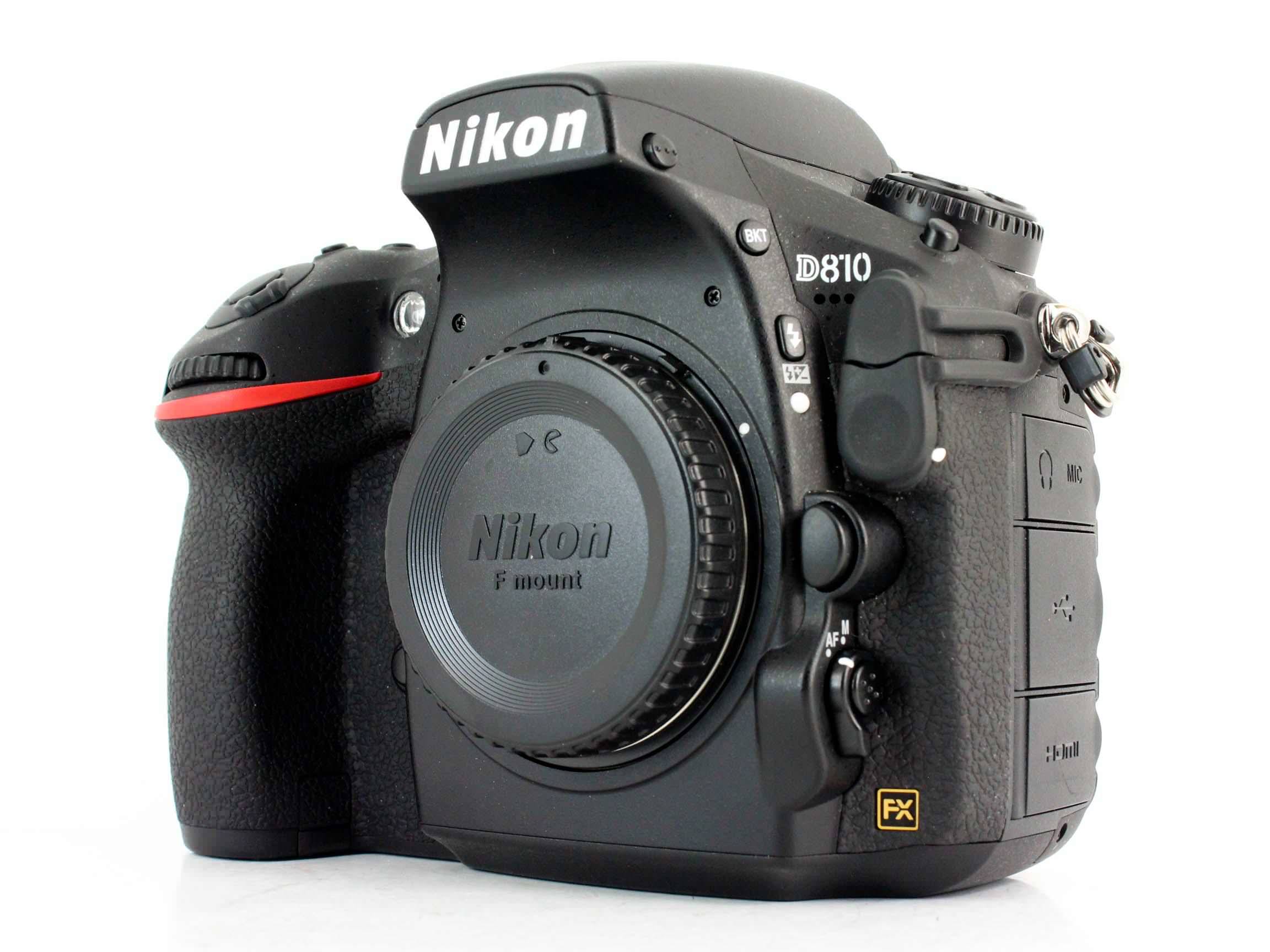
It's one of the best cameras ever made, and now that a newer model is out (the Nikon D850), you can find D810s for great prices, especially if you buy pre-owned.
The photographer on your list will love a D810 if for nothing other than its excellent 36.3-megapixel sensor that produces highly resolute images.
The D810 also features 7fps shooting for capturing quick action, an ISO range to 51,200 for low-light shooting, and a 51-point autofocus system to help ensure that photos are focused properly.
Though it doesn't have 4K video, it does have 1080p video at 60fps. Additionally, it's shutter speed goes up to 1/8000th of a second for fast shots and its sensor is among the best ever made.
That's a lot to love in a camera that you can get for well under $2,500!
Learn more about the Nikon D810.
Vixen VC200L Reflector Telescope
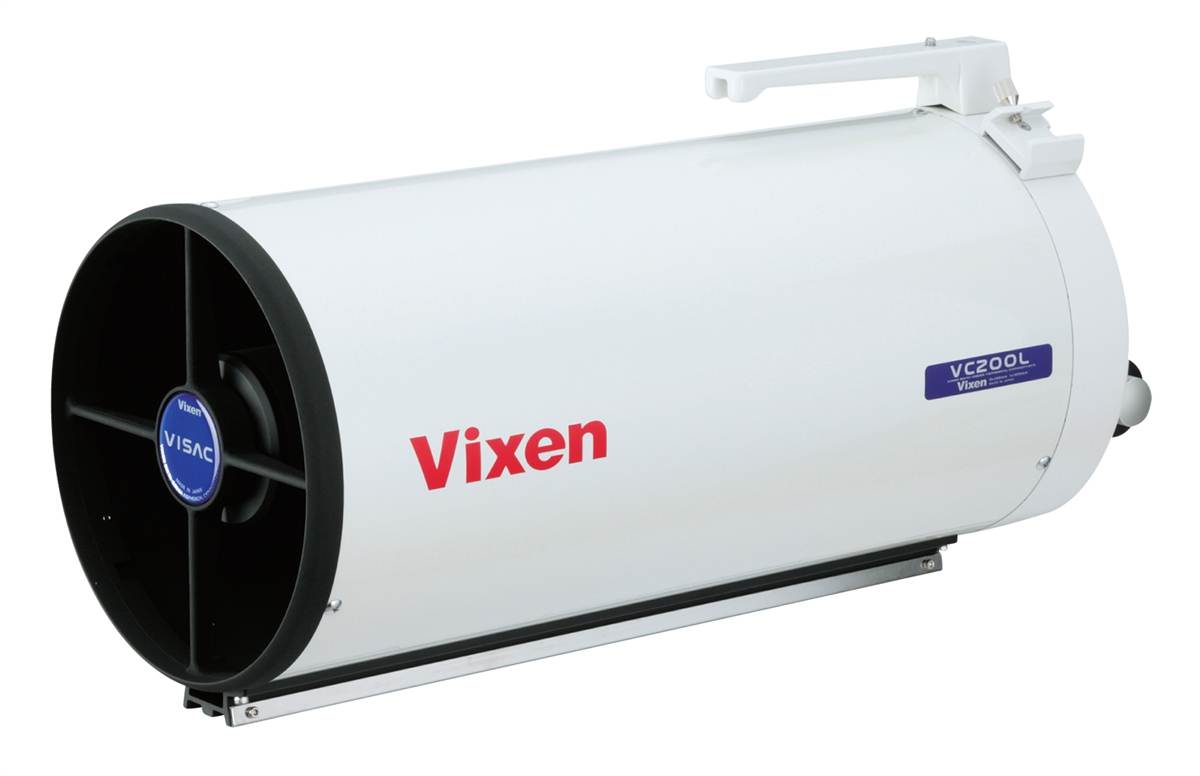
If the photographer on your holiday list is into highly specialized astro imaging, this is the telescope for them!
The unique catadioptric design features a sixth order aspherical primary mirror, a triplet corrector lens, and a convex secondary mirror for gorgeously sharp results.
It provides high-definition star images all the way to the edge of the viewing field. Additionally, it offers outstanding performance when used for astrophotography.
With its aspherical optical design, the Vixen VC200L offers impeccable image correction throughout the large illuminated field as well.
In other words, this is a top-of-the-line rig that anyone who enjoys viewing and photographing the night sky will appreciate!
Learn more about the Vixen VC200L.
Microsoft Surface Pro Intel Core i7 / 512GB SSD / 16GB RAM

Like its cousin, the Microsoft Surface Book, the Surface Pro offers all sorts of flexibility to photographers that are on the move.
That's due in part to its dual functionality as a laptop or a tablet, so they can work with the full machine or work fast and light with the tablet when need be.
With a seventh-generation Intel Core i7 processor and 16GB of RAM, this thing can handle virtually any demanding task with ease, too.
In fact, the Surface Pro is 2.5 times faster than that Surface Pro 3, and it's not like that machine was a slouch!
With a battery life that exceeds the Surface Pro 4 by 50 percent, it's not like your favorite photographer will have to worry about losing power, either.
And with a 12.3-inch PixelSense touchscreen display and compatibility with the Surface Pen and the Surface Dial, the Surface Pro makes viewing and editing photos a real joy.
Learn more about the Microsoft Surface Pro Intel Core i7 / 512GB SSD / 16GB RAM.
We Recommend
Top 10 Gifts for Photographers Under $50 - 2017 Edition

I know what you're thinking...
Photography is an expensive endeavor, and there's no way that there's fun, exciting gifts for photographers under $50.
But you're wrong!
I found a TON of photography gifts that meet the $50 requirement and are the kind of gifts you'd be proud to give the photographer on your holiday list this year.
Here's ten of the best options...
Vanguard ALTA Action 80 Tripod Bag
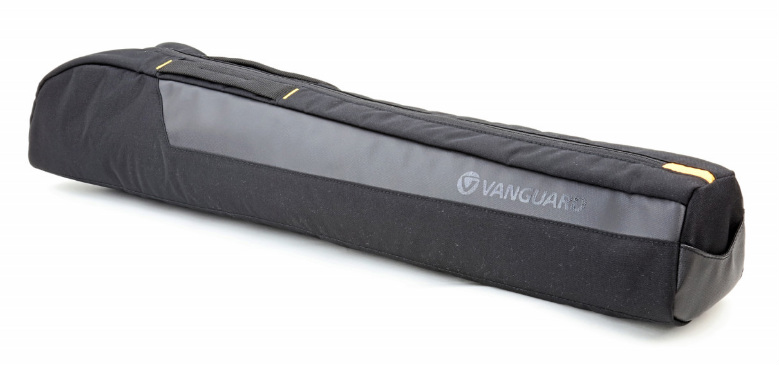
The great thing about the ALTA Action 80 Tripod Bag is that it’s an ideal gift for a photographer that’s already bought into the Vanguard system of tripods.
This bag is designed to fit Vanguard’s highly-regarded ALTA Pro tripod and head combinations and offers photographers easy access with an extra wide top opening. The interior of the bag is both padded and brightly colored, so the tripod is both secure and easy to see.
The ALTA Action 80 can be carried over the shoulder or as a two-way sling across the chest. It’s got a bottom grip for easy maneuvering when loading and unloading from the car as well.
Combined with a waterproof material on the bottom to keep the inside dry, and the ALTA LINK connector that allows for adding the bag to other ALTA backpacks, and you have the makings of a versatile, useful, and affordable gift this holiday season!
Learn more about the Vanguard ALTA Action 80 Tripod Bag.
Bumblejax Acrylic Photo Blocks
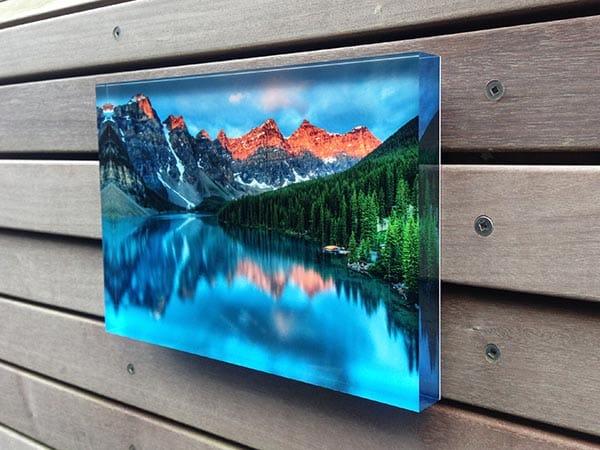
I think it’s safe to say that you’ve probably got someone on your holiday shopping list that is a fan of photography. I think it’s even more likely that you need to buy a gift for someone that uses their phone to take photos.
Now you have the perfect gift for one such person with a Bumblejax Acrylic Photo Block.
These one-inch-thick blocks are ideal for creating artwork that can either stand on its own or hang on the wall using aluminum hanging rails, as seen below.
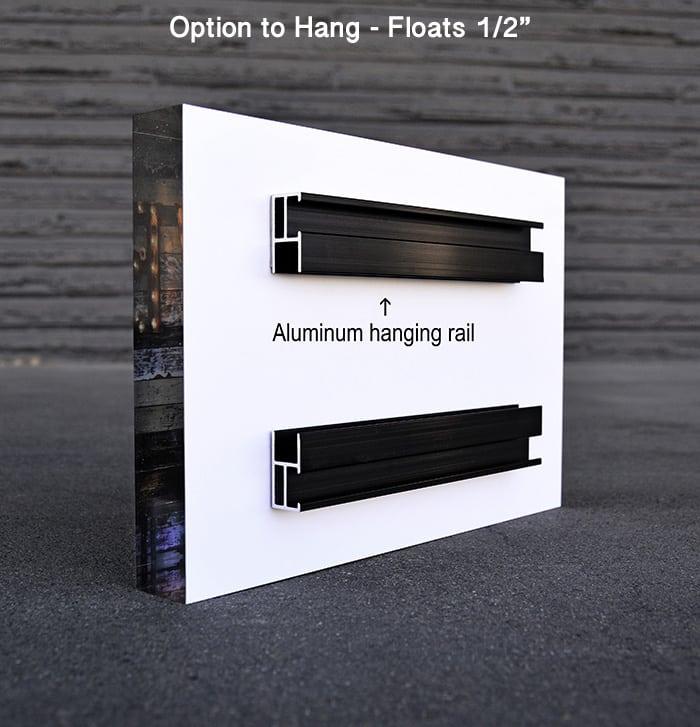
And with a diamond-polished finish that gives the printed image a vibrant, colorful, three-dimensional look, it’s a gift that’s sure to wow.
That’s because the see-through acrylic edges allow more light to refract within the acrylic, creating more illumination on the image for a truly stunning visual effect.
What’s more, Bumblejax face-mounts the image onto the acrylic, using high-grade lustre or metallic paper that offers a superior result with a wider color gamut than other types of printing.
And Bumblejax can even create these stunning acrylic photo blocks using pictures taken with an iPhone. Specifically, their panoramic acrylic photo block (shown in the video above) is the perfect way to display images captured with the iPhone’s panoramic feature.
That means that once you give your loved one the gift of a photo block, they can hop on their phone, upload their favorite image, and get an awesome gift (or you can do it ahead of time - either way!).
With 7x7 and 8x6 blocks starting at under $50 with the coupon code PTBJAX20, these are a great buy. No wonder Bumblejax has over 2,000 rave reviews!
Learn more about the Bumblejax Acrylic Photo Blocks.
Sew Trendy Evelyn Floral Crown

Lori Dorman Photography
A wonderful gift for the holidays that has a ton of visual appeal but won’t set you back a lot of money is the Evelyn Floral Crown pictured above.
These crowns are the perfect complement to any wardrobe, whether your loved one is getting married, having her photo made, hosting a party, or just about any other special occasion.
The crown has a gorgeous rose perfectly placed on the crown and is surrounded by intricate florals that are beautifully arranged on a grapevine. The crown pictured above is in ivory with pink accents, but the crown can be ordered in a wide variety of other colors, including yellow, lavender, pink, red, aqua, coral, and many more.
The types of flowers that are used might vary slightly depending on their seasonal availability, but you can rest assured that no matter what types of flowers that are used, the Evelyn Floral Crown will be something that makes her heart sing this holiday season!
Learn more about the Sew Trendy Evelyn Floral Crown.
Vixen Nature Eye Telescope
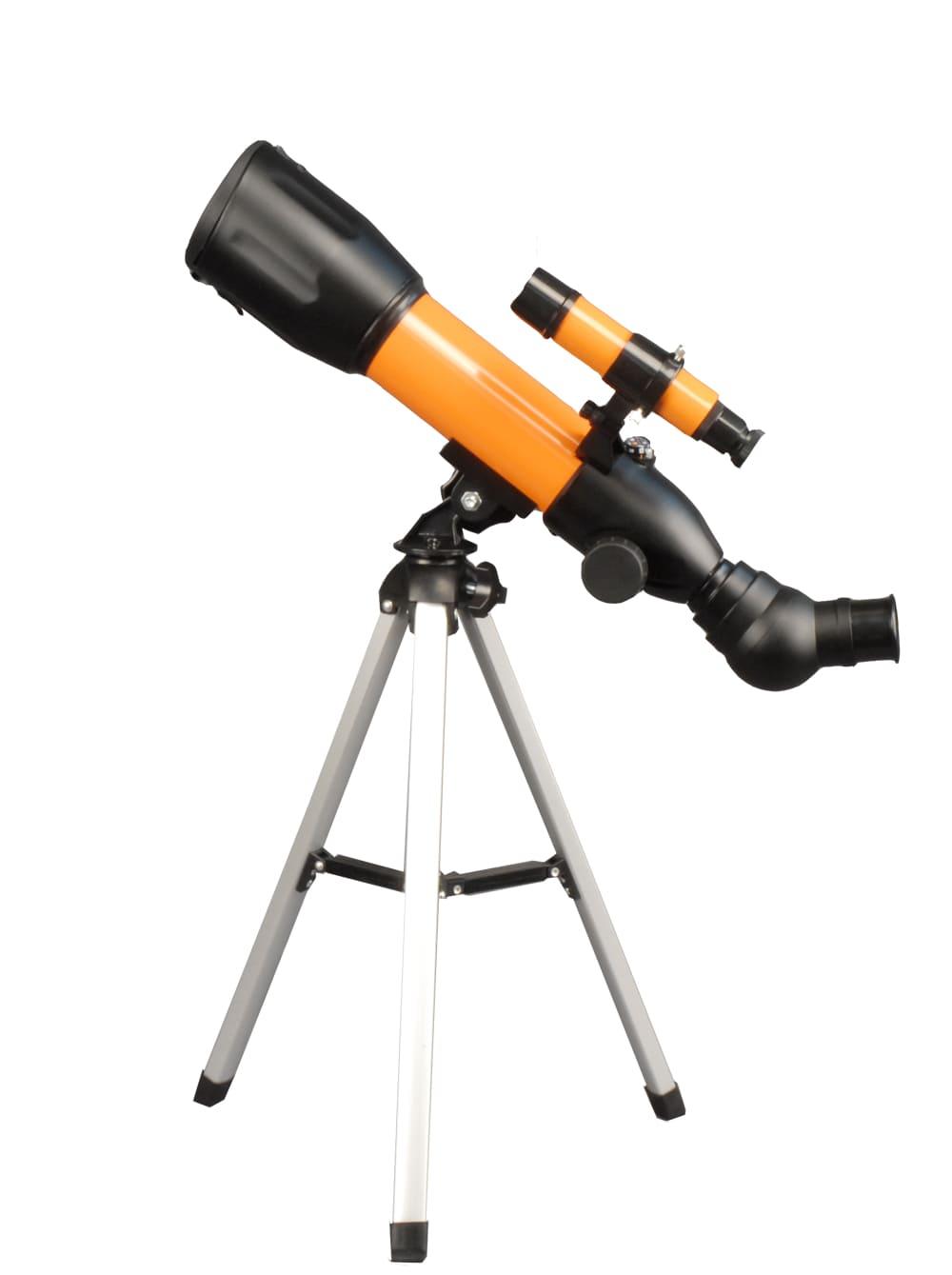
Just about everyone has a child on their holiday shopping list…
Don’t settle for the same old toys this year. For a unique, memorable, and educational gift idea, you might consider the Vixen Nature Eye Telescope from MrStarGuy.
The compact, lightweight design of the Vixen Nature Eye means it can be easily transported and taken on outdoor adventures without having mom or dad lug around a ton of heavy gear. But don’t confuse its compact, lightweight design for something shabby - the Nature Eye is durable and built to stand the test of time.
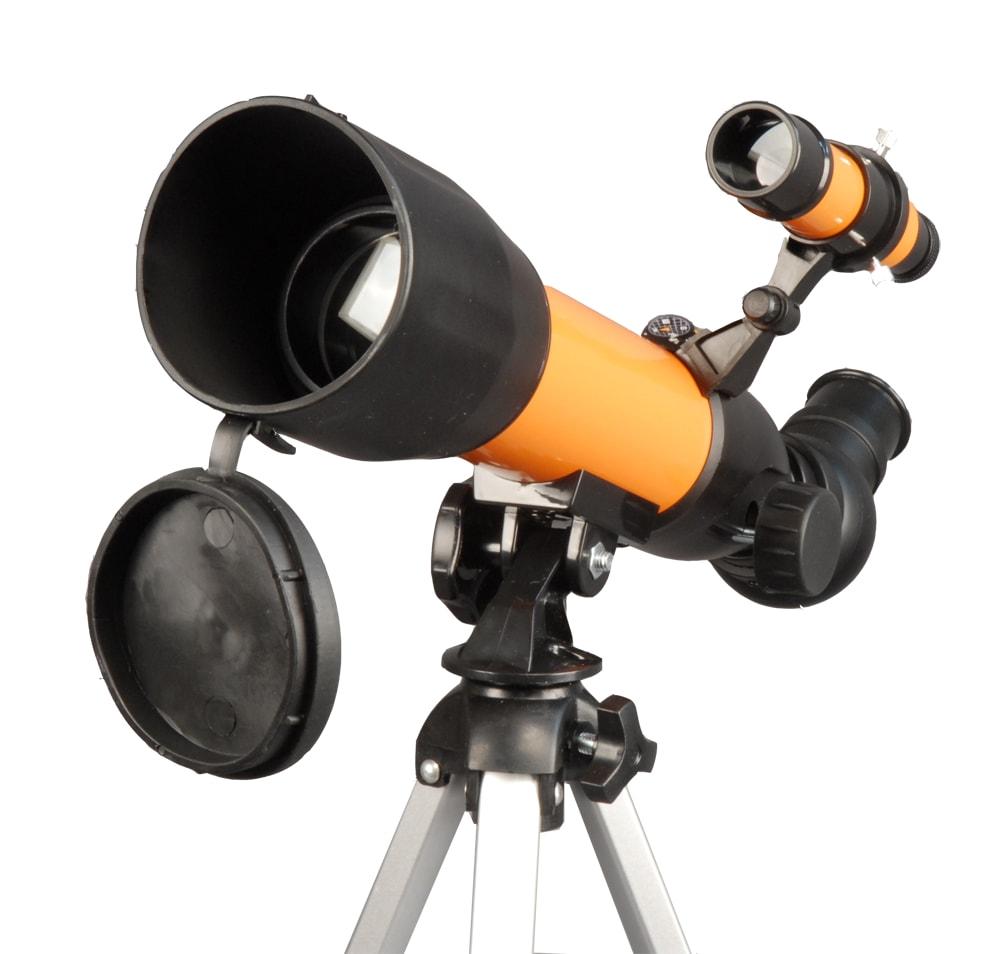
It’s easy to setup, too. The telescope images are right side up for easy viewing. The tabletop tripod is both sturdy and sets up in a matter of seconds.
This little telescope comes with all the needed accessories, too - the aforementioned tripod, a 10mm eyepiece, a 2x Barlow Lens, a peep sight for finding objects, and a 45-degree Click Stop Diagonal that keeps objects in view.
All that for just $39.95!
Learn more about the MrStarGuy Vixen Nature Eye Telescope.
CanvasHQ 8x10 Canvas Print
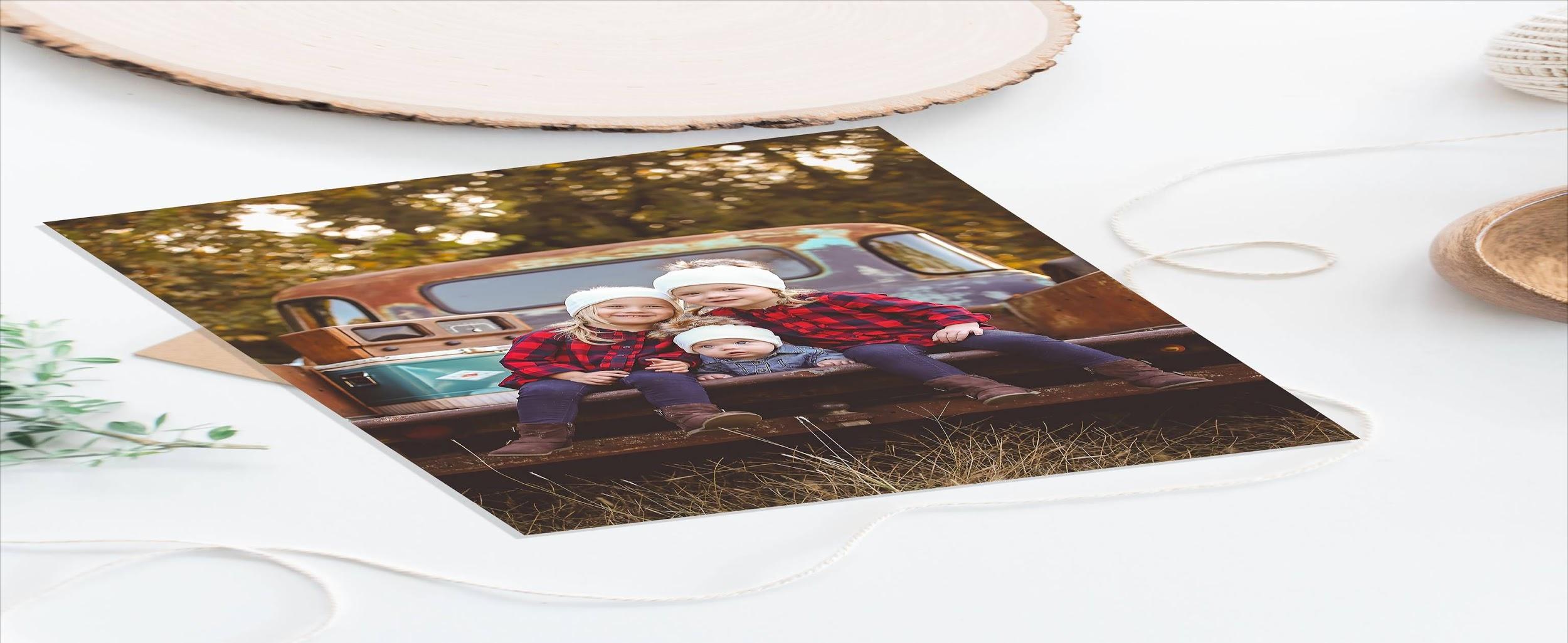
An 8x10 canvas print is just the right size for showcasing a photo and giving it as a gift for the holidays.
Whether you print a family portrait, a landscape, or something in between, Canvas is a gorgeous medium that brings your images to life while giving them a bit of texture for a more interesting viewing experience.
The CanvasHQ 8x10 print comes in a 1.5-inch thickness, meaning it will display beautifully on your loved one’s wall with a bit of depth that separates the image from the surrounding wall surface.
Something else that makes a canvas of this size stand out is vibrant, beautiful colors. Since CanvasHQ uses six colors and an optimizer, you can be sure that the colors in the image stay true to form and display as they should on the canvas surface.
Why get your loved one just another gift this year? Give them the gift of a beautiful piece of art that’s personalized and custom!
Learn more about CanvasHQ 8x10 Prints.
4V Design LAZO Wrist Strap
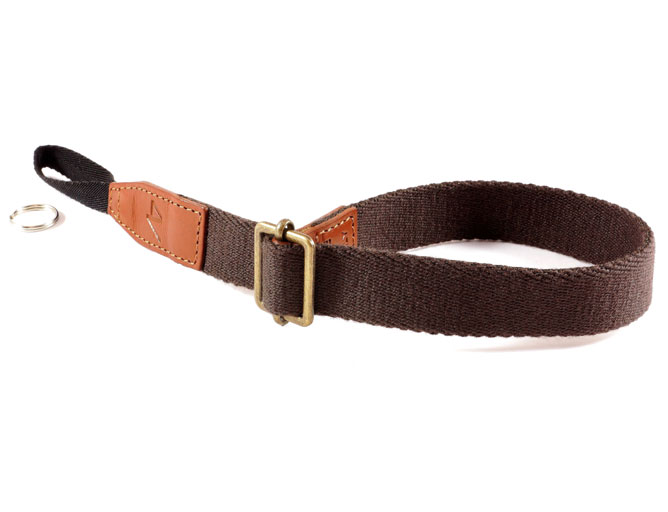
Give the gift of form and function this holiday season with a LAZO wrist strap from 4V Design.
As you can see in the image above, this thing is gorgeously designed and handcrafted with accents made of scented Vegetable Tanned Tuscany Leather with hand-painted edges.
That means it's a gift that has a custom look but without breaking the bank!
But it's not just a pretty accessory - it's functional, too.
It's got a camera connection made of high-strength polyamide military-standard webbing and can be tightened on the wrist for maximum safety.
The LAZO has an adjustable length to accommodate all sizes of wrists and a soft cotton 20mm webbing for a comfortable carrying experience.
Ideal for carrying everything from a small mirrorless camera to a medium format rig, the LAZO hand strap is certainly one of the best photography gifts under $50!
Learn more about the 4V Design LAZO Hand Strap.
Handlepod

One of the best gifts I ever got was the gift of mobility and versatility I get each time I use my Handlepod.
Not only is Handlepod small enough to fit in my pocket, but it allows to me to work fast and light, without having to lug my full-size tripod around.
But don't think that because it's such a small device that it doesn't pack a punch...
As you can see in the image above, this thing is incredibly easy to use - just extend the base, wrap the cord around a sturdy object, and it's ready for your camera.
It will also sit on a flat surface and act like a tabletop tripod, or you can press the handle against a solid surface for added stability.
If you're in a situation in which you need to handhold your camera, just fold the handle out for improved stability for stills and video.
In other words, if you want to give your favorite photographer a gift that gives them incredible versatility and helps improve the quality of their images, look no further than HandlePod!
band.it

If you've ever heard a photographer complain about how hard it is to find the zoom and focus collars on their camera's lens, you can help them solve that problem this Christmas by giving them band.it.
This awesome gadget is a soft, ridged elastomer band that stretches over any interchangeable camera lens.
The band gives photographers a touch-based guide so they know exactly where the focus and zoom rings are as they frame up a shot.
On top of that, band.it has extruded ridges that offer improved grip on the lens while also allowing for more precise adjustments to zoom and focus.

Additionally, band.it eliminates lens creep when the lens is pointed up or down.
As if that's not good enough, band.it helps protect the zoom and focus rings on a lens. And since those can cost hundreds of dollars to repair, using band.it to protect them is a sound investment.
So, this holiday season, give the gift of improved functionality and protection for your favorite photographer's lens. Give the gift of band.it for zoom and focus rings for less than $50!
Artbeat Studios 9x12 HD Metal Print

For a gift that wows when it's opened, give the gift of an HD Metal Print this holiday season from Artbeat Studios.
A 9x12 print is a perfect size for hanging on the wall when there isn't a ton of space, but a high-impact print is wanted.
And you don't get much more high impact than HD Metal!
These prints have breathtaking color because Artbeat Studios takes care to color check the images on color calibrated monitors.
These prints are also heat infused into a specially coated aluminum sheet for incredible durability. In fact, these HD Metal Prints are resistant to UV rays, scratches, and water.
You can even customize the look of the print by choosing different surfaces, finishes, mounting styles, and so on.
In other words, this is one heck of a gift for less than $50!
Learn more about Artbeat Studios 9x12 HD Metal Prints.
Peak Design Leash
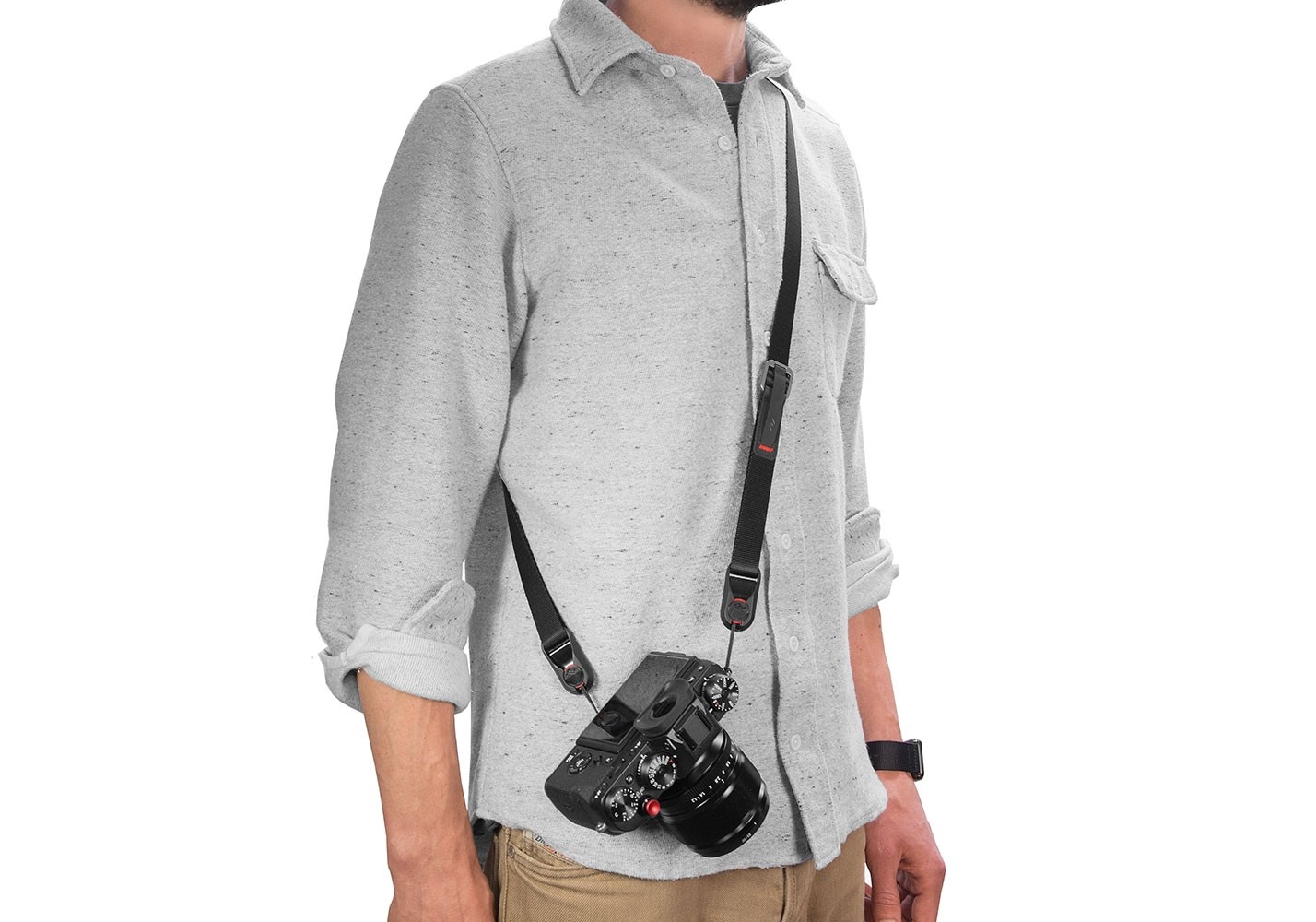
One thing that any photographer will appreciate for Christmas is a better camera strap.
And when it comes to cutting-edge straps, it's hard to beat those put out by Peak Design.
Their Leash strap is ultra-portable, with configurations that allow it to be used as a sling, a neck strap, a safety tether, and more.
Its length is easily adjusted with dual aluminum and Hypalon quick-adjusters - even with just one finger!
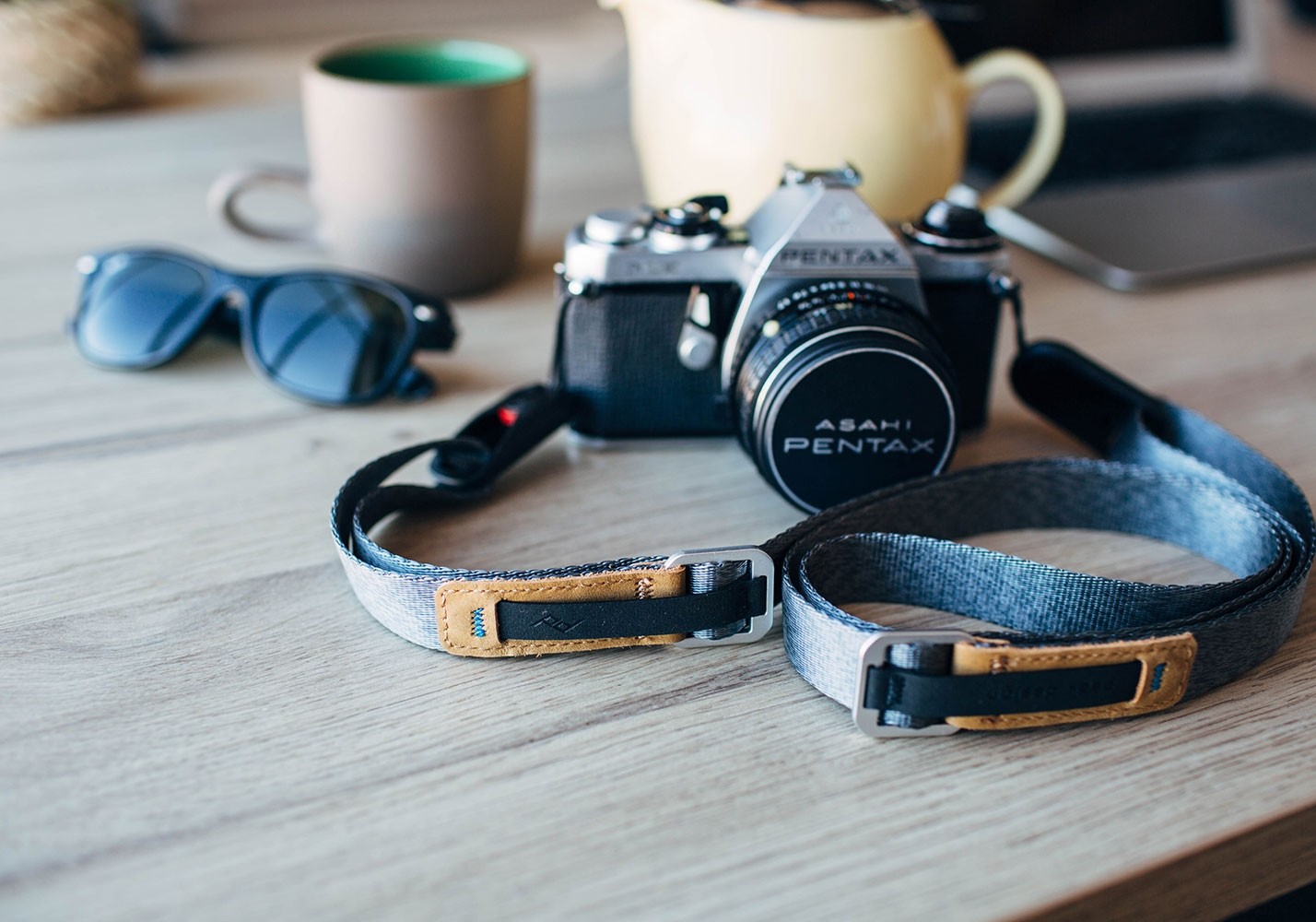
The Peak Design Leash is also quick-connecting, so your favorite photographer won't have to worry about missing a shot because they're trying to get their camera strap squared away.
It can be disconnected just as easily, too, using Peak Design's Anchor Link System. Once it's detached, it can be stored easily in a camera bag or even in the photographer's pocket.
In other words, this strap is well-designed, highly functional, and at way less than $50, it's also a bargain!
Learn more about the Peak Design Leash.
We Recommend
Top 10 Last-Minute Gifts for Photographers

I know we've still got over a month until Christmas, but the clock is ticking to get awesome gifts for the photographers on your holiday shopping list.
The question is, what can you get them that will have that wow factor and totally knock their socks off?
Well, I've got quite a list for you...
And this isn't just some random collection of photography gifts, either. I have personal experience with every single item listed below.
Take it from me, if you need to shop for a photographer, there's something on this list that they will fall in love with!
DJI Mavic Pro

If you’re pressed for time and trying to find ultimate gift for the photographer in your life, consider buying something truly impressive that will take their photography to new heights...literally!
The DJI Mavic Pro is a small but powerful personal drone that offers incredible portability and ease of use while giving you the ability to capture amazing photos at the same time.
Get a load of some of these features…
The Mavic Pro has 24 high-performance computing cores and an all-new OccuSync transmission system that gives it top-notch performance for greater distances. What I found most impressive about this feature is that you can enjoy full HD video streaming from up to 4.3 miles away!
And you don’t have to worry about flying into things, either, because the Mavic Pro has a FlightAutonomy system that detects obstacles up to 49 feet away. Fly with confidence up to 40 mph knowing the Mavic Pro will avoid anything in its path. That feature has saved me a few times!

FlightAutonomy isn’t just for obstacle avoidance, though. It also gives you the ability to land the drone in the exact spot from which it took off. The system also enables the drone to hover more precisely in varied environments, and keep the drone the same elevation above the ground, no matter the terrain.
Additionally, the Mavic Pro has a 4K camera that’s stabilized by a 3-axis mechanical gimbal, offering gorgeous, high-resolution photos and smooth-as-silk 4K video at 30fps.
The Mavic Pro has an improved battery life, too. Why fly for just 10 or 12 minutes when you can fly for 27?!
Another feature that I really appreciate is ActiveTrack. Using ActiveTrack, the Mavic Pro can follow the subject from a front or rear position (or circling them), fly alongside the subject as it moves, and even maintain its focus on the subject as it flies in for close-ups and out for wide shots.

Perhaps most impressive, though, is Tripod Mode.
Sometimes, you need to fly your drone in tight quarters, such as indoors. In that case, flight movements need to be slow and precise. That’s where Tripod Mode comes in: it gives you pinpoint control so the drone can be moved with precision to ensure safe passage.
Clearly, the Mavic Pro is the perfect gift for photographers and videographers because it is loaded with incredible features that make taking photos and videos a breeze.

As a sidenote, DJI just released the Mavic Pro Platinum (shown above) that is 60% quieter and features a longer flight time of 30 minutes. If the photographer on your list wants something that extends their photographic capabilities even further, you might consider it!
Let’s face it, there are a ton of places where you can pick up one of these. With that in mind, I am a bit picky, and recommend “Drone World” for whatever your drone needs are. That's mainly because these guys have insane customer service, and are the largest DJI authorized dealer with something like 5 years of drone experience and I want to say upwards of 10 years of web sales/service.
Coming from the high-powered automotive industry, I love modifications. So when I found out these guys modify drones that got me excited. And when I say modify, they supercharge these things! HA! Now you're talking my language and scored some extra points! Speaking of which, if you are like me, you should check out this beast: DJI Mavic Pro MaXX Mod Kit.
Before I talk about the next item on the last minute gift guide here is a quick link to the DJI Mavic Pro and alternatively here is the link to the DJI Mavic Pro Platinum.
BumbleJax Acrylic Photo Block

I think one of the most pleasant surprises I've gotten this year is when I ordered a print of my son, and opted to get it as an acrylic photo block.
Now, I say that I was surprised because in the past, I ordered some not-so-great acrylic blocks that just looked like some mass-produced trinket.
I was determined not to make that same mistake again...
So, I hopped online and found BumbleJax, a Seattle-based company that creates acrylic blocks.
But they don't just make acrylic blocks - they handcraft them.

After reading a few hundred reviews saying how awesome these acrylic blocks were, I pulled the trigger and got the 8x6, one-inch-thick block shown above.
To say that I was blown away when this thing arrived at my house is a complete understatement.
Right out of the box, I could tell that this was not like the previous acrylic blocks I'd ordered from other places.
The diamond-polished acrylic looks like a million bucks. The depth it gives the photo is amazing!

The acrylic also enhances the colors and the contrast of the photo. That's due in part to the metallic photo paper BumbleJax used for the print, as well.
The other factor that makes these things look so fantastic is that BumbleJax face mounts the image onto the acrylic. That way the vibrancy of the colors can really shine through.
It looks so good, in fact, that my wife decided that she wanted the photo block for her desk at work! I wouldn't let her steal it, so she's getting one of her own for Christmas.

Heck, I even ordered a second photo block from BumbleJax, this time a larger 15x10 version of one of my landscape photos.
Again, the quality certainly did not disappoint. The photo block really has a huge impact on my foyer.
One other thing I like about these photo blocks is that they can stand on their own on a table or desk or you can mount them on the wall.
In other words, this is the perfect gift idea for a photographer or a loved one that just wants an awesome photo to display in their home or office.
I suggest you visit BumbleJax to see all the different sizes and options they offer. You won't be disappointed!
Holdfast Sightseer Backpack
 Photo by Brandon Burk
Photo by Brandon Burk
Every year, I head up to New York City for the Photo Plus Expo.
And every year, I make it a point to visit the Holdfast booth because they make some of the best camera bags I've ever had the pleasure of using.
To say that Holdfast's craftsmanship is second-to-none is really the understatement of the century.
I mean, their products show how dedicated they are not just to aesthetics but to functionality as well.
 Photo by Brandon Burk
Photo by Brandon Burk
Their new Sightseer Backpack certainly fits the bill for an awesome gift for the photographer on your holiday list.
This thing will carry all the gear you could possibly need while still giving you easy access to your camera when quick shots are needed.
That's because it's the only backpack on earth that has an integrated slider for your camera. That means you can safely and securely carry your camera on the outside of the bag where you can grab it and shoot at a moment's notice.
Something else that blew me away about this bag is that it's completely expandable.
There's tons of pouches you can add to the outside of the bag for carrying anything from your mobile phone to extra lenses.
 Photo by Brandon Burk
Photo by Brandon Burk
So this bag impresses with its sheer capability to carry tons of stuff and for its ease of use.
But the combination of waxed canvas and leather on the exterior and Aztec flannel fleece on the interior just looks incredible.
The canvas and leather are waterproof, too, so it's not like they don't have a function in addition to their beautiful form. There's even waterproof zippers for those occasions when you're shooting in some really rough weather.
And since I enjoy landscape photography, I can't tell you how much I appreciate that this is a backpack. It sits well on your shoulders, stays put, and is comfortable to carry.
What's not to like about that?
When you're thinking about a last-minute gift for a photographer, trust me, they will LOVE a Holdfast Sightseer Backpack.
Holdfast Roamographer Bag

Another one of my absolute favorite photography accessories is the Holdfast Roamographer bag.
Like the Sightseer Backpack, the Roamographer is gorgeously crafted and truly looks like a piece of art. When you hold it and touch it, you can sense the hard work that went into designing the bag and building it to be something that lasts forever.
I can be hard on camera bags, that's for sure. But no matter what paces I put the Roamographer through, it's certainly up to the task.

There's actually two Roamographers - a large version for DSLR shooters and a small version for mirrorless shooters.
Either way, what you get is a bag that's purpose-built to help you get your gear from point A to point B safely and securely.
That starts with the removable camera inserts that hug your gear and keep it from clanking around inside the bag.
The key word here is "removable"...
That means that when I need the bag for a weekend trip that doesn't involve photography, I can just slide the insert out and I've got an awesome weekend bag that fits all the essentials for a couple of days away from the grind.
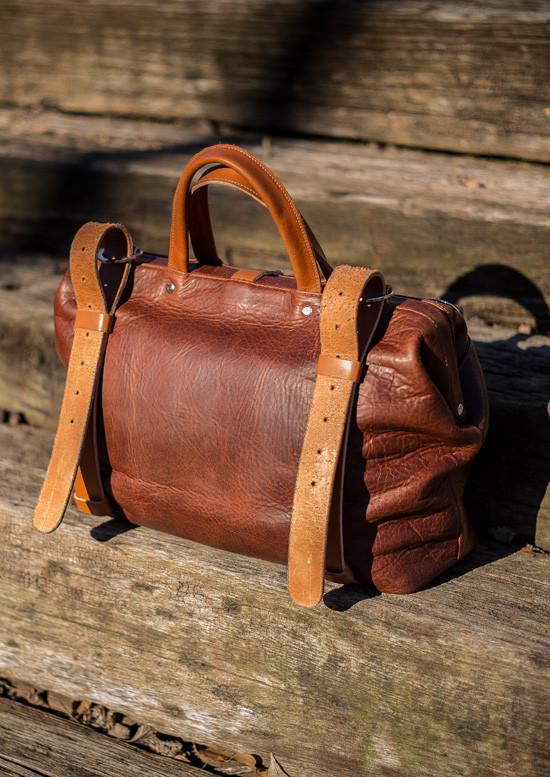
But when I do need to carry my gear, this thing more than gets it done.
I love the fact that there's carrier straps on the exterior of the bag so I can easily carry my tripod.
The other thing I really appreciate about the Roamographer is the shoulder strap.
If you've ever carried a heavy bag with a flimsy strap, you know how uncomfortable that can be.
But with the Roamographer, my shoulders rejoice under the shearling-lined padding that make it a breeze to carry.
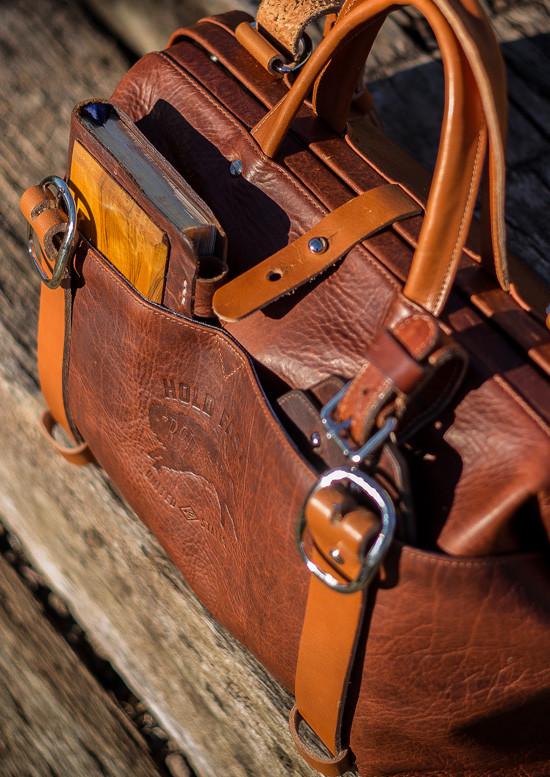
And like the Sightseer Backpack, the Roamographer allows you to secure a small camera to the shoulder strap, that way you can fire off some quick shots without having to set your bag down to unpack your camera.
If it sounds like Holdfast thought of everything with this bag, they did...
Even the fussiest of photographers on your shopping list won't have a negative thing to say about this bag. If you need something that is sure to impress, give the gift of a Holdfast Roamographer bag this year.
DJI Spark

Looking for the perfect gift for photographers and videographers on your list? Look no further than the DJI Spark.
This mini drone is ideal for a loved one who loves to fly but wants to avoid carrying a large aircraft everywhere they go. As someone that loves photography and trained as a commercial airline pilot, I can tell you that this is a fantastic gift for the photographer on your list!
Though the Spark is small, that doesn’t mean this mini drone is light on features…
In fact, Spark has all of DJI’s signature technologies, meaning you get a lot of bang for your buck.

That includes a 12-megapixel camera, a mechanical 2-axis gimbal for clear, sharp images and smooth video, and UltraSmooth technology that reduces camera shake and rolling shutter effects. The f/2.6 25mm lens means you can get wide-angle shots, even if the lighting conditions are less than ideal.
Something that I find to be incredibly helpful is the fact that getting the drone airborne is easy too - Spark has FaceAware technology that allows it to take off from your hand by recognizing your face. Crazy, right?! And after takeoff, it hovers automatically, all within just a few seconds of being turned on.
But if you ask me, the best feature of the Spark are the intelligent flight modes:
- QuickShot allows you to select from four cinematic shots (rocket, dronie, circle, and helix) to capture professional-looking video.
- TapFly enables precision flying with just a tap on your phone screen. Simply indicate where you want the drone to fly by tapping your screen, and Spark will fly there while avoiding obstacles and maintaining a constant altitude. I cannot tell you how cool of a feature this is!
- ActiveTrack recognizes objects and track them from the front, the back or the side.
- PalmControl means pilots can maneuver Spark without a controller. Just make specific movements with your hand, and Spark will move accordingly.
As if that’s not impressive enough, consider this…

Spark can fly over 31 mph and has a maximum flight time of 16 minutes. Additionally, you can see full HD video from the drone from up to 1.2 miles away, and with DJI’s FlightAutonomy system, pilots can fly knowing the drone will avoid obstacles on its own.
At $499, the DJI Spark is one heck of a buy this holiday season. If the photographer in your life wants to expand his or her creativity, there’s no better way to do so than with a drone!
As I mentioned earlier, if you're in the market for a DJI drone, follow my lead and head over to Drone World to find what you need. They've got upgraded kits available, and tons of other great accessories, too. Check out the DJI Spark and see what I mean when I say it's the ultimate gift for photographers!
band.it

Sometimes, the best gift for a photographer isn't the flashiest, but instead something that they will use each and every day to improve their ability to get the shots they want.
That's the category into which band.it falls...
This is a new company to me. I first encountered them at Photo Plus, and I was so impressed that I had to order the product right then and there.
I know when I'm in the zone and taking photo after photo, sometimes I struggle to find my zoom ring and focus ring as quickly as I'd like.
Well, band.it solves that problem.
The soft, elastomer band fits any lens, giving you a tactile clue as to where your focus ring or zoom ring is. That means no more fumbling around looking like an idiot like I used to do on occasion before putting this bad boy on my lens!

But band.it isn't just for helping you find the rings on the lens...
Instead, it helps you improve your grip on the lens. And that improved grip means you get sharper photos.
These little guys also help protect the delicate zoom and focus rings from damage.
It's about $200 to repair a lens ring (don't ask me how I know that...), but for just $25, you can protect the lens ring with a band.it.
And as if that's not enough to like, consider this - band.it also prevents lens creep. That means that if you're always on the hunt for a unique angle and you're shooting at a steep incline or decline, band.it will help keep your lens rings right where you want them, not where gravity wants to take them!
This is a fantastic stocking-stuffer idea for photographers. If I didn't already buy a band.it for myself, you can believe they'd be on my Christmas list this year!
Click Props

I'm not a for-hire photographer, but being that I'm a new dad, I love to take photos of my son, who's two-and-a-half.
We take selfies with each other every single day, and that collection of images is one of the most cherished things I have in this world.
But sometimes, I like to take more formal photos of my little guy, and that requires a little more effort than turning on the front-facing camera on my cell phone...
That's where Click Props has saved my bacon.

These guys put out incredible backdrops for portraits that give you the ability to take professional-looking images that look like they came straight out of a portrait studio.
That's because they craft their backdrops using 550gsm vinyl. That means you get a high-quality, durable backdrop that will stand the test of time and look great for years to come.
And if the photographer on your holiday list is like me and has a little kid to photograph, they'll appreciate the fact that these backdrops are super easy to clean!
You can hang their backdrops easily and with confidence as well. There's heavy-duty grommets every 12-inches, so you don't have to worry about rips or sagging.
There's a variety of sizes too, which any professional will appreciate, and more than 200 designs to fit your favorite photographer's style and aesthetic.

One more thing...
As a businessman, there's something else that I really like about Click Props...
In this industry, you get to know other companies pretty well, and let's just say that some of them focus on profits and not on actually helping their customers.
Click Props is certainly one of the good guys because they are with you at your side before, during, and after the sale.
Whenever I've had questions, they've had answers. And it's not the short "you're annoying me" sort of answers, either. They're genuine folks that truly want to help you take the best possible photos.
I can't even imagine how handy these backdrops would be for a professional portrait photographer. This holiday season, maybe you can help the photographer on your list find out by gifting them a Click Props backdrop!
Vanguard Alta Pro 2+ 263AB100

When it comes to photography gear, I think the most underappreciated part of a photographer's kit is a tripod.
Just like camera lenses aren't made alike, neither are tripods. By that, I mean that if you opt for something from the bargain basement, well, you're going to live to regret it.
That doesn't mean that you need to spend $500 on a tripod for the photographer on your holiday list, either.
I have a couple of Vanguard tripods, and I have to tell you - they're a perfect balance between top-quality construction, tons of features, and a great price.
Take the Alta Pro 2+ 263AB100 as an ideal example...

You can set this thing up in just a few seconds, which is ideal for situations in which you need to get the shot sooner rather than later.
The quick setup is aided by easy-locking legs, each of which has an independent leg angle. In other words, it can be set up with one leg at 20-degrees, another at 40-degrees, and another at 60-degrees, if so needed. They can even open up to 80-degrees. That means there's no terrain too uneven for this tripod to handle.
Another feature that makes this such a great tripod is the Multi-Angle Center Column. As the name suggests, it can be positioned in a variety of angles on both the positive and negative spectrum. That means that you can get awesome low-angle shots for a more unique view of the subject.
This bad boy also has a quick release so you can quickly grab your camera, and with the included ball head and bubble levels, you're sure to frame up top-notch photos.

The Alta Pro 2+ 263AB100 has another trick up its sleeve that I really like...
It's super lightweight, thanks to its aluminum alloy and magnesium construction, but it's also super strong.
It's rated to hold up to 15.5 pounds of gear, so when I'm out playing with my Nikon D850 and a big lens, I don't have to worry if the tripod has enough wherewithal to provide my gear with the stable base it needs.
And if your loved one wants awesome features like a canopy suspension loop for adding weight, all-weather grips, angled rubber feet, and more, well, this is the tripod they'll want! See for yourself why the Vanguard Alta Pro 2+ 263AB100guard Alta Pro 2+ 263AB100 is such a top-notch tripod.
MrStarGuy Vixen Polarie Star Tracker Mount

A few years ago, I decided to get into astrophotography, so I bought a star tracking device to help me get better shots of the night sky.
Now, I live in the Los Angeles area, so it's not like I can setup my gear in my backyard. Instead, I have to hoof it to the sticks to find a dark sky, so it's a huge investment of time.
The problem I ran into is that the star tracking devices I used in the past were just unbelievably complicated to use.
Not only did I feel like a moron for not being able to figure out how to use them, but I also never got the types of photos I imagined being able to get.
Fortunately, I found my saving grace - the Vixen Polarie Star Tracker Mount from MrStarGuy.

I met the folks at MrStarGuy, and I have to say that I was beyond impressed.
Visiting their shop, you get the feeling of how dedicated the husband and wife team are to their craft. They seek to make sure that every customer feels like a friend and that they get what they need. I can attest to that fact!
It doesn't hurt that MrStarGuy has top-notch astrophotography gear, either.
Their Vixen Polarie is hands-down the best I've ever used.
I just attach it to my tripod, use the included compass to orient it to the north, and once I have it all set, it will track the motion of the stars for me. That means I can get clear, sharp photos of the night sky without any star trailing.
If your favorite photographer is looking for a tool that will make his or her astrophotography life a lot easier and more productive, there's no better gift than the Vixen Polarie Star Tracker Mount. See what I mean by visiting MrStarGuy!
Sound Shark
I've always been a still photographer, but once 4K video became a thing on DSLRs and mirrorless cameras, I started to dabble in videography.
The problem I encountered was this - the video quality was amazing, but the sound wasn't.
In fact, the sound was pretty terrible on my first videos on its own, but when you pair poor sound quality with amazing 4K video, the sound seems even worse!
I wanted an external microphone that would yield the kind of sound that a 4K video deserved, but I didn't want some huge apparatus, either.
I found exactly what I needed in Sound Shark by Klover Products.

The great thing about Sound Shark is its small form factor. As you can see, it just mounts to the hot-shoe of the camera, and you're good to go.
This thing puts all other microphones I've tried to shame. In fact, it will pick up voices in crystal clear quality from a good distance away. People in my videos sound like they're wearing a lapel mic, even if I'm five or six feet away.
Not only that, but Sound Shark helps eliminate unwanted background noise, so if there's action to the sides or behind your subject, you don't have to worry about it overwhelming the audio you actually want to record.
Sound Shark has been one of my favorite toys for grabbing videos of my wife and son. But if my endorsement isn't enough, think about this - Sound Shark is used to get audio of things like the Super Bowl, the World Series, and the NBA playoffs.
If it's good enough to get the audio of a LeBron slam dunk, it's definitely good enough for my home videos!
Have a look at Sound Shark and see what all it has to offer the photographer on your list.
Meural

For my money, the most unique, eye-catching gift you can give a photographer this Christmas is the Meural Canvas.
What’s the Meural Canvas, you ask?
Well, in short, it’s a way to bring art to life.
Rather than viewing the same piece of art or photograph, Meural allows you to upload your own photos, create playlists, and sent art to your canvas instantly.
With TrueArt technology, the images are rendered in a way that makes them ultra-lifelike - when I first saw Meural in person, I felt like I could reach out and feel the texture of the brush strokes on the painting I was viewing. It’s that real!
And that’s just the start…

Meural gives you three different frame options (Leonora Black and Wwhite, as well as Winslow in walnut) to customize the look of the canvas. The canvas has a light sensor to adjust to the lighting of your room, and you can hang it horizontally or vertically, only show images in the appropriate orientation.
It’s easy to control, too. You can change images via the Meural website, the Meural mobile app, and even with hand gestures.

The upgraded iOS app allows you to upload, crop, and add filters to images, and then immediately send to the canvas. You can even schedule your canvas to come on when you wake, turn off when you sleep, and to randomize artwork or schedule playlists for certain times of the day.
In a word, Meural is amazing. Talk about an awesome last-minute gift!
We Recommend
Top Black Friday Deals

With Black Friday shopping just a couple of days away, I thought a list of awesome Black Friday photography deals was in order.
Whether you're looking for gifts for a photographer on your list or you just want some cool gear for yourself, the deals I've found below are sure to tantalize!
Have a quick look and see what fun gear you can pick up while saving some money, too.
Syrp Genie Mini

When it comes to creating time-lapse videos, there isn't a better motion control device than the Syrp Genie Mini.
This rig is compact, portable, and easy to use, so even if you or your loved one isn't an expert videographer, you can still create professional-looking smooth panning time-lapses (and real-time video, too!).
It's designed to mount to a tripod and then your camera mounts to the Genie.
With its internal motor, Genie can rotate 360-degrees with cameras that weigh up to 8.8 pounds.
You can wirelessly connect to the Genie Mini using the Syrp Genie App for a quick and easy set up of smooth panning or tilting time-lapse and video.
Treat yourself to a pocket-sized motion controller this year with the Genie Mini! Get 10% off this Black Friday!
Sew Trendy

Get some beautiful maternity photography accessories on Black Friday at huge discounts from Sew Trendy.
In fact, it's not just their maternity wear and accessories that are on sale. You can enjoy 30-40% off girls dresses, floral crowns, newborn props, and more all weekend long!
Not only that, but Sew Trendy is also offering a huge giveaway for Black Friday.
Each day between Black Friday and Cyber Monday, one lucky customer will get their order FREE.
Add to that Doorbuster sales running all weekend and exclusive deals on made-to-order maternity gowns like the Jessica Gown, and you have a recipe for big savings!
Holdfast
Holdfast makes all sorts of awesome photography gear, from top-of-the-line camera straps to gorgeous and functional camera bags.
Made right here in the USA to the highest of quality, Holdfast products are among the best you can buy on the market today.
And to celebrate Black Friday, Holdfast is offering 10% off everything on their site from November 24-27, 2017.
That means you can snag a MoneyMaker dual camera strap, a Roamographer camera bag, a Sightseer Backpack, or other goodies and save some money at the same time.
Just enter the promo code BlackFriday2017 to get your discount!
DJI Spark

How about a drone for Christmas?
The DJI Spark is a palm-sized mini drone that has a 12-megapixel camera and 2-axis gimbal for taking awesome aerial photos and videos.
Not only that, this little guy is packed with awesome technology that makes takeoff and landing a breeze. It has intelligent flight modes, too, including TapFly, which lets you tap anywhere on your phone to fly the Spark.
It even tracks moving subjects from the front, back, or side for awesome cinematic videography.
Best of all, the DJI Spark is $100 off from Thanksgiving day until the end of Cyber Monday, and then again from December 10th until the end of the year.
You can also get a $1 freebie bag and 25% off Drone World brand accessories, too!
Sew Trendy

Sew Trendy has so many deals this weekend that we had to separate them into two different slots on our list!
Black Friday through Cyber Monday, customers will enjoy 20% off their orders with the order code BFCM1720.
And if you're a photographer, you get an even sweeter deal - 30% off your orders with the code BFCM17PH (terms apply).
Additionally, all ready-to-ship women's gowns will be marked down 10% and you can enjoy 10% off on certain products, like the floral print collection and the winter gown collection.
Check out all the deals at Sew Trendy this weekend and get outfitted for maternity photography, mommy and me shoots, newborn photography, and more!
DJI Mavic Pro

If you're looking for a larger drone than the DJI Spark, perhaps the DJI Mavic Pro is up your alley.
The Mavic Pro comes packed with features that ever drone lover will appreciate, including the ability to transmit full HD video up to 4.3 miles away and a top speed of 40 mph!
Its FlightAutonomy system can detect obstacles up to 49 feet away, giving you peace of mind while flying.
The 4K camera with 3-axis mechanical gimbal isn't bad either, snapping gorgeously sharp photos and smooth 4K video up to 30fps.
The Mavic Pro boasts phenomenal endurance too, allowing you to fly up to 27 minutes at a time.
It's on sale, too! Save $100 on the Mavic ProThanksgiving Day until the end of Cyber Monday, and then again from December 10th until the end of the year.
You can also get a $1 freebie bag, $150 off Fly More and Higher End Kits, and a free mini drone with a drone kit order.
On top of all that, Drone World is offering 25% off Drone World brand accessories, too!
MrStarGuy

MrStarGuy has some great deals going on for telescopes binoculars, mounts, and jewelry - something for everyone on your list!
That includes $100 off the Vixen R130Sf and Porta II Mount shown above.
The Vixen Nature Eye Telescope is on sale for $19.95 (a savings of $20) and the Space Eye 70 Complete Telescope is $70 off!
For an even bigger deal, you can save $600 on the Vixen R200SS Reflector Telescope or save $700 on the Vixen NA14OSS Telescope. You can save $700 on the Vixen Sphinx SX2 mount as well.
That's not to mention great deals on binoculars (up to $149 off!) and even deals on jewelry that features constellations, stars, and images of the universe.
These awesome deals at MrStarGuy start on Thanksgiving day and run through November 30th.


















